He died at Garden Sullivan Hospital in San Francisco.
Luna is memorialized in the project Dancers We Lost: Honoring Performers Lost to HIV/AIDS.
* * * * * * * *
Photo of quilt panel from the AIDS Memorial Quilt

U.S. Centers for Disease Control and Prevention reports cases of a rare lung infection in five young, previously healthy, gay men in Los Angeles — the first official reporting of what would become known as the AIDS epidemic. Two of the men have already died.
Learn More.The CDC’s Morbidity and Mortality Weekly Report described the men as having additional infections, indicating that their immune systems were compromised. By the time the report was published, two of the young men were already dead.
While this was the first official reporting of the disease, the history of the AIDS epidemic actually reaches back to the early 20th Century, when Simian Immunodeficiency Virus made the jump from chimpanzees to humans in Central Africa.
The new virus began infecting residents in Léopoldville (now Kinshasa) in the Democratic Republic of the Congo some time between 1990 and 1920. according to History.com/A&E Networks. More than 60 years later, when HIV tests became available, blood samples from a Congolese man who died in 1959 tested positive for HIV and this was the first confirmed HIV-related death.
But the existence and spread of HIV had gone unreported in the medical community until around 1980, when a handful of doctors serving urban populations in the U.S. started to see unusual symptoms in their patients.
One of these doctors was Michael Gottlieb, a young immunologist at UCLA (University of California Los Angeles) who diagnosed a rare lung infection in five young men between 1980-1981. Dr. Gottlieb arranged for his findings to be disclosed to the medical community in the CDC’s weekly alert, MMWR.
Dr. Gottlieb encountered his first patient with unusual infections in November 1980, when one of his medical school residents reported a young patient suffering from a severe yeast infection in his throat. When the patient began having breathing difficulties, Dr. Gottlieb arranged to receive a scraping of the patient’s lung tissue through a non-surgical procedure. He was astounded by the test results.
The patient tested positive for Pneumocystis carinii pneumonia (PCP), a rare lung infection, in addition to oral candidiasis, also known as thrush. Dr. Gottlieb then reached out to a colleague who specialized in the new science of T-cells, the white blood cells important to the immune system. The colleague tested the patient’s blood and found that the sample had no T-helper cells, a result so astounding that he ran the test again, with the same results.
In February 1981, Dr. Gottlieb would come across another young man suffering with PCP and depleted T-cells, and shortly after that, a third patient was referred to him. Thorough examinations of the patients about their lifestyles yielded the information that were gay, but Dr. Gottlieb couldn’t determine how their sexual identity was relevant.
A fourth PCP patient appeared in April 1981, and then a report of a fifth man who already died (an autopsy found PCP). Seeing an alarming trend, Dr. Gottlieb contacted an editor at the New England Journal of Medicine, the most prestigious medical journal in the U.S., and was told that the submission-review-publication process would take at least four months. He believed this information needed to get out to the medical community fast, so he instead submitted his report to the CDC’s weekly newsletter, the Morbidity and Mortality Weekly Report (MMWR), a weekly report read by medical officials concerned with infectious disease and public health.
Assisting Dr. Gottlieb in publishing his report was Dr. Wayne Shandera, who worked in the Los Angeles County Department of Public Health as a CDC liaison.
“Gottlieb talked through the charts while Shandera put the information into the dry, turgid prose that the MMWR preferred,” wrote Randy Shilts in his epic recounting of the early years of the AIDS pandemic, And the Band Played On: Politics, People, and the AIDS Epidemic. “The report noted the links between PCP, CMV (cytomegalovirus), and the oral candidiasis that commonly preceded the pneumonia.”
Dr. Gottlieb’s report also stated, “The fact that these patients were all homosexuals suggests an association between some aspect of homosexual lifestyle or disease acquired through sexual contact and Pneumocystis pneumonia in this population.”
The five Los Angeles men in Dr. Gottlieb’s report were not the only early cases in the U.S. Starting around 1979, previously healthy men in New York City and San Francisco were their seeing doctors and baffling them with a range of symptoms that included fatigue, enlarged lymph nodes, flat purple lesions, oral candidiasis, shortness of breath, eczema, fevers, and amebic dysentery. Their medical charts would be marked with notes like “fever of unknown origin,” “Kaposi’s sarcoma,” “cytomegalovirus,” and “toxoplasmosis.” But the traditional treatments for these conditions were not working.
While sporadic cases of AIDS were documented prior to 1970, available data suggests that the epidemic started in the mid- to late 1970s. Grethe Rask, a Danish physician who worked in the Congo, died of pneumonia on December 12, 1977 after suffering for several years from opportunistic infections. Ten years after her death, samples of her blood were tested and found to be positive for HIV.
By 1980, HIV may have already spread to five continents (North America, South America, Europe, Africa and Australia), and in this period, it is possible that up to 300,000 people were already infected.
In April of 1980, the CDC received a report on Ken Horne, a gay man in San Francisco who was diagnosed with Kaposi’s sarcoma. Horne died on November 30, 1981. The CDC would retroactively identify Horne as the first American patient of the AIDS epidemic.
Following Dr. Gottlieb’s report in the CDC’s MMWR, he and his team published a more detailed report in the New England Journal of Medicine on December 10, 1981.
Today, Dr. Gottlieb is an Associate Clinical Professor of Medicine at UCLA’s David Geffen School of Medicine and still treats patients exclusively at AIDS Project Los Angeles (APLA Health). He is also a member of the Council of Advisors to STORIES: The AIDS Monument.
* * * *
Sources:
Morbidity and Mortality Weekly Report | Centers for Disease Control and Prevention, “Pneumocystis Pneumonia – Los Angeles,” June 5, 1981
American Journal of Managed Care, “A Q&A With HIV/AIDS Pioneer Dr Michael Gottlieb” by Maggie L. Shaw, June 4, 2021
And the Band Played On: Politics, People, and the AIDS Epidemic by Randy Shilts
www.Be In The Know.org, “Origin of HIV and AIDS”
PBS News Hour, “America’s HIV Outbreak Started in This City, 10 Years Before Anyone Noticed” by Nsikan Akpan, October 26, 2016
www.History.com | A&E Television Networks, “AIDS Crisis Timeline”
The New England Journal of Medicine, “Pneumocystis carinii Pneumonia and Musocal Candidiasis in Previously Healthy Homosexual Men — Evidence of a New Acquired Cellular Immunodeficiency” by Michael S. Gottlieb, M.D., Robert Schroff, Ph.D., Howard M. Schanker, M.D., Joel D. Weisman, D.O., Peng Thim Fan, M.D., Robert A. Wolf, M.D., and Andrew Saxon, M.D.; December 10, 1981

Of the 108 known cases of Kaposi’s Sarcoma and pneumocystis carinii pneumonia, 107 are male and 94% of those whose sexual orientation is known are gay/bisexual. About 40% of all patients have already died.
Learn More.The MMWR article, “Follow-Up on Kaposi’s Sarcoma and Pneumocystis Pneumonia,” reported that CDC received information on 70 additional cases of KS and/or PCP since its July 3 edition, making a total of 108 known cases.
News of the article alarms the gay community for its indication that the new disease is spreading and that the outcome of those infected was likely to be a quick and brutal death.
* * * * *
Source:
Morbidity and Mortality Weekly Report, “Follow-Up on Kaposi’s Sarcoma and Pneumocystis Pneumonia,” August 28, 1981

The National Institutes of Health reports the death due to severe immune deficiency of a man admitted to its facility in Bethesda, Maryland in June. He was 35.
Learn More.Known only as “Patient D” in NIH research reports, the patient had been transferred to the NIH Clinical Center from Hartford Hospital, where doctors had been unable to reverse the course of multiple infections spreading through his body. He had previously been living in New York City.
The white, gay man said he had been healthy through adulthood until February 1981, when he began experiencing fatigue and weakness, followed by weight loss and fever. By the time he was admitted to the NIH in June 1981, Patient D had been diagnosed with neumocystis carinii pneumonia, lymphocytopenia, cytomegalovirus, herpes simplex II, Candida esophagitis, and Mycobacterium avium tuberculosis of the lung, bone marrow, and esophagus.
Thomas A. Waldmann, M.D., who at the time was chief of the Metabolism Branch of the NIH’s National Cancer Institute, said in a 1990 NIH interview that Patient D was the first patient with AIDS seen at their facility. He said that he could see that this disease, combined with the patient’s identity as a gay man, “had a devastating effect on his relationships to individuals who had been close to him in the past.”
He noted that, besides the occasional visit from family members, Patient D was largely left alone to die. Through others on his medical team, he learned that the patient had been abandoned by his partner and others from his social circle in New York.
“No one visited this individual, who was in a critical and life-threatening condition, throughout his whole four-month stay,” said Dr. Waldmann.
The NIH medical team performed every test and issued every treatment they could think of, to no avail, he said.
“We were all groping, trying to understand what was going on,” Dr. Waldmann recalled. “In that era, one couldn’t be fatalistic, even when someone was in an apparently irreversible state. One had to assume that somehow one might be able to reverse the immunodeficiency and with that bring into control the infectious disease.”
“We had a great number of people involved in treating all the different systems,” he said. “His disease continued, and the patient finally died on October 28, 1981 of hypotension and respiratory failure, with multisystem involvement.”
An autopsy of the body revealed an even wider spectrum of infections, including massive necrosis, encephalitis, and degeneration of the brain. The autopsy states: “This case represents an example of a recently described syndrome of acquired immunodeficiency in previously healthy young male homosexuals.”
The willingness of Patient D to spend what would turn out to be the last four months of his life in a NIH cancer research center would prove to be valuable to researchers, health officials, and the medical community for years to come.
Cells taken from Patient D led to the discovery of the first human retrovirus HTLV-I and ultimately to the discovery of HIV-1 as the cause of AIDS — one of the major scientific achievements during the last century, said Dr. Waldmann. In addition, these cells played a critical role in the ability for Waldmann’s lab to achieve a major breakthrough in immunology with the production of the monoclonal antibody to the Il-2 receptor, anti-Tac.
By subjecting himself to research studies, Patient D provided critical information to the country’s top researchers during the very earliest months of the epidemic. The handful of cases reported at that time to the NIH and Centers for Disease Control had included instances of young, gay men with Kaposi’s sarcoma, but the report of Patient D was the first to include malignant lymphoma as a condition.
Patient D was also diagnosed with other conditions that were unique to his case at the time, including his deteriorating eyesight and the failure of his body to repond to a tuberculin skin test, despite the fact that he had widespread Mycobacterium avium.
As these new conditions were reported widely to the medical community, the case study of Patient D helped to broaden the defnition of the disease early on and served to provide critical information to physicians and health officials across the country.
* * * * *
Sources:
National Institutes of Health, “Dr. Thomas Waldmann Oral History 1990,” interview with Dr. Waldmann on March 14, 1990 by interviewers Dennis Rodrigues, NIH Program Analyst, and Victoria Harden, M.D., Director of the NIH Historical Office.
Retrovirology journal, “A Historical Reflection on the Discovery of Human Retroviruses” by Anders Vahlne, May 1, 2009
National Institutes of Health | National Library of Medicine, “Anti-IL-2 Receptor Monoclonal Antibody (anti-Tac) Treatment of T-cell Lymphoma,” by Thomas Waldmann, M.D., 1994
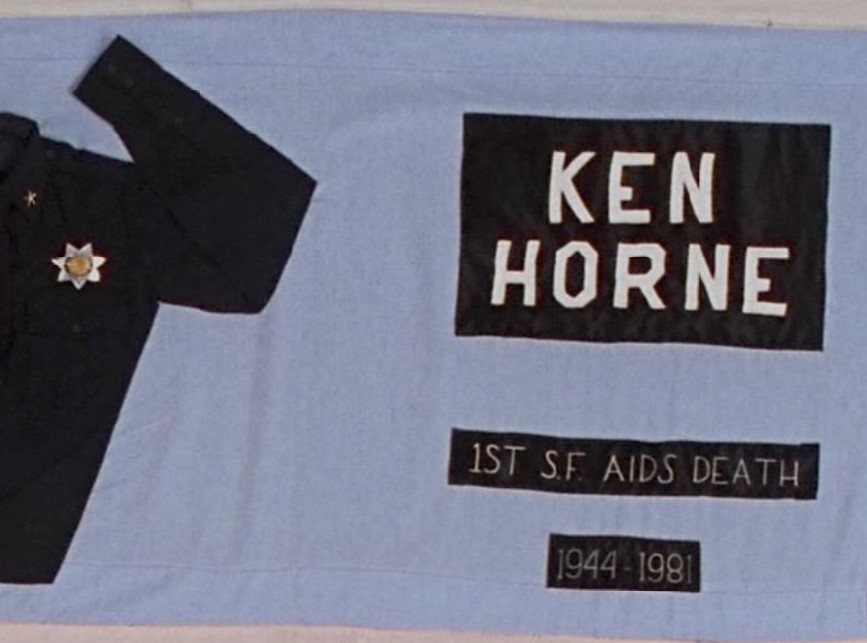
After falling ill in 1979 with unusual conditions related to a suppressed immune system, Ken Horne dies in San Francisco at the age of 38.
Learn More.In April 1980, the Centers for Disease Control received a report on Horne, who was diagnosed with the then-rare disease of Kaposi’s sarcoma. In 1981, the CDC would retroactively identify Horne, who was a gay man, as the first American patient of the AIDS epidemic.
Horne had grown up in Oregon and, when he was 21, he moved to San Francisco in 1965 to study ballet. Within a few years, he abandoned his dance career and took an office job with the local transit system. He’d also discovered the city’s vibrant gay social scene and became a regular at the leather bars. By the fall of 1980, he’d become ill with the first reported case in San Francisco of what would eventually be called HIV/AIDS. He was 37 years old.
Dr. James Groundwater, a dermatologist, was puzzled by the symptoms Horne presented to him in November 1980. Horne told him that for two years, he was experiencing fatigue, diarrhea and nausea. More alarming was Horne’s enlarged lymph nodes and the purple spots on his skin, one on his left thigh and another near his right nipple. Dr. Groundwater took photos of the lesions and biopsied of one of them. He also drew some of Horne’s blood to be tested.
About a week later, Horne was back in Dr. Groundwater’s office to hear about the results of the tests. The dermatologist told him that something was wrong with his white blood cells and his immune system seemed compromised. Horne’s lesions represented something more mysterious; results were inconclusive. He needed more tests.
Over the next four months, Horne’s condition worsened. He suffered daily now from severe headaches and fever, and new lesions appeared on his face and back. On March 30, 1981, Horne was admitted to St. Frances Hospital in San Francisco, where he was given a lumbar puncture. The results showed he had cryptococcosis, an infection acquired by inhalation of contaminated soil. This made no sense to Dr. Groundwater.
In the San Francisco AIDS Oral History Project, Dr. Groundwater recalled sending the biopsy of Horne’s lesion to as many as ten pathologists, trying to crack the mystery of the purple spots.
“In the early days of the AIDS epidemic, very few dermatologists, dermatopathologists even, had seen much Kaposi’s sarcoma. This was very rare. And so they missed the diagnosis. They read it as hemangioma and proliferating angioendotheliomatosis, et cetera,” he said. “But finally, I think it was Dick Sagebiel, a dermatopathologist over in the melanoma clinic at Mt. Zion, who was the first one who made the diagnosis of Kaposi’s sarcoma on these lesions.”
On April 9, Dr. Richard Sagebiel would give Dr. Groundwater the first “reading” of the biopsy that made any sense of Horne’s deteriorating condition. But this just opened up a bunch of new questions. KS trypically affected elderly men, usually of Jewish or Italian descent, and the condition was easily treatable.
Weeks later, things started to fall into place when Dr. Groundwater was attending dermatology rounds at the University of California San Francisco. Clinic chief Marcus Conant, MD, asked attendees if any of them had seen any unusual cases of Kaposi’s sarcoma.
“At that moment, the realization was born that a new epidemic had arrived in San Francisco,” wrote Randy Shilts in his masterpiece of investigative reporting, And the Band Played On: Politics, People, and the AIDS Epidemic
Drs. Groundwater and Conant exchanged information; they had known eachother since the late 1960s, when Groundwater did his residency at UCSF. Dr. Conant said that Dr. Alvin Friedman-Kien in New York had some cases of KS in young gay men.
“So I called Alvin Friedman-Kien,” Dr. Groundwater said in the San Francisco AIDS Oral History Project. “At that point, Alvin had, I think, six, seven, or eight cases of these young gay males with Kaposi’s sarcoma.”
On April 24, Dr. John Gullett, a key member of Ken Horne’s medical team at St. Francis Hospital, called the Centers for Disease Control to report the case of KS, making Ken Horne the first reported victim of the new disease.
Over the next seven months, doctors ordered the usual treatments for Horne’s KS, cytomegalovirus, and cryptococcal meningitis — but nothing was working.
“He went through one horrendous experience after another with these various opportunistic infections,” Dr. Groundwater said. “But I think when he began to lose his vision from the cytomegalovirus retinitis, he gave up the battle. When he went blind, he died within a couple of weeks. I think he gave up.”
Ken Horne died of AIDS-related illness on November 30, 1981 at St. Francis Hospital at the age of 38.
* * * * *
It is now believed that the first HIV/AIDS patient in North America was Robert “Bobby” Rayford, a Black teenager from the Old North neighborhood of St. Louis, Missouri. Fifteen-year-old Rayford was hospitalized in 1968 with shortness of breath, swelling in his lower body and other infections that he reported experiencing for about two years.
First suspecting that he had contracted an exotic illness, Rayford’s doctors were surprised to learn that the teenager had never traveled outside of the Midwest. They proceeded to administer numerous tests on Rayford’s blood and tissue, but were unable to determine an overall diagnosis or effective treatment. He died of pneumonia in 1969 at St. Louis City Hospital. An autopsy revealed small, cancerous, internal tumors throughout his body — Kaposi’s sarcoma. Almost 20 years later, a western blot postmortem test on Rayford’s tissue samples confirmed HIV.
Also relevent is the illness and death of Grethe Rask, a Danish physician and surgeon who spent years working in the Congo. Over several years, she suffered from a number of opportunistic infections and severe immunodeficiency, and then died of pneumonia on December 12, 1977 in Copenhagen. A 1987 blood test determined that she was infected with HIV.
An early “cluster” case was that of Arne Vidar Røed, a Norwegian truck driver and former sailor, and his wife and child. While still a teenager, Røed worked in the kitchen of a Norwegian ship, travelling to Nigeria, Ghana, Cote D’Ivoire, Liberia, Guinea and Senegal. When he returned to Norway in 1965, he married and became a father to two children.
Beginning in 1968, Røed suffered from joint pain, lymphedema, and lung infections, conditions which traditional medicine and treatments failed to resolve. He died in April 1976. His wife, who had come down with similar symptoms, died the following December. Their eight-year-old daughter died, too. Although the disease was not identified until long after their deaths, all three are believed to be the first confirmed HIV cases in Europe. This was also the first documented cluster of AIDS cases before the AIDS epidemic of the early 1980s.
* * * * *
Sources:
Photo of quilt panel from the AIDS Memorial Quilt
www.History.com | A&E Television Networks, “AIDS Crisis Timeline,” June 14, 2021
University of California Libraries, “The San Francisco AIDS Oral History Series | The AIDS Epidemic in San Francisco: The Response of Community Physicians, 1981-1984,” interview with James R. Groundwater, M.D. by interviewer Sally Smith Hughes in 1996
National Park Service, “Robert Rayford”
The Weekly View, “Robert Rayford: America’s First AID S Victim” by Al Hunter, May 8, 2014
University of Copenhagan School of Global Health newsletter, “After Hard Working Days, She Rested by the Beautiful Ebola River,” July 22, 2020
Discover magazine, “The Sea has Neither Sense nor Pity: The Earliest Known Cases of AIDS in the pre-AIDS Era” by Rebecca Kreston, October 22, 2012

At the close of 1981, a cumulative total of 270 cases of severe immune deficiency are reported among gay men, and 121 of those individuals have died.
Learn More.By this time, some researchers began to call the condition GRID (Gay-Related Immune Deficiency). This terminology would have a negative influence on both the medical profession and the public, causing people to perceive the epidemic as limited to gay men.
This early misconception of the disease would have serious long-term consequences as it becomes evident that anyone could be infected with HIV, including women, heterosexual men, hemophiliacs, people who inject drugs, and children.
* * * * *
Source:
www.HIV.gov, “A Timeline of HIV/AIDS”
Antony Valdor, a dancer, choreographer and teacher known throughout North America, dies of AIDS-related illness at the age of 49.
Learn More.Valdor, a principal dancer with Théâtre du Châtelet who was fluent in French, toured Europe extensively. After dancing with Les Grands Ballet U.S., Marquis de Cuevas and London Ballet Theatre. he became technical coach for Les Grands Ballets Canadiens.
In the late 1960s, he was ballet master for San Francisco Ballet, and produced one of the company’s most popular events, Ballet69, an innovative series of dance performances in the summer of 1969.
He choreographed several pieces for SF Ballet, for the National Academy of Arts Ballet and co-choreographed ballet pieces with Gemze de Lappe. He toured the U.S. as guest teacher and choreographer with many ballet companies and dance academies.
Born Robert Dishman in Los Angeles, Valdor studied with Olga Preobrajens, Alexandra Danilova, Robert Joffrey, and Jose Limon, among others. He was a Navy veteran, serving for four years. His first performances after being released from military service was in the summer of 1955 with the Pittsburgh Civic Light Opera dancing in their summer musical series.
Valdor is memorialized in the project Dancers We Lost: Honoring Performers Lost to HIV/AIDS.

Kenneth Schnorr, president of the Stonewall Democratic Club in Los Angeles, dies of AIDS-related illness at Cedars-Sinai Medical Center. He was 35.
Learn More.Schnorr would be among the first in the U.S. to die of AIDS. After being found unconscious in his car in December 1981, he was hospitalized and Cedars-Sinai’s top-notch medical team was perplexed with his rapidly declining health.
West Hollywood activist Ivy Bottini, who was Schnorr’s friend, would tell the story of Schnorr’s illness and death in her 2018 memoir The Liberation of Ivy Bottini.
Bottini recalled receiving a phone call from Schnorr’s mother, who was sitting bedside with him at Cedars.
“He’s full of black and blue marks…. I don’t know what to do,” Schnorr’s mother told her.
Bottini asked to talk with Schnorr, and quickly realized that he had lost his hearing. She eventually was able to speak with Schnorr’s doctor, Joel Weisman, M.D., who would go on to open one of the first medical clinics to treat HIV/AIDS. When Dr. Weisman was unable to give Bottini a clear picture of what was going on, she felt a growing dread that Schnorr’s condition was an indication of a larger issue.
Schnorr died about a week after entering the hospital. Bottini was among the members of the Stonewall Democratic Club who attended Schnorr’s funeral.
“After Ken died, something said to me there is more to this than we see,” Bottini said. “So, for some reason, I just picked up the phone and called the CDC. I had never done that before. ‘Look, this just happened to my friend. Do you have any answers?’ The hesitancy at the other end of the line, the hemming and the hawing before they would say anything — I just knew it was bad.”
The CDC official told her the black and blue marks was a symptom of Kaposi sarcoma, which was usually found in elderly Jewish men.
“And that was the explanation,” she said. “I thought, ‘No, this doesn’t make sense, because Ken was one of three first guys diagnosed with Kaposi in town, in West Hollywood, in LA, and that started me on working to find out what the hell was going on.”
After many phone calls and the realization that the government was failing to act on the crisis, Bottini called Dr. Weisman to invite him to update the community at a town hall she was organizing at West Hollywood’s Plummer Park. She was hoping he would share any information he had and would provide his theory on how this new illness was transmitted. She herself suspected that it was being passed during sex, through bodily fluids.
“That’s the only thing that made sense to me,” Bottini said. “Because if it was airborne, women would be getting it, everybody would be getting it, and that wasn’t happening.”
On the night of the town hall, Fiesta Hall in Plummer Park was jam-packed.
“It was all guys — and (Bottini’s then-girlfriend) Dottie Wine and I,” Bottini recalled. “And Joel talked about transmission and he believed it was bodily fluids, too. And I thought, ‘I’m not crazy.’”
Schnorr’s legacy was that he may have saved many lives by inspiring Bottini and others to search for answers and share that information with the greater community in the earliest days of the epidemic.
* * * * *
Sources:
Photo of quilt panel from the AIDS Memorial Quilt
The Liberation of Ivy Bottini by Judith V. Branzburg (Bink Books, 2018)
Watermark, “Tribute to ‘Give ’em Hell’ Lesbian Feminist Pioneer Ivy Bottini” by Karen Ocamb, March 3, 2021

William “Billy” Kovinsky dies of AIDS-related illness, becoming the first known case of HIV/AIDS in Canada. He was 43 years old.
Learn More.About a month later, Canada Diseases Weekly Report would print an article about the case, alerting medical officials that HIV had come to Canada.
As far back as August 1979, Kovinsky sought medical treatment for illnesses that overwhelmed his immune system. According to his doctor, John Doherty, M.D., Kovinsky came to his office in March 1981, and the doctor found he had enlarged lymph nodes and abnormal levels of immune globulins.
During a follow-up visit a month later, Kovinsky’s immune globulins were normal again. Then in May 1981, he went to a different doctor and received a blood test, which found that his white blood count was “extremely low.”
His sister Anna Levin told Canada’s Xtra magazine that she vacationed with Kovinsky in Florida around that time, and saw that his health was in decline.
“He was very thin and gaunt and suffered from sweats,” Anna recalled.
When Kovinsky returned to Canada in June 1981, he submitted to a series of tests at the University Hospital in London, which showed “leukopenia, atypical lymphocytosis and an elevated sedimentation rate,” according to Dr. Doherty’s case report. He was admitted to the hospital for eight days and then discharged without a diagnosis or treatment plan.
Kovinsky continued to search for an answer to his health problems, but doctors had little to offer him. He became very depressed and attempted suicide in August 1981 by taking an overdose of pills, according to Dr. Doherty.
After a two-day hospital stay, he was sent to Toronto for four weeks of psychiatric treatment. In December 1981, Kovinsky was diagnosed with thrush, an infection which covered the entire lining of his esophagus, from mouth to stomach.
On January 5, 1982, Kovinsky checked himself into the hospital for the last time. A battery of tests were performed on him, according to the case report, including an “open chest upper lobe biopsy.”
His sister Anna said she visited Kovinsky at his hospital bed three times a week. His friends Phyllis and Jack would also come by and try to cheer him up. He had his own room, and Anna recalled that he was treated very well by the staff at the hospital.
Kovinsky died just six weeks later at the age of 43.
Dr. Doherty told the Canadian Medical Association Journal that he reported Kovinsky’s case to Canada’s Laboratory Centre for Disease Control, and the very next day investigators came to his office for more information. On March 27, 1982, Canada Diseases Weekly Report carried a short article on the case, and soon, it would be clear that Dr. Doherty had reported the first known case of AIDS in Canada.
“I still remember this case vividly, because I knew the guy really well,” Dr. Doherty recalled for the Journal in 2002.
“Billy was just a really nice guy who led two lives,” said his sister Anna to the Windsor Star. “One was his public life where he was a supposedly heterosexual guy and had all heterosexual friends. The other one was a life that nobody knew about. I’m sure it was very difficult, exceptionally difficult.”
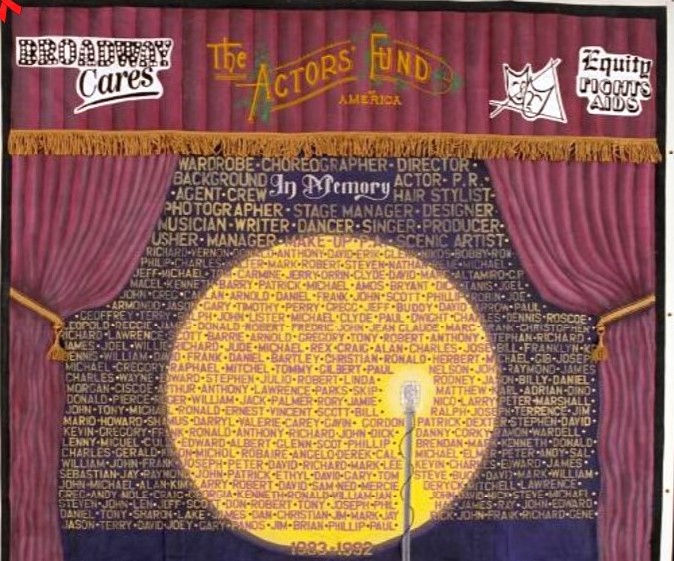
Lenny Baker, who won the 1977 Tony Award for Best Actor in a featured role (musical), dies of AIDS-related illness in a hospital in Hallandale Beach, Florida at the age of 37.
Learn More.Born Leonard Joel Baker in 1945 in Boston, he began his acting career in regional theater and spent several summers at the O’Neill Center’s National Playwrights Conference in Waterford, Connecticut. He told an interviewer in 1977 that the center was instrumental in his career, partly because he saw performances of the National Theater for the Deaf there.
”It’s perhaps because of watching them work,” Baker said, ”that I can be so brazen with comic uses of my body.”
After moving to New York City in 1969, Baker acted in Off-Broadway stage productions until making his Broadway stage debut in 1974 in The Freedom of the City. Baker won a Tony award and the Drama Desk Award as Outstanding Actor in 1977 for his performance in the musical I Love My Wife.
Baker also acted in films and television shows, including Paul Mazursky’s Next Stop, Greenwich Village (1976), for which he was nominated for a Golden Globe award. His other film credits included The Hospital (1971) and The Paper Chase (1973).
Following Baker’s death, a memorial service was held at The Public Theater, located at 425 Lafayette Street in New York City.
* * * * * *
Sources:
Photo of quilt panel from the AIDS Memorial Quilt
The New York Times, “Lenny Baker, 37, Stage Actor” by Eleanor Blau, April 13, 1982
IMDb, “Lenny Baker biography”

To the shock and dismay of many fans in San Francisco and New York City, The Advocate announces: “Founder of Cockettes, Hibiscus, Dead of GRID.”
Learn More.Hibiscus was famous on both coasts for founding and performing with the flamboyant theatrical groups The Cockettes and Angels of Light. He died of AIDS-related illness (then called “Gay-Related Immune Deficiency”) at St. Vincent’s Hospital in New York at the age of 32, becoming one of the earliest casualties of the epidemic.
Born George Edgerly Harris III in Bronxville, N.Y., he was the child of theater performers who relocated the family to a home on El Dorado Avenue in Clearwater Beach, Fla. Before long, George Jr. had founded his first theatrical group, the El Dorado Players, which performed in the family’s garage.
“He was fascinating even as a small child,” his mother Ann Harris told The New York Times Magazine in 2003. “All the other kids followed him and acted out his fantasies. He did Camelot one time and had the kids on bicycles with the handlebars as the horses’ heads. Another time he directed Cleopatra, and used the garden hose as the serpent and our cats as Cleopatra’s gifts to Caesar. He was very much the little producer.”
When his family returned to New York in 1964, George Jr. reprised the El Dorado Players, augmenting the troupe with children he met in Greenwich Village. He took acting and singing classes at Quintano’s School for Young Professionals, and soon he was cast as an extra in a milk commercial, a deaf-mute in a television series and an antiwar protester in an Off Broadway play called Peace Creeps, co-starring Al Pacino and James Earl Jones.
The latter role would be strangely prescient. On October 21, 1967, an 18-year-old George Jr. would be photographed placing a flower in a gun barrel pointed at him while taking part in an anti-war demonstration at the Pentagon. The photo, widely circulated in the media, became iconic of the anti-war movement and generational divide in the country.
Washington, D.C. was just a stop-over, through, of a trip he was taking to San Francisco with friend Irving Rosenthal, the author of the homoerotic novel Sheeper and the onetime lover of William Burroughs. Inspired by an image in a Cocteau novel, he changed his name to Hibiscus, and started wearing the glittery makeup, diaphanous robes and floral headpieces that would become his signature.
He joined Rosenthal’s commune, KaliFlower, which was dedicated to distributing free food and creating free art and theater. This was the fertile environment in which Hibiscus founded The Cockettes.
Hibiscus and other KaliFlower members first performed at the 1970 New Year’s Eve Show at the Palace Theater, an old Chinese movie house in North Beach. They called themselves The Cockettes, a bawdy allusion to the Rockettes, and danced a cancan to the Rolling Stones’ song Honky Tonk Women.
Under the leadership of Hibiscus, the group’s act quickly evolved into bigger, wilder, and more lavish productions, and The Cockettes’ shows fast became not-to-be-missed events. New shows were created every few weeks, with Paste on Paste, Gone with the Showboat to Oklahoma, and Tropical Heatwave/Hot Voodoo being some of the early productions.
Pearls Over Shanghai became the Cockettes first show featuring an original script, music and lyrics, and was an instant hit with fans. Some members of the Cockettes, like Sylvester and Devine, began to garner their own fan followings. During this time, Hibiscus found he could express his sexual identity with fearless abandon.
”He came out of the closet wearing the entire closet,” says Nicky Nichols, a fellow Cockette.
When some members of The Cockettes began insisting that they begin charging for their shows, Hibiscus refused and found himself expelled from the group he founded. Unperturbed, Hibiscus formed a new theatrical group called the Angels of Light Free Theater. Their shows included Flamingo Stampede and The Moroccan Operette, which Hibiscus described as being ”like Kabuki in Balinese drag.”
Among the people he convinced to perform with the Angels of Light was poet Allen Ginsberg, who appeared in drag for the first time. Hibiscus found another collaborator in his new boyfriend, Jack Coe, also known as Angel Jack, who eventually moved to New York with Hibiscus in 1972, around the same time that the Cockettes disbanded.
Upon his return to NYC, he recruitd his mother and three sisters (Jayne Anne, Eloise and Mary Lou) into an east coast version of the Angels of Light.
“I wrote almost all the music for the Angels of Light,” said his mother, Ann. “George would say, ‘Oh, I need a sheik scene, with a sheik in it,’ and then I would come up with a song.”
The group performed at the Theatre for the New City, where John Lennon was known to jump on the stage and sprinkle glitter on Hibiscus.
In the early 1980s, he and his sisters and brother formed the glitter rock group “Hibiscus and the Screaming Violets,” supported by musicians Ray Ploutz on bass, Bill Davis on guitar and Michael Pedulla on drums. But he had to stop performing in 1981 due to his escalating illness.
It’s testament to the power of his personality and creativity that the spirit of Hibiscus dominates the 2002 Cockettes documentary, even though the film’s focus is on the group. Decked out in gender-bending drag and tons of glitter, the flamboyant ensembles of both The Cockettes and Angels of Light are considered to be the inspiration for later theater productions like The Rocky Horror Picture Show and acts like The New York Dolls.
* * * * * *
Sources:
Photo of quilt panel from the AIDS Memorial Quilt
The New York Times Magazine, “Karma Chameleon” by Horacio Silva, August 17, 2003
The Washington Post, “Flowers, Guns and an Iconic Shapshot” by David Montgomery, March 18, 2007
The Cockettes, A Film by David Weissman and Bill Weber, 2002 (trailer)
Hibiscus and the Angels of Light, video (YouTube)

Terrence Higgins dies at St. Thomas Hospital in London, becoming one of the first people to die of an AIDS-related illness in the United Kingdom. He was 37 years old.
Learn More.Born in 1945 in the Wales town of Haverfordwest, Higgins left for London as a teenager. He worked as a reporter for Hansard, the House of Commons’ official record, and in the evenings as a nightclub barman and DJ. In the late 1970s, he would often travel to work in New York and Amsterdam.
In 1980, he was forced to put his traveling on hold due to persistent and, at the time, unidentifiable illnesses. In the summer of 1982, he collapsed while at work at the Heaven nightclub in London and was hospitalized. Soon after, he died of the AIDS-related illnesses Pneumocystis pneumonia and progressive multifocal leukoencephalopathy.
After Higgins’ death, his partner, Rupert Whitaker, and his friends Martyn Butler, Tony Calvert, Len Robinson and Chris Peel founded the Terrence Higgins Trust to raise funds for research and awareness of the illness that was then only known as “Gay-Related Immune Deficiency” (GRID).
Terrence Higgins Trust was the first service organization in the United Kingdom to respond to the HIV epidemic.
* * * * * *
Sources:
BBC News, “Terrence Higgins’ Legacy, 30 Years After Death” by Neil Prior, July 5, 2012
Terrence Higgins Trust, “How It All Began”
Larry Hinneman, a dancer with the Margaret Jenkins Dance Company in San Francisco, dies of AIDS-related illness.
Learn More.The exact date of Hinneman’s death is not known, nor is his age at the time of his death.
* * * * * *
Source:
San Francisco Chronicle, “AIDS at 25” by Steven Winn, June 8, 2006
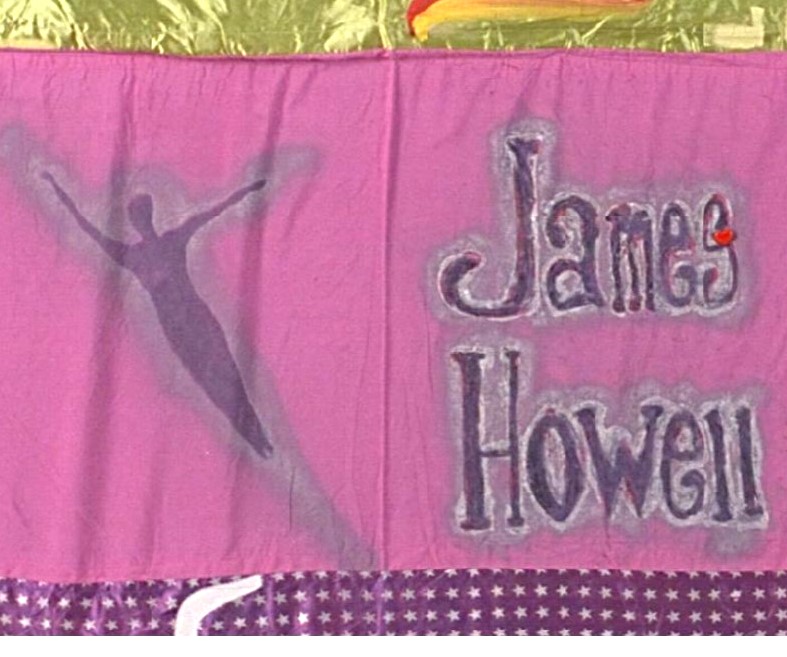
Dancer and teacher James “Jimmy” Howell dies of AIDS-related illness in San Francisco at the age of 47.
Learn More.Howell was a psychologist in Yakima, Washington, who moved to New York and then Los Angeles to dance and teach with the Joffrey Ballet. He then moved to San Francisco and started his own dance studio.
Howell performed his last ballet, Journey of the Soul, earlier in the year. A videotape of the ballet was shown at a celebration of his life.
* * * * * *
Sources:
Photo of quilt panel from the AIDS Memorial Quilt
Bay Area Reporter, “Gay Victim Dances Over Death” by Konstantin Berlandt, November 11, 1982

Patrick Cowley, a dance music pioneer who recorded with musician Sylvester in 1977-1979, dies of AIDS-related illness at his Castro District home in San Francisco at the age of 32.
Learn More.Cowley, who specialized in electronic dance music, joined Sylvester’s studio band and played synthesizer on Sylvester’s 1978 album Step II, which included the hits “You Make Me Feel (Mighty Real)” and “Dance (Disco Heat).”
In addition, he wrote “Stars” and “I Need Somebody to Love Tonight” from Sylvester’s 1979 album Stars. Cowley also joined Sylvester’s live band and joined him on several world tours.
Born in 1950 in Buffalo, New York, Cowley became a drummer with amateur bands while attending Niagara University and later the University of Buffalo. In 1971, he moved to San Francisco to attend the City College of San Francisco, where he studied music.
After working with Sylvester, Cowley produced his own hits, including “Menergy” in 1981 and “Megatron Man,” from the album of the same name. He also wrote and produced the dance single “Right on Target” for San Francisco artist Paul Parker and “Do Ya Wanna Funk,” a collaboration with Sylvester.
Cowley also did a 15’45” long remix of Donna Summer’s “I Feel Love,” which is now a collector’s item. Mind Warp, his final album, was composed as he felt the increasing effects of HIV infection.
* * * * *
Sources:
Photo of quilt panel from the AIDS Memorial Quilt
Pitchfork, “Patrick Cowley Is One of Disco’s Most Important Producers. These Are His Must-Hear Deep Cuts” by Jesse Dorris, January 17, 2018
The Guardian, “San Fran-disco: How Patrick Cowley and Sylvester Changed Dance Music Forever” by Geeta Dayal, October 26, 2016
The case of “an unexplained immunodeficiency” and opportunistic infections in a 20-month-old infant who received blood transfusions in San Francisco is described in a report by the Centers for Disease Control and Prevention.
Learn More.In “Epidemiologic Notes and Reports Possible Transfusion-Associated Acquired Immune Deficiency Syndrome (AIDS) — California,” the Mortality and Morbidity Weekly Report stated for the first time that an infant may have received the AIDS virus through an infectious agent, specifically blood.
The infant was delivered via caesarian section on March 3, 1981 and received six blood transfusions over a four-day period. Subsequent tests found that the blood transfused to the baby came from a donor infected with HIV.
“If platelet transfusion contained an etiologic agent for AIDS, one must assume that the agent can be present in the blood of a donor before onset of symptomatic illness and that the incubation period for such illness can be relatively long,” stated the CDC report in an editorial note. “This model for AIDS transmission is consistent with findings described in an investigation of a cluster of sexually related AIDS cases among homosexual men in southern California.”
* * * * * *
Source:
Mortality and Morbidity Weekly Report, “Epidemiologic Notes and Reports Possible Transfusion-Associated Acquired Immune Deficiency Syndrome (AIDS) — California,” December 10, 1982
In another MMWR report on the burgeoning issue of pediatric AIDS, the Centers for Disease Control reports four additional cases of immune-suppressed infants.
Learn More.The CDC report provides background on the infant cases:
Unlike the case of the San Francisco infant with AIDS-related symptoms, these infants had not undergone a blood transfusion. Although the nature of the immune dysfunction described in the four cases was unclear, the report pointed toward the AIDS virus as the likely commonality between these infants.
At the time, it was still unknown exactly how the virus could be transmitted from one person to another. The CDC’s report was notable in its conclusion that the deteriorating health of the infants was likely caused by an infectious agent, a theory based on the researchers’ epidemiological observations.
* * * * * *
Source:
Mortality and Morbidity Weekly Report, “Unexplained Immunodeficiency and Opportunistic Infections in Infants — New York, New Jersey, California,” December 17, 1982
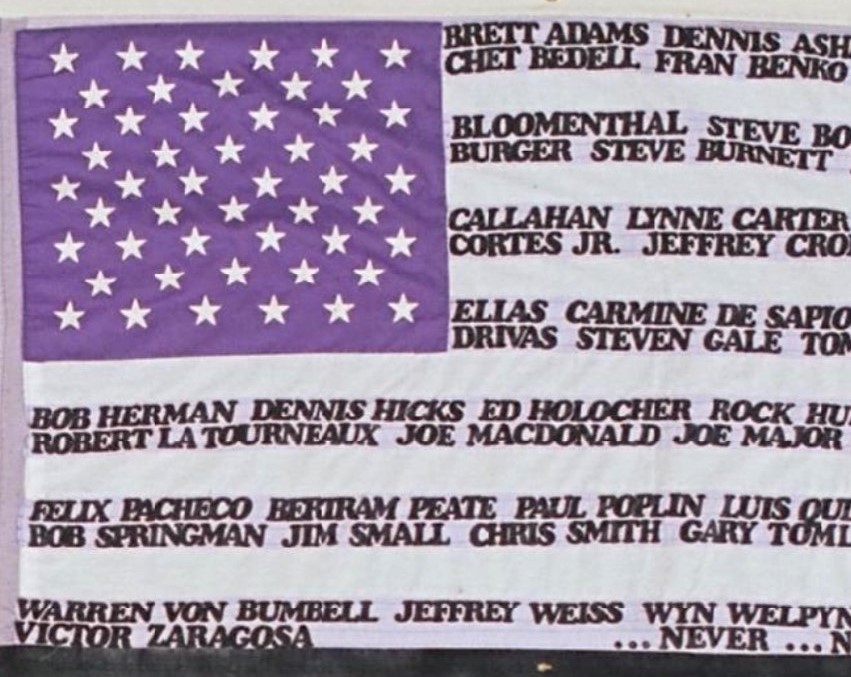
Joe MacDonald — the most popular male model of his time and a favorite photography subject of Andy Warhol and Bruce Weber — dies of AIDS-related illness in New York at the age of 37.
Learn More.Square-jawed and classicly handsome, he was frequently featured in GQ magazine during its Haber-Coulianos-Sterzin era, described by Meredith Etherington-Smith, who was GQ’s editor in the 1970s, as “so Zeitgeisty, in a tiny window of time when homosexuality was chic but not yet widely accepted.” Considered to be the first male supermodel, MacDonald counted David Hockney among his many friends and he enjoyed collecting art.
Friends were shocked to see how much MacDonald’s appearance had changed when his photo was featured in an early 1983 advertisement appearing in The New York Times fashion supplement, the results of MacDonald’s final modeling assignment.
“He looked very old,” Susi Gilder, a model who knew MacDonald personally, would tell New York magazine for an article published in June 1983. “The eyes were just very sad.”
In Vogue magazine’s 2020 retrospective on the AIDS crisis, fashion designer Michael Kors recalled MacDonald as the “first famous person who passed away” from AIDS.
“When we first started reading about [HIV/AIDS] and hearing about it, people did not want to acknowledge that this disease didn’t discriminate,” Kors told Vogue. “People thought, oh, if you’re young and you’re healthy and you, quote, live a clean life, you’re not going to get it. And then they started seeing people like Joe MacDonald and realized this was not selective. The reality became very harsh at that point.”
As the first AIDS casualty in the fashion industry, the news of MacDonald’s death sent shockwaves through New York.
“I remember walking in NYC on Columbus and 83rd – on the corner – one summer night,” model Rosie Vela told The AIDS Memorial on Instagram. “I passed Joe sitting at a crowded outdoors cafe. It was a year before he died.”
“He stood up when he saw me, and invited me to sit with him,” Vela recalled. “He was gorgeous, elegant and kind. I’ll never forget how welcome he made me feel. A true gentleman.”
* * * * * *
Sources:
Photo of quilt panel from the AIDS Memorial Quilt
GQ magazine, “It All Started Here: The Gay Legacy of GQ” by David Kamp, June 23, 2017
New York magazine, “AIDS Anxiety” by Michael Daly, May 20, 1983
Vogue magazine, “Chapter One: How Fashion Was Forever Changed by ‘The Gay Plague’” by Phillip Picardi, December 16, 2020
The AIDS Memorial on Instagram, tribute post about Joe MacDonald
Lancet medical journal reports on the case of an infant who developed multiple opportunistic infections when 6 months old after he received multiple blood transfusions when he was just days old. The infant dies of AIDS-related illness at the age of 17 months.
Learn More.Between the age of 6-14 months old, the infant developed symptoms of hepatitis, thrush, Candida dermatitis, otitis media, and Mycobacterium avium intracellulare. Tests revealed raised immunoglobulin levels, decreased mononuclear-cell responses to allogeneic cells and mitogen, and a decreased T-cell ratio.
It was determined that a blood donor, who was well at the time of blood donation, had died of AIDS about 17 months after donating. The case study’s researchers find that the infant likely acquired AIDS (“a transmissible infectious agent’) from the blood transfusion.
* * * * * *
Sources:
Lancet, “Acquired Immunodeficiency in an Infant: Possible Transmission by Means of Blood Products” by
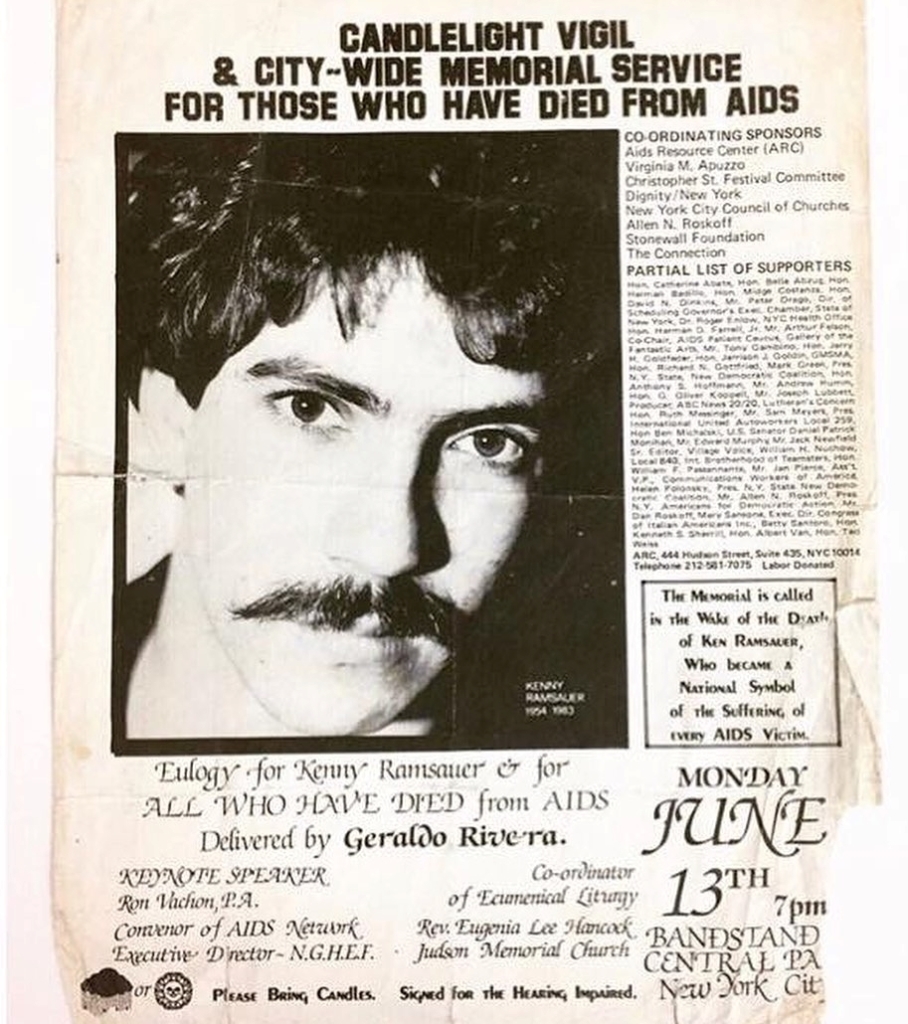
Ken Ramsauer, a businessman who was featured in reporter Geraldo Rivera’s investigative report for ABC’s 20/20, dies of AIDS-related illness in New York City. He was 29 years old.
Learn More.Ramsauer was a freelance lighting designer and hardware store manager who became the first person with AIDS to be the subject of a national television program when he was interviewed by Geraldo Rivera on 20/20.
His final televised wish was that people might gather in Central Park to remember those who had died of AIDS. The following month on June 13, more than 1,500 would gather in Central Park for a candlelight vigil to commemorate Ramsauer and others who died of AIDS. The event featured a eulogy by Rivera, a speech by New York Mayor Ed Koch, and a reading of the names of the 600 people known to have died from AIDS by that time.
”Kenny Ramsauer wanted the people of New York and of this country to learn about the disease,” Rivera told the people gathered at the park’s Naumberg Bandshell on that early summer evening. ”He wanted society to know the discrimination and negative publicity that has allowed this disease a mortal head start.”
The vigil was considered the first large gathering acknowledging the existence of the epidemic.
David France, author of How to Survive a Plague, attended the vigil with a friend and later wrote:
“The plaza was crowded with 1,500 mourners cupping candles against the darkening sky. As our eyes landed on one young man after another, it became obvious that many of them were seriously ill. A dozen men were in wheelchairs, so wasted they looked like caricatures of starvation. I watched one young man twist in pain that wsa caused, apparently, by the barest gusts of wind around us.”
Frances goes on to write that 722 cases of AIDS were reported in New York at the time, but judging from the scene around him, the numbers were likely considerably higher.
“We had found the plague,” he wrote.
* * * * * * *
Sources:
The New York Times, “1,500 Attend Central Park Memorial Service for AIDS Victim” by Lindsey Gruson, June 14, 1983
How to Survive a Plague by David France (MacMillan, 2017)
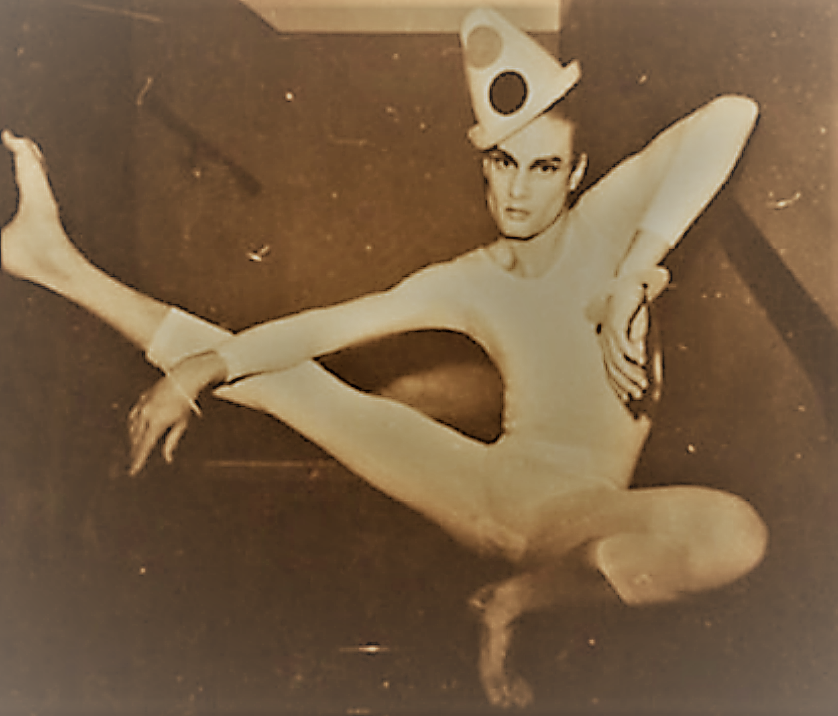
Rock star Jobriath dies of AIDS-related illness at the age of 36. He was the first openly gay pop singerto be signed to a major record label, and one of the first internationally famous musicians to die of AIDS.
Learn More.Born Bruce Wayne Campbell and raised in King of Prussia, Pennsylvania, Jobriath started his music career in the West Coast production of the musical Hair, receiving positive reviews in the lead role of Woof, a character implied to be gay. After leaving the production in 1969, he joined the folk-rock band Pidgeon as their lead singer and guitarist, followed by a two-album solo deal with Elektra Records in 1972.
His debut album Jobriath, released in June 1973, would feature an album sleeve design by photographer Shig Ikeda depicting a nude Jobriath as an ancient Greek statue. This photograph was used in an extensive publicity campaign for the album release.
Critical praise for the album followed the hype, and he was often compared with David Bowie, some critics contending that Jobriath had more talent than Bowie. But American music fans of the 1970s weren’t ready for a talent like Jobriath.
“At a concert at the Nassau Coliseum, chants of ‘faggot’ started from the minute he took the stage, along with rubbish thrown at him, and Jobriath was forced a flee the stage,” writes music historian Kevin Burke.
Elektra then rush-released Jobriath’s second album and ended its contract with him. Jobriath would spend the rest of the ’70s in a new identity, “Cole Berlin” (an amalgamation of Cole Porter and Irving Berlin), whose professions were nightclub signer and sex worker.
Jobriath had begun to feel ill in late 1981 but still managed to contribute to the Chelsea Hotel’s 100th birthday celebration in November 1982.
“A decade after his billboards hung in Times Square, Jobriath Boone died alone and abandoned in his rooftop apartment at the Chelsea Hotel,” Burke writes. “Sadly overlooking the New York skyline he once adorned, here his body lay decomposing for four days before it was found.”
* * * * * *
Source:
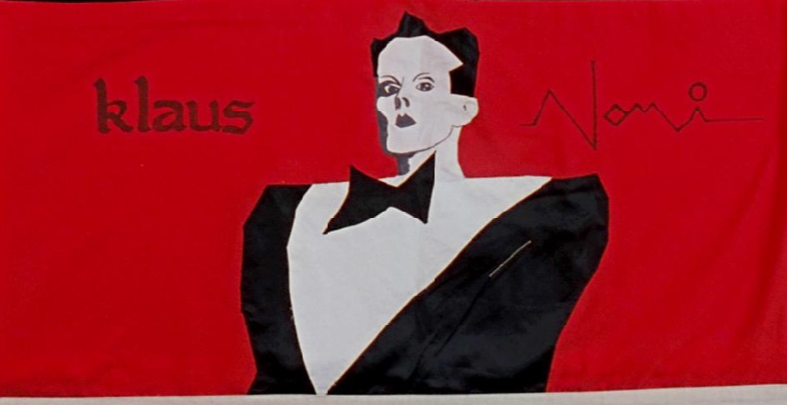
Klaus Nomi, a rare countertenor with an eccentric act, dies of AIDS at the age of 39. Although Nomi’s work had not yet met with national commercial success, he has a cult following in New York and in France.
Learn More.Nomi is an important part of the 1980s East Village scene, a hotbed of development for punk rock music, the visual arts and the avant-garde. Born Klaus Sperber in Immenstadt, Germany, Nomi began his career in the 1960s, singing opera arias at the Berlin gay discothèque Kleist Casino. His distinctive performances featured his wide vocal range and an otherworldly stage persona.
In 1972, Nomi moved to New York and appeared in a camp production of Richard Wagner’s Das Rheingold at Charles Ludlam‘s Ridiculous Theatrical Company.
In 1978, he caught the attention of the NYC art scene with his performance in “New Wave Vaudeville.” Dressed in a skin-tight spacesuit with a clear plastic cape, Nomi sang the aria “Mon cœur s’ouvre à ta voix” (“My heart opens to your voice”) from Camille Saint-Saëns’ opera Samson et Dalila. After that performance Nomi was invited to perform at clubs all over New York City.
Nomi would go on to create the Klaus Nomi Band, release albums, and perform in NYC’s top clubs. In 1979, David Bowie hired Nomi as a backup singer for his Dec. 15 appearance on Saturday Night Live. During the performance of “TVC 15,” Nomi and Joey Arias dragged around a large prop pink poodle with a television screen in its mouth.
In the last several months of his life, Nomi would change his focus to operatic pieces and adopted a Baroque era operatic outfit complete with full collar as his typical onstage attire. The collar helped cover the outbreaks of Kaposi’s sarcoma.
Nomi’s death at the Sloan Kettering Hospital Center in New York City is one of the first of many celebrity deaths from AIDS.
* * * * * * * *
Photo of quilt panel from the AIDS Memorial Quilt
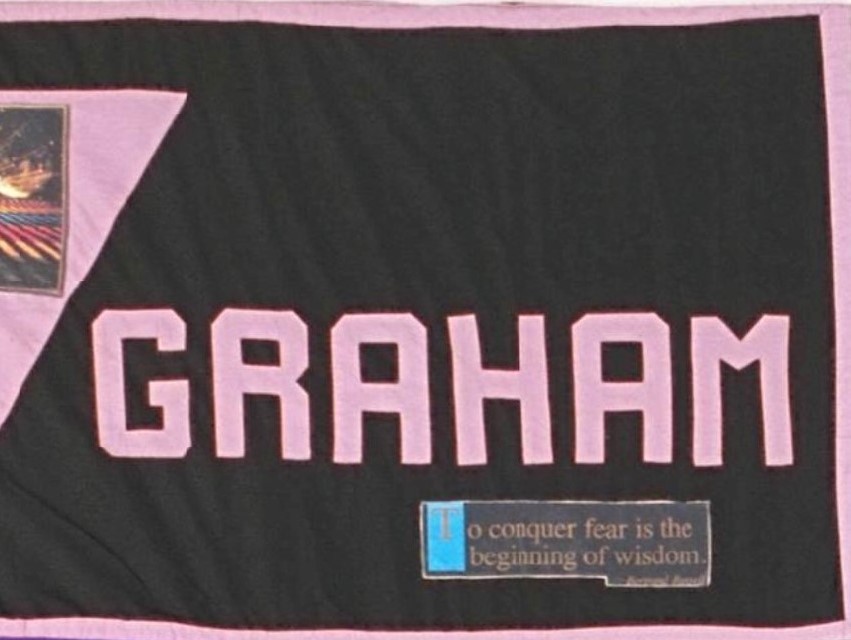
Modern dancer Graham Conley, who performed with the Margaret Jenkins Dance Company, dies of AIDS-related illness at the age of 32.
Learn More.* * * * * *
Sources:
Photo of quilt panel from the AIDS Memorial Quilt
Bay Area Reporter, June 8, 2006

A Florida hospital arranged for a private jet to fly a patient with AIDS to San Francisco, where he was left at a local AIDS foundation with $300 cash.
Learn More.Morgan MacDonald, 27, of Vero Beach, Florida, was brought to San Francisco in a chartered Lear jet after being discharged from Shands Hospital at the University of Florida at Gainesville. MacDonald told Dr. Mervyn Silverman, San Francisco’s public health director, that he was transported to California against his will.
Shands Hospital in Gainesville, Florida, spent $7,000 for a private jet to fly MacDonald to San Francisco last week and leave him on a stretcher at the office of a city-funded AIDS foundation. He was immediately transferred to the AIDS ward at San Francisco General Hospital.
Dianne Feinstein, then-Mayor of San Francisco, sent a telegram to Gov. Bob Graham of Florida, asserting that a hospital there dumped an unwanted AIDS patient by having him flown to San Francisco. She called the incident “outrageous and inhumane.”
Gov. Graham’s press secretary said Florida’s Department of Health and Rehabilitative Services would investigate the matter.
Virginia Hunt, Shands’ public relations director, defended the hospital’s actions, saying MacDonald no longer needed hospital care and the hospital was unable to find a Florida nursing home for him. She contended that the AIDS Foundation in San Francisco agreed to give Mr. MacDonald 30 days’ free housing.
But Dr. Silverman said the Florida hospital had made contact with both the City of San Francisco and the AIDS Foundation and ”played us one off against the other.”
Silverman said MacDonald was free to return to Florida, but said his condition was acute and it was essential that he receive proper care.
MacDonald would die 21 days later at San Francisco General Hospital’s AIDS Ward. MacDonald was said to have no family. Before his hospitalization, he lived in a religious commune in Florida.
* * * * * *
Source:
Russell Hartley, curator of the Archives of the Performing Arts, dies of AIDS-related illness in a San Francisco Hospital at the age of 61.
Learn More.In 1947, Hartley created the San Francisco Dance Archives, which is now known as the Museum of Performance + Design and includes 3.5 million items documenting the performing arts in the Bay Area.
By 1979, Hartley’s collection included 2,000 books, 8,000 periodicals, 4,000 slides, 5,000 negatives, 10,000 pieces of sheet music, 2,000 posters, 250 phonograph records, 25,000 historical photographs, 10,000 stills from the San Francisco Ballet, 10,000 movie stills, 12,000 theatrical prints, 500 artifacts, and 250 costumes, according to art critic Renée Renouf in Dance Chronicle.
“His unique confluence of personal artistry, a fund of personal anecdote and experience, and his single-minded devotion for the perpetuation of a collection commenced 40 years ago passes into its own special historical niche with Russell’s death,” Renouf wrote in 1983.
Born in 1924, Hartley attended Tamalpais High School in Mill Valley, California, which is located in the San Francisco Bay Area. Russell designed window displays for his father’s hardware store, according to the Museum of Performance and Design‘s Performing Arts Library. His artful window displays caught the eye of Ruby Asquith, a dance instructor who invited Hartley to visit the San Francisco Ballet studios and sketch dancers as they rehearsed.
Subsequently, he signed up for ballet classes and a year later, was given a part in Willam Christensen’s acclaimed production of Romeo and Juliet.
Early in his dance career, Hartley enjoyed success with the San Francisco Ballet in eccentric character roles between 1942 and 1949. In 1944, Christensen enlisted Hartley’s help in revising costume designs for Now the Brides, and this led to more significant work, including designing 143 costumes for the first production of the Nutcracker Suite in 1944, Pyramus and Thisbe, Coppelia, Swan Lake, Les Maitresses de Lord Byron, Jinx, Beauty and the Shepherd, and the Standard Hour television show.
Hartley’s art portfolio, Henry VIII and his Wives (1948), served as an inspiration for Rosella Hightower’s ballet by this name, which premiered in New York at the Metropolitan Opera House.
In the 1940s, Hartley became interested in collecting historical materials on local performers and dance and theatrical companies. He began combing antique stores for old dance and theatrical programs, photos, and ephemera, and these materials would become the start of his San Francisco Dance Archives.
In February 1946, Hartley, then almost 22 years old, and his friend Leo Stillwell, a 20-year-old artist, opened the Antinuous Art Gallery at 701 McAllister Street in San Francisco. Hartley began creating series of dance paintings and show windows in New York, leading to exhibitions of his paintings at the Feragil Galleries in New York, the Labaudt Gallery in San Francisco, and the Miami Beach Art Center, an exhibition on ballet at the De Young Museum, and features of his paintings in various one-man shows at galleries in San Francisco. Meanwhile, Stillwell worked furiously, creating 500 works of art before succumbing to an early death at the age of 22 following a case of measles.
Hartley carried on, executing costume designs for Balanchine’s Serenade, William Dollar’s Mendelssohn’s Concerto, Lew Christensen’s Balletino, and the San Francisco Opera Company’s productions of Aida and Rosenkavalier. He began studying the conservation of fine paintings with Gregory Padilla and carried out restoration projects for the Maxwell Galleries, the Oakland Museum, and Gumps. In 1960, he became a member of the International Institute for the Conservation of Historic and Artistic Works.
Dance Magazine hired Hartley to write a monthly column, which ran through the 1960s. He also contributed feature articles to After Dark Magazine, Opera and Concert, and The Trumpeteer.
He organized exhibitions on the history of the performing arts at the War Memorial Opera House and the main branch of the San Francisco Public Library with materials from his personal collection. In 1975, Hartley sought a permanent location for the Performing Arts Archive and was able to obtain a space in the basement of the Presidio Branch of the San Francisco Public Library.
His own archival collections, which had expanded to include materials on the history of the San Francisco Opera, San Francisco theaters, and the San Francisco Symphony, was supplemented by a dance library and other materials donated by local collectors. However, in 1981, budgetary cutbacks led to the closure of the archives and Hartley was forced to move the entire collection to his Mill Valley home.
At this time, Hartley’s health began to decline. In 1983, the archives were moved from Hartley’s home to the San Francisco Opera Chorus Room in the War Memorial Opera House and a Board of Directors was formed to ensure that Hartley’s legacy would carry on. Former San Francisco Ballet dancer Nancy Carter became the archives’ first executive director.
The archives are now known as the Museum of Performance + Design, which also serves as keeper of The Russell Hartley Collection, materials from Hartley’s early days as a costume designer for the San Francisco Ballet to his tenure as director of the Archives for the Performing Arts.
In 2016, the San Francisco Chronicle reported on the story of Alan Perry, a retired truck driver who found in a dumpster 200 letters written to Russell Hartley by his friend Leo Stillwell, the promising artist who died at the age of 22. Perry and his wife, who subsequently learned about Hartley and Stillwell and appreciated the cultural value of the find, donated the letters to San Francisco State University, where the prolific young artist’s 500 works of art are housed.

Keith Barrow, a singer and songwriter best known for the soulful “You Know You Wanna Be Loved” and the disco-beat-fueled “Turn Me Up,” dies of AIDS-related illness at Michael Reese Hospital in Chicago. He was 29 years old.
Learn More.The only son of Chicago civil rights leader Rev. Willie Barrow (1923-2015), Keith Errol Barrow started singing as a teenager with the gospel group “Soul Shakers.” His mother told Windy City Times in 2004, “Keith had music in his bones and in his soul. He started writing music when he was eight.”
After Barrow came out to his activist mother, she publicly embraced gay rights, according to The New York Times.
In 1973, Barrow released a self-titled gospel album at the age of 19 with Jewel Records, and his solo career began to gain traction with the popularity of one of the album’s singles, “Mr. Magic Man.” The major label Columbia signed him in 1976, and he left Chicago for New York and then Los Angeles. After a song he wrote for the Philadelphia R&B group Blue Magic rose in Billboard‘s Top 100 R&B hits, Barrow was invited to Philly’s famed Sigma Sound Recording Studios to work under legendary producer Bobby Eli for his first Columbia album.
The release of Barrow’s record was announced in a full-page ad in Billboard magazine for the week ending May 7, 1977. “Keith Barrow is why you should pay attention to this debut album,” the ad proclaimed.
“Though he’s not talked about much today, Keith was a true talent of his era, a singer’s singer whose velvety falsetto was on par with the finesse of Eddie Kendricks and the fancy of Sylvester,” wrote music critic S.E. Fleming Jr. in 2008. “When it was all said and done, Keith Barrow didn’t prove a huge hit, but it was a high quality effort that laid the groundwork for what would become his finest hour on record.”
Fleming says the best track on the album is Barrow’s performance of his own composition, “Teach Me (It’s Something About Love),” calling it “one of the most beautiful slow jams the singer ever recorded.”
“It was a perfect fit for a young man at a stage in his life where most people are finding their own voice, a lovely portrait of innocence and melancholy,” Fleming writes.
In 1978, Barrow switched to CBS Records, which produced his second album, Physical Attraction. Most of the material was co-written by producer Michael Stokes and songwriter Ronn Matlock, and they updated Barrow’s sound to include three disco songs.
Immediately, the seven-minute single “Turn Me Up” became a hit at dance clubs and broadened his fan base. Meanwhile, another song on the album, a smooth soul ballad titled “You Know You Want to Be Loved,” rose to #26 in Billboard‘s Top 100 R&B hits.
Barrow recorded a final album, moving to Capitol Records. Produced by Ralph Affoumado, Just As I Am (1980) was an ambitious work, but the dance sound that initially drew in fans was declining in popularity. Still, the album has a few gems, such as the seductive and funky “In the Light (Do It Better)” and “Tell Me This Ain’t Heaven,” which is reminiscent of some of his earlier work with Columbia.
Barrow tried to extend his career by performing live. While touring in Europe in 1983, he fell ill and called his mother, saying he was too sick to perform:
“He called me from Paris and said, ‘Momma, I don’t think I’ll be able to go on stage tonight. I really feel sick.’ I said, ‘Oh, you’ll be alright.’ I prayed for him and then he called again a couple of hours later and he said, ‘Momma, I can’t perform. I have to go; they have to take me to the hospital.'”
After returning to the U.S., Barrow moved back to Chicago and his mother tended to him as his health declined. After being admitted to Michael Reese Hospital, he was diagnosed with AIDS.
“I remember the first of the weekly reports that Keith was ill and the requests for prayers,” wrote Barrow’s childhood friend in 1007. “Keith’s mother is a fiery orator and fierce civil rights activist nicknamed ‘The Little Warrior,’ so it was hard to see her sadness and distress as his health declined.”
When Barrow died later that year, more than 1,000 people attended his memorial services. Barrow was one of the first people in the entertainment industry to die of AIDS, and the cause of his death was not reported in his obituary. But his mother openly talked about it in the years that followed, and she contributed a panel in memory of her son to the AIDS Memorial Quilt.
Stephen Lamb, a man living with AIDS who was profiled in a widely-read New York Times article, dies of AIDS-related illness at New York University Medical Center. He was 40.
Learn More.In a NYT article published in the December 5 issue on Page 1 of Section B, celebrated reporter Maureen Dowd chronicled Lamb’s final months.
Lamb, his body overwhelmed with cryptococcal meningitis, tuberculosis of the bone marrow, and an intestinal infection, had until recently lived on the upper east side of Manhattan and worked as a travel consultant.
One of the few visitors at Lamb’s hospital bed was William Carroll, a volunteer from the Gay Men’s Health Crisis who two months before had been assigned to be Lamb’s “buddy.” According to the NYT article, Lamb and Carroll found that they shared a love of literature, and in Lamb’s final weeks, Carroll often read to him from books of poetry by John Keats and Andrew Marvell.
“Bill and I have grown to like each other,” Lamb told the reporter four days before he died. “I just needed some companionship.”
Lamb’s death was the 514th AIDS-related fatality recorded by the City of New York. At the time, the Gay Men’s Health Crisis had provided services to 420 people with AIDS, and was facing a surge in their caseload, according to Dowd’s article.
The organization had been receiving about 50 new cases every month, but in November, they noticed a dramatic increase in the number of people with AIDS (PWAs) who needed help. Some were gay men, but there were also intravenous drug users who were heterosexual as well as people who had received tainted blood transfusions.
The GMHC was running 20 therapy groups, organizing its volunteer-run “buddy” program, and operating a 24-hour hotline which received an average of 1,200 calls every week, according to the article.
The organization’s volunteers, which then numbered about 200, did whatever was needed, from taking orange juice to homebound PWAs to serving as intermediaries with the city’s social-service agencies.
“They clean apartments, do laundry, make dinner, pick up prescriptions, mail rent checks, walk dogs, take their patients to doctor’s appointments, and simply keep them company,” Dowd reported.
Many of the volunteers, she wrote, had horror stories about the terrible treatment of PWAs.
“They tell of government clerks who neglect AIDS cases, because they are afraid to be in the same room to fill out forms. They tell of nurses and orderlies in hospitals who are so loath to enter the rooms of AIDS patients that they let the food trays pile up outside the door, leave trash baskets overflowing, or neglect patients lying in their own urine or excrement,” wrote Dowd.
One volunteer, Diego Lopez, told the reporter that he went to visit a dying patient in the hospital, and discovered him with blood seeping from his nose and mouth. When he asked a doctor to help the patient, the doctor handed him some gauze and told him to take care of it himself.
“I was shocked, but I did it,” Lopez said. “Afterward, I looked at my hands and there was blood all over them. I realized I had to start being more careful. But when you see a person dying, you don’t think about finding some gloves to wear.”
Dowd closed her article with a conversation she had with Larry Kramer, co-founder of Gay Men’s Health Crisis. Kramer told Dowd of how the AIDS crisis had deeply affected him. Already, 37 of his friends in New York were dead from the disease.
“I heard about Vinny on Saturday,” Kramer said. “Ron is a Black actor I know. Paul, a pianist. Gayle went to Yale with me. Ron Doud, the designer of Studio 54. Mark, I was involved with a long time ago. Peter, an architect.”
“Can’t something be done?” he asked, clenching a small green notebook he used to record the names of his dead friends. “The rest of the city, my straight friends, go on with life as usual — and I’m in the middle of an epidemic.”
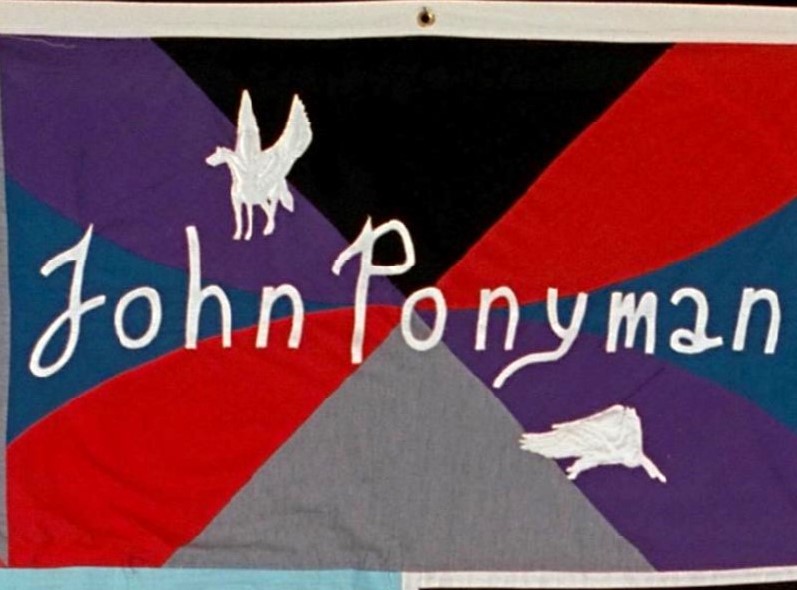
John Ponyman, an off-Broadway actor who migrated to San Francisco, dies of AIDS- related illness at the age of 41.
Learn More.Ponyman regularly appeared in shows at Theatre Rhinoceros. His final project was a solo show titled “Sawdust,” featuring several of his own songs.
* * * * * * * *
Photo of quilt panel from the AIDS Memorial Quilt
Philip Mandelker, who produced the television show The Dukes of Hazzard and 17 made-for-TV movies between 1974-1984, dies of AIDS-related illness in Los Angeles. He was 45.
Learn More.When Mandelker was diagnosed with AIDS in 1983, the first person he called was his friend Rob Eichberg, a Los Angeles clinical psychologist active in the LGBTQ+ community.
“His family was very dedicated to him and they insisted on people knowing Philip died of AIDS,” Eichberg told the Los Angeles Times.
“The day Philip died, I cried,” said Mandelker’s sister, Jane Makowka. “But I had cried my tears for months before. I knew a long time before anybody ever said it was AIDS that it was.”
Makowka said that her brother had a passion for living life to its fullest, which allowed him to bring a special quality to his television shows.
“Most important was his love of people and love of nature. He tried to bring that, something of quality to television, something people would remember,” she said. “He was very fortunate to have been as successful as he was in that short of a lifetime. You wonder what he might have done if it hadn’t been cut short.”
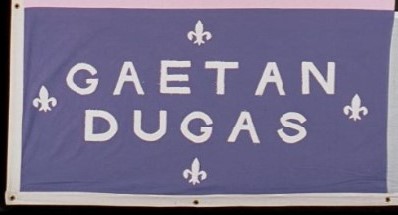
Gaëtan Dugas dies of AIDS in Quebec City at the age of 32. A few years later, Dugas would be erroneously vilified as “Patient Zero” due to the CDC’s labeling of his case as “patient O” (as in the letter O).
Learn More.In 1987, three years after the death of Dugas, journalist Randy Shilts would publish the best-selling book And the Band Played On, an influential work on HIV that would help shame the U.S. Government into properly funding research.
In the book, Shilts would identify “patient zero” as Dugas, who had a home in Los Angeles and travelled to many cities, and implied that he was the first-known source of the HIV spread in the U.S.
The media would erupt: Dugas’ hansome face would be pubished everywhere, and he would be characterised as a kind of “typhoid Mary” who callously spread the virus in the early 1980s.
Flash-forward to 2016, when this would be scientifically disproven by a group of researchers led by evolutionary biologist Dr. Michael Worobey. Worobey’s team conducted a genetic study of blood samples taken from gay and bisexual men in 1978 and 1979 as part of a hepatitis B study, and based on the results of the data, concluded that Dugas was not the source of the virus in the U.S.
“On the family tree of the virus, Dugas fell in the middle, not at the beginning” Worobey concluded. “Beliefs about Patient Zero are unsupported by scientific data.”
Worobey’s paper, published in Nature in October 2016, finds neither biological nor historical evidence that Dugas was the primary case in the U.S.
It is also important to note that Dugas was particularly helpful and transparent with the CDC in tracing his network of partners, providing names and addresses for many of them (which was further expanded because others remembered his distinctive name).
* * * * * * * *
Photo of quilt panel from the AIDS Memorial Quilt

Performer Bill Kendall, who received rave reviews for his portrayal of “Mr. Peanut” in the long-running San Francisco production of Beach Blanket Babylon, dies of AIDS-related illness at the age of 35.
Learn More.
Beach Blanket Babylon was the world’s longest-running musical revue at the time. The show began its run in 1974 at the Savoy Tivoli and later moved to the larger Club Fugazi in the North Beach district of San Francisco.
Kendall was in the production’s original 1974 cast and continued to be a featured performer through 1982, playing the roles of Superman, John Travolta Sat Night Fever, and The Original Mr. Peanut.
Beach Blanket Babylon was created by Steve Silver, who died of AIDS-related illness in 1995. The San Francisco Chronicle described the show’s roots as a combination of “Vegas lounge acts, the Follies Bergere, God Rush-era extravaganzas, English music halls, a child’s birthday party gone mad and dopey beach party movies.”
* * * * * * * *
Photo of quilt panel from the AIDS Memorial Quilt

Dennis Yount, a Marine who served in the Presidential Honor Guard at President Kennedy’s bier in the Capitol Rotunda, dies of AIDS-related illness at the age of 43.
Learn More.Yount was born in North Carolina and attended North Carolina University at Columbia before joining the Marines. In 1970, he moved to New York City and became a favorite bartender at the Village bar Trilogy. He moved to San Francisco in 1980 and began tending bar at the Eagle.
Once relocated to the Bay Area, Yount pursued his long-held interest in acting and performed in local stage productions of Delivery and Sunsets.
* * * * * * * *
Photo of quilt panel from the AIDS Memorial Quilt

Allan Estes, the founding artistic director of Theatre Rhinoceros in San Francisco, dies of AIDS-related illness at the age of 29. His final project, “The AIDS Show,” would become the first work by a theater company to deal with the AIDS epidemic.
Learn More.Theatre Rhinoceros is the nation’s oldest and longest-running LGBTQIA+ theater, founded in 1977 by Estes.
Estes came to San Francisco from Boston in 1977 with one goal: to establish a theater where the gay community could go to make and see theater which reflected the realities and joys of homosexual life.
From 1977 until 1984, Estes and Theatre Rhinoceros produced works by gay New York writers that included Doric Wilson, Robert Patrick, Lanford Wilson, Terrence McNally, and Harvey Fierstein, as well as several San Francisco playwrights including C.D. Arnold, Robert Chesley, Cal Youmans, Philip Real, and Dan Curzon.
In the early 1980s, Allan began transforming the Rhino from a gay men’s theater into a lesbian and gay theater, and invited lesbian screenwriters to stage their plays.
In 1984, he conceived the production Artists Involved with Death and Survival (“The AIDS Show”), which was brought to fruition by director Leland Moss (who would die from AIDS at age 41) and included the works of 20 Bay Area playwrights. “The AIDS Show” became the first work by a theater company to deal with the AIDS epidemic.
In 1987, “The AIDS Show” and its touring company became the subject of a PBS documentary by Rob Epstein and Peter Adair and brought the Rhino national attention.
When Estes died, his friends and collaborators vowed to continue Theatre Rhinoceros as a monument to their fallen leader.
* * * * * * * *
Photo of quilt panel from the AIDS Memorial Quilt
Bay Area dancer Charles “Charlie” Butts, who performed with Carlos Carvajal’s Dance Spectrum from 1876 to 1980, dies of AIDS-related illness at the age of 31.
Learn More.Butts also danced with Xoregos Dance Company in San Francisco, Ballet Trocadero de Monte Carlo in New York, and Valerie Huston Dance Company in Santa Barbara
Born in Mississippi, Butts grew up in Los Angeles and studied dance at the University of California Irvine. He performed both locally (in San Francisco and Santa Barbara) as well as in company tours to South America and Japan.
* * * * * * * *
Source: San Francisco Examiner, December 7, 1986
Singer-songwriter António Variações, Portugal’s first gay superstar, dies of AIDS-related illiness in Lisbon, Portugal at the age of 39.
Learn More.Variações made his TV debut in 1981 during the Sunday variety show on Portugal’s sole broadcaster, recounts Pedro João Santos in his Guardian profile.
“He sang a punk metaphor about pills while a dancer dressed as a giant aspirin threw Smarties at the dumbfounded audience,” writes Santos. “Nothing so transgressive had ever graced Portugal’s airwaves.”
His 1983 bestselling debut album, Anjo da Guarda (Guardian Angel), features Variações’ Portuguese folk-style singing set to new-wave music. His follow-up album, Dar & Receber, fused disco-rock with synthpop.
In May 1984, Variações was admitted to hospital due to illness, according to The AIDS Memorial. Except for his family and close friends, he received few visitors during his hospital stay. A month later, the media reported that his health had deteriorated and rumours began to circulate that he had AIDS.
The initial cause of Variações’ death would be reported as bilateral bronchial pneumonia. At his funeral on June 15, 1984, the coffin would be sealed shut by order of the Portugese government.
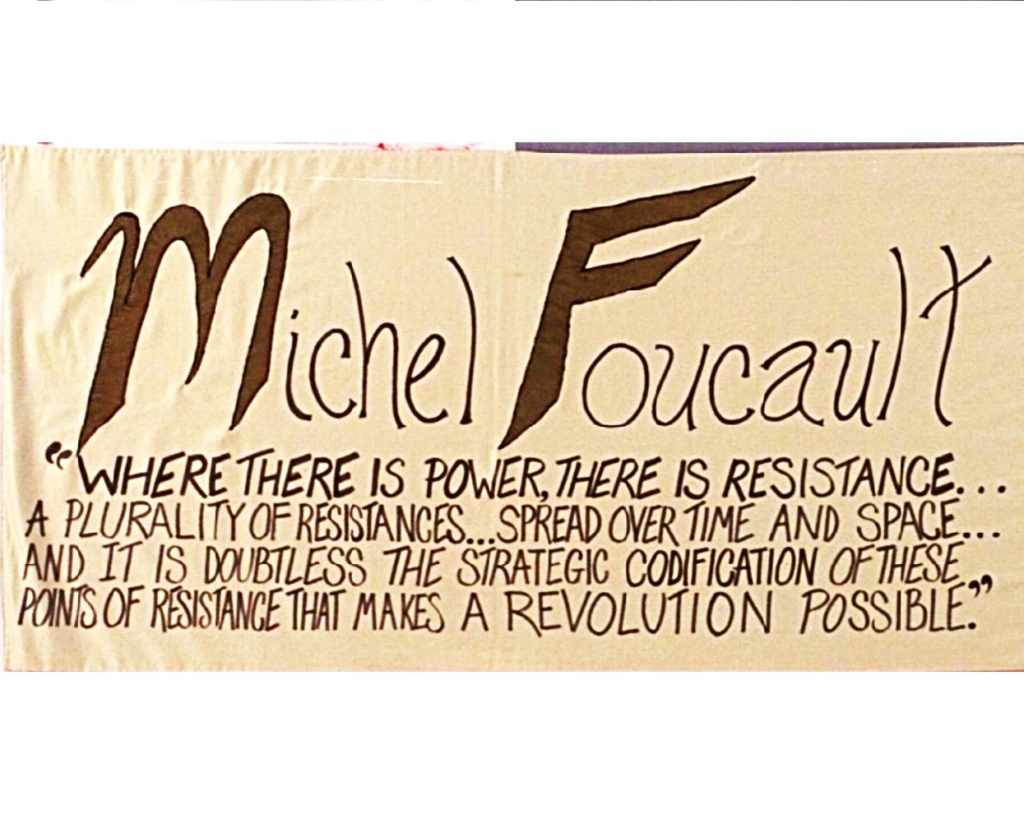
Michel Foucault, one of the most influential and controversial scholars of the post-World War II period, dies of AIDS-related illness at the age of 57.
Learn More.
A day later, French newspaper Libération would include in the obituary the rumor that the cause of Foucault’s death was AIDS. In response, Le Monde would issue a medical bulletin cleared by his family that makes no reference to HIV/AIDS.
On June 29, Foucault’s la levée du corps ceremony would be held, during which his coffin was carried from the hospital morgue to the cemetery at Vendeuvre-du-Poitou. Hundreds attend, including activists and academic friends, and French philosopher Gilles Deleuze gave a speech that included excerpts from Foucault’s ground-breaking work The History of Sexuality.
The son and grandson of physicians, Foucault was born to a bourgeois family. He enrolled at the age of 20 to the École Normale Supérieure in Paris in 1946, and established a reputation as a sedulous, brilliant, and eccentric student.
After graduating in 1952, Foucault travelled Europe, issued monographs of his work and, in 1969, published L’Archéologie du savoir (The Archaeology of Knowledge), which won him attention as one of the most original and controversial thinkers of his day.
A year later, he was awarded a chair position at the Collège de France, the country’s most prestigious postsecondary institution, and began conducting intensive research.
Between 1971 and 1984 Foucault wrote several works, including Surveiller et punir: naissance de la prison (1975; Discipline and Punish: The Birth of the Prison); three volumes of a history of Western sexuality; and numerous essays.
Foucault continued to travel widely, and as his reputation grew he spent extended periods in Brazil, Japan, Italy, Canada, and the U.S. He became particularly attached to San Francisco, where he was a visiting lecturer at the University of California at Berkeley for several years.
Although Foucault reportedly despised the label “homosexual,” he was openly gay and occasionally praised the pleasures of sadomasochism and the bathhouse. Foucault died while he was working on the fourth volume of his history of sexuality.
Foucault’s partner Daniel Defert would go on to found the first HIV/AIDS organization in France, AIDES; a play on the French language word for “help” (aide) and the English language acronym for the disease. In 1986, two years after Foucault’s death, Defert would publicly announce that Foucault’s death was AIDS-related.
* * * * * * * *
Photo of quilt panel from the AIDS Memorial Quilt
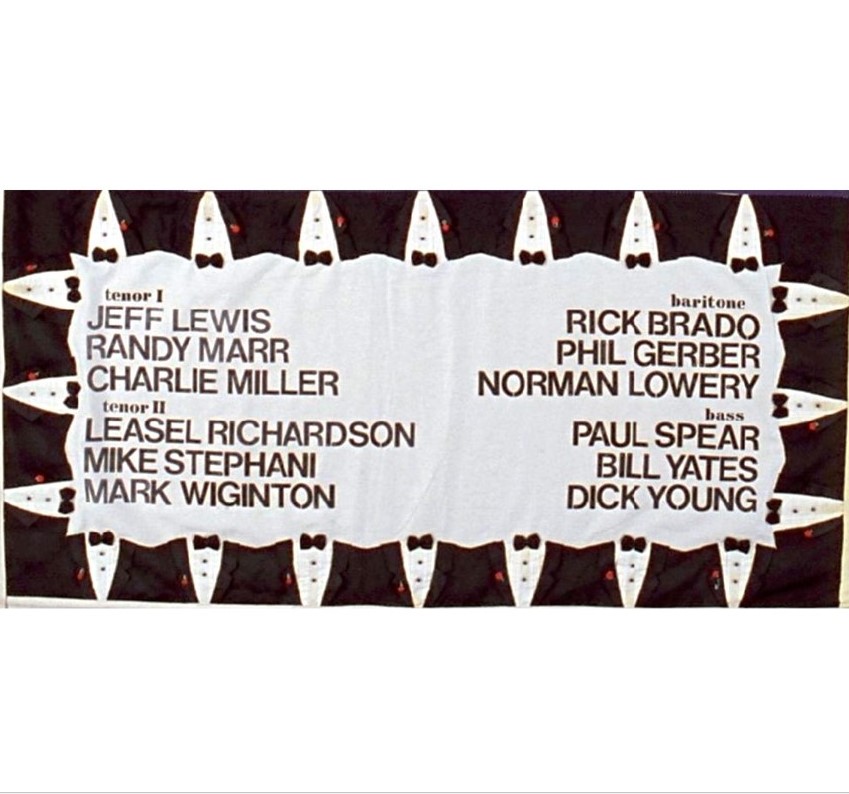
Charley Miller, a tenor with the Turtle Creek Chorale in Dallas, becomes the first of many in the group to die of AIDS-related illness. He was 30 years old.
Learn More.Charley Miller first performed with the Turtle Creek Chorale in July 1981 and he continued to sing with the group through June 1984. During that time, he was featured in the following productions:
Showtime ’81 (July 1981) – “Tomorrow Belongs To Me” from Cabaret as part of a Quartet
The Music of America (July 1982) – Texas Medley in a Septet and “I’ve Got Rhythm” as a member of the Showstoppers
Wintersong (December 1982) – “Cantata 142 – Un ist ein Kind geboren – Air” as a solo
Sing Gloria! (November 1983) – “Satin Doll,” “Java Jive,” “Dream,” “Georgia On My Mind,” and “Save the Bones for Henry Jones” as a member of the Turtle Creek Jazz
Sing We Nowell (December 1983) – “The Three Kings” as a part of a sextet
Of Three We Sing (June 1984) – “Credo” as a Duet, “Agnus Dei” as a solo
Miller was the first AIDS-related death for the Turtle Creek Chorale or, possibly, the first acknowledged AIDS death, according to the Chorale’s memorial website.
The Turtle Creek Chorale was founded in early 1980 by Don Essmiller, Phil Gerber, and Rodger Wilson over drinks at The Crews Inn, a gay bar in Dallas, according to Michael Sullivan in The Dallas Way. They named the group after the small stream that passed through the queer-friendly Dallas neighborhood of Oak Lawn.
“In some cities, the newly-formed choruses boldly chose to use the word ‘gay’ in their name, but in the buckle of the Bible Belt, the founders of just such a chorus in Dallas decided against it for what seemed obvious reasons,” Sullivan wrote in 2017.
Chief among those reasons was the fact that many of the singers were public school teachers, and the local superintendent was a notoriously homophobic man who threatened to fire openly gay teachers.
The group first rehearsed in February 1980 with 39 singers. On June 24, 1980, 70 members of the Chorale gave its first formal concert at the campus of Southern Methodist University in Dallas. By the end of its first season, the group had grown to 83 members.
By 1985, the Chorale was heavily impacted by the HIV/AIDS epidemic. As members began to get sick and die, the group transformed to become a space for its members to grieve and heal through performance and community, according to the University of North Texas’ 2017 exhibit Threads of Remembrance.
In its 1987 holiday performance, the Turtle Creek Chorale placed a poinsettia on the piano to honor the memory of those who had died of HIV/AIDS. When the number of fatalities reached 20, the tradition evolved into having a poinsettia placed at the front of the stage for each individual.
In April 1994, PBS would televise the documentary After Goodbye: An AIDS Story, which looked at the impact of AIDS on the Turtle Creek Chorale. The film followed the group through rehearsals and performances of When We No Longer Touch: A Cycle of Songs for Survival, a choral rendition of the stages of grief that was composed by composer-in-residence Kristopher Anthony.
At the time it was filmed in 1993, the Chorale had already lost more than 90 members to AIDS. Among them was Anthony, who died on June 26, 1992 at the age of 38.
By 2013, the AIDS death toll at the Chorale would reach 197. Still to this day, during its holiday performances, the group places on the stage a field of poinsettia plants, one for each Chorale member who has passed.
* * * * * * * *
Photo of quilt panel from the AIDS Memorial Quilt
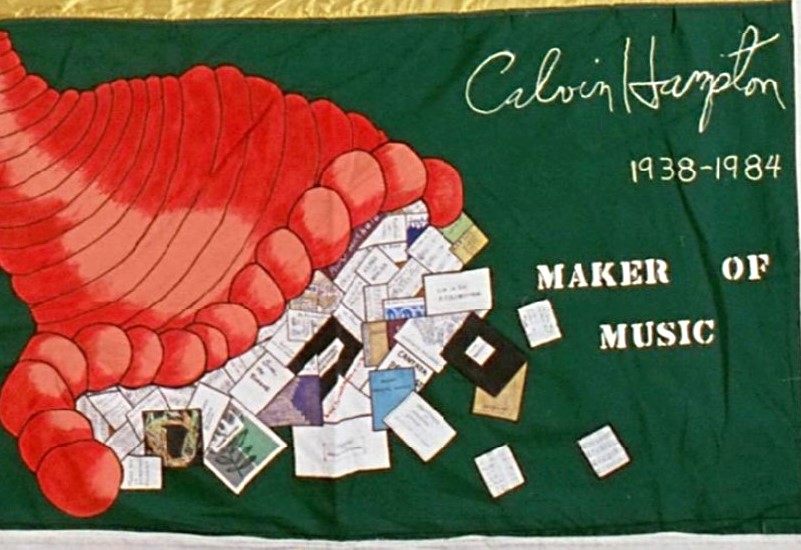
Calvin Hampton, the organist and choirmaster at Calvary Episcopal Church in Manhattan’s Gramercy Park neighborhood from 1963 to 1983, dies of AIDS-related illness near his parents’ Florida home. He was 45.
Learn More.Known nationwide as a leading organist and sacred music composer, Hampton presided over the popular “Fridays at Midnight” organ recital series, which ran from 1974 to 1983. He also composed music for the church and the concert stage.
In 1974, he composed music for Walter Leyden Brown’s production of Herman Melville’s Pierre, or the Ambiguities, which was produced at La MaMa Experimental Theatre Club in New York City.
Erik Routley, an authority on church music, called Hampton “the greatest living composer of hymn tunes.”
“An iconoclastic performer with distinctive ideas, he often incorporated organ transcriptions of 19th-century orchestral music into his programs,” wrote Tim Page of the New York Times. “Mr. Hampton was a prolific and eclectic composer, utilizing such diverse elements as rock, gospel hymns, synthesizers and quarter tones in his works.”
Hampton stopped working at the church in 1983 to concentrate on composition and organ consulting for several important classical organs in the U.S. He contracted AIDS but remained active until the final few weeks of his life, composing the massive Alexander Variations for two pipe organs while largely bedridden.
* * * * * * * *
Photo of quilt panel from the AIDS Memorial Quilt

AIDS activist Bobbi Campbell dies of AIDS-related illness in San Francisco at the age of 32.
Learn More.Just one month earlier, Campbell spoke at the National March for Lesbian and Gay Rights at the 1984 Democratic National Convention in San Francisco.
Campbell told the crowd that he had hugged his boyfriend on the cover of Newsweek, “to show Middle America that gay love is beautiful.” He held 15 seconds of silence for the 2,000 who had died of AIDS at that point “and [for] those who will die before this is over.”
He then laid-out a series of concerns for politicians to address — including increased funding for both research and support services and a warning of the potential for discrimination with the advent of a test for HTLV-3 (now known as HIV) — and appealing to all candidates in the upcoming elections to meet with people with AIDS.
Two weeks after his DNC speech, Campbell appeared on CBS Evening News with Dan Rather. While the rumors and fear of AIDS had reached a mainstream audience, the facts had not, so Campbell was placed in a glass booth, with technicians refusing to come near him to wire up microphones for the interview.
At noon on August 15, 1984, exactly a month after his DNC speech and after 2 days on life support in intensive care, Bobbi Campbell died at San Francisco General Hospital. His parents and his partner Bobby Hilliard were by his side. Bobbi Campbell was 32 years old and had lived for over 3½ years with what was by then called AIDS.
His partner Bobby Hilliard would succumb to the deadly disease not long afterwards.
* * * * * * * *
Photo of quilt panel from the AIDS Memorial Quilt
Lawrence ‘La-La’ Beach, one of the founders and principal owners of the San Francisco bar The Balcony, dies of AIDS-related illness at the San Francisco Hospice at the age of 42.
Learn More.In 1977, Beach opened The Balcony on the north side of Market Street with co-owners Lee Harington and Terry Scott. Commonly referred to as “The Baloney” after the “c” in the signage was dislodged, the venue earned a reputation as one of the most outrageous gay bars on the west coast, according to the Bay Area Reporter.
Born in Oneida, New York, Beach was born in 1942. He received a Bachelor’s degree from Bowdoin College and a law degree from Duke University. He joined the Navy and was stationed at Treasure Island, where he served as a legal adjutant.
After being discharged from the Navy, Beach held a series of corporate jobs, and then changed the course of his career when he took a job as floor manager of The Ambush Bar on Folsom Street. It was at The Ambush where Beach met his future co-owners, Harington and Scott.
The Balcony would close in March 1982. Beach would become an early casualty of the AIDS epidemic.
Dennis Parker, a New York actor who performed on the daytime television show The Edge of Night after starring in several adult films in the late 1970s, dies of AIDS-related illness. He was 39.
Learn More.Parker joined the cast of The Edge of Night in 1979 as Police Chief Derek Mallory, and he appeared in more than 500 episodes before he became too sick to continue with the show.
Born Dennis Posa in 1946, Parker grew up in Freeport, Long Island and attended the Philadelphia Museum College of Art, where he had his first taste of acting. He left college and returned to New York to pursue a career as a stage actor.
Becoming frustrated with the difficulty of landing good roles, he took on work as a carpenter and also as an illustrator for Jiffy Simplicity, a company that sold sewing patterns. He also started posing nude for art classes.
In the mid-1970s, he met the love of his life in another aspiring actor, Joey Alan Phipps. Eleven years Parker’s junior, Phipps soon moved into Parker’s rent-controlled apartment on Manhattan’s East 38th Street and introduced him to a new career path as a model for gay porn magazines, according to “The Story of Wade Nichols and Dennis Parker” in the Rialto Report..
In 1975, Parker appeared in his first adult film, Boy ‘Napped, under the name Wade Nichols, created from his middle name and his father’s first name. This was followed by 26 additional adult films, all released between 1976 and 1979.
Around this time, Parker met Jacques Morali, a French music producer who was about to become famous for launching The Village People.
“Jacques was instantly attracted by this sexy and handsome guy,” said Henri Belolo, Morali’s creative partner. “He was always attracted to a good-looking mustache.”
Parker moved into Morali’s luxury apartment in the East 50s, but continued to see Phipps “when he could,” said Parker’s friend Tip Sanderson. Morali initially offered Parker a role in his new music group — The Village People — but then decided to change direction and wait until he could arrange for Parker a career as a solo act, Sanderson said.
In 1978, Morali made good on his promise by securing a record deal for Parker with Casablanca Records. He assembled a selection of songs, singling out the two strongest, “Like an Eagle” and “New York By Night.” Morali’s partner Belolo became the executive producer of the singles.
“Before the recording sessions, Jacques made Dennis prepare intensively, taking singing lessons and practicing a lot,” Belolo said. “He really made Dennis work hard.”
Parker went to Sigma Sound to record the album, which was titled Like an Eagle after the song they thought was the most likely to become a hit. According to Belolo, he and Morali tapped their top creative resources for the project.
“We had the best musicians and arrangers,” he said. “In fact, we used the same rhythm section that was featured on the Village People records.”
“Jacques Morali contacted me, and told me to come down to play on his boyfriend’s record,” said bass player Alfonso Carey, who remembered Parker as easy-going and friendly. “I’m the bass player that played on all the Village People hits, from ‘YMCA,’ ‘Macho Man,’ and the rest. I also wrote the song ‘Why Don’t You Boogie’ for Dennis.”
Like an Eagle was released in 1979 under the artist name “Dennis Parker” to sever ties with his adult film career and his other identity, Wade Nichols.
Parker’s brother, Richard Posa, said that he remembered asking Parker if the new album release meant that he would stop making adult films.
“Dennis said yes, but he was pleased with the work he’d done nevertheless,” Posa said. “He also mentioned that Screw magazine had voted him ‘Man of the Year’ in 1978 – and he got a kick out of that.”
Parker went to Europe to promote the album. Afterward, Parker and Morali’s’ relationship started to cool, according to “The Story of Wade Nichols and Dennis Parker” in the Rialto Report. Ultimately, Parker returned to his apartment on East 38th Street and invited Joey Alan Phipps to come back.
Parker also returned to another old love – acting. He leveraged his disco fame to land him auditions for mainstream parts. On a casting call for a role as an extra on the crime-themed soap opera The Edge of Night, Parker caught the eye of the producer and was offered a recurring role as the local police chief.
He would play the role of Chief Derek Mallory in more than 500 episodes between 1979 and 1984. He settled easily into his new life as a television actor and embraced all that it entailed, performing at fundraisers for local non-profits and scoring points for The Edge of Night softball team.
“There were a lot of very athletic guys on the crew and in the cast,” said castmate Sharon Gabet. “Dennis would show up in these tight shorts … and an ascot. He would be there swinging a bat – with his ascot. It was hilarious.”
In the spring of 1984, Parker told his brother that he was experiencing night sweats and prolonged bouts of fatigue. He took some time off The Edge of Night, and when he returned, it was apparent to the cast and crew that he had lost a lot of weight and could not move well.
“They were careful to shoot around his frailty,” Parker’s brother said. “They had him sitting at desks. They did their best to cover up his physical deterioration.”
Meanwhile, Phipps tended to Parker throughout his illness and took him to appointments at Cabrini Medical Center in mid-town Manhattan.
“Now when I look back, it’s pretty evident to me that the man was dying,” said castmate Sharon Gabet. “He would just have enough energy to give his lines, and then you would find him asleep in the chair or laying on one of the couches. He just couldn’t do it anymore. They kept cutting his part back.”
His last episode aired on October 18, 1984, just 12 days shy of his fifth anniversary on the show.
After Parker’s death in late January 1985, Phipps moved to Palm Springs, California. In the early 1990s, he contracted AIDS and tried to manage his illness with new treatments that had become available. Unfortunately, Phipps had an additional health issue that caused his body to reject the new drugs, and he died of AIDS-related illness on December 6, 1996.
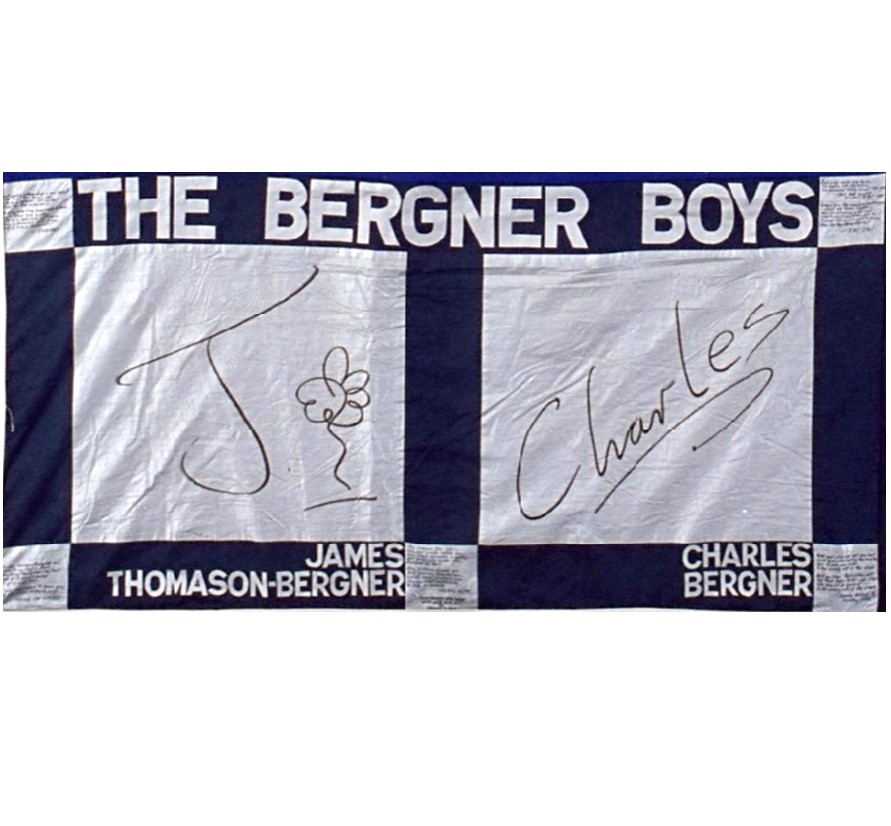
James Thomason-Bergner, musical director and conductor for the San Francisco production of Beach Blanket Babylon, dies of AIDS-related illness on his 40th birthday.
Learn More.Thomason-Bergner was also a vocal coach and headed the musical theater program at Lone Mountain College. He had been musical director for the Theatre of Music in Santa Fe, as well as for the Santa Fe Community Theater.
Originally from Austin, Texas, Thomason-Bergner graduated from the University of Texas and then moved to San Francisco to attend Lone Mountain College.
His younger brother, Charles “Charlie” Bergner, had died in late 1983 of AIDS-related illness at the age of 34. Both James and Charles were valued members of their local churches, James attending the Santa Fe Unitarian Church and Charles attending Washington Square United Methodist Church in New York City.
“I knew that Charles was interested in healing and prayer and meditation,” wrote fellow congregant Nancy A. Carter in 1985. “I asked if he would like me to do healing work with him. He said, ‘Yes.’ I explained therapeutic touch, a type of laying on of hands that I would use with him.”
Carter recalled that when she worked on Bergner, he experienced “vivid, colorful imagery … in the form of a windmill.”
“He said that the windmill was standing on parched land, but the wind was blowing and the windmill was drawing up water from beneath the earth and was nourishing the dry land,” Carter wrote. “The image of the windmill became very important to us. Most every time I worked with Charles, the windmill appeared to him.”
As she provided care for her friend, she said she realized that if his death was inevitable, at least she could assist with his spiritual healing.
“Charles suffered with AIDS, but he did not suffer the way that some do. He had love and he had courage which sustained him. God was with him. Charles reached out to friends and friends reached out to him,” she said.
On Sunday, December 25, 1983, the congregation telephoned Bergner to sing Christmas carols to him as he lay in a hospital bed, battling pneumocystis carinii pneumonia. He died the next day, with his partner David and his sister at his side.
Carter recalled how in 1983, Washington Square Church began providing pastoral services to all persons living with AIDS. The church also made available space for support groups affiliated with the Gay Men’s Health Crisis to use for meetings.
“We were one of the first churches to go into HIV/AIDS ministry,” Carter said.
* * * * * * * *
Photo of quilt panel from the AIDS Memorial Quilt

James Patterson Miller, a Chicago actor known professionally as J. Pat Miller, dies of AIDS-related illness in Chicago at the age of 39.
Learn More.Miller was nominated for Jefferson Awards for playing the title role in Peter Handke’s Kaspar and for his performance as Antonin Artaud in the Victory Gardens Theater production of Artaud.
Miller made his theatrical debut in Whores of Babylon, the debut production of the Godzilla Rainbow Troupe, cofounded by Gary Tucker and Tommy Biscotto.
“Most vividly, I remember the actor whose performance [a theater critic] praised without naming the artist who delivered it. He was J. Pat Miller, making his Chicago stage debut,” wrote Albert Williams in the Chicago Reader.
Miller went on to become one of Chicago’s most popular and respected actors with performances at the Goodman, Organic, Victory Gardens, and Wisdom Bridge, as well as a celebrated European tour of Waiting for Godot.
In May 1985, Season of Concern would launch the Biscotto-Miller Fund, named in memory of Miller and another luminary of the Chicago theater world, Tommy Biscotto. The fund was created in tandem with the benefit performance event, Arts Against AIDS at Second City to raise money for medical care, food, housing, and other basic needs to Chicago theater artists with HIV/AIDS.
Over the next few years, this volunteer effort expanded into Season of Concern — a full-time, professional operation that raises money for local direct-care organizations serving community members fighting AIDS and other catastrophic illnesses. The Biscotto-Miller Fund continues as an emergency fund, offering direct cash grants to individuals in need.
* * * * * * * *
Photo of quilt panel from the AIDS Memorial Quilt
The Center for Disease Control reports that as of April 30, 1985, the number of AIDS cases in the U.S. has increased substantially. Of the 10,000 reported cases, 9,887 are adults and 113 are children.
Learn More.Since the initial reports of AIDS in the spring of 1981, the number of cases reported each half-year has increased significantly, with more than half of the 10,000 cases being reported within the last year.
Of the 10,000 reported AIDS cases, 4,942 are known to have died (49% of the adults and 69% of the children). About 75% of patients diagnosed before January 1983 are known dead.
The CDC report states that 90% of adult patients are 20-49 years old, and 94% are men. The racial breakdown of the cases are: 60% white; 25% black; and 14% Hispanic.
The report also notes that the proportion of AIDS cases in transfusion recipients has increased significantly.
At this point, AIDS has been diagnosed in patients from 46 states, the District of Columbia, and three U.S. territories. Among cases reported before May 1983, 47% of the adults were residents of New York. As the virus spread geographically between 1984 and 1985, the proportion of adults reported with AIDS from New York decreased to 34%.
Among the 113 pediatric patients, 58% percent were under 1 year old at diagnosis; and 72% came from families in which one or both parents had AIDS or were at increased risk for developing AIDS, 13% had received transfusions of blood or blood components before their onsets of illness, and 5% had hemophilia.
Pediatric cases were reported from 17 states; 82% were from New York, New Jersey, Florida, and California. Of the 81 pediatric patients with a parent with AIDS or at increased risk for AIDS, 69 were residents of New York, New Jersey, or Florida.
Mark Spaeth, an Austin City Councilmember who was the former husband of Gunsmoke star Amanda Blake, died of AIDS-related illness at Brackenridge Hospital in Austin. He was 45.
Learn More.Mark Spaeth is remembered most as the politically ambitious Austin City Councilmember who married “Miss Kitty” of Gunsmoke.
As a Florida teenager, Spaeth left high school before graduating to join the U.S. Coast Guard. He began working in real estate in Miami, and then moved to California to continue working as a real estate developer. He moved to Austin, Texas in 1971 and opened a rental agency. On a plane trip in the late 1970s, Spaeth befriended Amanda Blake, who starred as Miss Kitty on the long-running television show Gunsmoke (1955-1975). They began a friendship, even though Spaeth lived in Austin and Blake lived in Phoenix.
In 1983, Spaeth decided to run for Austin City Council, campaigning on the promises to provide tax breaks for the elderly, improve local traffic flow, and improve childcare options for working families. He was also known as a champion for human rights and a supporter of the gay community, according to This Week in Texas (TWT).
Although he did not seek an endorsement from the Austin Lesbian/Gay Political Caucus (he sent his campaign manager to ask the group not to endorse him, fearing backlash), Spaeth courted votes by visiting Austin’s gay bars and his campaign was ultimately a success, according to activist and writer Troy Stokes.
At his inauguration, Spaeth presented Blake with a dozen red roses and said, “It’s not often that a man can publicly say ‘I love you’ to his best friend.”
On April 28, 1984, they were married at Cisco’s Bakery & Bar in Austin. According to TWT, it was Spaeth’s third marriage and Blake’s fifth. TWT editors and others in the LGBT community speculated that Spaeth’s marriage was “the beginning of laying the groundwork” for his plans to run for Austin’s mayoral seat.
But Spaeth did not publicly disclose that he had tested positive for HIV and he was, in fact, experiencing the early symptoms of AIDS (fevers, malaise and dizziness, which he attributed to “a mystery virus” that had confounded his doctors). As his health deteriorated, he spent long months in Dallas seeking treatment, which caused him to miss his council meetings, according to United Press International. He announced that he wouldn’t seek a second term.
Spaeth also decided to end his marriage, filing for divorce from Blake on the eve of their first anniversary. By that time, Spaeth was living full-time in Dallas and Blake had returned to Hollywood to pursue television projects.
Spaeth’s cause of death was initially reported by hospital officials as pneumonia, but later reports indicated that the pneumonia was AIDS-related. About five years later, Blake would die of AIDS-related illnesses at Mercy General Hospital in Sacramento.
David Goodstein, former publisher of The Advocate who missed the chance to turn his national publication into a much-needed resource during the early years of the AIDS crisis, dies at Sharp Memorial Hospital in San Diego of colon cancer. He was 53.
Learn More.Goodstein published The Advocate from 1975 to 1978 and again from 1982 until 1985. He was the owner of Liberation Publications, the parent company of The Advocate that also distributed other magazines.
Because Goodstein was slow to understand the seriousness of the threat posed by AIDS, he missed an opportunity to use his popular national magazine as a clearinghouse of information for a population starved for information about HIV and AIDS, according to the LGBT Archives.
In a letter to his readers in 1983, Goodstein wrote: “So far, no one knows with certainty what causes the fatal ‘new’ diseases. Heterosexuals, one person in a monogamous relationship and not the other, even infants have succumbed. Yet many cases are centered in the gay men’s community, especially in New York City. Most of us who know a lot of gay men also know one or more who have died. Living with this situation feels a bit like it must have felt to be alive when the plague was decimating the population of Europe.”
Born in 1932 into a wealthy Denver family, Goodstein was afflicted with scoliosis and was subjected to a lonely childhood. He received his undergraduate education at Cornell University and then earned a law degree from Columbia University. He practiced law as a criminal defense attorney for several years in New York City.
In 1970, he moved to California, and in 1975 he bought The Advocate, which was then a small publication that served the Los Angeles gay and lesbian community. He moved the magazine to San Mateo, near San Francisco, and under his ownership, transformed The Advocate into the most widely-read LGBT news magazine in the country.
Goodstein’s tenure as publisher began with the firing of the entire editorial staff, according to Lionel Biron in the literary magazine Gay Sunshine (1976). Among those who Goodstein fired was columnist Arthur Evans, one of the founders of the Gay Activists Alliance (GAA) in New York. The GAA would become a frequent critic of The Advocate over the years, accusing Goodstein of making the magazine “a show place of white, middle-class gay America.
Goodstein forbid the mention of certain LGBT activists and organizations that he believed had undermined him in some way. When in 1978, Los Angeles-based activist Morris Kight challenged Goodstein’s control of the Committee for Sexual Law Reform, Goodstein assigned Randy Shilts to do an exposé on him, according to the LGBT Archives. Realizing that there was nothing to warrant a negative story on Kight, Shilts decided to resign from The Advocate, and famously went on to become the first openly gay reporter for the San Francisco Chronical.
Goodstein also leveraged his power in positive, constructive ways. In 1977, he was among the founders of Concerned Voters of California, an organization formed to oppose the Briggs Initiative. Named after California State Senator John V. Briggs, the Briggs Initiative sought to bar gay men and lesbians from teaching in public schools. In a major victory for the gay rights movement, the Briggs Initiative was defeated in November 1978, thanks largely to the campaign coordination by the Concerned Voters of California.
Also, shortly after Anita Bryant’s successful 1977 campaign to repeal the gay rights law in Florida’s Dade County, Goodstein met Werner Erhard, founder of Erhard Seminars Training (better known as “est”).
“The meeting convinced Goodstein that the real problem facing the gay movement was not political but emotional,” wrote John Gallagher in The Advocate in 2001. “Goodstein complained that there was ‘an awful lot of a syndrome I have defined as toilet mentality — that is, a willingness to accept second-rate status as human beings, expecting to lose rather than win, and a constant involvement in petty right-wrong games.'”
In March 1978, Goodstein launched “The Advocate Experience” with about 100 people at the Jack Tar Hotel in San Francisco. With psychologist and author Rob Eichberg, Goodstein articulated a vision that by the year 2000, homosexuality would be accepted by everyone in society, and this would happen by raising the self-esteem of gays and lesbians. . Over the next 23 years, about 50,000 people participated in Experience workshops; the program was discontinued in February 2001.
The Advocate remains a leading national source of LGBTQ+ news. Goodstein’s legacy also includes the 1988 founding of Cornell University’s Human Sexuality Collection, which was funded by a generous gift from Goodstein. The collection includes Goodstein’s personal papers and memorabilia.

When movie star Rock Hudson dies in Beverly Hills of AIDS-related illness at age 59, the media attention causes public perceptions about the epidemic to shift.
Learn More.As the first major U.S. public figure to publicly acknowledge AIDS diagnosis, Hudson brought attention to an epidemic sweeping the U.S. Hudson’s public disclosure also helped to dismantle the stigma associated with the disease.
Hudson would inspire Elizabeth Taylor, who became friends with Hudson on the set of the film Giant, to become an AIDS activist like none other, rallying the Hollywood community to raise millions for research. Upon his death, Hudson left $250,000 to help set up the American Foundation for AIDS Research (amfAR), which was chaired by Taylor in the organization’s early years.
Tall, dark and handsome, Hudson was one of Hollywood’s most popular leading men during the 1950s and 1960s. Making more than 60 films during his career, Hudson presented the image of a “lady-killer” before the camera, but he had a sexual preference for men. According to People magazine, his friends and often his colleagues on film and TV knew that Hudson was gay.
“We all knew Rock was gay, but it never made any difference to us,” actress Mamie Van Doren told People in 1985.
She said that she often accompanied Hudson on studio-arranged dates. “Universal invested a lot of money in Rock.”
Fearing exposure in Hollywood, Hudson would often visit San Francisco to frequent gay discos unrecognized, according to People. While in Los Angeles, he maintained a low public profile, preferring instead to entertain friends at his Beverly Hills home.
In the 1970s, Hudson moved from film to television to star in McMillan and Wife. From 1984 to 1985, he had a recurring role on Dynasty. Hudson was diagnosed with AIDS on June 5, 1984.
In July 1985, Hudson agreed to appear as the first guest on the new talk show of Doris Day, his friend and frequent co-star in 1960s romantic comedies. Day said afterward that she was shocked by how steeply Hudson’s health had declined since she had last seen him a few years before, according to the Los Angeles Times. Despite needing rest, Hudson insisted on taping the show, Doris Day’s Best Friends.
Later that month, Hudson traveled to France to seek AIDS treatment that wasn’t available in the U.S. and was hospitalized there. In response to rabid media speculation, Hudson issued a press release on July 25 stating he had AIDS.
With that announcement, Hudson became the first major celebrity to go public with an AIDS diagnosis, according to A&E’s History.
Doris Day’s Best Friends would premiere in October 1985, just days after Hudson’s death was announced in the media. The episode opened with an introduction by Day, her voice emotional as she relayed something that Hudson told her: “The best time I’ve ever had was making comedies with you.” Day told her audience that she felt the same way.
* * * * * * * *
Photo of quilt panel from the AIDS Memorial Quilt

New-wave rock musician and founding member of the B-52s, Ricky Wilson dies of AIDS-related illness at the age of 32.
Learn More.The B-52s become popular for their dance tunes — “relentless, rhythmic songs built around Ricky Wilson’s scratchy, one- and two-chord guitar riffs, Kate Pierson’s throbbing keyboard bass lines, and Keith Strickland’s propulsive drumming,” writes James Henke in a 1980 feature in Rolling Stone.
Wilson’s musical inspirations were children’s music, The Mamas & The Papas, and Esquerita, writes Stephen Rutledge in The WOW Report.
“At first, The B-52s did not have a bass player, so Wilson invented his own tunings on a guitar, grouping the strings into a bass course,” Rutledge says. “It was quite an original sound. It was a sound that I still continue to really dig. I had some major fun on the dance floor in the late 1970s-early and 1980s, courtesy of the B-52s.”
In the beginning, the Athens, Georgia-based band would scrape together the resources to take trips to New York City to perform at Max’s Kansas City, CBGB’s and Club 57.
“My parents lent us their station wagon,” Ricky tells The Rolling Stone in a 1980 interview, “and we borrowed Keith’s parents’ charge card.”
By the winter of 1978, The B-52s would become the hottest club band in New York, and everyone would be trying to get a copy of their independently produced single, “Rock Lobster.”
“At a time when an overwhelmingly straight, male punk scene ruled, The B-52s’ knowingly kooky aesthetic, along with their hilariously surreal lyrics in songs like ‘Quiche Lorraine,’ read as queer to those with the eyes to see it,” writes Billboard reporter Kera Bolonik.
Much of queer aesthetic came from Wilson’s songwriting.
“I remember seeing him write some music and laughing to himself,” says band member Cindy Wilson, who was Ricky’s sister. “I said, ‘What are you laughing at?’ He said, ‘I just wrote the stupidest riff.’”
It would be for their first single, “Rock Lobster,” which became an instant hit with East Village audiences but wouldn’t reach mainstream listeners until the mid-1980s. Wilson would go on to become the principle songwriter for the band’s first four albums.
“We were writing [fourth album] Bouncing Off the Satellites, and Ricky just got thinner and thinner,” band member Kate Pierson recalled in an interview years later. “And we suspected, but we didn’t know. One day he wasn’t there at rehearsal. The next day, Keith [Strickland] called me and said, ‘Ricky’s dying of AIDS.’”
Wilson had confided in band member Strickland about his illness, but wanted to keep it a secret — even from his sister Cindy — so no one would worry about him or fuss about it. Just a few days later, Wilson would die, Kate says.
“We were all mourning Ricky, and I was in a deep depression,” recalls Cindy Wilson in Classic Pop magazine.
The band would wait almost a year to release their fourth album. In 1988, still mourning the loss of his close friend, Stickland isolated himself in the upstate New York countryside and began working on new songs.
“Eventually, he called Kate and me to see if we were interested in working on new music,” Cindy Wilson would tell Classic Pop. “When we started jamming, it felt like Ricky was in the room with us. I was having a really hard time with the grieving and sorrow, but creating this music was such a wonderful thing. Ricky’s spirit was there and it was amazing.”
For Cosmic Thing, the first album without Ricky Wilson, band members reject the idea from industry professionals that they find a new guitarist. Instead, Strickland would learn how to play guitar in Wilson’s unique style.
Inspired by Wilson, the band’s song “Roam” is “a beautiful song about death,” Cindy says. “It’s about when your spirit leaves your body and you can just roam.”
* * * * * * * *
Photo of quilt panel from the AIDS Memorial Quilt

Dwight Burk , aged 20 months, dies of AIDS-related illness in Cresson, Pennsylvania. He was the first child of a hemophiliac known to be born with AIDS.
Learn More.Dwight’s case prompted the National Hemophilia Foundation in April 1985 to advise hemophiliacs to postpone having children until scientists can develop a technique to kill the AIDS virus in blood clotting concentrates.
Dwight’s father, 27-year-old Patrick Burk, was infected with HIV from his hemophiliac treatment of blood clotting concentrates. More than a year before learning he had HIV, he passed the virus to his wife, Lauren, who became pregnant with Dwight. Doctors believe Dwight most likely contracted the disease in utero.
Patrick Burk told the Associated Press that an autopsy was to be performed at Children’s Hospital of Pittsburgh and that the body would be used for medical study. Patrick Burk would die on March 18, 1987.
After the death of her son and husband, Lauren Burk would continue to stay informed about the latest developments in HIV/AIDS research and treatment. She would manage her own condition, which was diagnosed as “AIDS-related complex,” according to the Los Angeles Times.
“When Dwight died, there was somebody here. We were here for each other,” Lauren Burk told the LA Times. “When Patrick died, you go to bed and you cry and there’s just nobody to hold you or say it’s OK.”
* * * * * * * *
Photo of quilt panel from the AIDS Memorial Quilt
The United Nations announces that at least one HIV case has been reported in each region of the world, indicating that the epidemic is becoming a global issue.
Learn More.By the end of 1985, there were more than 20,000 reported cases of AIDS, with at least one HIV case in every region of the world. The CDC would report that 1985 saw an 89% increase in AIDS diagnoses in the U.S. from 1984, and predicted that the number will double in 1986.
By the end of the decade, the World Health Organization would estimate the number of reported cases to be more than 400,000 AIDS cases worldwide.
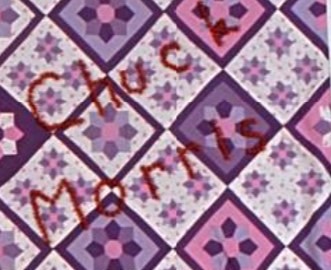
Charles “Chuck” Lee Morris, former owner and publisher of the San Francisco Sentinel, dies of AIDS-related illness in Denver at the age of 42. Morris is also the co-founder of two AIDS hospice programs in California.
Learn More.Believed to be one of the longest-living victims of AIDS, Morris reportedly had been seriously ill since April 1978, but he wasn’t diagnosed with AIDS until 1982
Morris was a confidant of Dianne Feinstein, often advising the then-Mayor of San Francisco on issues affecting the city’s gay community. Elected officials such as Senator Edward M. Kennedy, President Jimmy Carter, and Vice President Walter F. Mondale sought out Morris’ political endorsements.
In the early 1980s, Morris helped found two hospice programs in California for those dying of AIDS.
Morris and his partner moved to Denver in the spring of 1984. Dr. Charles Kirkpatrick, Morris’ physician and an AIDS researcher at National Jewish Hospital, said Morris survived four to five times longer than most AIDS patients. He said at the time that the average survival time of someone with full-blown AIDS was 12-18 months.
* * * * * * * *
Photo of quilt panel from the AIDS Memorial Quilt

Howard Greenfield, the 20-year songwriting partner of Neil Sedaka, dies of AIDS-related illness in Los Angeles at the age of 49.
Learn More.The first Greenfield-Sedaka hit would be ‘‘Stupid Cupid,” recorded by Connie Francis in 1958. Later collaborations with Sedaka included ”Calendar Girl,” ”Oh! Carol” and ”Next Door to an Angel.”
Greenfield would write the lyrics for ”Breaking Up Is Hard to Do,’‘ ”Happy Birthday, Sweet Sixteen,” ”Love Will Keep Us Together” and more than 450 other songs throughout his career.
Born in 1936, Greenfield grew up in the same Brighton Beach apartment building as Sedaka, who was three years older than Greenfield.
“After Howie’s mother Ella had seen me, he came ringing my doorbell,” Sedaka would tell Goldmine magazine years later. “I was playing Chopin, and he said, ‘My mother heard you play and thought we could write a song together.'”
Greenfield was openly gay at a time when it was particularly courageous to do so. His companion from the early 1960s until his death was cabaret singer Tory Damon.
The two lived together in an apartment on East 63rd Street in Manhattan before moving to Los Angeles in 1966. Damon would die of AIDS-related illness just 26 days after Greenfield’s death.
Greenfield’s and Damon’s bodies are interred side-by-side at Forest Lawn Memorial Park in Los Angeles. Damon’s epitaph reads: Love Will Keep Us Together…, and Greenfield’s epitaph continues: … Forever.
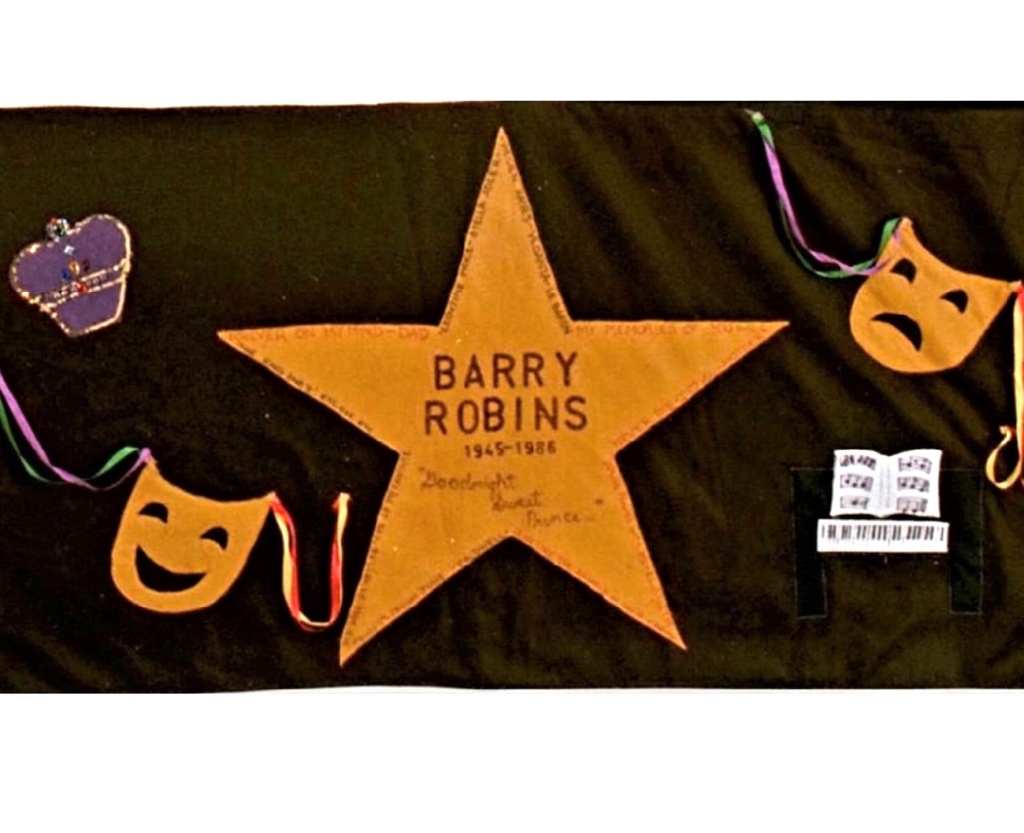
Barry Robins, best known for his portrayal of troubled teenager “Cotton” in the 1971 film Bless the Beasts & Children, dies of AIDS-related illness in Los Angeles at the age of 41.
Learn More.In New York Times article, “The Gay Film That Changed My Life,” actor John Cameron Mitchell credits Robin’s portrayal of “Cotton” as having a profound impact on him as a boy.
In particular, Mitchell is moved by the scene in which Robin’s character saves another character, a “delicate, blond shiksa” named Gerold, from a gang of bullies.
“The mean boys part for Cotton as he reaches a hand out to the boy,” Mitchell recalls. “Branded on my 10-year-old brain was Gerold’s heartbreaking expression when he realizes that for the first time there is someone he can trust and, just maybe, love.”
Mitchell adds, “It was sad to hear that Robins succumbed to AIDS in 1986. If we’d met, I would’ve thanked him for helping me out of the pond.”
In 2013, actor and comedian Jason Stuart would tell A&U: Art & Understanding magazine:
“When Barry got really sick, he stopped seeing people, including me. I was devastated. I remember going by his apartment, knocking on his door, and he would not answer it. He would tell me, ‘Go away. It’s better that way.’ I respected his wishes. To this day I regret that.”
* * * * * * * *
Photo of quilt panel from the AIDS Memorial Quilt
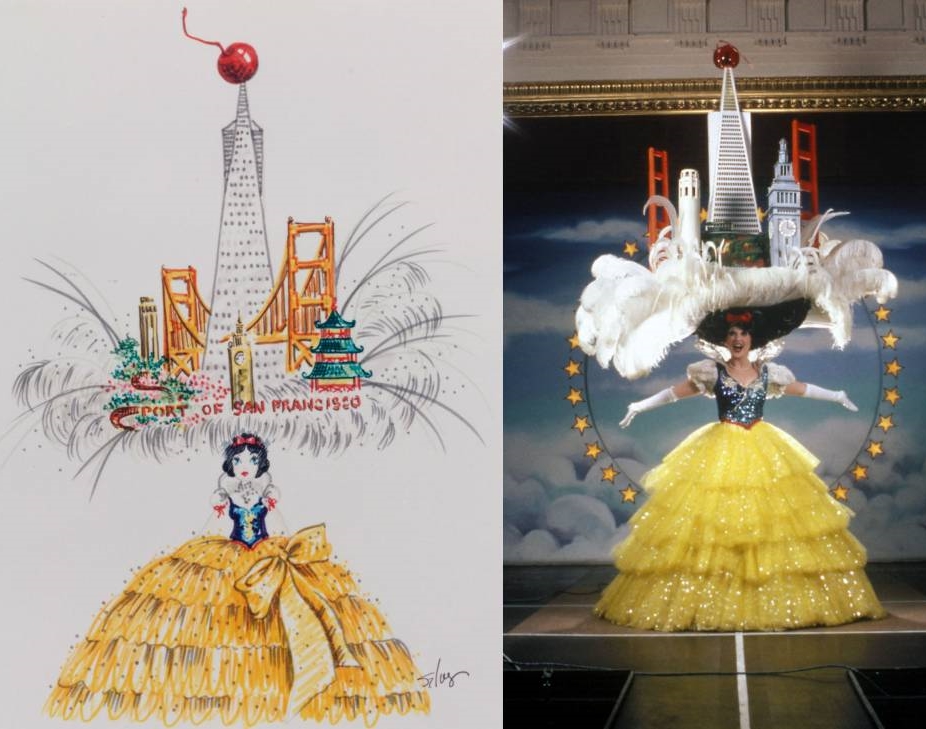
Herman George, the first in-house costume designer for the long-running stage show Beach Blanket Babylon, dies of AIDS-related illness at the age of 46.
Learn More.George also designed costumes for the San Francisco Opera and Charles Pierce. For Pierce’s New York production of “The Crazy Ladies,” George created the costumes for Pierce’s various numbers in which he impersonated prominent female celebrities, according to the New York Public Library.
But it was for Beach Blanket Babylon, a stage show in North Beach known for its camp aesthetic and over-the-top costumes, that George found the opportunity to create outrageous, one-of-a-kind ensembles for the stage, often based on sketches from Babylon producer Steve Silver.
Beach Blanket Babylon closed in 2019 after an epic 45-year run, and many of the costumes remain today in a 6,000-foot San Francisco warehouse. But some of the pieces are being sent to various museums for historical preservation, including The Smithsonian in Washington, D.C. and the M.H. de Young Memorial Museum in Golden Gate Park, according to Jo Schuman Silver, who took over the show when her husband died in 1995 of AIDS-related illness.
During its historic run, the show toured to Las Vegas and London, and opened the Academy Awards. ; Queen Elizabeth II, Prince Charles, David Bowie, Liza Minnelli and Robin Williams were among its fans.

Top fashion designer Perry Ellis dies of AIDS-related illness at New York Hospital-Cornell Medical Center. He was 46.
Learn More.Both women and men adored Ellis’ fashion sense for its clean-cut, all-American look. What the designer did best was take elements of classic American style — like stadium coats, tweed jackets, and homey sweaters — and adapt them to suit the consumer passion for gender-neutral, high-quality separates, according to Love to Know.
Ellis presented his first collection under his own name on Seventh Avenue in 1979 and almost immediately achieved star status.
His design aesthetics earned him accolades — including the Coty Award for his first show in 1979, which he would go on to win eight more times, and the Council of Fashion Designers of America’s Designer of the Year Award in 1982. And in 1984, he became the head of the CFDA, extending his influence on designers worldwide.
In November 1984, a daughter was born to Ellis and Hollywood TV writer and executive Barbara Gallagher. Tyler Ellis was only 18 months old when her father died.
At the time, the cause of Ellis’ death was listed as viral encephalitis, but rumors of Ellis’s HIV-positive status made news after it came to light that his lover and business partner, Laughlin Barker, died earlier in the year of Kaposi’s sarcoma.
In a controversial move, some media organizations mentioned the rumor that Ellis was HIV-positive in his obituary. While the vast majority of newspapers omitted mention of the rumor, the Washington Post, USA Today, Newsday and the San Francisco Examiner decided to publish it. Among the news magazines, Newsweek mentioned the AIDS rumor, and Time did not.
This started a conversation among media professionals worldwide about whether media outlets should mention AIDS as a cause of death if AIDS can be proved or is openly acknowledged — as was ultimately the case with actor Rock Hudson. Or, they posited, should they mention AIDS if it is only widely believed but neither acknowledged nor proved?
Disclosure of HIV-positive status was a very sensitive subject, involving matters of privacy — medical and sexual — since many media consumers automatically assumed someone was gay if he had AIDS.
But many close to Ellis, including top industry professionals, already knew the fashion designer was ill.
“What really, truly, abruptly woke up the entire fashion industry was Perry walking out at the end of his last fashion show,” fashion designer Michael Kors recalled. “He barely could walk, and here was someone young, talented, great-looking, full of charm and life, and suddenly this was a shell of a human being.”
The show took place on May 8, and afterward Ellis checked himself into New York Hospital-Cornell Medical Center, where he died 22 days later.
Ellis’ daughter, Tyler, decided to carry on her father’s fashion legacy. After graduating from Boston University, she moved to New York and interned with Michael Kors. In 2011, she decided to launch her own handbag line, which caters to stars of the entertainment world and fans of luxury accessories.
* * * * * * * *
Photo of quilt panel from the AIDS Memorial Quilt
Charles Ward, one of America’s leading ballet and theatrical dancers, dies at his home in Downey, California of AIDS-related illness. He was 33.
Learn More.Ward became a soloist with American Ballet Theater in 1974 and worked his way to principal dancer in 1976, becoming the partner of many of the leading ballerinas of the time, according to the Los Angeles Times. With ABT, he performed in Swan Lake and ballets by Antony Tudor and Fredrick Ashton.
In 1978, Ward left ABT to star in Bob Fosse’s Broadway musical Dancin’, which earned him a nomination for the Drama Desk Award. He then moved to Los Angeles and danced in the films Staying Alive (1983) and The Turning Point (1977) and in the TV movie Pippin: His Life and Times (1981), again with Fosse. He also performed in shows with Lily Tomlin, Barbara Mandrell and the Mandrell Sisters, Raquel Welch, Rodney Dangerfield and Lynda Carter.
Ward grew up in Downey, California and started dancing at the age of 18. Shortly after high school, he joined Houston Ballet and then, in 1972, moved to New York to dance with the Corps de Ballet at American Ballet Theater.
His last job was as a counselor at AIDS Project Los Angeles, according to his obituary in the LA Times.
“He was always actively involved,” said APLA Founder Nancy Sawaya of Ward. “He was a very gentle, very good, good man.”
Ward is memorialized in the project Dancers We Lost: Honoring Performers Lost to HIV/AIDS.
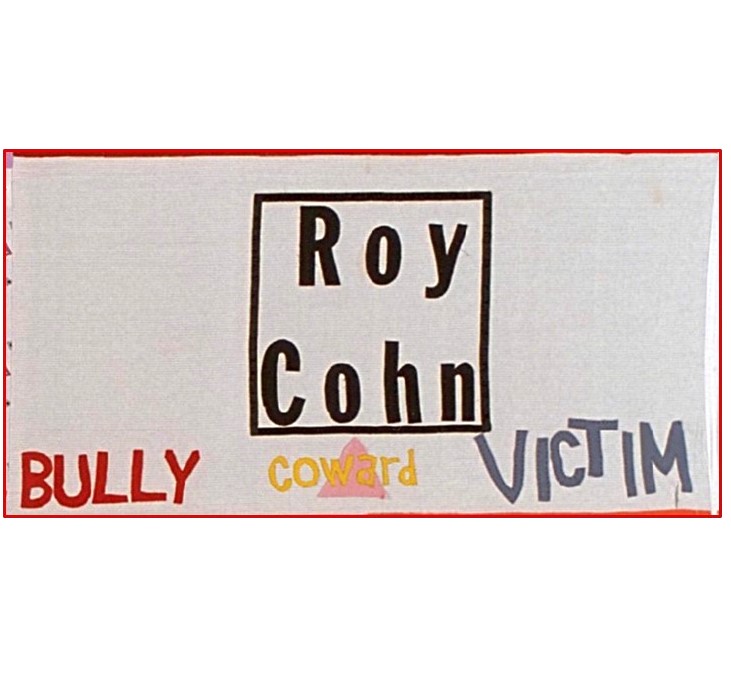
Roy Cohn, best known for his role as chief counsel to Sen. Joseph McCarthy in the 1950s investigation of alleged Communist sympathizers, dies of AIDS-related illness at the age of 59.
Learn More.A graduate of Columbia Law School at the age of 20, Cohn quickly made a name for himself in his first job with the U.S. attorney’s office in Manhattan, prosecuting cases of people with alleged ties to the Communist Party.
Impressed with Cohn’s performance at the trial of Julius and Ethel Rosenberg for spying, FBI director J. Edgar Hoover would recommend that Cohn be hired as chief counsel to the Senate Permanent Subcommittee on Investigations. McCarthy, who chaired the panel, hired the 24-year-old Cohn in January 1953.
“People born in the 1940s or earlier remember Cohn and his master performing on television,” writes Mary Ellen Clark in her 1988 book The Snarling Death of Roy M. Cohn. “They remember coming home to be hushed by a mother or aunt who was watching the hearings; they remember a father’s opinion, expressed at the family table when families still ate together.”
“For younger people, however, Roy Cohn was simply another name for a très smart lawyer, for Disco Dan, for the international, I-go-by-private-plane man,” writes Clark.
Throughout his later life, Cohn was well known for his lavish Washington parties, with wealthy and famous friends among his guests.
“He was a figure very tough and in on things, a champion of the underdog, though definitely running with the overdog pack,” Clark writes. “He nested on the nighttime radio call-in shows; he spread his wings over Koppel on Nightline. He appeared to be able to avoid all taxes and all penalties, maybe because he was connected, or on the A list, or known to the headwaiters and hostesses of New York.”
Cohn would be indicted four times from the mid-’60s to the early ’70s — for stock-swindling, obstructing justice, perjury, bribery, conspiracy, extortion, blackmail, and filing false reports. He is acquitted in three of the cases, and in the fourth, he would escape with a mistrial. This experience would give him “a kind of sneering, sinister sheen of invulnerability,” writes Michael Kruse in Politico.
Cohn would be diagnosed with HIV in 1984 after having a doctor examine a small cut from shaving that wouldn’t stop bleeding. During the visit, the doctor would remove two suspicious growths and the tests would reveal Cohn is HIV positive.
Cohn’s lover Peter Fraser, a New Zealander roughly half Cohn’s age, reported that, “When he found out, he didn’t cry but a couple of tears.”
Cohn would publicly deny that he was HIV positive and would keep his sexuality closeted for the rest of his life. According to Robert E. Bauman, who says he first meets Cohn on the day McCarthy dies in 1957, Cohn paradoxically had a reputation for “fag bashing” and loudly opposed laws that protected gays from discrimination.
In his last months of life, Cohn would be disbarred from law practice in New York for old fraud charges and he would lash out at the bar ethics committee, calling members “a bunch of yoyos.”
Cohn once said he wanted the first line of his obituary to read: “Roy M. Cohn, who served as chief counsel to Sen. Joseph R. McCarthy.”
“Cohn didn’t quite get his wish,” writes Bauman.
When Cohn dies, the headlines would trumpet the fact that he died from complications of AIDS. The mention about McCarthy would come second.
* * * * * * * *
Photo of quilt panel from the AIDS Memorial Quilt

Way Bandy, one of the fashion world’s best-known makeup artists and a best-selling author, dies of AIDS-related illness at New York Hospital-Cornell Medical Center at the age of 45.
Learn More.Considered the “greatest makeup artist in the world” by Vogue fashion editor Polly Allen Mellen, Bandy was in high demand throughout the 1970s and early 1980s. He worked with hundreds of celebrities, including Elizabeth Taylor, Raquel Welch, Catherine Deneuve, Lauren Hutton, Farrah Fawcett, Barbra Streisand, Gloria Vanderbilt, and Cher.
He worked closely with top photographers, such as Scavullo, Richard Avedon, Irving Penn, Helmut Newton, Horst, Hiro and Victor Skrebneski. In 1977, he authored a bestselling makeup manual entitled Designing Your Face, and followed this in 1981 with another manual, Styling Your Face.
Prior to his death, Bandy requested that media outlets report his death as AIDS-related, which was then uncommon.
Born in 1941 in Birmingham, Alabama, Bandy pursued childhood interests that included sewing, music, painting and movie magazines. His family moved to Tennessee, where he graduated from high school. He returned to Birmingham to attend college for two years and then dropped out to model for department stores. He later earned a degree in education at Tennessee Polytechnic Institute, and became an English teacher in Alabama. He married, but separated from his wife shortly after visiting New York City for the first time in 1965.
Bandy moved to New York, changed his name (from Ronald Duane Wright) and enrolled at Christine Valmy’s makeup school. Within a few months, he was heading the salon there.
Bandy was one of the first to use color and texture innovatively. For example, he recommended blending moisturizer with a little water and “red-colored fluid” and “spreading all over the face for a rosy glow.” This was decades before the use of red liquid cheek stains became popular.
A pioneer of contouring, Bandy instructed his subjects to “reveal to our mirror only our best angles and most flattering illusions of reality, as seen through blurred vision and whatever other tricks we have at our disposal.”
Bandy’s techniques sought to create what he referred to as a “Personal Sculpture Portrait” through contouring with “light and dark.”
The opening paragraph of Designing Your Face contains this piece of advice: “I was bored for most of my youth because I tried to do not only what was expected of me, but also many other things I did not enjoy. One day I realized that when you do something with your whole being simply because you love to do it, you experience life as it should be lived. It was then I decided to be free and to do something I loved doing – creating beauty.”
Bandy’s makeup techniques continue to inspire generations of beauty pros and consumers.

Charles “Chaz” Watson, a musician who also acted in Bay Area stage productions, dies at the age of 37.
Learn More.Watson played the french horn and also was a drum major for the San Francisco Gay Freedom Day Marching Band.
“The roster of Bay Area artists who have died from AIDS over the past 25 years carries a poignant double message. It reminds us of all the light these men and women brought — and how much more they had to give when the shadow fell,” wrote San Francisco Chronicle arts and culture critic Steven Winn in 2006. “Death came, in most cases, when these artists were just reaching their prime.”
* * * * * * * *
Photo of quilt panel from the AIDS Memorial Quilt
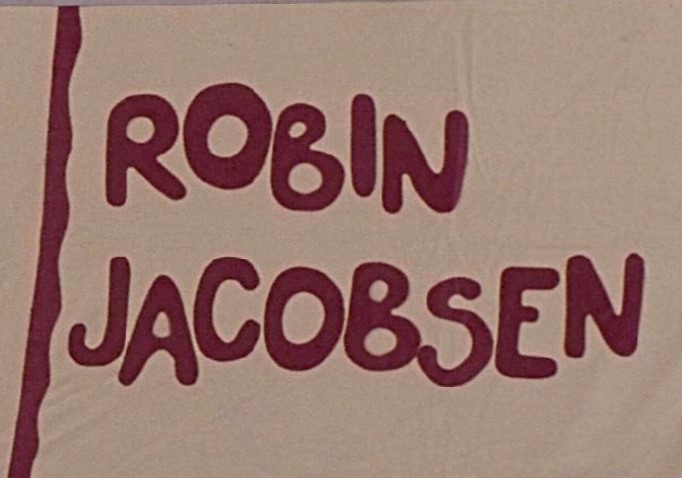
Robin Jacobsen, a designer known for dramatic modern interiors, died of AIDS-related illness at the New York University Medical Center. He was 45 years old.
Learn More.Jacobsen designed corporate showrooms and private homes that combined modern technology with classical elements and a minimalist point of view, according to the New York Times.
When Jacobsen became sick earlier in the year, his partner, R. Scott Bromley, an architect, took over meetings with clients while spending his evenings with Jacobsen at NYU Medical Center.
“After Robin died, one client phoned another client and asked if he could pick up AIDS from me,” Bromley told the NY Times in 1991. He never heard from the client again.
Jacobsen was also a volunteer firefighter with the Pines Fire Department on Fire Island, and served on the Board of Directors for the Pines Care Center, founded in 1983 to provide medical care to the Fire Island community.
* * * * * * * *
Photo of quilt panel from the AIDS Memorial Quilt
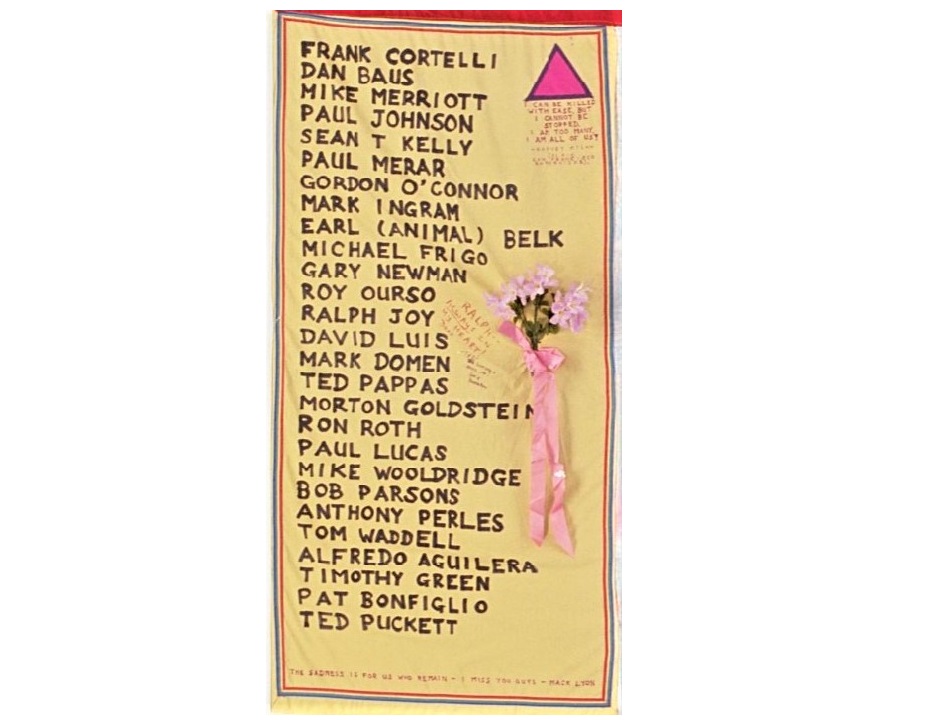
Transportation historian and author Anthony Perles dies of AIDS-related illness at the age of 50.
Learn More.In 1981, Perles’ book The People’s Railway was published, providing a detailed history of the San Francisco Municipal Railway from its earliest days through to the era of light rail. Perles described every aspect of the railway system, including the struggle against United Railroads and the development of light rail vehicles (LRVs) in the 1970s.
Perles’ final work, Tours of Discovery, was published in 1984 and provided a pictorial journey through the decades of development and change on the Municipal Railway of San Francisco.
* * * * * * * *
Photo of quilt panel from the AIDS Memorial Quilt
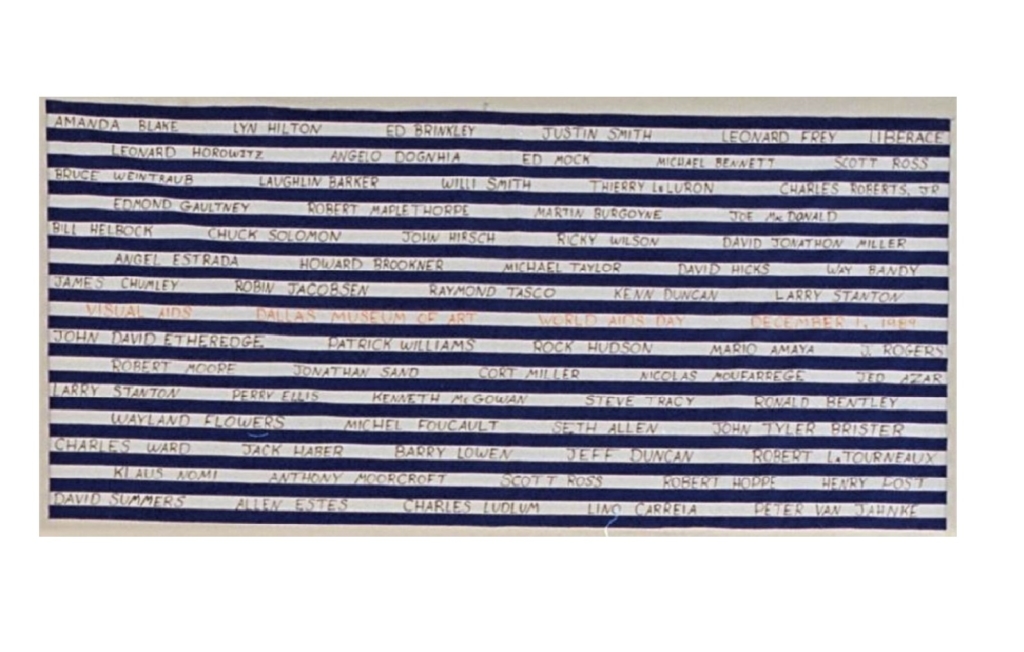
Raymond Tasco, an actor and director with Oakland Ensemble Theatre and Black Repertory Group, dies of AID-related illness at the age of 40.
Learn More.Tasco directed several works at Theatre Rhinoceros and Lorraine Hansberry Theatre. He also co-founded the Bay Area Black Artists’ Connection support group.
* * * * * * * *
Photo of quilt panel from the AIDS Memorial Quilt
Fred Alizie, a singer with the San Francisco Lesbian/Gay Community Chorus and the choral ensemble Vocal Minority, dies of AIDS-related illness at the age of 36.
Learn More.“Fred came from a musical family,” Alizio’s partner Jack Grasso told The San Francisco Examiner. “He loved playing piano and singing with people.”
After Alizio became too sick to perform, he continued to attend performances by the Community Chorus and Vocal Minority, and shortly before he died, he donated funds for Vocal Minority to buy new uniform jackets.

Esquerita — an innovative, self-taught pianist and performer whose influence on rock ‘n’ roll started with the birth of the genre in the early 1950s — dies of AIDS-related illness at a hospital in Harlem, New York. He was 50 years old.
Learn More.“Without Esquerita, there might have been no Little Richard, hence no Prince and no Elton John — and no rock ‘n’ roll as we know it,” music reporter Alan Richard wrote in Country Queer. “Little Richard himself credited Esquerita with showing him how to pound the piano with intensity and soul.”
Born in 1935 in Greenville, South Carolina, he was known locally as Eskew Reeder (or “SQ,” for Stephen Quincy) and was just a teenager when he joined the New York-based gospel group Heavenly Echoes.
Early on, he adopted an unconventional style, sporting a six-inch pompadour and makeup — which was quite shocking during the predominantly conservative culture of the 1950s, music reporter Iaian Ellis wrote in Rebels Wit Attitude: Subversive Rock Humorists.
When the Heavenly Echoes disbanded in the early ’50s, he returned to Greenville and created an act under the name “Professor Eskew Reeder.” The Owl Club on Washington Street booked him as the house performer, according to Ellis.
Esquerita also began performing on the “Chitlin’ Circuit” in the Deep South, where audiences embraced his unconventional appearance and performance style. Encouraged by the responses he received from Black audiences across the South, Esquerita became even more manic as he performed and often added a wig or two atop his already towering pompadour. His stage costumes typically incorporated sequins, rhinestones, and capes.
It was around this time when Little Richard (also known as Richard Penniman) saw him perform and expressed admiration for Esquerita’s technique on the piano, Ellis writes. Esquerita responded by teaching Little Richard some of his technique.
While Esquerita was performing live to Black audiences and honing his act to exquisite imperfection, Little Richard was already recording songs as a solo vocalist and piano player. But after seeing Esquerita perform, he decided to move away from the soothing jump-blues style of Roy Brown and tap instead into the fast rock ‘n’ roll rhythm that he experienced in Esquerita’s performances.
After “Tutti Frutti” became a big rock ‘n’ roll hit in 1955, Little Richard released a series of records in the same style and quickly became a nationwide sensation. The popularity of his music crossed the racial divide, and he was soon performing on television shows and in some of the earliest rock movies, such as Don’t Knock the Rock and The Girl Can’t Help It.
“I think Little Richard copied off [Esquerita] a lot, but Little Richard got to the studio first,” Lightin’ Lee, a New Orleans guitar player who knew both men, told Baynard Woods for his article “Esquerita and the Voola.”
But in 1957, Little Richard surprised everyone by announcing he was retiring from rock ‘n’ roll to get closer to God, and he enrolled in a theological college in Alabama. According to Baynard, Little Richard made this decision public at the last concert of his tour, saying, “If you want to live with the Lord, you can’t rock ‘n’ roll, too. God doesn’t like it.”
This opened the door for Esquerita to record his own songs.
While performing at the Owl Club in 1958, Esquerita caught the attention of rockabilly pioneer Paul Peek, who had just performed with Gene Vincent and the Bluecaps in the musical-comedy film The Girl Can’t Help It. Peek helped Esquerita get studio time at a Greenville radio station, and sent the resulting demos to bandleader Vincent. Seen as “the next Little Richard,” Esquerita was signed to a record deal with Capitol Records, thanks to help from Vincent.
The same year, Capitol started releasing a series of singles featuring Esquerita, first with the rockin’ “Oh Baby” and, on the B side, the slower-moving, bluesy “Please Come Home.” This was followed quickly by the release of the single “Rockin’ The Joint“/”Esquerita And The Voola.”
“With its thundering piano and obligato holler, ‘Esquerita and the Voola’ could be read as a response to Little Richard’s conversion,” writes Woods in his tribute to Esquerita. “Just as Richard gave himself to the Lord, Esquerita had dedicated his life to the Voola.”
Woods calls “Esquerita and the Voola” the artist’s “most dissonant song,” and it is fair to say that even the cutting-edge rock ‘n’ rollers of 1958 weren’t prepared for something like this.
“[The song] begins with a rolling rhumba drumbeat and then takes off into a piano rumble that swerves between the almost-off-the-rails high-note plinking of Thelonious Monk and the raucous bass thudding of Fats Domino,” Woods writes. “The piano is enough to make ‘Esquerita and the Voola’ one of the most experimental of the early rock singles, but then the wordless vocals come in and things really get weird, as Esquerita executes the kind of operatic howls that others call rock shouting and he called obligato.”
Fans of rock ‘n’ roll would find similarities between Esquerita and Little Richard — like the driving energy, the high-pitched “who-o-o-o-o-o’s!”, and the rollicking style of the piano playing — but there were obvious differences as well. Esquerita’s singing voice was deeper and rougher than Little Richard’s, and his handing of the piano was wilder.
“One could perhaps say that Little Richard’s voice had more of a gospel sheen to it, whereas Esquerita’s is far more dirty blues,” states George Starostin on his music review website . “As for the piano-playing, here, too, Esquerita shows far less discipline and far more aggression, not really minding getting off tempo every now and then, as long as the spirit stays strong inside him.”
Capitol would release Esquerita’s eponymous album in 1959, but it would not include “Esquerita and the Voola” on the LP. Unfortunately, the record did not do well, and Capitol dropped Esquerita from its roster.
From that point on, Esquerita drifted around the fringes of the musical world, performing under various names, such as the Magnificent Malochi, Estrelita, Eskew Reeder, and The Voola, writes Woods in his tribute to Esquerita.
In Dallas, he assembled a band and recorded a series of demos. Then he moved to New Orleans and became a house musician at the Dew Drop Inn, performing with many of the city’s best musicians.
In the 1960s, legendary record producer Berry Gordy brought Esquerita to Detroit as part of an ensemble exploring new Motown sounds.
“That’s when the Gordy sound changed,” Esquerita said later. “We just started jammin’, payin’ no mind, carryin’ on, and Berry taped us right there in Hitsville, USA.”
Even though Motown updated its sound to a harder-charging R&B beat after hearing the crew from New Orleans, it didn’t result in a recording deal for Esquerita. By the late ’60s, he had moved to New York, where he worked with the great drummer Idris Muhammad for a while.
In 1970, Little Richard launched a comeback and invited Esquerita to the studio to play piano on “Dew Drop Inn,” a song Esquerita wrote about the New Orleans club. For the LP (The Rill Thing), Little Richard recorded a second Esquerita number called “Freedom Blues.”
But after that, work dried up for Esquerita, and he reportedly turned to criminal activity to make ends meet, resulting in prison time in Puerto Rico and New York City.
In 1981, he was booked to perform on Monday nights at a tiny club on West 17th Street called Tramps. Music writer James Marshall said he saw the small Village Voice ad for “Every Monday: Esquerita!” and couldn’t believe the rock ‘n’ roll legend was still performing.
“We headed for Tramps, and there he was: the legend, the man — Esquerita himself!” Marshall wrote on his website, The Hound Blog. “His hair was short, and he looked like he’d ridden some hard miles, but it was he, the guy who made those insane records way back when.”
Marshall and his friends Billy Miller and Miriam Linna, publishers of Kicks magazine, began to attend Esquerita’s shows regularly. They put Esquerita on the cover of an issue of Kicks, and soon others were coming to Tramps on Monday nights.
Being friends with Esquerita was a mixed bag, Marshall recalled. Sometimes, he would show up at a party and treat everyone to a private recital, “rocking through versions of ‘Slow Down’ and ‘Dizzy Miss Lizzie.'” But at other times, write Marshall, Esquerita would appear in the middle of the night, pounding on windows and asking for money.
In the early 1980s, crack was cheap and plentiful in New York City, and Marshall watched his friend succumb to the effects of this dangerous drug. According to Pierre Monnery, who wrote “The Magnificent Malochi: The Esquerita Story,” Esquerita was diagnosed as HIV positive in 1985.
“He died of complications arising from AIDS in a Harlem Hospital on 23rd October, 1986, aged just fifty,” Monnery wrote. “Shamefully, he was buried in an unmarked grave in New York’s ‘Potters Field’ on Hart Island in northeast Bronx, where he rests today with other New Yorkers who could not afford a proper burial.”
In 1986, Little Richard was inducted into the Rock and Roll Hall of Fame. Esquerita was buried in an unmarked grave the same year.
CDC reports that AIDS cases are disproportionately affecting black and latinx communities. This is particularly true for children in these communities, who make up 90% of perinatally-acquired AIDS cases.
Marcelino Sánchez, best known for his starring role as Rembrandt in the 1979 cult classic The Warriors, dies of AIDS-related illness in his Hollywood home at the age of 28.
Learn More.Born in Puerto Rico, Sánchez began acting in the late 1970s, according to the Los Angeles Blade. He played Ricardo on The Bloodhound Gang mystery vignettes featured on the 1980s children’s educational television show 3-2-1 Contact. He also appeared in TV shows CHiPs, Hill Street Blues and the film 48 Hrs.
In an interview with Noblemania.com, Bloodhound Gang co-star Nan-Lynn Nelson recalled:
“Marcelino had actually contacted me months prior to his passing to let me know that he was sick. We met and spent an entire day together while he was here in NYC, basically to say good-bye. I still think of Marcelino often.”
In 1986, Sánchez’s health would decline quickly. His sister and brother would come to Los Angeles to take care of him until his death just two weeks shy of his 28th birthday, according to the tribute to him on Gran Varones, a website dedicated to pop culture, queer history & storytelling through a Afro-Latinx Queer lens.
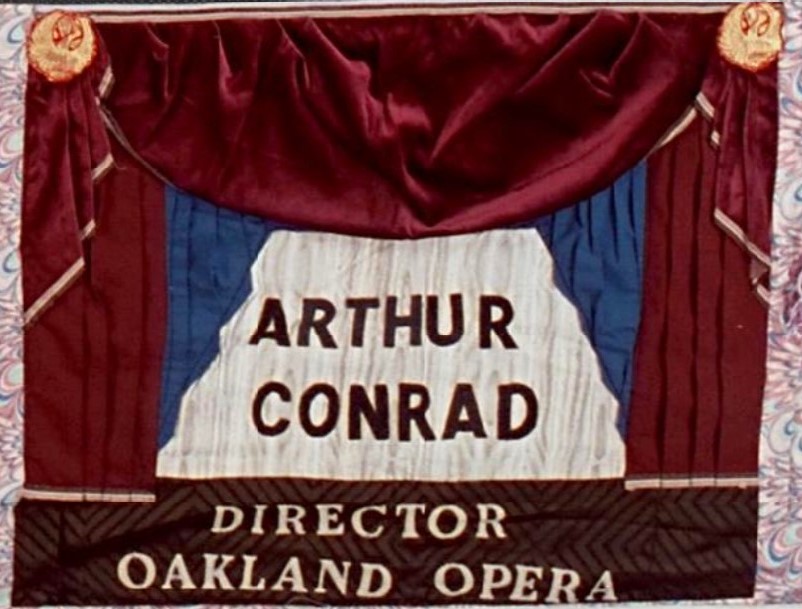
Arthur Conrad — director of more than 200 productions for the Marin Opera, West Bay Opera, Oakland Opera, Sacramento Opera and the Lamplighters — dies of AIDS-related illness in San Francisco at the age of 51.
Learn More.Conrad began his career as a dancer, performing in the role of “Mother Marshmallow” in the Oakland Ballet’s Nutcracker for several years. He began to choreograph Bay Area productions, and ultimately began directing.
HIV/AIDS services advocate Bev Sykes wrote in her blog Funny The World about how in the summer of 1986 she was Conrad’s assistant as he directed a production of The Mikado for the Oakland ballet.
“He had a ‘cold’ during the rehearsal period and complained that he couldn’t shake it,” she recalled.
The show ran throughout the month of August and, at its conclusion, Conrad promised Sykes that he would take her to lunch to thank her for all her help. She never heard from him again.
In November, she found out that Conrad was hospitalized with pneumocystis pneumonia. He died shortly afterward.
“Until that time, AIDS had been something that happened to someone else,” she wrote.
* * * * * * * *
Photo of quilt panel from the AIDS Memorial Quilt
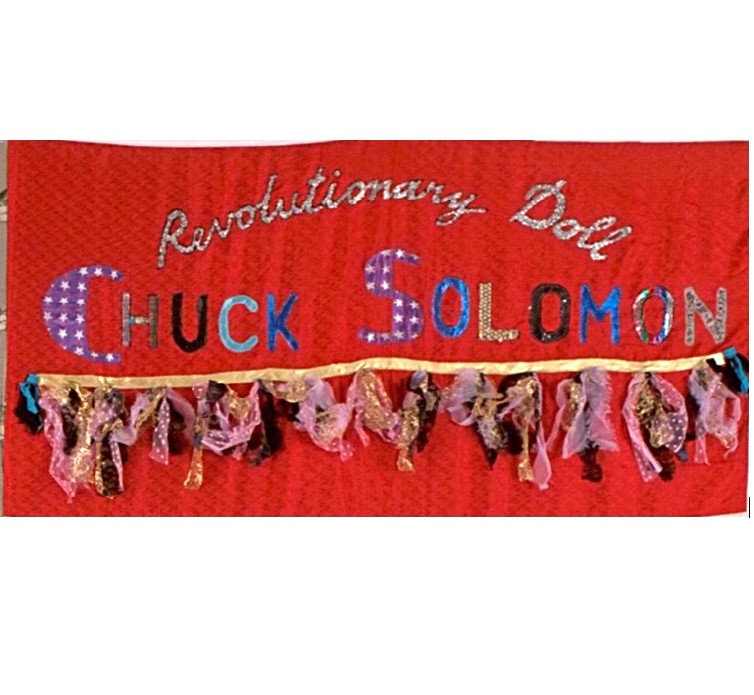
Founder of the Gay Men’s Theater Collective and co-creator of its pioneering production Crimes Against Nature, Chuck Solomon dies of AID-related illness at the age of 40.
Learn More.As an actor and director, Solomon worked with several local companies, including the San Francisco Mime Troupe and Theatre Rhinoceros.
He is immortalized in Marc Huestis’ 1987 documentary “Chuck Solomon: Coming of Age,” which received the Silver Hugo Award at the Chicago International Film Festival. In the film, Solomon is celebrated by members of his family and about 350 friends on his 40th birthday.
* * * * * * * *
Photo of quilt panel from the AIDS Memorial Quilt

Emmy-Award winning pianist and mainstay of the Las Vegas entertainment scene Liberace dies at his Palm Springs, California home at the age of 67.
Learn More.Liberace’s doctor claims that the man called “Mr. Showmanship” died of a heart attack caused by an underlying brain infection. But an autopsy by the county coroner reveals that Liberace died of AIDS-related illness.
Just weeks before his death, Liberace was treated at Eisenhower Medical Center for what his staff called “the effects of a watermelon diet.” Hundreds of friends and tourists kept vigil outside of his Palm Springs home as rumors of his real illness became rampant.
When death seemed imminent, his attorney would tell reporters that Liberace chose his Palm Springs home to die because, “I think he wanted to rest in the place he loves. He’s always thinking about his fans. He wants to be remembered as he was — an entertainer. I think it’s nice that fans are here and supporting him.”
The news of Liberace’s death demonstrated the powerful stigma of AIDS and led to a national discussion about the rights of people living with AIDS to privacy, both before and after death.
* * * * * * * *
Photo of quilt panel from the AIDS Memorial Quilt

Neal Lo Monaco, the principal cellist of the Sacramento Symphony, dies of AIDS-related illness at the age of 41.
Learn More.Lo Monaco was also a member of the Sacramento String Quartet.
* * * * * * * *
Photo of quilt panel from the AIDS Memorial Quilt
Jay Phillips, a promising artist whose abstract sculptures won him a select but distinctive following in Los Angeles and New York, died of AIDS-related illness in New York City. He was 32.
Learn More.Seduced by southern California’s saturated colors and New York City’s vibrant architecture, Phillips incorporated the world around him in his work. Melding painting and sculpture, his works typically featured brightly colored enamel on metal that was cut, folded and otherwise manipulated. His use of color-drenched patterns referenced his early exposure to commercial fabric patterning.
Suzanne Muchnic, art critic for the Los Angeles Times, credited Phillips with a “swift, sure sense of arrangement that allows him to join bold checkerboards, bright stripes, lattices and circle patterns with painterly gestures evocative of landscape.”
A recipient of the Los Angeles County Museum’s 1981 Young Talent Award, Phillips exhibited his work at LACMA in November 1985 – February 1986.
“There is in his work a greater insistence on structure and manipulation of the composition,” wrote Stephanie Barron, LACMA’s curator of 20th Century art. “Yet, ever the romantic, Phillips continues to search for ways to interpret his surroundings.”
Phillips often worked with aluminum, cutting wavy edges along the side of his pieces and folding them back. This technique “had the effect of playing off a sense of depth against perceptual pulls of shape and color,” according to Burt A. Folkart of the LA Times.
He also briefly worked with paper, creating a series of silk-screened prints named for the Los Angeles locations of Hancock Park, Melrose, Hollywood and Bel-Air Gate.
“Although the material involved was atypical of Phillips’ work, the colors and wide stripes and thick brush strokes were not,” Folkart wrote.
Phillips earned his bachelor of fine arts degree from the University of New Mexico and his master’s degree from Claremont Graduate School in 1979. In Los Angeles, his work was also shown at the Newspace and Roy Boyd galleries.

Antonio Lopez, whose drawings appeared in Vogue, Harper’s Bazaar, Elle, and Interview, dies of AIDS-related illness at the UCLA Medical Center at the age of 44.
Learn More.Based in New York, Lopez had come to Los Angeles for a showing of his drawings at the Robert Berman Gallery in Santa Monica when he became ill and was hospitalized, according to fashion model Susan Baraz.
Lopez is credited with launching the careers of Jessica Lange, Jerry Hall, Tina Chow and Grace Jones, and he also was the first artist to use black models in his work, which was seen in the top fashion magazines in the mid-1960s.
He also was credited with being the first artist to draw not only the inanimate creations of the haute couture but to idealize the models behind them.
His family migrated to New York City when Lopez was seven and he attended P.S. 77 on East 104th Street. To keep her son preoccupied and away from street violence, Lopez’s mother, a seamstress, would ask him to draw flowers for her embroideries, according to the tribute to Lopez on the Visual AIDS website.
While a student at the Fashion Institute of Technology, he received a work-study assignment at Women’s Wear Daily, where his talent was immediately recognized. WWD put him on staff and he left FIT.
At the time of his death, Lopez had been in California for an exhibition of his fashion drawings and personality portraits at the Robert Berman Gallery in Santa Monica. An exhibition of his drawings was also taking place in Munich, West Germany.
Lopez’ creative partner, Juan Eugene Ramos, would die of AIDS-related illness eight years later, on Nov. 3, 1995, at the age of 53.
In 2016, a retrospective of Lopez’ and Ramos’ work was exhibited at El Museo del Barrio in New York. The exhibit, “Antonio Lopez: Future Funk Fashion,” was curated to evoke serious discourse on gender, sexuality, race, and heritage, and simultaneously invited viewers to revel in Lopez’ and Ramos’ legacy.
* * * * * * * *
Photo of quilt panel from the AIDS Memorial Quilt

Fashion star Willi Smith dies in New York at the age of 39.
Smith was apparently unaware that he had contracted the virus and had shown no symptoms.
Learn More.Thinking he was suffering from an attack of shigella, a form of dysentery, acquired on a textile-buying trip to India, Smith admitted himself to the hospital, where tests showed he was HIV positive.
At the time of his death, Smith was regarded as one of the most successful African-American designers in the fashion industry. His company, WilliWear Limited, launched in 1976 and by 1986 was grossing over $25 million in sales.
“Smith was, in the truest sense of the word, a streetwear designer, long before anyone used the term,” writes Jenny Comita in W magazine. “Even as he was collaborating with some of the most avant-garde artists of the day and staging fashion shows that doubled as performances, he was taking his cues as a designer from the women he saw on the sidewalks of midtown.”
Smith was born in Philadelphia, the son of an ironworker and a homemaker. He studied drawing at Mastbaum technical school and, later, fashion illustration at the Philadelphia Museum College of Art.
His big break came through his grandmother Gladys, who worked as a housekeeper. One of her clients had a connection to the famed couturier Arnold Scaasi and secured an internship for Willi.
Smith’s first major role, in 1969, was as head designer of the sportswear label Digits, where he quickly made a name for himself with bright, bold prints; flowy high-waisted pants; and an ahead-of-its-time marketing campaign featuring women on the gritty streets of New York. Two years later, he became the youngest designer to be nominated for a Coty Award, then the fashion equivalent of an Oscar.
In 1976, he and his former assistant Laurie Mallet founded WilliWear; she handled the business side and he the design. WilliWear’s affordable, wearable clothes were picked up by Macy’s, Bloomingdale’s and eventually hundreds of stores.
Smith designed the costumes for “Secret Pastures,” a 1984 work by dance pioneers Bill T. Jones/Arnie Zane; Keith Haring created the sets. Smith also contributed to Spike Lee’s 1988 musical comedy-drama School Daze, making the gowns for the homecoming court.
Many of his friends wonder what would have happened if Smith had lived.
“We’ve been told that he wanted to move to India permanently, a place he visited constantly. He might have gone to Hollywood to produce films full-time after making a short film called Expedition.”
Smith’s legacy is the streetwear that lives on in menswear season after season.
* * * * * * * *
Photo of quilt panel from the AIDS Memorial Quilt
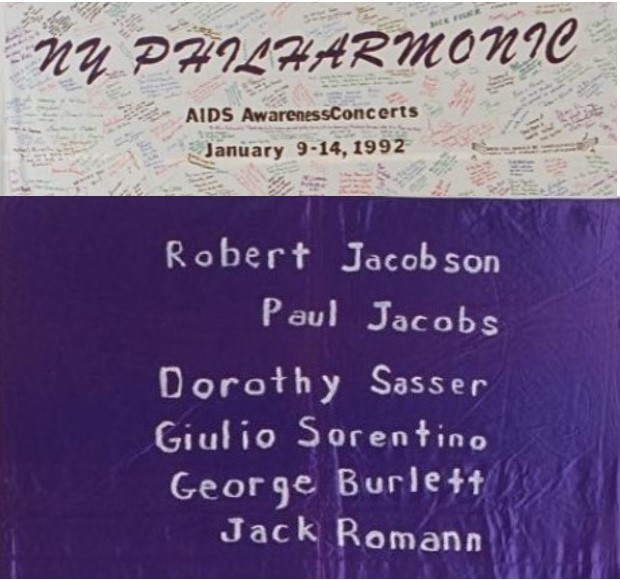
Jack Romann, director of the concert and artist department of the Baldwin Piano Company, dies of AIDS-related illness at Cabrini Medical Center in New York City. He was 59
Learn More.Romann’s stature among the top pianists in the U.S. warranted him coverage in The New York Times when he died, and years later would inspire composer John Corigliano to write symphonic pieces.
”Almost every talented pianist in America now has had an important slice of his life removed,” Charles Wadsworth, a pianist and the artistic director of the Chamber Music Society of Lincoln Center, told the NY Times. “When I played at the White House for President Kennedy, Jack came along to give me support and he turned pages for me. Then, on his own, he wrote a press release and sent it to the paper of my Georgia hometown. All of a sudden, I was somebody important there.’
Although Romann was a Juilliard-trained pianist, he never gave public performances and instead supported pianists who were performing for wide audiences.
”I cannot begin to tell you how important he was to me and almost any pianist I know,” pianist Santiago Rodriguez told the NY Times. ”He gave me tons of advice … I never met a man so ready to give.”
Another person who Romann left with a lasting impact was composer John Corigliano, who on March 15, 1990 would premiere his masterwork Symphony No. 1, the first major musical memorial to those who had died of AIDS.
Alex Ross, music critic of The New Yorker, wrote that Symphony No. 1 “was and it remains the most formidable classical work written in response to the epidemic.”
For the symphony’s second movement, which Ross called “the dark heart of the symphony,” Corigliano drew on his memory of Romann and his AIDS dementia.
According to music critic Steve Smith, Corigliano “recasts” the original intention of the tarantella (a cure for spider-bite delirium) as “an analogue for AIDS dementia,” having a contrabassoon take a gloomy melody and then repeating it with the contrabass clarinet, tuba and ultimately trombone.
* * * * * * * *
Photo of quilt panel from the AIDS Memorial Quilt
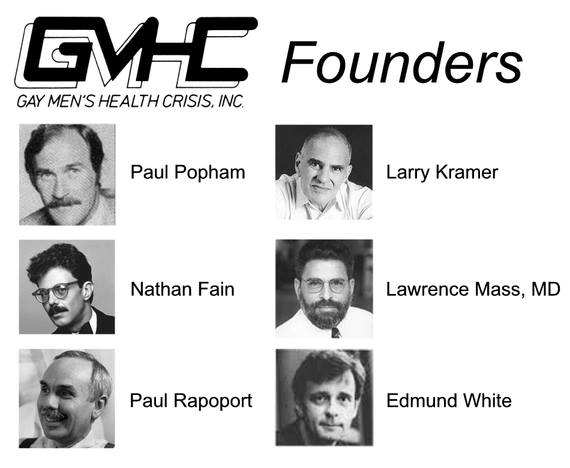
Paul Popham, founder and first president of the Gay Men’s Health Crisis in New York City, dies at the Memorial Sloan-Kettering Cancer Center of AIDS-related illness at the age of 45.
Learn More.Popham was a Bronze Star Medal-winning Vietnam veteran who had a successful career as a Wall Street banker. He was politically inactive until 1981, when he first read about the disease that later became known as AIDS.
In January 1982, Popham, along with Larry Kramer, Lawrence Mass, Nathan Fain, Paul Rapoport, and Edmund White, founded Gay Men’s Health Crisis (GMHC), and Popham became the organization’s first president.
At the time of its founding, GMHC was the largest volunteer AIDS organization in the world.
Popham’s leadership style was infused with charm and diplomacy, which some found to be an ideal approach in the new fight against AIDS. However, others thought Popham should have lead the organization with more urgency and ferocity. The latter camp included Larry Kramer, who thought Popham’s approach was overly accommodating and ineffective.
Tensions between Kramer and Popham led to Kramer leaving GMHC in 1983 and, later, their contentious relationship would be portrayed in Kramer’s play The Normal Heart, one of the first plays to address the AIDS crisis. Popham was the basis for the character of Bruce Niles.
In the program notes for one of GMHC’s earliest benefits, Paul Popham wrote, “I think the most impressive thing I’ve seen over the last year and a half is how affectionate men have grown. We are finding out who we are, what we can do under pressure. Although we’re paying a terrible price, we’re finding in ourselves much greater strength than we dreamed we had.”
Popham also helped found the AIDS Action Council, a lobbying organization in Washington, and was chairman of the group.
Popham was diagnosed with AIDS in February 1985. He remained active with GMHC until his illness became too severe.
In July 1986, Popham testified before Congress about allowing AIDS patients to receive drugs that were still undergoing clinical trials. This was less than a year before his death and he was clearly ill. However, he still spoke in his usual calm and resolute manner.
“As a person with AIDS, I am luckier than many in that I know resources that I can use,” he told members of Congress. “But there are many people who have AIDS that don’t have the advantage of coming with the knowledge that I have of where to go to get the resources they need. There is no place to go that is providing up-to-date information about the drug trials going on and how to get into these trials.”

Robert M. Jacobson, editor of Opera News magazine, dies of AIDS-related illness at St. Vincent’s Hospital in New York. He was 46.
Learn More.Jacobson, who began as a critic for Musical America in 1963, was a prominent advocate of opera and the arts. His partner, Rocci Genova, told The New York Times that Jacobson also wrote for numerous publications, edited the program booklets for Lincoln Center in New York City, and annotated programs for CBS Records.
In 1974 he became editor of Opera News, and also edited its sister publication, Ballet News, from 1979 until it was discontinued in 1986.
In “AIDS and the Arts: Behind the Scenes of a Tragedy,” a December 1990 article by Sean Mitchell for the Los Angeles Times, Jacobson’s name would appear alongside seventeen other prominent people in the arts who died of AIDS.
“A disproportionate number of AIDS victims, it turned out, were poor and anonymous, but there were also a lot who acted, painted, sang, danced and in one way or another contributed to the public creative life of the nation,” wrote Mitchell.
* * * * * * * *
Photo of quilt panel from the AIDS Memorial Quilt
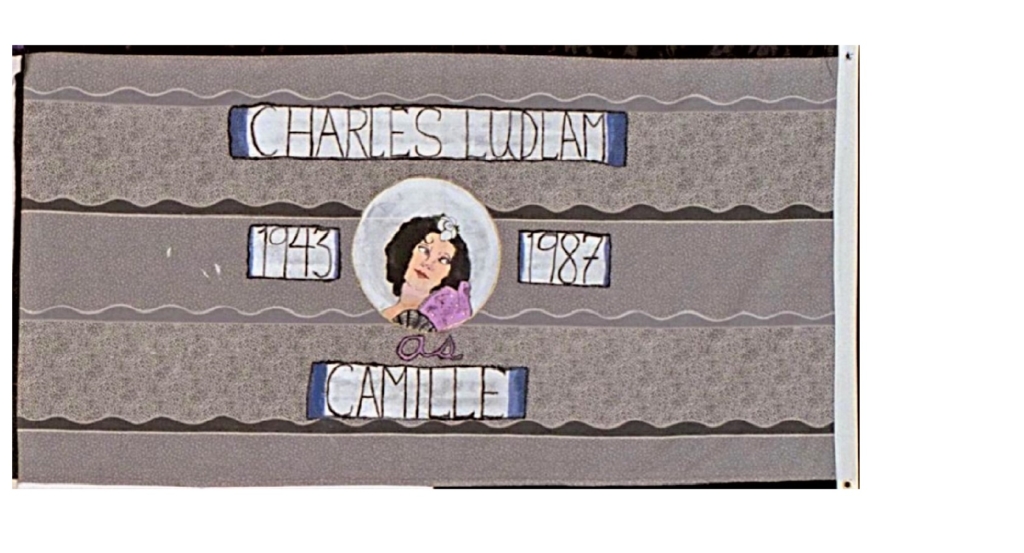
Charles Ludlam, whose Ridiculous Theatrical Company had become one of New York City’s more popular attractions, dies in St. Vincent’s Hospital of AIDS-related illness at the age of 44.
Learn More.An actor, writer and director, Ludlam was one of the more prolific artists on the off-Broadway scene. His productions in a small basement theater Greenwich Village included such parodies as Bluebeard, Galas (a spoof on operatic diva Maria Callas) and Reverse Psychology.
Jeremy Gerard of The New York Times memorialized Ludlam, calling him was one of the most prolific and flamboyant artists in the theater avant-garde.
“He was a master of travesty, creating in a tiny grotto theater on Sheridan Square critically and popularly acclaimed parodies of such familiar genres as the dime novel (The Mystery of Irma Vep), film noir (The Artificial Jungle) and opera (Camille, Der Ring Gott Farblonjet),” Gerard wrote.
Ludlam’s productions received a Drama Desk award and six Obie awards. The Ridiculous Theatrical Company has toured extensively in the United States and Europe.
Recently, he was retained by producer Joseph Papp to direct the production of Shakespeare’s Titus Andronicus for the New York Shakespeare Festival in Central Park. However, the play was postponed when Ludlam was admitted to the hospital on April 30.
”We lost an extraordinary artist who was just on his way to a tremendous breakthrough in theater and opera,” Mr. Papp said of Ludlam’s untimely death.
At a July 13 memorial event for Ludlam, about 1,000 people crowded the Second Avenue Theater to pay tribute to the king — and sometimes queen — of downtown theater and celebrate his work.
The most moving remembrance was offered by Everett Quinton, Ludlam’s longtime partner and his successor as artistic director of the company.
”I’ve never felt so alone in my life, but it’s going to be all right,” Quinton said. ”We’re going to continue to do wild theater and wonderful theater.”
* * * * * * * *
Photo of quilt panel from the AIDS Memorial Quilt
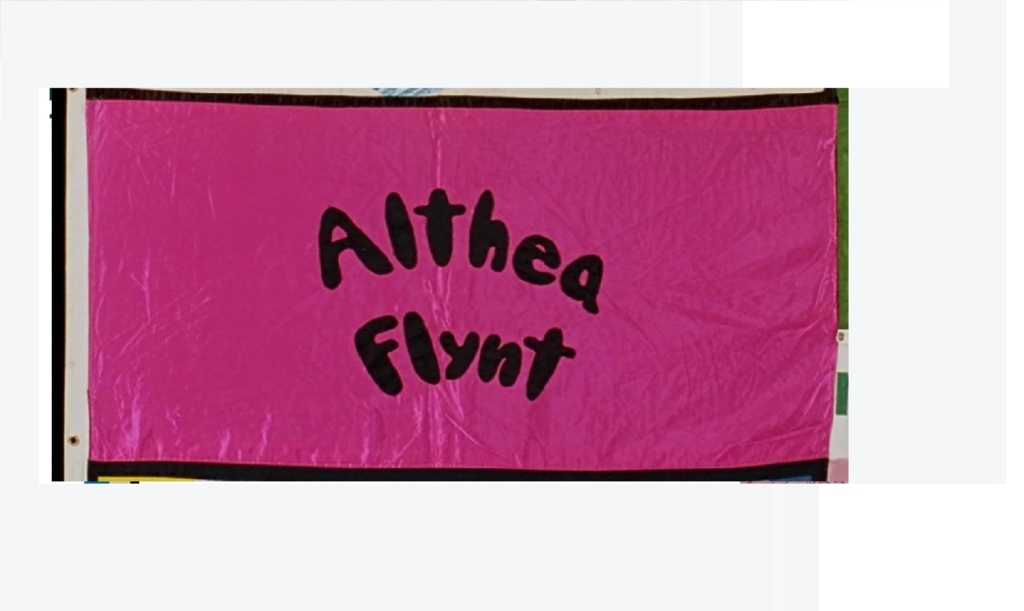
Wife of Larry Flynt and publisher of Hustler magazine, Althea Flynt drowns in a bathtub in her Bel-Air mansion in Los Angeles at the age of 33. Her husband says she was diagnosed with AIDS four years ago and likely fell asleep while bathing.
Learn More.Althea is Larry Flynt’s fourth wife, and because she married him in 1976, she is the only partner who joins him in his rise to celebrity. She would meet Flynt in Ohio, while working in one of his clubs as a go-go dancer.
Born in poverty in a Kentucky mining town, Althea Flynt was orphaned at eight years old, when her father murdered her mother and her grandfather and her mother’s best friend, and then killed himself. Flynt recounted her childhood ordeal in a 1978 interview with New York magazine:
“They put you in a bare room with dirty floors and a single mattress that was stained and filthy and stank,” she said. “I still remember the smell. They put a pot and a roll of toilet paper in the room. Then they locked you in.”
In the late 1960s, she and Larry Flynt started a relationship that would last until the rest of her life. As partner in her husband’s publishing business, she would be known to come to work in outrageous attire, including in leather dog collars and bangled chains that ran from her ear to her nostril.
As documented on video from Flynt’s library, Althea’s style was complex and highly unusual, particularly once she came into money and moved to Los Angeles. Her attraction to drug culture, Sunset Strip clubs and punk rock led her to patronize Hollywood shops like North Beach Leather and Trashy Lingerie.
In March 1978, her husband would be shot by a religious extremist, leaving him paralyzed and in pain, and she would remain with him, for better and for worse.
In a 1983 magazine article by the Washington writer Rudy Maxa, the Flynts would descibe how Larry tried to manage the pain with methadone, marijuana, cocaine, sleeping pills, morphine, and Dilaudid. Althea would experiment with drugs with her husband, and soon both would become addicted to narcotics.
She would be diagnosed with HIV in 1983, reportedly from a blood transfusion while undergoing a hysterectomy. Larry Flynt explained that Althea “always used clean needles when using drugs.”
The cause of Althea’s death is a perscription drug overdose-induced drowning, according to the coronor’s report. Her husband, however, states that she was in the advanced stages of AIDS and would have died within that year, regardless.
Flynt’s body is buried in Saylersville, Ky., where her husband keeps a family burial plot.
In 1997, Althea would be portrayed by singer-actress Courtney Love in The People vs. Larry Flynt; Love’s performance with garner her a Golden Globe Award nomination.
* * * * * * * *
Photo of quilt panel from the AIDS Memorial Quilt
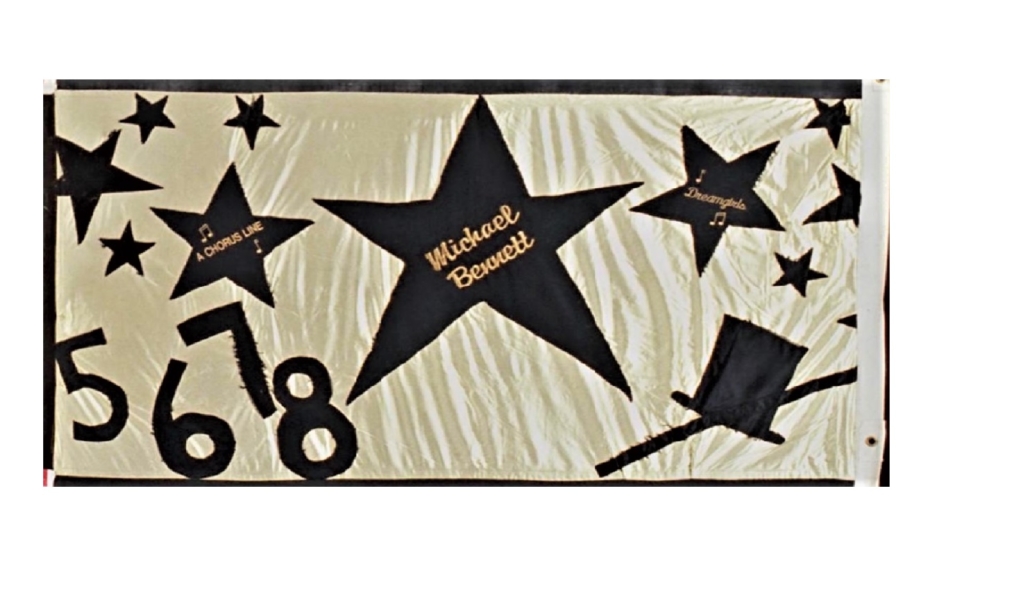
Director and choreographer Michael Bennett, the mastermind behind A Chorus Line, dies at his home in Tucson, Arizona at the age of 44.
Learn More.Bennett was the ultimate Broadway ″gypsy,″ a dancer in the chorus who went on to become a successful choreographer, director and producer, associated with such hit shows as Promises, Promises; Company; Follies; Dreamgirls; and of course, A Chorus Line.
″I went from dancer to choreographer to director to producer to sometime writer,″ he once said. ″But I never had to deviate from my ambition, which was to work in theater.″
Born Michael Bennett DiFiglia in Buffalo, New York, Bennett started dance lessons as the age of 3. As a teen-ager, Bennett studied dance during the summer in New York with Aubrey Hitchins, Matt Maddox and others.
He dropped out of high school at age 16 to perform in a European tour of West Side Story, directed by Jerome Robbins, one of Bennett’s dance idols. Upon his return to New York, he found work dancing in several Broadway shows, as well as TV shows like The Dean Martin Show.
Bennett made his debut as a choreographer in 1966 with A Joyful Noise. Two years later, he had his first Broadway success with the choreography for Promises, Promises, the Burt Bacharach-Hal David musical based on the film The Apartment. This was quickly followed by more hits: Coco starring Katharine Hepburn, and then Stephen Sondheim’s Company.
In 1971, he both choreographed and co-directed Follies, another Sondheim show, and won Tony Awards in both categories. In 1975, he directed, choreographed, and wrote A Chorus Line, which became the longest running musical on Broadway up to that time.
Compared with his contemporary Bob Fosse, Bennett did not have an immediately recognizable choreographic style, according to Masterworks Broadway’s tribute to Bennett.
“Like Jerome Robbins, whom he endeavored to emulate, he strove for unity of style within each separate work, shaped by the story and the characters in it,” Masterworks’ tribute states. “Thus the movement might be jazzy or balletic, romantic or angular, athletic or even a little bumbling, depending on the circumstances. Even in A Chorus Line, the dancers’ execution becomes progressively more polished as the ‘show within the show’ crystallizes.”
Michael Riedel, theater columnist for the New York Post, said A Chorus Line came at a privotal time for Broadway.
“By the mid-1970s Broadway was starting to flounder and so was the city,” Riedel said. “The 1960s rock revolution had changed everything, and new musicals were mostly doing mediocre business or they simply tanked. Times Square had become the preserve of pimps and prostitutes and drug-pushers.”
When A Chorus Line moved to Broadway from its original downtown location of the Joseph Papp Theater, many of the surrounding theaters were dark. But that soon changed.
“Somehow it caught the moment, and when it transferred to the Shubert Theatre on Broadway people started to flock back to Times Square,” said Riedel. “It was the Hamilton of its day. I don’t think any show has ever been so vital to the New York economy.”
In 1986, Bennett determined he was too sick to work, sold his New York property, and moved to Tucson, where he stayed until his death.
Donna McKechnie, an original star of A Chorus Line who was briefly married to Bennett, thinks that if he survived, he could have gone on to even greater things.
“But I learned on Chorus Line to relish the moment you’re in as a performer, because it can end any moment – especially for a dancer,” McKechnie said.
Bennett’s striking panel was among the first to be included in the original display of the NAMES Project AIDS Memorial Quilt.
* * * * * * * *
Photo of quilt panel from the AIDS Memorial Quilt
Dancer Sean O’Neill, who performed with the Pacific Ballet and also edited the San Francisco Ballet program, dies of AIDS-related illness at the age of 29.

Dr. Tom Waddell, founder of the Gay Games, dies of AIDS-related illness in San Francisco at the age of 49.
Learn More.Waddell was a superior athlete, good enough to take sixth in the world in the decathlon in the 1968 Olympics in Mexico City, writes Mart Dobrow of ESPN. He was a paratrooper in the Army, and a doctor with a sense of adventure — working in Africa on patients with tropical diseases and becoming the physician for the Saudi Arabian Olympic team in 1976.
“To Waddell, the symbolism of the Games spoke to his highest ideals: the five interlocking rings, the parade of nations, the torch being lit,” writes Dobrow. “In some ways, this felt like sports at its most pure. It brought people of the world together.”
After his athletic career, Waddell would worked for years as a medical consultant for Whittaker Corp., enjoying the opulence of the Saudi royal family in Riyadh. When he wasn’t in the Middle East, he settled in San Francisco.
There, in the hub of American gay life, Waddell embraced the bacchanal fully, its drug use and promiscuity, before finding what he hoped was true and lasting love with Charles Deaton, a 50-year-old former CIA operative.
Then Waddell had a grand vision; it started out as the “Gay Olympic Games.” Waddell was aware that for many gay people, sports had meant a door slamming shut. His goal was to open the door of completitive sports wide open to the LGBTQ community.
He modeled the Gay Olympic Games after what he considered to be the true principles of the Olympics: equality, fairness, human dignity. Except that the U.S. Olympic Committee didn’t see it that way.
Just 19 days before the games were to begin, the USOC persuaded a federal court to issue an injunction prohibiting Waddell and his group, San Francisco Arts & Athletics, from using the word “Olympic” because of copyright infringement.
Waddell was incredulous and wounded to the core. He pointed out that in the past there had been no opposition to multiple other uses of the term (e.g., the Special Olympics).
With no legal recourse, Waddell and the SFAA scrambled to remove the offending word from a slew of merchandise and promotional material. The hastily rechristened “Gay Games” played out nevertheless in the summer of 1982 with some 1,300 athletes from 12 countries participating.
By the next summer, as Gay Games 2 came to a now-besieged San Francisco, Waddell knew his days were numbered. He checked himself out of the hospital, marched in the opening ceremonies, and delivered a stirring opening address as part of the Games, which attracted some 3,500 athletes from 17 countries.
In one final feat of athletic strength, Waddell managed to win the gold medal in the javelin. Within a year, he was gone.
Today, the Gay Games live on and are help in locations all around the world, including Amsterdam, Sydney, Paris and Hong Kong. Since 1986, The Federation of Gay Games Scholarship Fund has awarded more than 1,000 scholarships to underfunded LGBTQ+ individuals from 70 countries around the world, where the daily struggle for equality is harsh and often dangerous.
Tom Waddell’s core principles of Participation, Inclusion, and Personal Best continue to bring thousands of athletes together to compete.
Every four years in conjuntion with the Gay Games, the Tom Waddell Award is presented to a person or organization involved in the Gay Games that embodies the standards of commitment, selflessness, and love of humanity, and inspires pride through leadership and excellence in sports, culture, or volunteerism.
* * * * * * * *
Photo of quilt panel from the AIDS Memorial Quilt

Arthur J. Bressan Jr., best known for his devastating 1985 AIDS drama Buddies, dies of AIDS-related illness in New York City at the age of 44.
Learn More.A pioneer of independent gay cinema in the 1970s and ’80s, Bressan is best known for his 1985 drama Buddies, the first feature film about the AIDS pandemic. He also directed the largely influential Gay USA, the first documentary by and about LGBT people, and the feature film Abuse (1983).
“If you want to submit one director as the auteur for the post-Stonewall, pre-New Queer Cinema era of Gay Liberation, Arthur J. Bressan Jr. is that director,” writes film critic Caden Mark Gardner.
Bressan’s first credited film work is that of a documentary short called Coming Out, about the first official San Francisco Pride march in 1972. Shot in 16mm and in color, it offers a snapshot of many people who made the pilgrimage to San Francisco.
Bressan would expand this cinematic approach for his 1978 feature-length documentary, Gay USA, made during the National Gay Freedom marches across the country in 1977, the year Harvey Milk became America’s first openly gay elected official.
“Many of the interviewers and testimonies in Gay USA are not just talking about the pleasantness of seeing themselves and being out at this Pride parade, but are speaking with righteous indignation about homophobic violence and systemic homophobia,” Gardner writes.
Bressan’s 1983 film Abuse, a drama with an intensely provocative portrayal of child abuse, is hailed by film critic Rex Reed as “a film of astonishing power and emotional impact.”
“Artie loved butch men and women, drag queens, black, brown and white,” writes Emmy Award-winning director Greta Schiller. “Artie was exceptional in that he loved women. He had none of the misogyny that was (and still is) rampant in our culture, even in the LGBT community. He knew who and what he was, and he was not threatened by women.”
Schiller, who met Bressan in 1983 through activist Vito Russo at a screening of Abuse, said she went to the event “angry that it was a film about a man in authority sleeping with an abused teen.”
After watching the film, she emerged “with my mind blown by the complexity of what I’d seen.”
Russo convinced Schiller to share her reaction to Abuse with Bressan.
“I told him it was a brilliant film that made me realize not all older men who fall in love with a younger man are predators,” she recalled. “The story and acting made me think of Italian postwar neorealist films.”
Schiller says that when Bressan became sick, he was determined to complete Buddies.
“He cut the film on a flatbed in his tiny apartment. He poured his heart and soul into making one last film,” she writes. “I lived a few blocks away from him [in the Chelsea neighborhood of New York City], and I would come get him for a walk around the block. Soon, he could only make it to the corner of 18th Street and 8th Avenue, a block from his home. He would gaze at the high-school boys and talk about the ones he fancied, and how those who were gay would have a better, freer life.”
About 10 years after Bressan’s death, his sister Roe Bressan and LGBT film historian Jenni Olson would launch The Bressan Project to preserve and promote Bressan’s films.
* * * * * * * *
Photo of quilt panel from the AIDS Memorial Quilt
A task force of the Society of Actuaries issues a report claiming that the cost of AIDS to insurance companies could exceed $50 billion by the year 2000.
Learn More.The study, commissioned by the 10,000-member Chicago-based organization, also predicts that future life insurance policies could add $30 billion to $60 billion to the total, depending on whether applicants are screened for the AIDS virus.
The study bases its findings on statistics from the Centers for Disease Control, which suggests that 15% of those infected with the AIDS virus develop the fatal disease after five years and up to 36% are stricken after seven years.
The CDC reported there were 8,000 AIDS deaths in 1986, and is projecting that the number to rise to 54,000 by 1991.
The authors of the study, who are actuaries for the State Mutual Life Assurance Company of America, contend that based on the Federal projections, AIDS claims are expected to go up by a factor of 10 by the 1990s.

Jorge Samaniego, a Cuban-born dancer who performed with the New York City Opera Ballet and on Broadway, dies of AIDS-related illness at County-University of Southern California Medical Center in Los Angeles. He was 40 years old.
Learn More.Samaniego started and ended his dance career in Los Angeles. He studied at the American School of Dance in Hollywood before moving to New York to perform with the New York Metropolitan Opera Ballet. In 1977 in NY, he established his own dance company, the Samaniego Dance Gallery.
Samaniego was ballet master and choreographed for the Milwaukee Ballet before joining the Des Moines Ballet in 1978 as its Artistic Director. The company also brought in Kenneth MacDonald as Associate Artistic Director. The two men, professional and personal partners, were together for 14 years until Samaniego’s death.
In 1981 he choreographed a Public Broadcasting Service production of Romeo and Juliet, in which he played the role of Mercutio. Samaniego also performed with the Western Ballet and Netherlands Dance Theater.
Samaniego returned to Los Angeles in 1982. He reestablished his Dance Gallery, which performed regularly at the Assistance League Playhouse and other LA venues.
Dance Magazine reported that “His annual staging of A Christmas Carol, Peter and the Wolf, and The Nutcracker were holiday favorites in Southern California.”
On Samaniego’s AIDS quilt, MacDonald wrote: “To Jorge Samaniego, my tears, my love, Kenneth.” MacDonald would die from HIV/AIDS complications eight years later, in 1995.
Samaniego and MacDonald are both memorialized in the project Dancers We Lost: Honoring Performers Lost to HIV/AIDS.
* * * * * * * *
Photo of quilt panel from the AIDS Memorial Quilt

With owner Michael Brody dying of AIDS-related illness, the influential NYC dance club Paradise Garage closes.
Learn More.Paradise Garage was a focal point of the downtown Manhattan gay disco scene in the 1970s and ’80s. It was a cavernous members-only nightclub with a 25,000-square-foot dance floor, powerful sound system, and a DJ who would become world-famous.
Hundreds of live acts also performed at the club, including Madonna, Tim Curry, Whitney Houston, Grace Jones, Diana Ross, Sylvester, Jody Watley, and salsa pioneer Willie Colón.
The club, located at 84 King Street in SoHo, derived its name from its former life as a parking garage, according to Douglas Martin of The New York Times.
A departure from the glitter and glamor of nightclubs like Studio 54, the minimalist Garage drew lines around the block that led up the ramp to the entrance. The main room was simply but effectively designed around the sound system and a cushioned dance floor.
Paradise Garage was the love child of record executive Mel Cheren and impresario Michael Brody. With a capacity of 1,400, the club was the place to go to dance.
“People didn’t come to network or get laid. Booze wasn’t sold, drug use was discrete … From midnight until 10 a.m. every Friday and Saturday you could shake your butt and not get harassed by chemically-altered assholes,” wrote Carl Brown in his tribute to the club. “To the Blacks, Latins, and Gays who went there each weekend, the Garage was more than sanctuary. It was church.”
Synonymous with Paradise Garage was its resident DJ, Larry Levan.
“For 10 years from 1977 to 1987, Levan was the star attraction at New York’s legendary Paradise Garage, writing himself into clubbing lore with swashbuckling DJ sets that took in minimal underground disco, funky rock, dub and synth-pop, which foreshadowed the house music revolution,” Sam Richards wrote in The Guardian in 2016. “At the same time, his uncanny ability to mix and tweak records for maximum emotional impact would regularly send his devoted congregation into raptures.”
Levan revolutionized the art of DJing by mixing tracks to create the dance sounds he wanted to produce for his fans, Richards said. Club members, who couldn’t get enough of Levan’s sets, danced until daybreak.
“Safer than the sex they were often afraid to have, they could move, sweat, laugh, cry, relinquish, replenish and take a trip with the pulsating beat of the club as soundtrack,” wrote Johnnie Ray Kornegay III in his article “Black Gay Men of the AIDS Generation Invented Your Party” in The Reckoning.
Michael Brody, the club’s owner, died of AIDS-related illness in December 1987, just a few months after closing the Garage.
Levan, who was HIV-positive, died five years later, on November 8, 1992, of heart failure caused by endocarditis at the age of 38. He was inducted into the Dance Music Hall of Fame in 2004 for his outstanding achievement as a DJ. In 2014, a petition was started to rename King Street, the site of the former Paradise Garage, “Larry Levan Way.”
In 2018, the building that housed the former club was demolished to make room for luxury condominiums, according to the NYC LGBT Historic Sites Project.
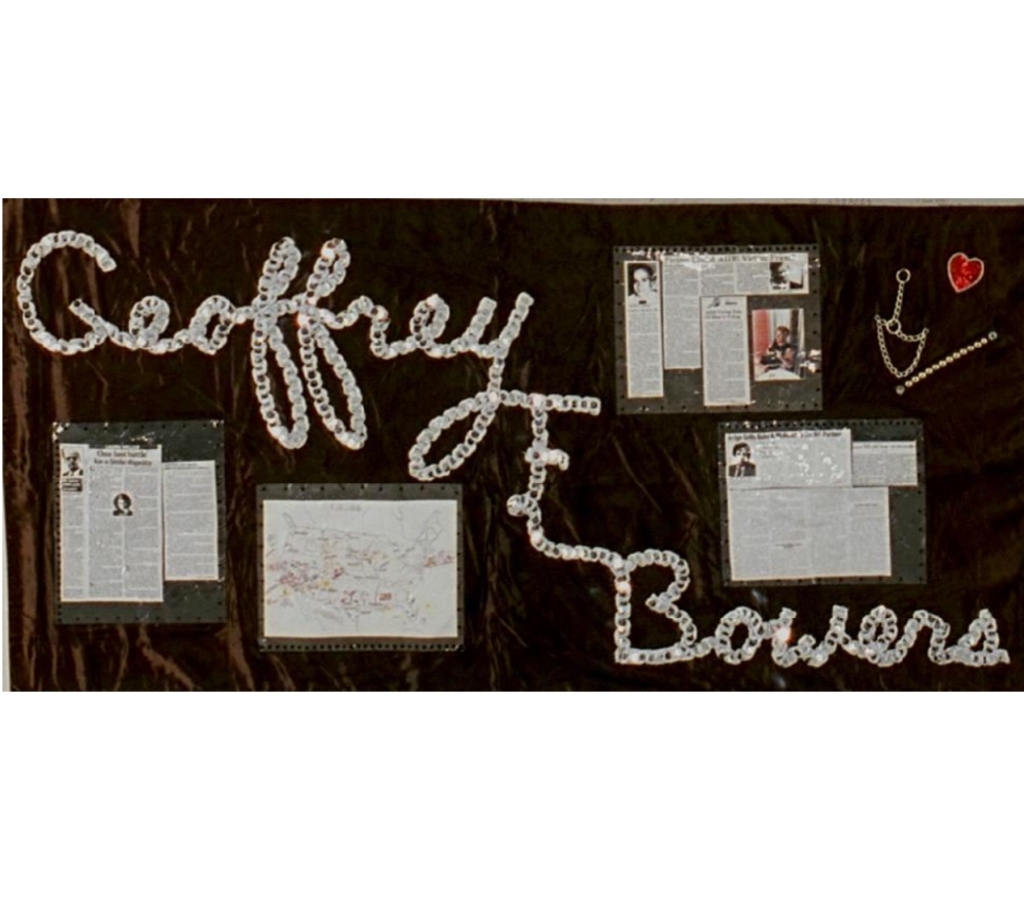
Geoffrey Bowers, the plaintiff in one of the first HIV/AIDS discrimination cases to go to public hearing, dies of AIDS-related illness in New York City. He was 33.
Learn More.Geoffrey Bowers would not live to hear that the court had ruled in his favor.
In early 1987, Bowers filed a complaint with the New York State Division of Human Rights, alleging that the international law firm Baker & McKenzie fired him in 1986 because he was diagnosed with Kaposi’s sarcoma and AIDS, according to the American Association for Justice.
During the court proceedings, Bowers testified that the firm terminated his employment with little warning. He said his firing occurred shortly after dark purplish lesions from Kaposi’s sarcoma, a symptom of AIDS, began to spread over his face.
In response, Baker & McKenzie arranged for colleagues to testify they had not known that Bowers was sick and that they thought the KS marks were “bruises or bicycle scrapes.”
In the mid 1970s, Bowers attended Brown University, and received a Bachelor’s degree in political science. He also learned to speak Italian, German, French, Dutch and Spanish. After a few years working as a television news reporter and factory worker, he enrolled in Benjamin N. Cardozo School of Law in New York City.
To support himself through law school, he held several part-time jobs and also earned a position on the Cardozo Law Review. After receiving his Juris Doctor and passing the Bar exam in 1982, he joined Phillips, Nizer, et al. as an associate, and then in August 1984, be became a litigation associate with Baker & McKenzie.
Bowers was diagnosed with AIDS in April 1986.
Jay L. Katz, a Cardozo classmate who went with him to get the test results, told The New York Times: “But he dealt with that. He continued work and he continued with his life.”
The visible signs of Kaposi’s sarcoma were appearing on Bowers’ face, starting with a dark spot under the pale white skin of his chin, Katz said.
The following month, Bowers received a satisfactory evaluation from his supervisors at Baker & McKenzie. However, in July 1986, the firm moved to fire him, and went outside the normal termination procedures to do so.
Bowers told Lynne Weikart, the Executive Deputy Human Rights Commissioner overseeing his case: “In light of the fact that I was dealing with my AIDS and my Kaposi’s sarcoma, I merely felt as though they had taken the last thing in the world that meant anything to me.”
Hearings on the case were held between July 1987 and June 1989. Bowers asked two friends from Cardozo — Robert Balsam and Daniel Felber — to represent him. After Bowers died, Balsam and Felber would continue with the case to its conclusion.
Commissioner Weikart would rule in Bowers’ favor with a record-breaking award — $500,000 in compensatory damages for emotional distress, pain, suffering, and humiliation, plus the back pay he would have earned had he remained employed. In his will, Bowers named his mother as beneficiary.
“They took from [Bowers] the one thing that kept his spirits high in spite of impending death,” Weikart wrote. “[He] no longer had the opportunity to prove that he could be a competent attorney despite suffering from AIDS.”
The court ruling brought AIDS discrimination to the public eye and established a favorable legal precedent.
In 1994, Geoffrey Bowers would be in the news again, when the trustees of his estate filed suit against the makers of the movie Philadelphia, alleging that the film used Bowers’ story without providing credit or compensation. In 1996, Tristar Pictures would settle with the Bowers estate and issue a statement saying the film “was inspired in part” by Bowers’ story, according to The New York Times.
A Gallup poll finds that 68% of those polled considered AIDS to be “the most urgent health problem facing the world.”
Learn More.By the time Gallup would field its next survey in 1990, the U.S. Congress would be poised to pass the Ryan White Comprehensive AIDS Resources Emergency (CARE) Act, and the share of the public naming AIDS as a top problem would fall to 49%.
In the 1990’s, a decade that saw major advances in HIV treatment including the development of effective combination anti-retroviral therapy, the public would continue to focus on other issues healthcare facing the counties around the world. By 2009, the proportion polled who named AIDS as the top health problem would fall to single digits.
However, in the coming years, Black Americans would be prevalent among those naming HIV as the most urgent health problem.

Jerry Carlson, conductor of the Gay Men’s Chorus of Los Angeles, dies of AIDS-related illness at his home. He was 31 years old.
Learn More.Originally from Chicago, where he had helped to found the Windy City Chorus and the Chicago Gay Pride Band, Carlson became the principal conductor of the Gay Men’s Chorus of Los Angeles (GMCLA) in 1981. Almost immediately he went to work elevating the Chorus to a more professional sound and look.
Carlson instituted an audition process for the first time, according to the Los Angeles Times. He kept pop music in the chorus’ repertoire, but also challenged his singers to stretch to meet the demands of more serious music like Leonard Bernstein’s “Chichester Psalms.” Setting the Chorus on an ambitious musical direction that would continue for decades after his death, Carlson always pushed his singers to the next level.
In early 1987, the GMCLA was invited to sing the text of Shostakovich’s 13th Symphony for a November concert with the Long Beach Symphony — a golden opportunity. But Carlson’s health was on the decline, and he soon grew too weak to conduct rehearsals. Choral conductor Beverly Patton stepped in to help.
For the last rehearsal, Carlson was brought in on a wheelchair, so he could speak to the singers one last time.
“It was important for him to know we were still with him, and he was with us,” said Jon Bailey, chairman of the music department at Pomona College who took over from Carlson as GMCLA’s conductor.
Two weeks later, Carlson died.
“Jerry had taken a bunch of guys and made them into a musical instrument, and now they sang for him, at his memorial service,” Bailey told the Los Angeles Times. “And they sang very well.”
While Carlson was the latest AIDS casualty among members of the GMCLA, members had been steadily dying of AIDS-related illness since late 1984, according to the LA Times. But because Carlson had such a strong influence on the Chorus as a whole, his death had perhaps the most profound impact to date.
Before the end of the 1980s, more than 40 members had died of AIDS. By 1995, the Chorus had lost over 150 members, sometimes losing another member with each passing week, according to the GMCLA website. Many of the members are memorialized on Russ Bickers’ website.
For many years, the Chorus could not sing a sad song without the specter of AIDS hanging over the performance.
GMCLA was one of the first gay men’s choruses in the U.S., according to the organization’s Executive Director Lou Spitzo. The Chorus had its first rehearsal in West Hollywood’s Plummer Park in July 1979 with 99 men.
In 1991, GMCLA became the first gay men’s chorus to tour central Europe, according to Los Angeles Almanac. The Chorus was also the first to perform before a sitting U.S. president (Clinton in 1999), and the first to tour South America (2006).
* * * * * * * *
Photo of quilt panel from the AIDS Memorial Quilt
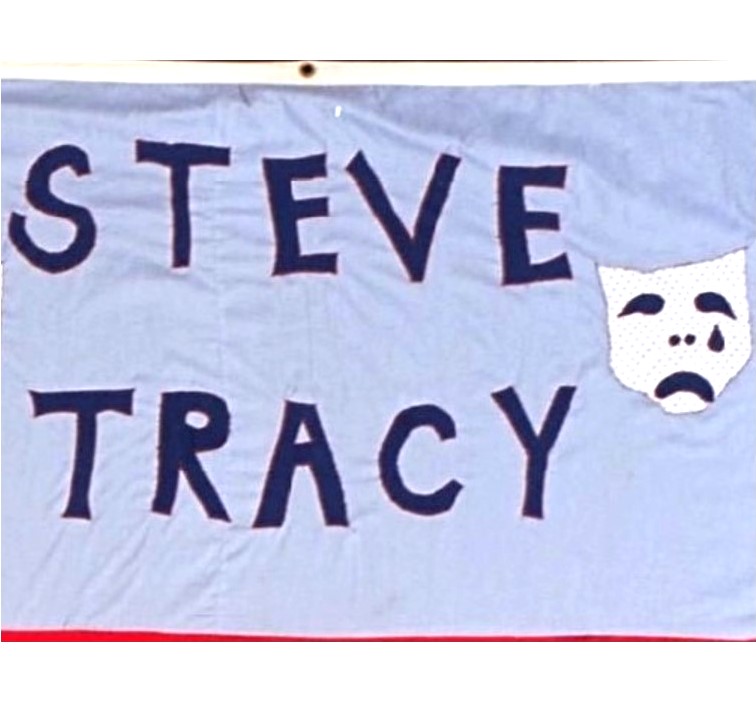
Steve Tracy, a film and TV actor best known for his role as Percival Dalton on Little House on the Prairie, dies of AIDS-related illness in Los Angeles at the age of 34.
Learn More.Six months before his death, he performed in the Los Angeles theater production of AIDS/US: Portraits in Personal Courage. The piece featured true stories of having AIDS or losing family members to AIDS. Tracy was the only professional actor in the production.
“Then one night in November 1986, Steve called,” wrote Arngrim. “He told me what I had been dreading for several months: he had very little time left, and his mother and sister were coming to take him home to Florida. He wanted to die at home … Less than a week later, on Thanksgiving Day, Steve Tracy died.”
Tracy’s ashes were brought to Los Angeles and scattered under the Hollywood sign, under the letter “D,” per his wishes.
Arngrim continued to work with various AIDS organizations all over the country.
* * * * * * * *
Photo of quilt panel from the AIDS Memorial Quilt

Goh Choo San, a Chinese ballet dancer and choreographer with the Washington Ballet, dies of AIDS-related illness at his New York City home. He was 39 years old.
Learn More.As the Washington Ballet’s first resident choreographer, Goh worked with the company from its 1976 founding until his death. Goh’s distinct style emphasized technique and musicality over plot and blended Eastern movement with classical ballet technique, showcasing the dancers’ strengths that company founder Mary Day had cultivated in her studio.
“Those of us in Washington who witnessed his artistic blossoming over the past 11 years … have an enormous legacy to be grateful for,” wrote Pulitzer Prize-winning dance critic Alan M. Kriegsman in his tribute to Goh in The Washington Post. “And his works — 34 ballets created since 1973, 14 of them expressly for the Washington Ballet — will live on and transmit his genius to posterity.”
Raised in Singapore with eight older siblings, Goh followed in the path of an older brother and sister who were training in the art of dance. After graduating from the University of Singapore with a degree in bio-chemistry, Goh travelled to Europe and joined the Dutch National Ballet in Amsterdam, where he was eventually promoted to soloist.
While still a dancer with the company, Goh created his first ballets and began drawing the attention of dance aficionados, including that of Mary Day, who was starting a new ballet company in Washington, DC. Day offered him a position in 1976 with her newly founded Washington Ballet.
“It is no exaggeration to call [Goh’s] choreographic ascent meteoric,” wrote Kriegsman. “Within two years of his arrival, he had choreographed six ballets for the Washington company. He had also attracted the attention of Mikhail Baryshnikov, who met with Goh in Washington, watched him work and laid the groundwork for a major commission for American Ballet Theatre.”
The commissioned work became the 1981 ballet Configurations, which was danced by Baryshnikov and a contingent of ABT dancers at Lisner Auditorium as part of the Washington Ballet’s historic “Golden Gala.” The creation and performance of the work were documented by London Weekend Television and is now available as Baryshnikov: The Dancer and the Dance.
Goh’s choreography for Configurations is considered a concrete example of his command of the classical dance vocabulary and his ingenuity in creating striking imagery. The ballet is set to Samuel Barber’s Pulitzer Prize-winning Piano Concerto, a score that is difficult to play and even more difficult to dance to.
”He is intensely musical, and his ballets are all marked by a first-rate command of structure and fluency,” Anna Kisselgoff, chief dance critic of The New York Times, wrote in 1980. ”He concentrates on speed, intricacies of movement, difficult toe work and streamlined partnering. His base is strongly neo-Classical with a sleek contemporary look, incorporating modern-dance idioms and unexpected gestures, wrist rotations, interpolated academic steps that burst out of the usual flow of movement, acrobatic tumbling within a partnering technique and subtle nuances.”
In 1982, he would choreograph In the Glow of the Night, a ballet set to music by Bohuslav Martinu that would be praised as Goh’s most perfectly realized work. In 1986, Unknown Territory — his last completed ballet — was touted as an important work for both Goh and the Washington Ballet.
“Every two years since his arrival in Washington in 1976, he’s come up with a breakthrough of sorts: the propulsive abstraction Fives in 1978; the distilled romanticism of Lament in 1980; a fusion of these contrary impulses in the 1982 In the Glow of the Night; his first full-length narrative work, Romeo and Juliet, in 1984 (for the Boston Ballet); and now the richly exotic Unknown Territory,” wrote Kriegsman in 1986, not realizing that this work would be Goh’s last.
In 1992, five years after Goh’s death, the Choo San Goh & H. Robert Magee Foundation was formed to provide annual scholarships and grants for new dance works in an effort to further develop choreographic talent. The foundation also oversees the licensing of Goh’s ballets in performances by dance companies throughout the world.
In 1997, the Singapore Dance Theatre commissioned a monograph on Goh entitled Goh Choo San, Master Craftsman in Dance. It contains a detailed overview of Goh’s life in written text and photos of his ballets. The company also added to their repertoire twelve of Goh’s works, bringing his identity as a Singaporean choreographer back to his homeland.
* * * * * * * *
Photo of quilt panel from the AIDS Memorial Quilt

Lyle Loder, member of the congregation of the Hollywood United Methodist Church, dies of AIDS-related illness at the age of 37.
Learn More.Loder was a key leader in development of an LGBT witness among United Methodists in southern California during the early 1980s, recalls his friend Morris Floyd.
Feeling called to the United Methodist ministry, Loder studied philosophy and religion and served as a student pastorate while at Kansas Wesleyan University in the early 1970s, according to Floyd. However, Loder chose to not hide his identity, and by the time of his graduation from KWU, the denomination had incorporated into its Discipline the language describing same-sex relationships as “incompatible with Christian teaching.”
“Lyle’s dream of serving as a United Methodist clergyman was never realized,” writes Floyd in the LGBTQ Religious Archives Network.
Instead, Loder would go on to help build a local congregation that would welcome lesbian and gay United Methodists in the Hollywood area. By 1986, Loder would be an active member of HUMC and he would share with the congregation that he was living with AIDS.
In October 1987, the Health and Welfare Ministries Division of the Board of Global Ministries hosted a consultation conference on AIDS at a hotel near the San Francisco airport. Loder was invited to help plan the conference and participate in a panel discussion about the needs of people living with AIDS.
“Lyle’s participation on a panel, sharing his story, and in the midst of it, despite everything, his love for God and his refusal to give up on the United Methodist Church,” recalls Floyd. “He was frail and only a few weeks from death, though he did not know it at the time. If ever God’s Spirit was present anywhere, it shone in Lyle in those hours.”
On November 29, 1987, the day before his birthday, Loder was admitted to the hospital, where he was visited by his brother. When Loder died a few days later, many friends came to his hospital room, spread rose petals on his bed, and sang hymns
 Memorial services were held at HUMC and again at Loder’s home church in Kansas. Loder was the first of the HUMC family to die of complications of HIV/AIDS, but he wouldn’t be the last.
Memorial services were held at HUMC and again at Loder’s home church in Kansas. Loder was the first of the HUMC family to die of complications of HIV/AIDS, but he wouldn’t be the last.
A memorial plaque inside the church narthex carries the names of Loder and 34 additional members of the congregation who died in the early years of the pandemic. On World AIDS Day in 1993, members of HUMC fashioned two giant red ribbons and attached them to the tower of the church. In 1996, more permanent ribbons replaced them and remain today.
Loder’s life is also memorialized by three panels of the AIDS Memorial Quilt, one of them made by church and community worker Donna Kay Campbell.
* * * * * * * *
Photo of quilt panel from the AIDS Memorial Quilt
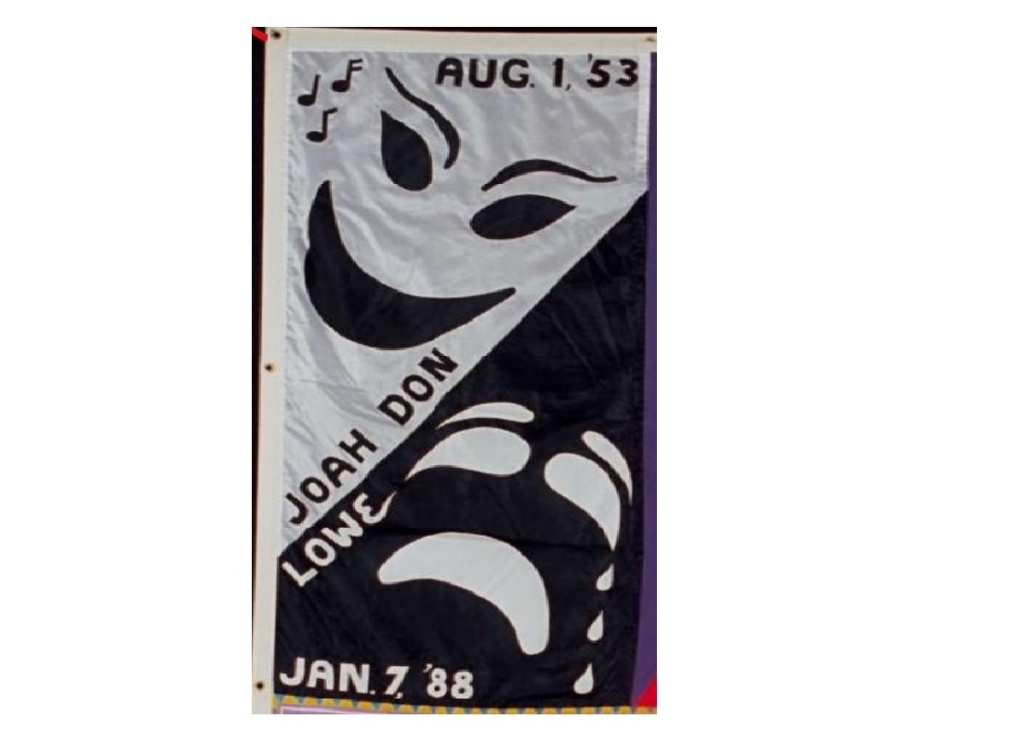
Dancer and dance teacher Joah Lowe dies of AIDS-related illness at the age of 34.
Learn More.Lowe performed in the San Francisco area and taught dance classes, including one titled, “Lessons in the Art of Flying.”
In 2004, dancer Keith Hennessy was asked to write about Lowe, his first dance teacher.
“Joah taught a weekly class, an introduction to contemporary dance that involved technique and improvisation,” Hennessy writes. “Joah, thanks a lot. Thanks for welcoming me, for steering me into the future and away from the past…. You were my first authentically intuitive man.”
The Joah Lowe collection — which includes theater, performance and dance ephemera, performance and dance production notes, and related art and artifacts from Lowe’s work — is stored at the GLBT Historical Society in San Francisco. The collection includes material collected by Charlie Halloran, a dancer who worked with Lowe and who subsequently died in 1993, also from AIDS-related illness.
* * * * * * * *
Photo of quilt panel from the AIDS Memorial Quilt

Michael Cappara — a dancer, choreographer and teacher — dies of AIDS-related illness in San Diego at the age of 39.
Learn More.Cappara brought serious dance credentials to San Diego in the 1970s by founding a local chapter of the National Ballet Academy and then the City Centre Ballet Company. At both companies, he performed, choreographed and taught.
Starting dance at the age of five, Cappara won scholarships early on to study at the nation’s top dance schools, including the American Ballet Theatre School in New York City and the National Ballet of Washington, DC.
His career took him across the U.S. and to Europe, Canada and Mexico. Prior to moving to San Diego to found his own dance company, he danced with the Oakland Ballet Company and the San Francisco Ballet. Women dancers preferred to be partnered with Cappara because of his strength and technique.
“Ballet was Michael Cappara’s life and joy,” according to Dancers We Lost: Honoring Performers Lost to HIV/AIDS.
Noel Baron, Cappara’s dance partner in San Diego for more than ten years, said, “He was a gift to all dancers in the region,” a man “so giving that he would go to extremes to assist and find opportunities for dancers.”
* * * * * * * *
Photo of quilt panel from the AIDS Memorial Quilt

Community artist Chuck Arnett dies of AIDS-related illness in San Francisco at the age of 60.
Learn More.Formerly a dancer with the National Ballet in New York, Arnett relocated to San Francisco in the 1960s and established himself as an artist and a central figure in the early leather scene. His murals covering the walls of local leather bars like The Stud and the Tool Box (pictured) inspired observers to compare Arnett to Toulouse-Lautrec.
Arnett’s interior murals at the Tool Box were the establishment’s best-known calling card. According to the LGBT Historical Society in San Francisco, one set of Arnett’s murals were located along the south-facing, Harrison Street walls, and two additional mural panels were painted on the glass storefront windows on the west-facing, 4th Street walls.
The Harrison Street murals became internationally known in June 1964 when photographs of the interior of the Tool Box were featured in Life Magazine in a feature article entitled “Homosexuality in America.” The article described San Francisco as “The Gay Capital of America” and inspired many gay leathermen to move there, according to the Leather History Timeline.
Unfortunately, Arnett’s Tool Box artwork was on display for only a brief time. The Tool Box closed in 1971 and the building (along with the Harrison Street murals) was torn down in 1975. The panel that is pictured here was painted on wood and was able to be removed prior to the destruction of the building. A San Francisco couple purchased the panel at a garage sale in the 1990s, and it was donated to the GLBT Historical Society in 2021.
The San Francisco South of Market Leather History Alley consists of works of art along Ringold Alley honoring leather culture. One of the works of art is a black granite stone etched with a narrative by Gayle Rubin and a reproduction of Arnett’s Tool Box mural. Another of the works of art is bronze bootprints along the curb which honor Arnett and 27 other icons of the leather community.
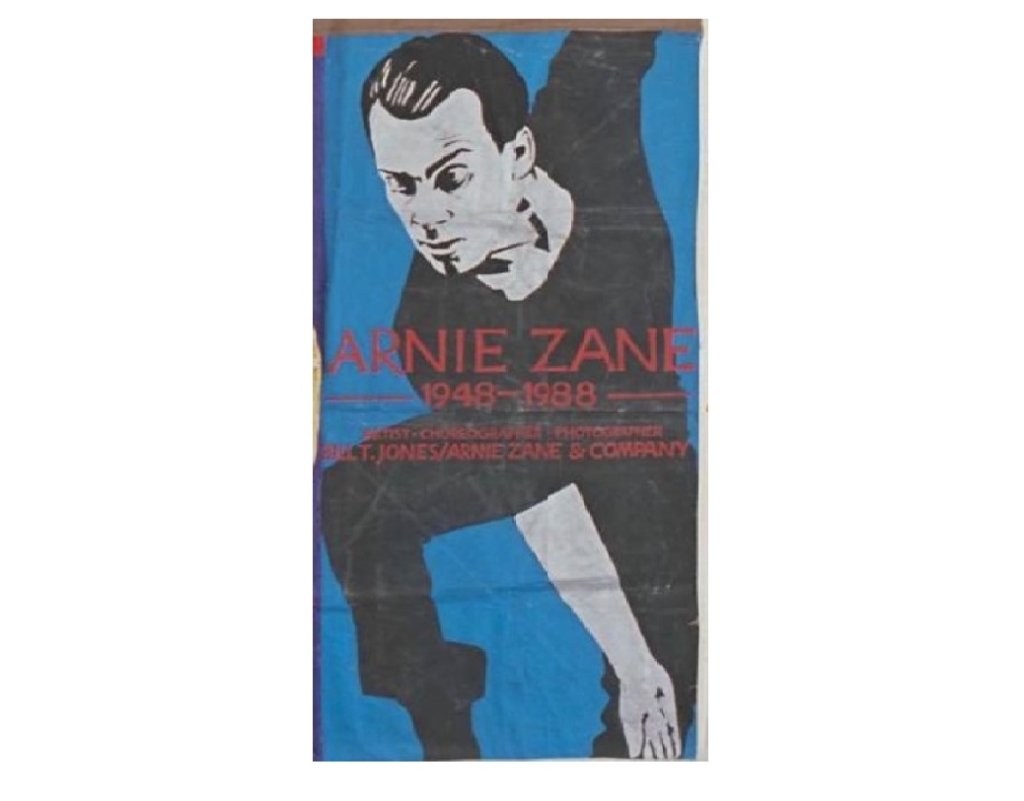
Arnie Zane, the co-artistic director of Bill T. Jones-Arnie Zane Dance Company, a leading postmodernist dance troupe, died of AIDS-related illness at his home in Valley Cottage, New York. He was 39 years old.
Learn More.Zane was born in the Bronx and attended public schools in New York City, receiving an undergraduate degree from the State University at Binghamton. Zane began working with Bill T. Jones in 1971, and they formed the American Dance Asylum with Lois Welk in 1973 in Binghamton, New York.
“They made an unlikely team: Jones is tall and muscular and his dancing expansive, while Zane, short and wiry, leaped about the stage in bursts of nervous energy,” according to the Los Angeles Times.
After touring together in the U.S. and abroad, the two choreographer-dancers formed the Jones-Zane company in 1982 and appeared in that year’s Next Wave festival at the Brooklyn Academy of Music. Through much of the 1980s, the company drew critical acclaim for its stylish, punchy dance that incorporated narrative and text set to music by noted post-modernist composers. Zane and Jones’ choreography often explored issues such as racism, religion, sexism, and the nuclear age.
Zane held two Creative Artists Public Service Fellowships: for photography in 1973 and for choreography in 1981. He also was awarded two fellowships from the National Endowment for the Arts in 1983 and 1984.
In 1986, he and Jones were recipients of New York’s Dance Performance Award (the “Bessie”) for their 1985 season.
Following Zane’s death, Jones kept the name of the company the same. Published in 1990, Body Against Body: The Dance and Other Collaborations of Bill T. Jones and Arnie Zane is a collaboration by the two men, examining their work together.
“The reader of Body Against Body is left to contemplate the toll the disease is taking in the arts community and to reflect on what the premature death of so many young artists means to the performing arts, to their audience and to humanity,” wrote Charles Solomon in the LA Times.
Also in 1990, Jones (who was also diagnosed as HIV-positive) created the now canonical work, D-Man in the Waters, which explored the grief, loss and existential fear shared by many in the dance community at that time.
* * * * * * * *
Photo of quilt panel from the AIDS Memorial Quilt

Russian-born pianist Youri Egorov dies of AIDS-related illness at his home in Amsterdam at the age of 33.
Learn More.Egorov made his mark on the performance of classical music in his own highly individual way. Between the ages of 6 and 17, he studied music at the Kazan Music School and then studied for six years at the Moscow Conservatory. In 1976, at the age of 22, Egorov defected from Russia to Amsterdam. applying for asylum just before a concert in Italy.
The year following his defection, Egorov participated in the Cliburn music competition in Fort Forth, Texas and became an audience favorite. When he was not chosen by judges as a finalist, a group of patrons and Cliburn board members formed an ad-hoc committee to raise money equal to the top prize of $10,000 to further Egorov’s career.
In 1978, Egorov had his New York recital debut in Alice Tully Hall at Lincoln Center at the age of 24, and his career took off. By the end of the year, Egorov would give a performance at Carnegie Hall, which was recorded live. The same year, he performed for the Schumann Carnaval, a recital for German TV.
”Mr. Egorov plays in a free, romantic style, and his approach is quite different from that of so many competition winners,” wrote Harold C. Schonberg in The New York Times after Egorov’s New York debut.
Egorov’s dramatic style can be heard (and seen) in this abbreviated recording of a concert with the Concertgebouw Orchestra in Amsterdam in June 1979.
In the book Great Contemporary Pianists Speak for Themselves compiled by Elyse Mach, Egorov spoke candidly on the topics of rehearsal, pre-concert nervousness, artistic restrictions in Russia, and homosexuality. In Amsterdam, Egorov met Jan Brouwer, who became his long-term partner.
Although he took an apartment in Manhattan in the late 1970s, and he and Brouwer established a residence in Monte Carlo for tax purposes, Egorov counted Amsterdam as his home throughout his 12 years in the West.
When Egorov died in 1988, he had recordings of several performances awaiting release. His partner died about four months after Egorov, and both their remains are interred at Driehuis Velsen Crematorium, Noord-Holland, Netherlands.
* * * * * * * *
Photo of quilt panel from the AIDS Memorial Quilt
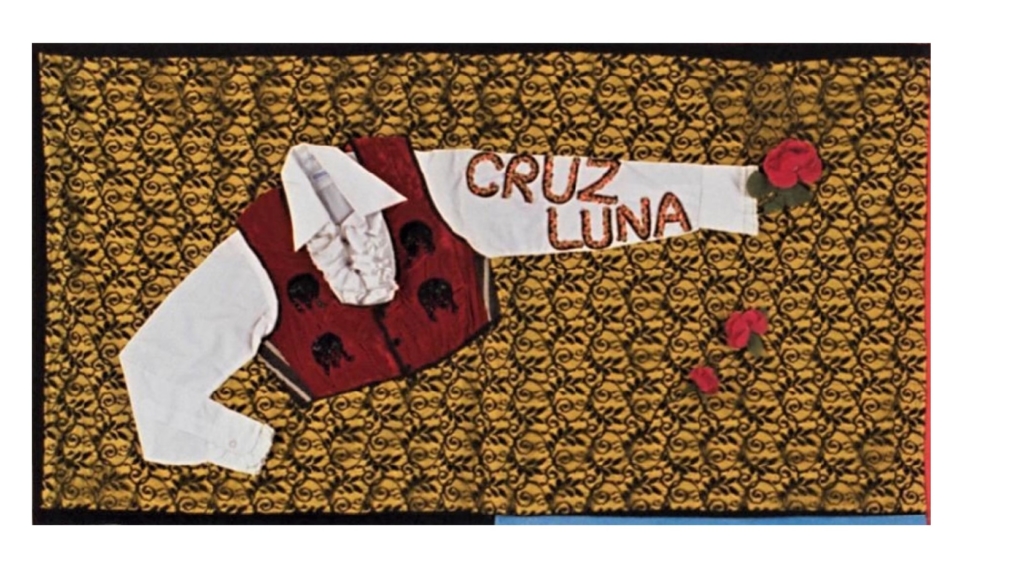
Nationally known flamenco dancer Cruz Luna dies of AIDS-related illness at the age of 50.
Learn More.
A native of Spain, Luna learned flamenco dancing in cafes there and studied later in Mexico and Los Angeles. He launched his career at the age of 17 with appearances on the Ed Sullivan and Dave Garroway television shows.
Luna danced in an international tour with the Ballet Nacional of Spain and in a Broadway show titled Ole! Ole! He moved to San Francisco in 1959 and performed with the Smothers Brothers and Phyllis Diller. From 1960 to 1974, he operated Cafe Madrid in North Beach and presented flamenco dancers from around the world.
He died at Garden Sullivan Hospital in San Francisco.
Luna is memorialized in the project Dancers We Lost: Honoring Performers Lost to HIV/AIDS.
* * * * * * * *
Photo of quilt panel from the AIDS Memorial Quilt
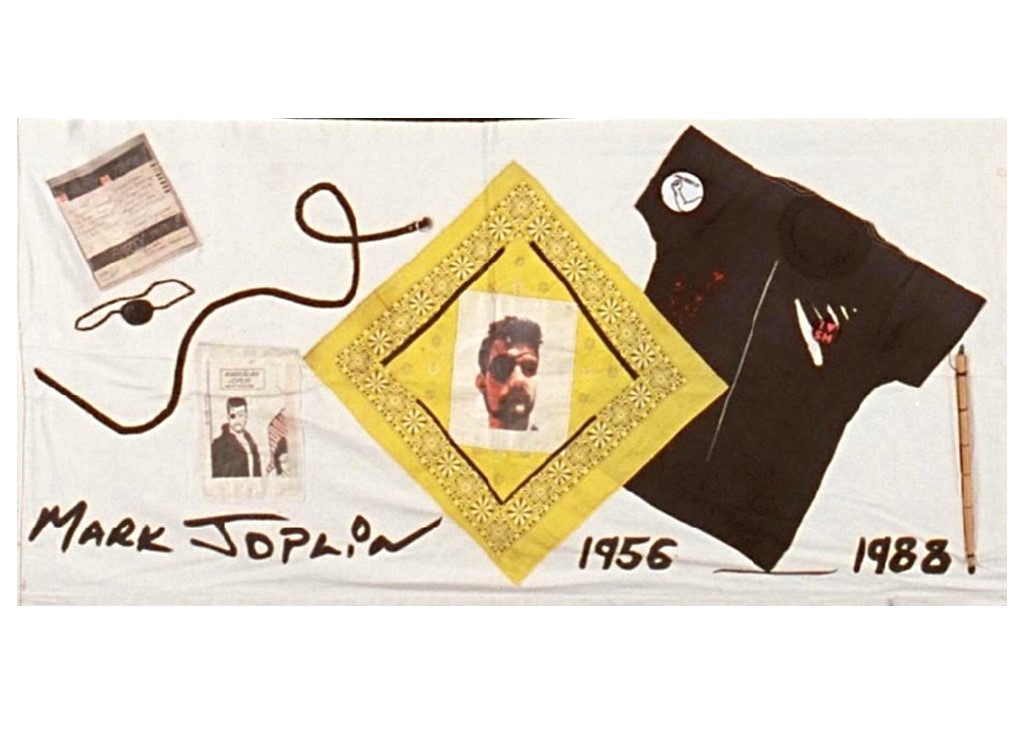
Markalan “Mark” Joplin, a well-loved figure in San Francisco’s SM community, dies of AIDS-related illness at Fairmont Hospital at the age of 32.
Learn More.Joplin was co-coordinator of the newsletter published by the Society of Janus, and also served as an editor. He was also the drummer for the San Francisco Precision Whip Drill Team in the 1987 Gay and Lesbian Freedom Day Parade.
Joplin also wrote comic book stories and was known as a talented DJ and musician, according to the Bay Area Reporter.
* * * * * * * *
Photo of quilt panel from the AIDS Memorial Quilt
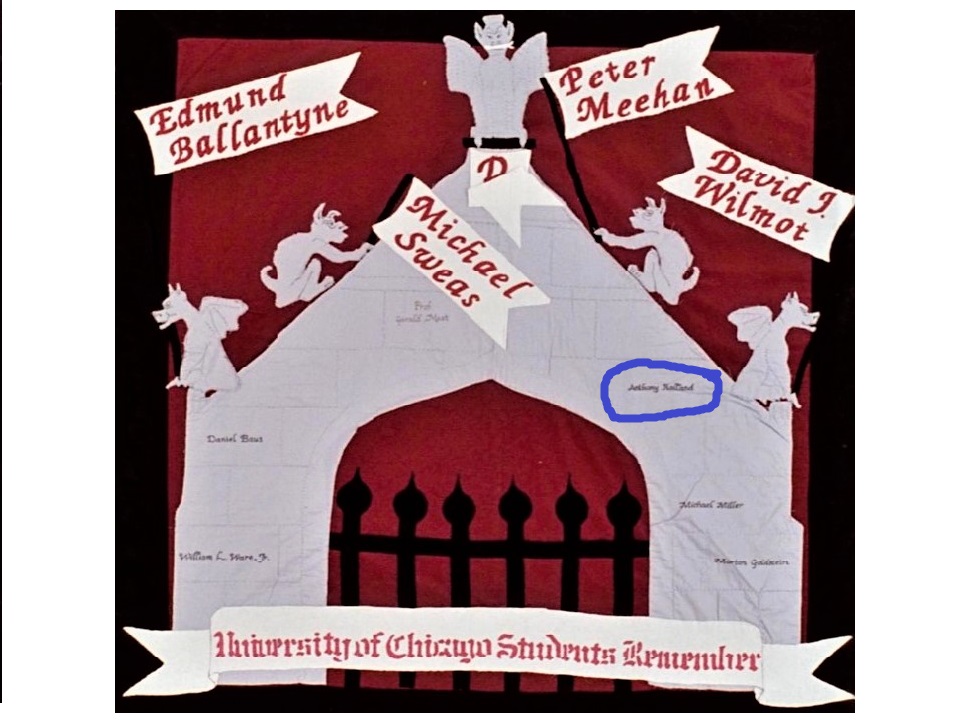
Actor Anthony Holland, whose health was declining due to infection with HIV, commits suicide in his Manhattan apartment; he was 60 years old.
Learn More.A graduate of the University of Chicago, Holland had been a member of the original Second City comedy troupe, where he met Joan Rivers, with whom he remained friends until his death.
He made his Broadway debut in 1963 in Lillian Hellman’s comedy My Mother, My Father and Me. His half-dozen subsequent Broadway roles included Division Street and We Bombed in New Haven. He appeared in many regional-theater productions, as well as Off Broadway productions of Brendan Behan’s ‘Quare Fellow, Eugene Ionesco’s Victims of Duty and Samuel Beckett’s Waiting for Godot.
He gave one of his best performances in The Hunger Artist, Martha Clarke’s 1987 adaptation of several stories by Franz Kafka.
“His soft voice, unpretentiously conversational in tone yet mesmerizingly grave, could be Kafka’s,” Frank Rich wrote in The New York Times.
In 1979, he gives a standout performance in the film All That Jazz as Broadway songwriter Paul Dann, and appears in scores of other films between 1964-1986.
Holland took his own life just as he was entering the final stages of the disease “in what can only be called an act of sheer bravado,” writes friend David Ehrenstein. He had saved enough medication to facilitate a lethal overdoes.
“Tony had elected to make his exit on a day when he was in a good mood,” Ehrenstein recalled. “He was in New York at that time and friends recall seeing him around town at his usual haunts in high spirits.
Holland had left instructions for the paramedics and even rubber gloves in case they were concerned about handling an “AIDS corpse.”
* * * * * * * *
Photo of quilt panel from the AIDS Memorial Quilt
Tommy Pace, a member of the pioneering Gay Men’s Theater Collective, dies of AIDS-related illness in San Francisco at the age of 39.
Learn More.Pace was known locally as a brilliant comic actor with the Angels of Light, a theater troupe that originated as an offshoot of the Cockettes, according to the Bay Area Reporter.
Pace was also cast in numerous San Francisco-made films, including the role of a deranged Catholic
schoolgirl in David Weissman’s 7-minute comedy Beauties Without a Cause (1986).
“Tommy was a macho Guido trapped inside a flaming Queen, and he played both roles to the hilt,” wrote friend Dolores DeLuce in RDF magazine. “I met Tommy at Purple Heart Thrift Store on Mission Street, where I noticed him in the mirror trying on a glitter halter over his clothes and flipping his long, dark hair like a girl in the shampoo commercial.”
Pace and DeLuce grew close as they performed together in theatrical events in the late 1970s. After DeLuce moved from San Francisco to Los Angeles, their friendship continued over long-distance phone calls.
In 1988, she returned to San Francisco to see Pace when she heard from mutual friends that he was dying of AIDS.
“He refused his morphine drip so he could fully take in these last moments,” DeLuce wrote of her reunion with Pace. “We both knew this was the end for him, but we never spoke of it. Instead, we talked about the glorious days of shows, drag and juicy dish.”
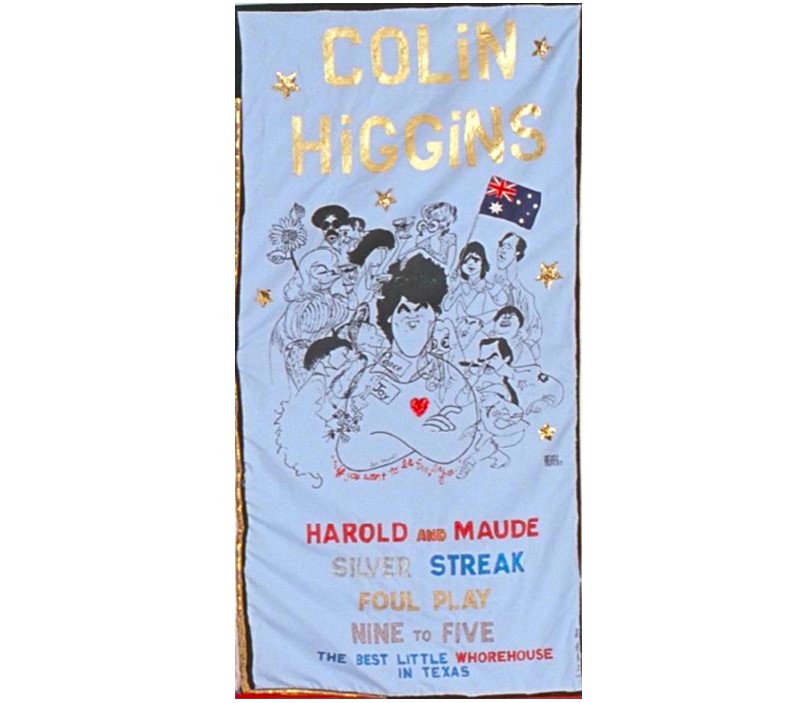
Colin Higgins — acclaimed screenwriter, director, and producer of films such as Harold and Maude and 9 to 5 — dies of AIDS-related illness at his Beverly Hills home. He was 47.
Learn More.Best known for writing the screenplay for the 1971 cult movie Harold and Maude and for directing the films Foul Play (1978) and 9 to 5 (1980), Higgins’ last project was co-writing and co-producing with Shirley MacLaine a 1986 television mini-series based on her book, Out on a Limb.
Born on the South Pacific Island of New Caledonia, Colin Higgins lived in Australia until his family migrated to California. He attended Stanford University on a scholarship but dropped out to pursue acting in New York, according to The Legacy Project in Chicago. From there, he enlisted in the U.S. Army and worked overseas for the newspaper Stars and Stripes. Returning to the U.S. in 1965, he re-entered Stanford, where he wrote a rough treatment for the story of Harold and Maude as part of his Master’s thesis.
Harold and Maude was the story of an unlikely romance between a suicidal teenager, played by Bud Cort, and an eccentric 80-year-old woman, portrayed by Ruth Gordon. The film drew scant attention when it was released in 1971, but went on to become a revival-house and college campus classic.
Higgins, who was openly gay, wrote the TV movie The Devil’s Daughter (1972), followed by a stage version of Harold and Maude, which ran in Paris for seven years. His Hollywood breakthrough occured with his screenplay for the Richard Pryor-Gene Wilder movie Silver Streak (1976). Higgins followed this by writing and directing Goldie Hawn and Chevy Chase in Foul Play (1978) and then Dolly Parton, Jane Fonda and Lilly Tomlin in the smash hit 9 to 5 (1980). In 1982, he directed the film version of the stage musical The Best Little Whorehouse in Texas, starring Burt Reynolds and Dolly Parton.
Following his diagnosis with HIV in 1985, Higgins founded the Colin Higgins Foundation to provide support for LGBT youth. The foundation supports numerous LGBTQ organizations, ranging from the Gay, Lesbian and Straight Education Network (GLSEN) to gay, lesbian, bisexual and transgender outreach and AIDS prevention programs.
Since 1988, the Foundation has awarded over 660 grants totaling over $5.8 million dollars to further the humanitarian vision of its founder, Colin Higgins.
* * * * * * * *
Photo of quilt panel from the AIDS Memorial Quilt
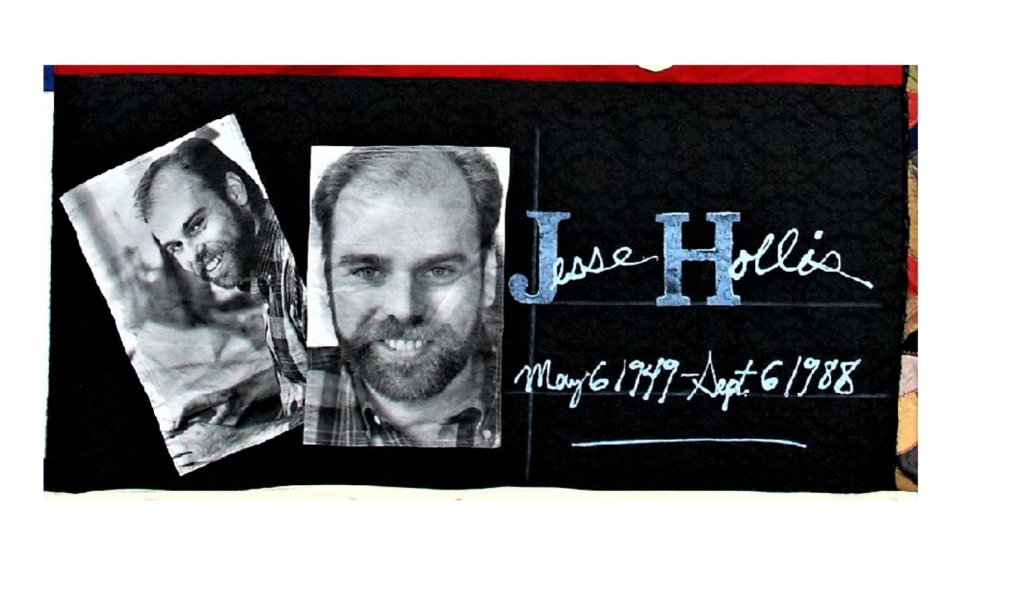
Jesse Hollis, the resident set designer at American Conservatory Theater in San Francisco, dies of AIDS-related illness at the age of 39.
Learn More.Hollis’ designs were seen at theater and opera companies throughout the country, including Berkeley Rep, the Oregon Shakespeare Festival and the Magic Theatre.
* * * * * * * *
Photo of quilt panel from the AIDS Memorial Quilt
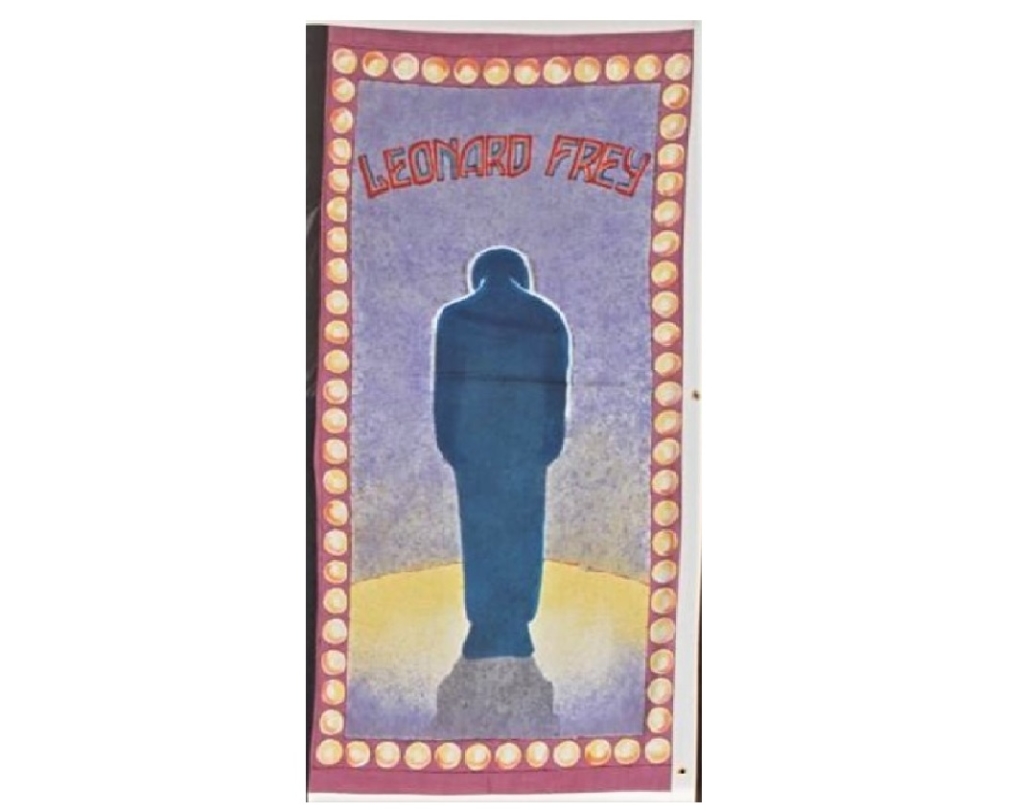
Leonard Frey, an actor admired for his vivid and often flamboyant performances, dies of AIDS-related illness at Beth Israel Hospital in Manhattan at the age of 49.
Learn More.In 1968, Frey received critical acclaim for his performance as Harold, a bitter, bitchy, gay man who dreads his upcoming birthday, in off-Broadway’s The Boys in the Band. He, along with the rest of the original cast, appeared in the 1970 film version, directed by William Friedkin, as well.
Frey was nominated for a 1975 Tony Award as Best Featured Actor in a Play for his performance in The National Health. For his role in the film version of Fiddler on the Roof, Frey earned an Academy Award nomination as Best Supporting Actor for his performance as Motel the tailor.
Frey also had a number of screen credits to his name, including films The Magic Christian, Where the Buffalo Roam and Tattoo and the television series’ Mission Impossible, Quincy, M.E. and Barney Miller.
* * * * * * * *
Photo of quilt panel from the AIDS Memorial Quilt
Ronald L. Stone, the major architect of the incorporation campaign that made a city out of the community of West Hollywood in 1984, dies at his home of AIDS-related illness at the age of 40.
Learn More.Stone was instrumental in turning the 1.9-square-mile wedge of unincorporated Los Angeles County into the first American city to be governed by a gay majority.
“Without him it wouldn’t have happened,” said John Heilman, then-Councilmember of the new city.
Compelled by a vision of open, local government, Stone saw cityhood as the means by which West Hollywood’s 36,000 residents — most of them renters, many of them gay or elderly — could shape key community issues such as zoning, rent control and anti-discrimination laws.
“He was really concerned about having local control over zoning and planning,” Heilman told the Los Angeles Times.
In his 2014 article about the founding of West Hollywood, former WeHoville editor Henry E. Scott, wrote: “It was the construction of a hotel in his neighborhood in 1983, and a county decision to limit the hours at the pool at West Hollywood Park, that prompted Ron Stone, then 37, to take a look at the impact of development and the county’s governance on the area.”
Early on, Stone won the support of an influential renters rights activist, Larry Gross of the Coalition for Economic Survival. A major goal of CES was strengthening renter rights so that people could access and keep affordable housing.
In 1983, Gross was assessing the aftermath of CES’s losing campaign to introduce a rent control ordinance in Los Angeles County. The ballot measure failed to capture the majority of votes, most likely because many of the county’s residents were homeowners, landlords and developers. In West Hollywood, however, the ballot measure passed by a five-to-one majority.
Through its work on the county rent control initiative, CES had assembled a large base of supporters in West Hollywood. Gross and Stone organized canvassers to circulate petitions proposing that West Hollywood become its own city – and one out of every four registered voters signed on. With that petition and economic data, the newly formed West Hollywood Incorporation Committee won the approval of the Local Agency Formation Commission, which assessed the feasibility of West Hollywood as its own city.
Stone also secured the support of the Stonewall Democratic Club and the Harvey Milk Gay and Lesbian Democratic Club, both of which created excitement about the prospect of a city run by LGBTQ officials. But what ultimately united individuals and groups from a variety of backgrounds — seniors on limited incomes, renters, and gay and lesbian residents concerned about discrimination — was the city’s soaring rents and the lack of any effective way to regulate them.
The Board of Supervisors, which at that time consisted of conversative officials, agreed to put cityhood on the Novemer 1984 ballot. Immediately, 44 people announced their candidacy for five seats on the West Hollywood City Council. While 19 of the candidates were gay or lesbian, all of the candidates stated they supported gay rights and rent control of some sort.
Meanwhile, local landlords and developers began to mobilize in opposition of cityhood. One early opponent was Francis J. Montgomery, a local landowner whose family still manages the Sunset Plaza in West Hollywood. Montgomery funded a campaign to try to convince the area’s seniors that cityhood would give LGBT people undue influence. That strategy failed.
Then Montgomery and other landlords and developers formed the West Hollywood Concerned Citizens coalition, and appealed to LA County officials to create a special rent control district for the West Hollywood area. The coalition hoped that the conservative-leaning officials would create rent-control policies that would be weaker than those a new City Council might adopt. That effort also failed.
In the November 1984 election, a majority of residents voted to make their unincorporated area the 84th city in Los Angeles County.
The Los Angeles Times reported that the new city was “heralded worldwide as creating ‘A Gay Camelot’ — the first openly gay-run city in the nation.”
Almost immediately, the city’s newly elected officials and newly hired staff launched programs for a wide range of services for its residents. Among the new programs were services providing hot meals, healthcare, low-cost housing, taxi coupons for senior citizens, early childhood education, and even pet care for people with AIDS. The Metropolitan Community Church, a gay and lesbian faith organization with a worldwide membership of 42,000, moved its headquarters from Culver City to West Hollywood to “be part of this community.”
After the cityhood victory, Ron Stone ran twice for City Council and lost both times. But he remained active in civic affairs, offering advice behind the scenes, attending council meetings and serving on committees.
In 1987, just as the city was beginning to thrive, Stone’s health began to decline. After his death, he would be publicly lauded as “the father of West Hollywood.”
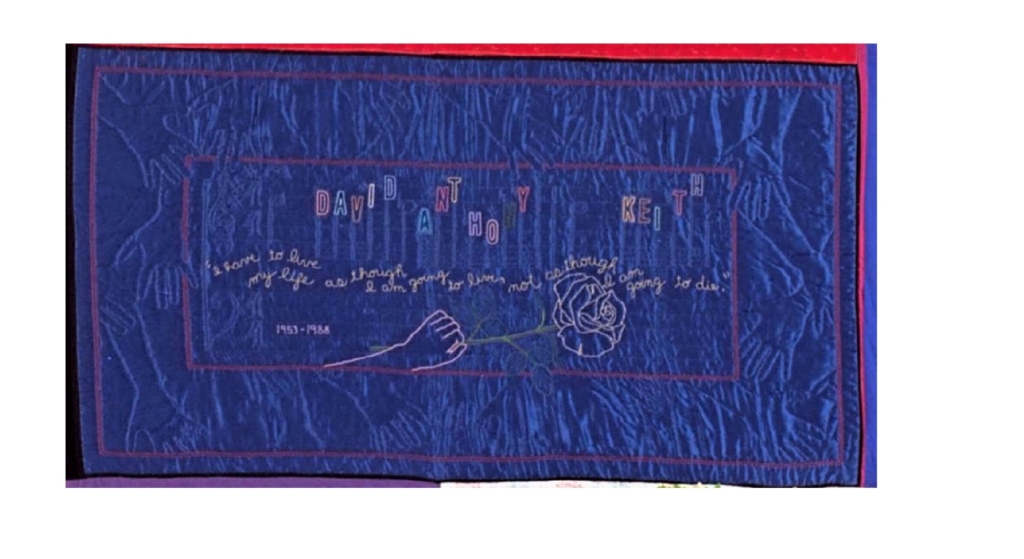
David Anthony Keith, Bay Area concert pianist, dies of AIDS-related illness at the age of 35.
Learn More.* * * * * * * *
Photo of quilt panel from the AIDS Memorial Quilt

Wayland Flowers, best known for creating and voicing the sassy puppet Madame, dies of AIDS-related illness at the age of 48.
Learn More.Wayland Flowers was one of the first openly gay entertainers to find acceptance in mainstream America.
“In an era when even Paul Lynde was still in the closet, Flowers hid nothing,” says Kevin Phinney in his article “This is How Wayland Flowers and Madame Made the ’80s so Gay” in MetroSource.
After refining his act, Flowers’ made a national splash on The Andy Williams Show. From there, Flowers became a regular presence on network TV — although it was not unusual for Madame to get more closeups.
He is best known for the TV series Madame’s Place (1982) and The Hollywood Squares, and also performed in scores of live shows.
Other puppets populated Flowers’ act, but none earned Madame’s notoriety. Among them were a Harlem harlot known as Jiffy, a cranky vaudeville vet named Macklehoney and Crazy Mary, a Bellevue mental hospital escapee.
Sometime in the mid-1980s, Flowers was diagnosed with HIV. He continued to perform until he collapsed onstage during a show at Harrah’s casino in Las Vegas. Eventually, he developed Kaposi’s sarcoma. He made one last visit to his home town in Georgia and then checked into an AIDS treatment facility, the Hughes House hospice center in Los Angeles, where he remained until his death.
* * * * * * * *
Photo of quilt panel from the AIDS Memorial Quilt
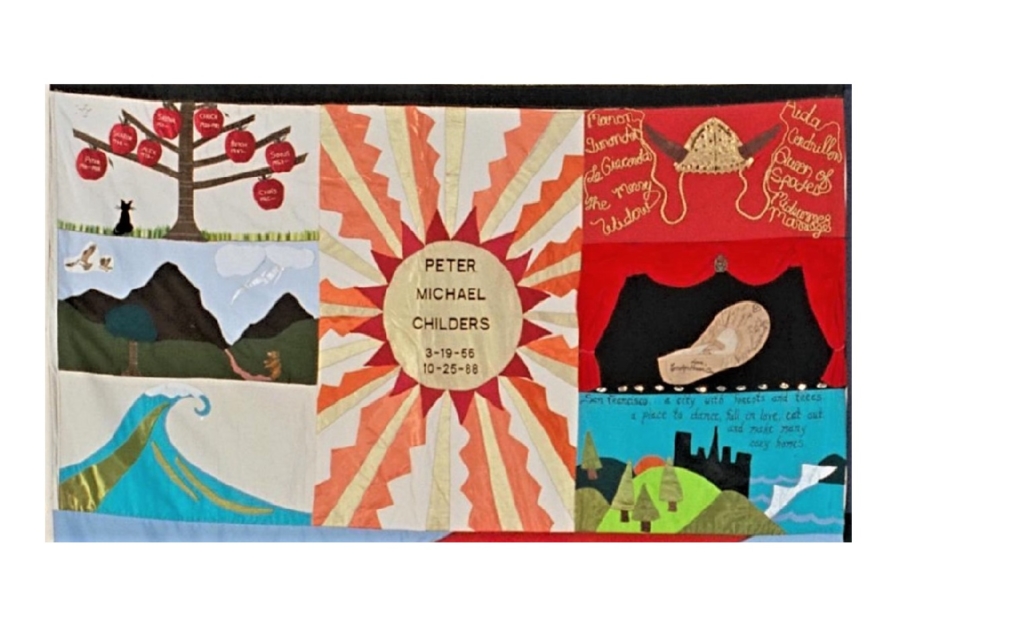
Dancer Peter Childers, who performed with the San Francisco Opera Ballet, dies of AIDS-related illness at the age of 32.
Learn More.* * * * * * * *
Photo of quilt panel from the AIDS Memorial Quilt
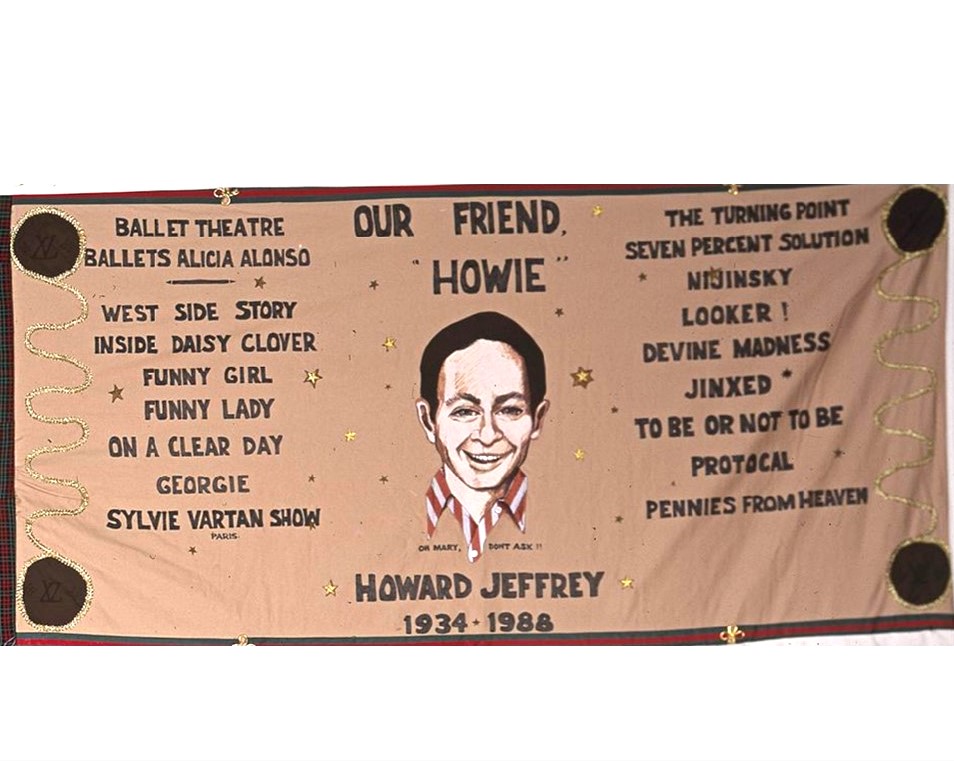
Dancer and choreographer Howard Jeffrey, who worked with Barbra Streisand, Elizabeth Taylor and Natalie Wood, dies of AIDS-related illness in Los Angeles at the age of 53.
Learn More.Known as “Howie” to close friends, Jeffrey danced with American Ballet Theatre and the Ballet Alicia Alonso before assisting Jerome Robbins on the stage and film versions of West Side Story in the 1950s and 1960s, according to Elisa Rolle in LiveJournal.
Jeffrey was the choreographer for Broadway’s Georgy Girl (1970) and the films On a Clear Day You Can See Forever (1970) and Willie Wonka and the Chocolate Factory (1971), according to The New York Times.
He was an associate film producer for The Turning Point, The Seven Percent Solution, and Nijinsky. and went on to produce other films and television programs, according to the Los Angeles Times. He produced two of Bette Midler’s films, Divine Madness and Jinxed, and Mel Brooks’ To Be or Not to Be, according to AP News Service.
Jeffrey was also a much-sought-after dance coach, assisting Natalie Wood in West Side Story (1961), Elizabeth Taylor in Who’s Afraid of Virginia Woolf? (1966), and Barbra Streisand in Funny Girl (1968) and Funny Lady (1975).
Jeffrey was born in Philadelphia, and at the age of 7, moved with his family to Los Angeles, where his mother encouraged him get involved in the entertainment industry. Jeffrey’s first childhood jobs were acting on radio and stage plays. When he was 13, he performed at a dance competition and won a scholarship to Eugene Loring’s American Academy of Dance.
His professional debut was with Alicia Alonzo’s Ballet Theater, touring Europe and South America starting at the age of 18. In the mid 1950s, he moved to New York and danced on and off Broadway.
As a young man, Jeffrey became a close friend of fellow dancer Nora Kaye and eventually Kaye’s husband, who was director-producer Herbert Ross. Jeffrey subsequently assisted Ross in several of his films.
Mart Crowley’s play Boys in the Band was reportedly based on Jeffrey’s birthday party. Two characters are modeled after Jeffery and his roommate Garrett Lewis.
Jeffrey is memorialized in the project Dancers We Lost: Honoring Performers Lost to HIV/AIDS.
* * * * * * * *
Photo of quilt panel from the AIDS Memorial Quilt
John Morris, frontman of the Los Angeles punk band Black Randy and The Metrosquad, dies of AIDS-related illness at the age of 36.
Learn More.
Timothy Patrick Murphy, best known for this role on the prime-time soap opera Dallas during the 1982-83 season, dies of AIDS-related illness in Sherman Oaks, California at the age of 29.
Learn More.On Dallas, Murphy played the part of “Mickey Trotter.” He started his acting career as an adolescent in several television commercials and from there he went on to act in a mini-series called Centennial.
He soon would land more substantial work, including a part in the 1984 inspirational feature film Sam’s Son, the film biography of the life of actor Michael Landon.
Volunteer caregiver Brian Smith recalls visiting with Murphy in 1988 at the Sherman Oaks Medical Center in California.
Smith and Murphy had met in the summer of 1984, and they would talk about “the old times.”
“Sometimes, we would just sit quietly, holding hands, nothing needed to be said,” Smith recalled. “I was blessed with good timing; Tim rarely had other visitors when I was there. Even as his health deteriorated, he kept his winning smile and personality.”
On December 6, 1988, Smith would arrive at the hospital to visit his friend and be informed by “a teary-eyed nursing staff” that Murphy had died that day.
On September 11, 2001, Murphy’s younger brother, Patrick Sean Murphy, would be killed in the World Trade Center attacks.
* * * * * * * *
Photo of quilt panel from the AIDS Memorial Quilt
Duke Armstrong, a lawyer, leather man and Republican Party activist in the Bay Area, dies of AIDS-related illness at Davies Medical Center at the age of 39.
Learn More.Armstrong was president of the Concerned Republicans for Individual Rights (which later became the Log Cabin Republicans) and worked to bridge differences between the GOP and San Francisco’s gay community.
As someone known for prioritizing gay rights above party politics, Armstrong was a well-liked activist even in a locale known as a Democratic Party stronghold. In 1986, Armstrong was elected “Mr. CMC Carnaval” at the Folsom neighborhood street fair. He was a member of the local leather scene, as was his partner Jerry Roberts.
When the City of San Francisco began to take actions toward closing bathhouses, Armstrong teamed with Thomas H. Steel, a prominent civil rights lawyer, to represent San Francisco bathhouse owners who organized against regulation in the early days of the AIDS epidemic. Steel would die on July 18, 1998 of AIDS-related illness at the age of 48.
Earlier in 1988, Armstrong was presented with a Certificate of Honor from the San Francisco Board of Supervisors. He had also been honored by the Golden Gate Business Association and had received several Cable Car Awards for his community service.
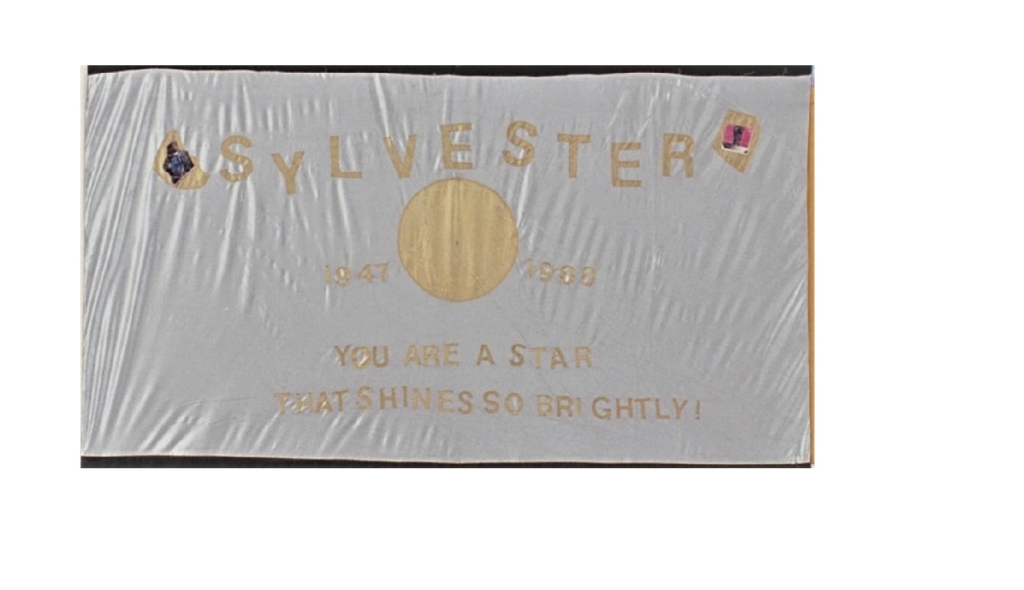
Singer Sylvester dies of AIDS-related illness at age 41. Born Sylvester James, Jr., the black performer is known internationally as “the Queen of Disco.”
Learn More.Famous for his song “You Make Me Feel (Mighty Real),” Sylvester is the lead singer and co-creator of one of the all-time top LGBTQ anthems.
Born in the Los Angeles neighborhood of Watts, Sylvester had been a member of the ’60s group the Disquotays — which was “somewhere between a street gang and a sorority house,” as one former member puts it.
He moved to San Francisco in 1970 at the age of 22 and joined the Cockettes, a “cross-dressing hippy performance art troupe,” and sang blues and jazz standards in his gospel-trained voice in solo segments of the show, writes Alexis Petrides in The Guardian. In the early 70s, he made a bid for mainstream success fronting the Hot Band.
“But the U.S. wasn’t ready for an androgynous black man doing covers of Neil Young songs and A Whiter Shade of Pale,” Petrides writes. “Band members were threatened with violence when they toured in southern states.”
Sylvester’s career was beginning to take hold in 1978, when “Mighty Real” is released on his second solo album and then later as a single. When the song catches fire, he would travel to London to perform to packed clubs and be mobbed by fans. Sylvester would release another 12 albums, many of them featuring top hits and nightclub mainstays. An album containing Sylvester’s final studio recordings, titled Immortal, woud be posthumously released.
Devastated when his partner, Rick Cranmer, died of AIDS-related illness in September 1987, Sylvester suspected then that he was HIV-positive but declined to be tested.
As a persistent cough begins to develop into more serious symptoms, Sylvester is unable to tour but continues performing for fans in the Bay Area. Eventually diagnosed with AIDS, he is hospitalized in May 1988 with pneumocystis pneumonia.
Later in the year, Sylvester attends the Castro’s 1988 Gay Freedom Parade in a wheelchair, joining those marching with the “People With AIDS” banner. Passing crowds along Market Street, Sylvester could hear his name shouted out again and again. He continues to give interviews to the media, seeking to raise awareness about the pandemic’s impact on the black community.
A month later, Sylvester would die in his home at the age of 41. He had planned his own funeral down to the details of how he would be dressed (in a red kimono), how his body would be displayed (in an open coffin), and where the service would be held (in his church, the Love Center, with a sermon by the Reverend Walter Hawkins).
Sylvester’s legacy is such that in 2018, the prestigious University of Sussex in England would host an interdisciplinary academic conference on disco and Sylvester’s contribution to the genre.
* * * * * * * *
Photo of quilt panel from the AIDS Memorial Quilt
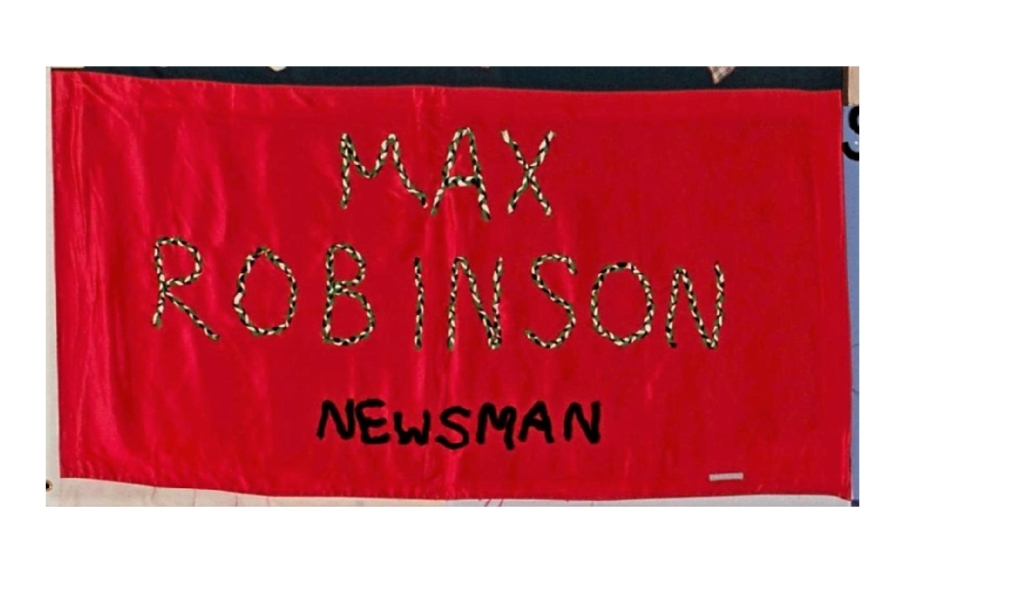
Max Robinson, the first Black network news anchor in the U.S., and a founder of the National Association of Black Journalists, dies of AIDS-related illness at Howard University Hospital in Washington, D.C. He was 49.
Learn More.In July 1978, Robinson rose to national prominence when he became a co-anchor of World News Tonight on the ABC television network. The program had three anchors: Frank Reynolds in Washington, Peter Jennings in London and Robinson in Chicago.
In the early 1970s, Robinson was a co-anchor for the ABC news affililate in Washington, WTOP (now WUSA).
According to The New York Times, Robinson often spoke on issues of concern to him as a Black journalist. Speaking at Smith College in 1981, he told students that the news media were “a crooked mirror” through which “white America views itself,” and that “only by talking about racism, by taking a professional risk, will I take myself out of the mean, racist trap all Black Americans find themselves in.”
Robinson had been ill with AIDS for about a year, his friend Roger Wilkins told the Washington Post.
“During his battle with the disease, Mr. Robinson expressed the desire that his death be the occasion for emphasizing the importance, particularly to the Black community, of education about AIDS and methods for its prevention,” Wilkins said. “More generally, he hoped that people would recognize the urgency of developing effective treatments of the disease and more humane policies towards its victim.”
John Jacob, an acquaintance of Robinson’s and co-chair of the citizens committee on AIDS of New York City and Northern New Jersey, told the Los Angeles Times: “For a long time this disease was seen as a disease of gays. Clearly, there was not the kind of attention given to it that we (Blacks) need to give it. Clearly, drug use is the major factor causing the disease in Black America.”
Jacob said he didn’t know how Robinson was infected with the AIDS virus, and told the LA Times reporter that he should be more focused on raising awareness about the disease.
“I think the one thing we do know is that if you get it, your sentence is death,” Jacob said. “We have to attack this disease whatever the causes are.”
Dr. Beny J. Primm, a member of the President’s AIDS commission and a longtime friend of Robinson’s, also refused to discuss with the LA Times the circumstances under which Robinson got AIDS.
“What’s important,” Dr. Primm said, “is that Max Robinson died of a disease that certainly could have been prevented had certain precautions been taken. I hope he has not died in vain.”
* * * * * * * *
Photo of quilt panel from the AIDS Memorial Quilt
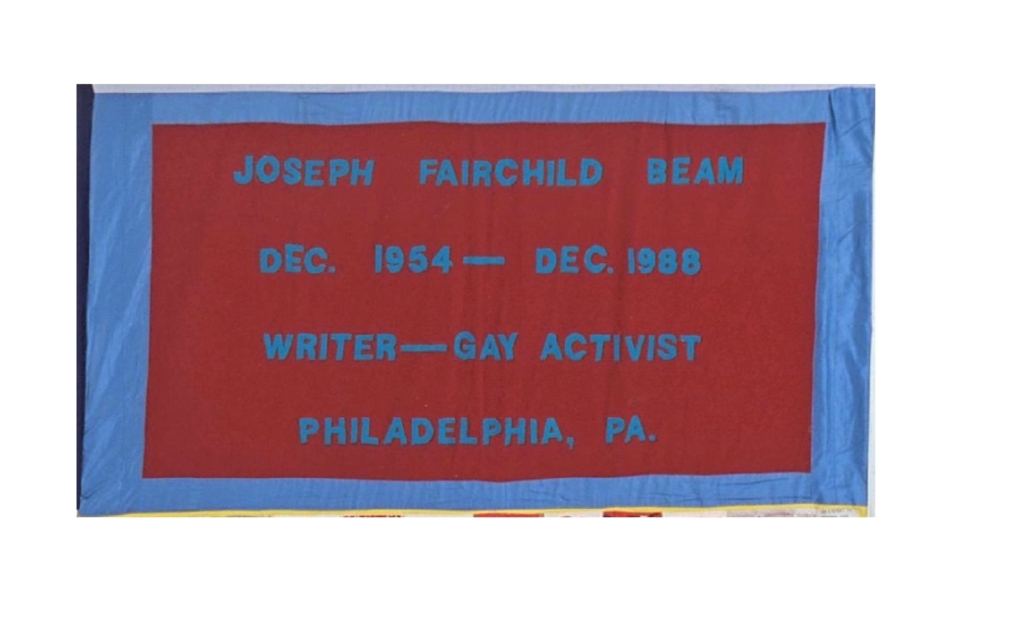
Joseph Beam — best known for editing In the Life, the first collection of writings by gay Black men — dies of AIDS-related illness three days before his 34th birthday.
Learn More.Today, In the Life is widely regarded as a literary and cultural milestone in gay literature.
A native of Philadelphia, Beam attended Franklin College in Indiana, where he studied journalism and was an active member of the black student union and the Black Power movement.
After earning a his master’s degree in communications, Beam returned to Philadelphia in 1979, and explored literature on gay figures and institutions while working at the LGBT bookstore Giovanni’s Room. Discouraged by the lack of community for Black gay men and lesbians, Beam began writing articles and short stories for gay publications.
In 1984, he received an award for outstanding achievement by a minority journalist from The Lesbian and Gay Press Association. In 1985, he became the first editor of Black/Out, a journal produced by the National Coalition of Black Lesbians and Gays.
Beam continued to collect materials about being Black and gay, and find ways to increase their reach. In 1986, he produced the first collection written by Black gay men, called In the Life: A Black Gay Anthology.
When Beam died, he was in the process of compiling the sequel, “Brother to Brother.” His mother, Dorothy Beam, and poet Essex Hemphill would go on to complete the work and publish it in 1991.
* * * * * * * *
Photo of quilt panel from the AIDS Memorial Quilt
Claude Duvall, a Bay Area patron of the arts who personally commissioned works with local composers and artists, dies of AIDS-related illness in San Francisco at the age of 47.
Learn More.A resident of San Francisco since 1973, Duvall founded the Noh Oratorio Society in 1981 to present little-heard musical compositions set to literary works, according to the Bay Area Reporter.
“Unique is the way to describe him,” wrote the Reporter. “No one ever spoke in those tones, dressed as he did, thought along his lines, or carved in the world so special a niche.”
The Noh Oratorio Society flourished in San Francisco during the 1980s, largely due to the dedication and creative direction of Duvall. Not only did he personally commission works for the Society, he served as calligrapher, actor, stage director, and litterateur for various productions. The Society’s wide range of artistic interests was grounded in the importance of the human voice and the use of language.
Among the Society’s productions were Michael McClure’s !The Feast! (1982), Chaucer’s Parlement of Fowles (1987), Edith Sitwell and William Walton’s Façade (1987), and Robert Duncan’s Faust Foutu in 1989. The musical-literary productions were presented in various venues in the Bay Area over the course of 15 years.
In 1987, the Society commissioned a concert of Ladies Voices, an opera set to words by Gertrude Stein with music by Charles Shere. Ladies Voices premeired at the Berkeley Art Center with sopranos Judy Ruth Hubbell and Anna Carol Dudley, and mezzo-soprano Marcia Gronewold.
On behalf of the Society, Duvall also published Noh Quarrter, a short-lived and highly admired literary magazine that promoted poetry, essays, short fiction, and experimental prose that was intended to be read aloud.

Dancer, singer and choreographer James Tyler — who soloed with the Erick Hawkins Dance Company and the Arnie Zane Company — dies of AIDS-related illness at the age of 48.
Learn More.Tyler also co-founded the men’s dance company Mangrove, and worked with Blake Street Hawkeyes and Ruth Zaporah.
* * * * * * * *
Photo of quilt panel from the AIDS Memorial Quilt
The CDC identifies 1,440 AIDS cases among children under 13 years old, of whom 800 have died. Nearly 76% of the pediatric AIDS cases are black and Hispanic.
Reported AIDS cases total 142,000 in 145 countries. However, the World Health Organization estimates that there are as many as 400,000 cases worldwide.

Photographer Robert Mapplethorpe, known for his erotic, sometimes controversial works, dies of AIDS-related illness at the age of 42.
Learn More.In the mid-1970s, as the NYC music scene gave rise to New Wave, Mapplethorpe created austere black-and-white album covers for Patti Smith and the group Television.
He credited his close friend Smith with helping embolden the homosexuality of his early photographic images that dealt with sexual audacity — from sadomasochistic scenes with chains and black leather to an oversized image of male genitals resting atop a pedestal — and that were produced on a large scale.
Soon he would join Andy Warhol’s Interview magazine as a staff photographer, and draw attention for his flattering celebrity portraits.
Despite his diagnosis in 1986 with AIDS, he accelerates his creative efforts, broadens the scope of his photographic inquiry, and accepts increasingly challenging commissions. The Whitney Museum of American Art would mount Mapplethorpe’s first major American museum retrospective in 1988, one year before his death.
The tragic news that Mapplethorpe is ill coincides with the zenith of his critical acclaim as a photographer.
“In my experience, even the most optimistic artists are unable to keep the pain and sadness of AIDS from occasionally surfacing in their art,” writes Paul Martineau, associate curator in the Department of Photographs at the J. Paul Getty Museum.
“Mapplethorpe was no exception,” Martineau continues. “While studying his photographs, I noticed a perceptible shift in the emotional tone of his self-portraits occurred in 1986: the year he was diagnosed with AIDS. In 1988, while the disease wreaked havoc on his body, Mapplethorpe used the camera as a means of taking artistic control over what was happening to him.”
In February 1989, Mapplethorpe would speak openly to Vanity Fair contributor Dominick Dunne.
“I’m quite frustrated I’m not going to be around to enjoy [my success],” Mapplethorpe tells Dunne. “The money’s coming in, though. I’m making more money now than I’ve ever made before.”
In his feature on Mapplethorpe, Dunne writes about how the photographer’s health status had become the topic of speculation in January 1987, when New York aristocrat and art collector Sam Wagstaff died of AIDS-related illness.
“Mapplethorpe, the principal inheritor of Sam Wagstaff’s fortune, had once been Wagstaff’s lover and later, for years, his great and good friend,” Dunne writes.
Mapplethorpe tells Dunne that he has two nurses on twelve-hour shifts that cost him $1,000 a day and he has been on AZT for two years. He expresses concern about friends who are facing the same illness with fewer financial resources, specifically his black friends.
“Most of the blacks don’t have insurance and therefore can’t afford AZT,” he says. “They all died quickly, the blacks. If I go through my Black Book, half of them are dead.”
The year before his death, Mapplethorpe establishes the Robert Mapplethorpe Foundation to protect his work, to advance his creative vision, and to fund HIV/AIDS research. In its early years, the Foundation created medical facilities and programs, including the Robert Mapplethorpe Laboratory for AIDS Research at Harvard Medical School in Boston, the Robert Mapplethorpe Residential Treatment Facility at Beth Israel Medical Center in New York, and the Robert Mapplethorpe Center for HIV Research at St. Vincent’s Hospital, New York.
Serving as the first president on its board of trustees, he established mandates of furthering the recognition of photography as an art form having the same respect as painting and sculpture and supporting AIDS and HIV medical research.
In late winter 1989, Mapplethorpe is in Boston for a medical treatment when his condition worsens, according to Susan Arthur of the Robert Miller Gallery in New York City, which represents the artist.
He died at New England Deaconess Hospital at the age of 42. His body was cremated and his ashes are interred at St. John’s Cemetery, Queens in New York City, at his mother’s grave-site, etched “Maxey.”
In 2011, the Mapplethorpe Foundation would donate its archive to the Getty Research Institute and give a collection of artworks to the J. Paul Getty Museum in partnership with the Los Angeles County Museum of Art.
* * * * * * * *
Photo of quilt panel from the AIDS Memorial Quilt
Richard R. Hamilton, M.D., one of San Francisco’s first openly gay general practitioners, dies of AIDS-related illness at his home in Orange, California. He was 44.
Learn More.Affectionately called “Dr. Dick” by his clients, Dr. Hamilton authored The Herpes Book (1980) and was well-known for his expertise in treating sexually transmitted diseases in gay men. He fostered a professional climate in his office of understanding, acceptance and support, according to the Bay Area Reporter.
When AIDS appeared in the Bay Area, Dr. Hamilton responded by focusing on finding effective treatments for AIDS-related illnesses. He was one of the founding members of the County Community Consortium, an organization of local AIDS care providers. He also was a member of the State of California’s AIDS Advisory Committee and the AIDS Advisory Committee of Pacific Presbyterian Medical Center.
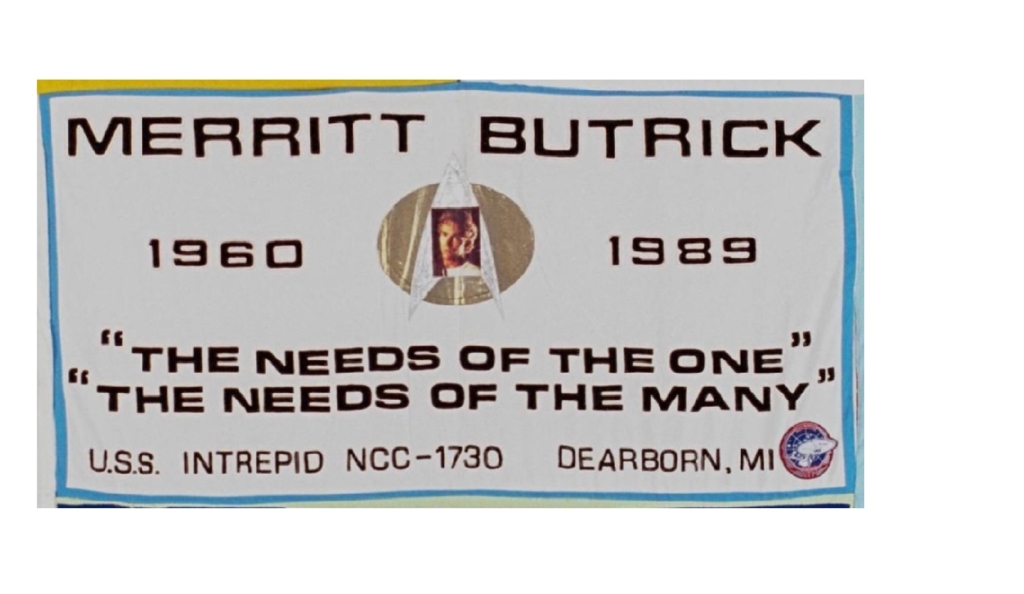
‘Star Trek’ film actor Merritt Butrick dies of AIDS-related illness at the age of 29.
A native of Gainesville, Florida who grew up in the San Fransisco area, Butrick portrayed Dr. David Marcus, son of James T. Kirk and Dr. Carol Marcus, in two movies: Star Trek II: The Wrath of Khan and Star Trek III: The Search for Spock.
“I’m part of a legend,” said Butrick about his work on the Star Trek films. “I gave what I had to give at the right time and place for my own personal gratification. I look at my resume at this point and it reminds me of how well I’ve done in the few years I’ve done it.”
Butrick had just been cast in ST II after starting work as a regular on the short-lived but critical and cult favorite 1982 “new wave” high school series Square Pegs, playing Johnny “Slash” Ulasewicz opposite an equally young Sarah Jessica Parker and Jamie Gertz.
At the time of his death, he had recently received critical praise on stage for his role as a male prostitute in the play Kingfish.
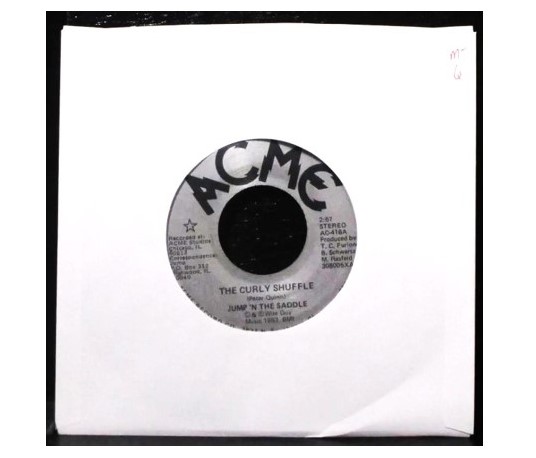
Michael “Mike” Rasfeld, a Chicago recording artist who created the ultimate hang-out for the music community, dies of AIDS-related illness at the age of 37.
Learn More.Rasfeld started the Acme recording studio in 1973, and in the years that followed, he became an important link among people in the Chicago performing arts scene.
“I first met Michael Rasfeld in 1971, when he was running sound and lights for the Godzilla Rainbow Troupe at the old Kingston Mines Theater,” wrote Albert Williams for the Chicago Reader.
An unofficial offshoot of Charles Ludlam’s Ridiculous Theatrical Company in New York, Godzilla Rainbow Troupe was pursuing a pansexual, fantastical, outrageous style of theater and served as a launching pad for several of Chicago’s most distinctive talents.
Rasfeld’s recording studio, located in a storefront in the Lakeview neighborhood, achieved some notoriety in 1983 when it produced the novelty song “The Curly Shuffle” by Jump’n The Saddle.
Rasfeld attended a live show of Jump’n The Saddle, where the audience went wild for their song “The Curly Shuffle.” He offered to record and co-produce the song and release it on Acme Records, according to the Mike Rasfeld website.
Once recorded, Rasfeld pushed “The Curly Shuffle” to Chicago radio stations and almost instantly it became the Number 1 record in the city. By November, it was the Number 15 song in the U.S.
Then Atlantic Records signed Jump’n the Saddle to an album deal, and Acme was booked to work on the album. Rasfeld also went on tour with the band to be their sound technician. But when it became apparent that there were no more novelty hits on the album, Atlantic decided not to promote the tour or the album.
Still, the advance from Atlantic gave Rasfeld some financial relief for his business. Better yet, he was able to bring notable musicians — including Pinetop Perkins, Magic Slim, and Dizzy Gillespie — into Acme to record.
In 1988, Rasfeld invested in CD mastering technology and became the only studio in Chicago able to make the special audio master for CD’s. The same year, he began teaching a recording class at the studio for Columbia College.
That was also the year Rasfeld was diagnosed with AIDS. His last project was a jazz record by veteran Second City music director Fred Kaz.

William Olander, the senior curator at the New Museum of Contemporary Art in New York City, dies of AIDS-related illness in Minneapolis at the age of 38.
Learn More.Olander arrived at the New Museum in 1985, and specialized in performance art and video, especially post-modernist language and theory.
Olander’s 1986 exhibition “Homovideo: Where We are Now” included several videos responding to the spreading of the AIDS virus. In 1987, he invited the group ACT UP (AIDS Coalition to Unleash Power) to present an installation in the museum’s window on Broadway near Prince Street.
ACT UP’s artist group, Gran Fury, responded to the opportunity with “Let the Record Show.” The exhibit juxtaposed information and statistics on AIDS with indifferent, callous or manipulative responses to the epidemic from national figures, all bathed in the glow of a neon sign that proclaimed “SILENCE = DEATH.”
The neon piece became part of the New Museum’s permanent collection, and the SILENCE = DEATH graphic was widely disseminated through t-shirts, wheatpastes, and other printed materials.
In 1988, Olander and three friends founded Visual AIDS, the only contemporary arts organization dedicated to raising AIDS awareness by producing and presenting visual art projects, exhibitions, public forums and publications — while assisting artists living with HIV/AIDS. Visual AIDS was one of the first national initiatives to record the impact of the AIDS pandemic on the artistic community.
Olander lived in New York but had returned to Minneapolis to be with his family during the last months of his life. His longtime companion, Christopher Cox, would die 18 months later, on September 7, 1990.
Olander’s name on the NAMES Project AIDS Memorial Quilt reads: “Let the record show that there are many in the community of art and artists who choose not to be silent in the 1980s.”
To honor Olander’s ongoing legacy, Visual AIDS presents the “Bill Olander Award” annually to artists living with HIV.
* * * * * * * *
Photo of quilt panel from the AIDS Memorial Quilt

Elwood Thornton, a baritone who performed with Oakland Symphony, dies of AIDS-related illness at the age of 45.
Learn More.Thornton also sang with the San Jose Symphony, and performed at the Midsummer Mozart Festival and other local classical music events.
* * * * * * * *
Photo of quilt panel from the AIDS Memorial Quilt
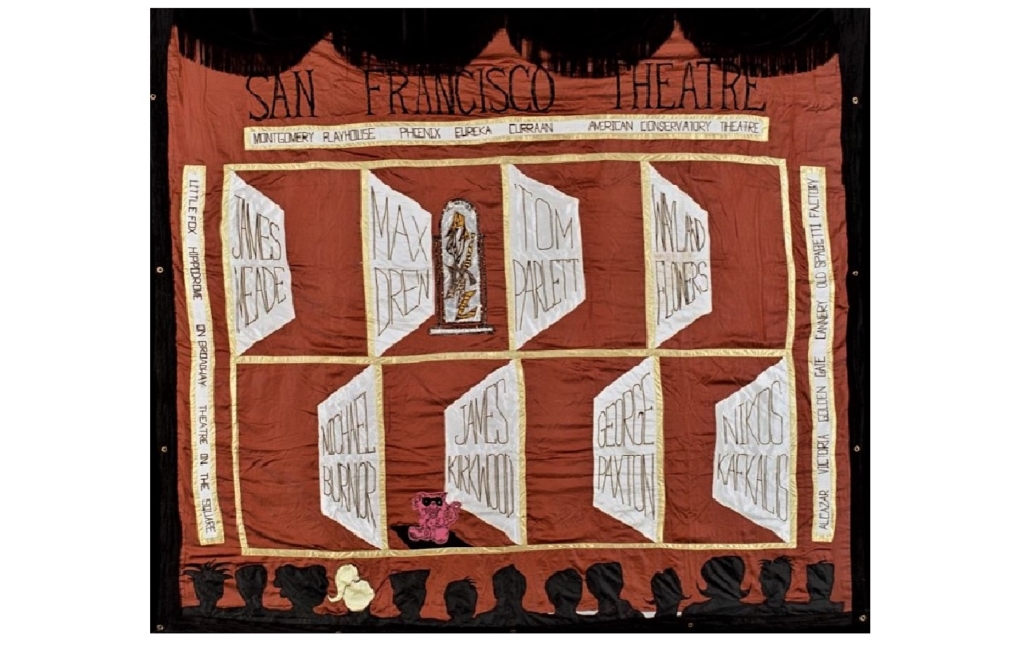
Winner of the Tony Award, the Drama Desk Award for Outstanding Book of a Musical, and the Pulitzer Prize for Drama for the Broadway hit A Chorus Line, James Kirkwood Jr. dies in his Manhattan apartment of AIDS-related illness at the age of 64.
Learn More.Born in 1924 to a Hollywood acting family, Kirkwood followed his parents into show business at the age of 14. He appeared in dozens of plays and films, pausing only to serve a three-year stint in the U.S. Coast Guard. He performed on stage in Panama Hattie and Wonderful Town, and played opposite Tallulah Bankhead in Welcome Darlings. He also had roles in the films Mommie Dearest, Oh, God, Book II, and The Supernaturals.
Together with Nicholas Dante, Kirkwood wrote the text for A Chorus Line (1975), which became one of the longest-running musicals in the history of Broadway. He also wrote the comedy, Legends, in which Mary Martin and Carol Channing toured in 1986 and 1987.
Just before his death, he had finished a nonfiction book about his experiences, entitled Diary of a Mad Playwright.
A memorial service was held for Kirkwood at the Shubert Theater, 225 West 44th Street, on June 1, 1989.
* * * * * * * *
Photo of quilt panel from the AIDS Memorial Quilt
Virgil Pearson-Smith, a dancer with the New York Metropolitan Opera Ballet, dies of AIDS-related illness at the age of 39.
Learn More.Pearson-Smith performed with Dance Spectrum during the 1970s and then moved to New York to perform with the New York Metropolitan Opera Ballet.
In 1981, during the peak of his talent, Pearson-Smith danced in Parade: An Evening of French Music Theater, a ballet choreographed by Grey Veredon to music by Erik Satie.
“Parade must be the most unlikely smash-hit production ever seen at the Metropolitan Opera,” gushed New York magazine.
With sets designed by David Hockney, direction by John Dexter, and performances by a large ensemble cast, the production surprised and thrilled New York audiences.
Pearson-Smith is memorialized in the project Dancers We Lost: Honoring Performers Lost to AIDS/HIV.

Christopher Bernau, who was one of the first openly gay actors in the world of TV soap operas, dies of AIDS-related illness at the age of 49.
Learn More.Most famous for his role as Alan Spaulding on Guiding Light, Bernau delighted audiences with his portrayal of a complex villain with the “vices of the middle class” and “virtues of industrial America.”
Bernau trained in the drama department at the University of California Santa Barbara before getting his big break, appearing in the New York Shakespeare Festival’s 1962 production of Antony and Cleopatra. In 1964, he joined the national tour of Who’s Afraid of Virginia Woolf?
These roles, in addition to performing at Canada’s Stratford Festival, led to an appearance in a story arc on cult Gothic soap opera Dark Shadows from 1969 to 1970. On the show, he created the role of Philip Todd and appeared in 22 episodes.
His most famous role, however, was that of villain Alan Spaulding on the soap opera Guiding Light, a role he played from 1977 to 1984 and again from 1986 until shortly before his death in 1989. Bernau began performing on Guiding Light in 1977 while he was still in the Cherry Lane Theatre production of The Passion of Dracula. In the comic take on the vampire tale, Bernau performed the title role and was credited by The New York Times as achieving “a fine. balance between the awesome and the ridiculous.”
Bernau continued to work on Guiding Light for as long as he could after being diagnosed with AIDS.
Two weeks after his death, cast members held a memorial service for Bernau in Manhattan. On Friday, July 13, 1989, the closing credits of that day’s episode of Guiding Light included a tribute to Bernau and his work.

Geoff Mains — author of Urban Originals, a ground-breaking book about the leather community — dies of AIDS-related illness at Kaiser Hospital in San Francisco at the age of 42.
Learn More.Mains drew on his extensive knowledge of anthropology and human psychology, as well as his own sexual and social experiences, to present a sex-positive and intimate look at the leather community.
“Urban Aboriginals was an instant classic the moment it appeared in the spirng of 1984,” wrote Mark Thompson of Daedalus Publishing, which issued the third edition of book in 2002.
“Its author was a little known Canadian writer, Geoff Mains, who wove an audacious mix of theory and lived experience to explain the gay male leather scene. Mains introduced the notion of endorphins, recently discovered opium-like chemicals in the central nervous system, as a critical component of S/M sexuality. He furthered his insight by linking the social behaviors of this little understood subculture to the tribal rites of indigenous societies around the world. parts biochemistry lesson, anthropological study, and candid journalism, the book opened a gateway of revelation that is still being felt to this day.”
Mains’ prose was illustrated by photographs by Robert Pruzan, who would die on May 29, 1992 of AIDS-related illness at Ralph K. Davies Hospital in San Francisco. Pruzan’s work documented much of the history of San Francisco and its gay life during the idyllic 1970s and the dark years of the 1980s.
After completing Urban Aboriginals in 1984, Mains settled in San Francisco and wrote stories and articles for Drummer magazine. His 1989 novel, Gentle Warriors, would be his final work.
“Mains shed bright and positive light on areas of human experience previously kept in the dark by society’s sexual taboos,” wrote the Bay Area Reporter. “His message has done much to combat the ignorance and fear that cloud issues of radical sexuality, and has brought self-respect, hope and a sense of community to leather-identified people worldwide.”
Prior to settling in San Francisco, he was a faculty member in the Forestry Department of the University of British Columbia. There, he worked closely with environmental groups in Canada and the U.S. He received a doctorate in biochemistry from the University of Toronto.
* * * * * * * *
Photo of quilt panel from the AIDS Memorial Quilt
Stephen D. Hassenfeld, the chief executive officer of Hasbro who restored the company’s reputation as the world’s largest toy manufacturer, dies of HIV-related illness at Columbia Presbyterian Medical Center in New York City. He was 47 years old.
Learn More.Hasbro’s domination of the toy manufacturing field in the 1980s was attributed to Hassenfeld’s aggressive acquisition of other toy manufacturers, such as Milton Bradley, Playskool, Child Guidance toys, and Coleco Industries, the maker of Cabbage Patch dolls.
The company’s success was also based in large part on the success of its G.I Joe line of 3½-inch plastic soldiers and of Transformers, toys that converted from vehicles to robots.
Hassenfeld was the first-born son who became Hasbro’s chief executive after his father died in 1980, according to Family Business magazine. Over the course of a decade, he would build Hasbro into the largest toy manufacturer in the world, rated #1 by Forbes.
“Hasbro had also cultivated the casual culture of a family business in style as well as fact — the kind of company where executives wear open-collared sport shirts to the office, and where employees are invited to Hassenfeld weddings and bar mitzvahs and given financial help for sickness, college bills, or family problems,” wrote Dan Rottenberg of Family Business magazine.
In late July 1987, Hassenfeld’s declining health forced him to miss ten weeks of work, and he did what he could to manage the company from his New York apartment. He returned to the office in October, announcing that he had endocarditis, a heart condition, and was fully recovered.
Over the course of the next year, however, Hassenfeld took steps to protect the company in the event that he should die. Most significantly, Hassenfeld and his brother Alan reorganized the company’s management structure in December 1988, just six months before Hassenfeld’s death.
When Hassenfeld was hospitalized in May 1989, Hasbro stock shot up in heavy trading amid rumors that the company would be sold. Alan Hassenfeld summoned an emergency board meeting and vowed to maintain the company’s family identity, according to Family Business magazine.
Within two weeks of Stephen Hassenfeld’s death, the board elected Alan to succeed him as chairman and CEO.
“My brother taught me a lot — probably almost everything I know about this business,” Alan told Family Business magazine. “This isn’t meant to sound hokey, but many times if I’m trying to think a situation out, I’ll still sit and talk to my brother. In some cases, I don’t totally admit that my brother’s not here.”
Stephen Hassenfeld’s legacy continues with the charitable organizations he established during his lifetime: the Hasbro Charitable Trust, Hasbro Children’s Foundation, and the Stephen D. Hassenfeld Children’s Center for Cancer and Blood Disorders, according to Ken Gault of Think Queerly.

Steve Rubell, co-founder of the world-famous Studio 54 nightclub, dies at Beth Israel Medical Center in New York at the age of 45.
Learn More.Owning and operating Studio 54 in Manhattan from its opening on April 26, 1977 until 1979, Rubell and his business partner Ian Schrager hosted celebrities, society figures and crowds of clubbers. The nightclub became the global epicenter of the disco craze and featured live appearances by music stars like Grace Jones, Donna Summer and Gloria Gaynor.
The venue’s location at 254 West 54th Street was an opera house in the 1920s, and then became a television studio in the 1950s and 1960s, housing productions of the game show Password and the children’s show Captain Kangaroo.
The space was converted into the world’s most famous nightclub by Rubell and Schrager, who met while attending Syracuse University. Behind the scenes, public relations expert Carmen D’Alessio lured celebrities she knew from the fashion industry to come to Studio 54 and play. With connections like Bianca Jagger, Liza Minnelli, Andy Warhol and Truman Capote, D’Alessio built a buzz around the club that drew attention from the media and throngs of young people hoping to cross the velvet ropes into a world where anything could happen.
Rubell often worked the club’s front door, selectively admitting celebrities and spurning others queued outside. In January 1980, Mr. Rubell and Schrager were sentenced to 3½ years in prison for tax evasion, but they reduced their sentences by turning in several other club owners. They sold Studio 54 shortly after their release from prison in January 1991, and then opened a new club, the Palladium, which would become just as popular.
In the film Studio 54 The Documentary, Rubell’s brother, Dr. Donald Rubell, said, “I was the one who told him he had AIDS.”
Dr. Rubell recalled that his brother had “vague symptoms” of HIV infection, and so he administered the test.
“You have to remember at that time AIDS wasn’t a disease,” he says. “It was a condemnation. So he wouldn’t let me tell our parents.”
Rubell’s funeral at the Riverside Chapel on Amsterdam Avenue and 76th Street would be attended by some of his most famous patrons, including Calvin Klein and Keith Haring. His body is buried at Beth Moses Cemetery in Farmingdale, New York.
* * * * * * * *
Photo of quilt panel from the AIDS Memorial Quilt
Sources:
History.com / A&E Television Networks
The New York Times
The Washington Post
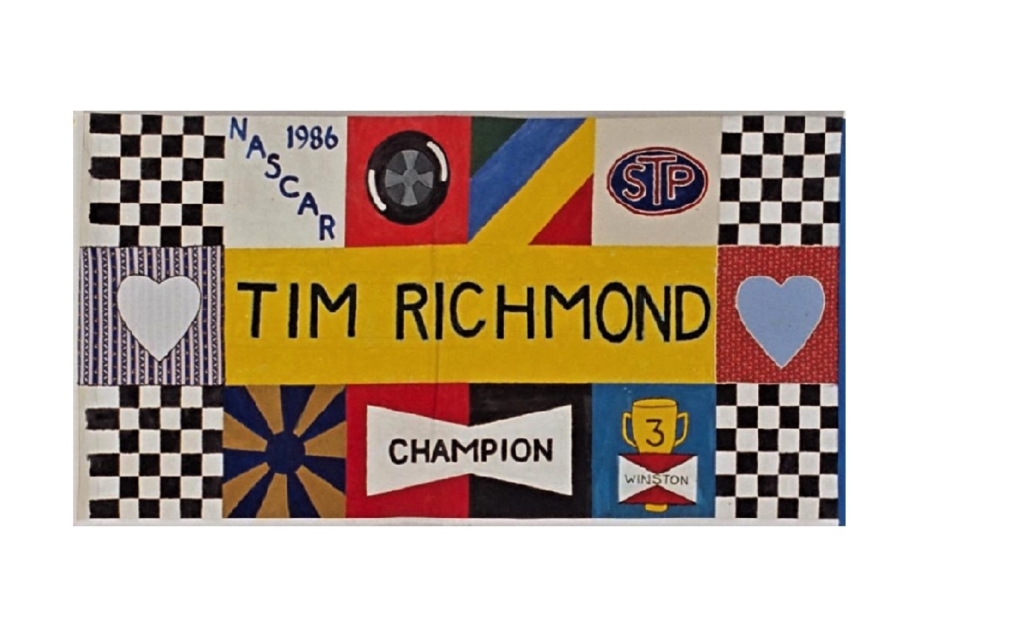
Race car driver Tim Richmond dies of AID-related illness at the age of 34.
Learn More.One of auto racing’s brightest stars, Richmond is the inspiration behind much of the film Days of Thunder, starring Tom Cruise.
The 1980 Indianapolis 500 rookie of the year, Richmond was involved in an Indy car crash where his car was sliced in two at Michigan International Speedway, and was persuaded to switch to stock cars. By 1986, Richmond would win seven races in three months.
Shortly after his most victorious season, Richmond would suffer a near-fatal bout of pneumonia and receive a diagnosis of HIV-positive. Still, Richmond would regain his health enough in 1987 to return to NASCAR for an eight-race run that brought him wins at Pocono and Riverside, California.
Unaware of his illness, other drivers accused Richmond of being a drug user and persuaded NASCAR to test him. When drug tests were inconclusive, NASCAR asked to see Richmond’s medical records. Richmond refused and filed a defamation suit against NASCAR that was settled out of court when it was ruled that his medical records were relevant to the case.
In 1988, NASCAR would suspend Richmond for what the organization said was violation of its drug policy. Although NASCAR later lifted the ban, Richmond would never drive again.
According to the film Tim Richmond: To the Limit, Richmond spent his final days in seclusion. After Richmond’s death, numerous women would claim that he infected them with the AIDS virus.
* * * * * * * *
Photo of quilt panel from the AIDS Memorial Quilt
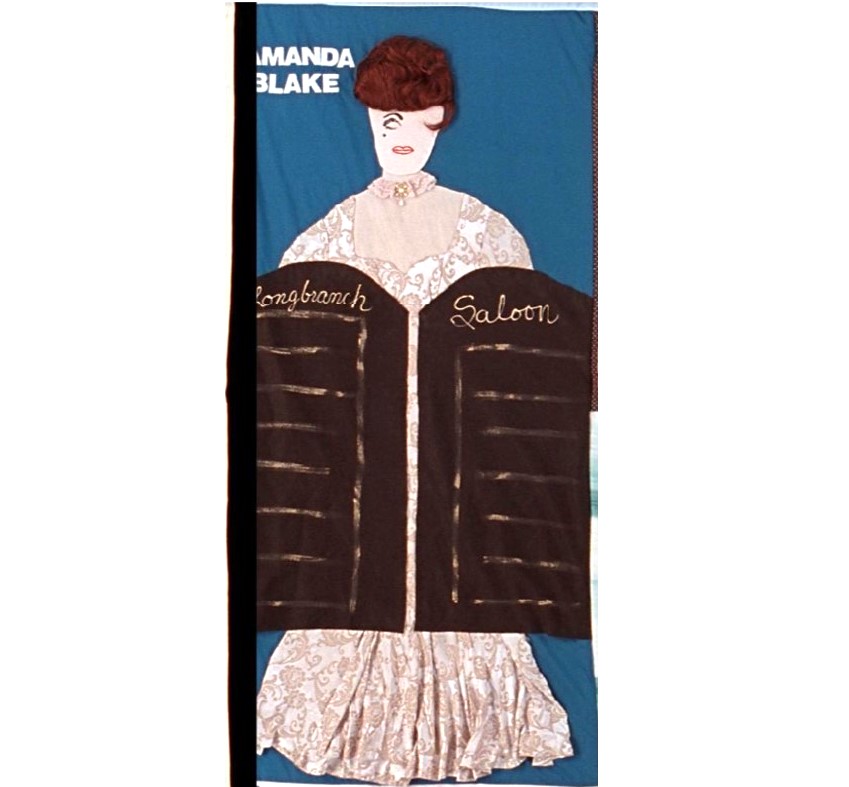
Actress Amanda Blake, best known for the TV role of the red-haired saloon proprietress “Miss Kitty Russell” on Gunsmoke, dies of AIDS-related illness at Mercy General Hospital in Sacramento. She was 60.
Learn More.Blake, who was born Beverly Louise Neill in 1929, had suffered from AIDS symptoms for about a year. Her doctor, Lou Nishimura, M.D., told the New York Times that he did not know how she had contracted the disease.
Although Dr. Nishimura listed AIDS as the cause of Blake’s death, it was not made public. When when Blake’s will declared her entire estate, $400,000, be given to the non-profit organization PAWS (Performing Animal Welfare Society), members of Blake’s family contested the will in court and tried to prove Blake was mentally incompetent.
Pat Derby, who oversaw the PAWS preserve in Sacramento for unwanted performing animals, feared that the legal fight would cause the true circumstances of Blake’s death to be twisted in the media, so she released the AIDS story herself to People magazine.
The year before her death, Blake moved to the 20-acre animal preserve to live with Derby and devote her life to working with their animals.
* * * * * * * *
Photo of quilt panel from the AIDS Memorial Quilt
CDC reports that the number of reported AIDS cases in the United States has reached 100,000.

Angel Estrada, a Spanish-born designer whose label featured glamorous gowns, dies of AIDS-related illness in Manhattan at the age of 31.
Learn More.Estrada started his clothing label in 1983, after his designs for his sister became covetted items in the NYC nightlife scene,
Estrada’s aesthetic was to combine a simple, form-fitting silhouete with bold details. His clothes were sold in stores such as Bergdorfs and Saks at prices ranging from $800 to $2,000. His first collection appeared on the cover of the November 1986 issue of Vogue.
Born in Barcelona, Estrada moved to New York with his family when he was three years old. He attended the Parsons School of Design and worked part time as a hair and make-up designer until he was able to set up his own business.
After Estrada’s death, his sister Virginia took over his business, assumed the design responsibilities. The Angel Estrada brand, which had focused on custom-made evening dresses, transitioned to a sportswear line and also entered a licensing arrangement with a Japanese company, Kindwear, to make clothing in Japan.
* * * * * * * *
Photo of quilt panel from the AIDS Memorial Quilt
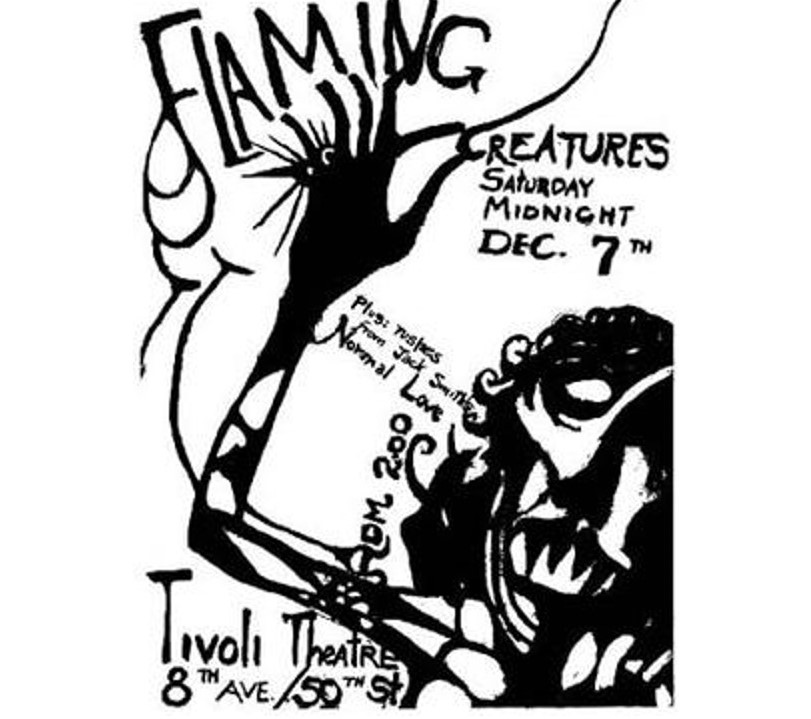
Jack Smith, a pioneer of underground cinema and the director/ cinematographer of Flaming Creatures, dies of AIDS-related illness at Beth Israel Hospital in Manhattan. He was 57.
Learn More.Smith was considered by many to be the founding father of performance art, and was recognized as a master photographer. The most famous of Smith’s works is Flaming Creatures (1963), a film that prompted a series of New York Police Department raids on downtown screenings of the 45-minute film.
During a screening of Flaming Creatures on March 3, 1964, police seized the 16mm print and the projection equipment, and arrested event producer Jonas Mekas, theater manager Ken Jacobs and ticket taker Florence Karpf on charges of obscenity.
In the trial that followed, esteemed writer Susan Sontag would testify on behalf of the defense to the film’s status as a work of art. Sontag saw Flaming Creatures as an intentionally outrageous and funny spoof of Hollywood B movies, but she also insisted that the film was “a small but valuable work in a particular tradition, the poetic cinema of shock.”
”The only thing to be regretted about the close-ups of limp penises and bouncing breasts, the shots of masturbation and oral sexuality, in Jack Smith’s Flaming Creatures is that it makes it hard simply to talk about this remarkable and beautiful film, one has to defend it,” Sontag wrote in the April 13, 1964 issue of The Nation.
However, New York officials considered some scenes to be pornographic and copies of the 45-minute movie were confiscated wherever it was screened. The movie gained additional notoriety when footage was screened during Congressional hearings and right-wing politician Strom Thurmond mentioned it in anti-porn speeches.
“The case remains one of the most notorious public battles over artistic freedom of expression in American movies,” wrote Michael Koresky for the Lincoln Center’s Film Comment.
Filmed on the roof of Smith’s Loisaida studio apartment with reportedly stolen film stock and a basic 16mm camera, Flaming Creatures represented the independent spirit of The New American Cinema.
Film Affinity USA/UK wrote: “The orgy scene in the film is perhaps the greatest combination of art and film. [It] plays like a tragic meeting of the old America with the freshly birthed new morality in America. What is even more remarkable is the ‘earthquake’ caused by Smith’s shaking camera at the end of the orgy. It is as if the world is opening up on Smith’s creatures and swallowing them and all their perversions. The spirit of the film is the reason it should be preserved for generations to come.”
Apart from filmmaking and occasionally appearing in his own work, Smith worked as an actor. He played the lead in Andy Warhol’s unfinished film Batman Dracula, Ken Jacob’s Blonde Cobra, and appeared in several theater productions by Robert Wilson. He also worked as a photographer and founded the Hyperbole Photographic Studio in New York.
After his last film, No President (1967), Smith turned his attention to performance art. He also spent the months leading up to his death transforming his home into an elaborate stage set for a never-to-be-filmed work, Sinbad in a Rented World.
About a month after Smith’s death, friends held a memorial service at Performance Space 122 in the East Village.
New York performance artist and AIDS activist Penny Arcade tried to preserve Smith’s apartment as a museum dedicated to Smith and his work, but the effort failed. Smith’s archival works were legally awarded to his estranged sister and ultimately purchased by the Gladstone Gallery in New York
Kenneth J. Lackey, film critic for Drummer magazine, dies of AIDS-related illness at San Francisco’s Hospice By The Bay at the age of 35.
Learn More.By day, Lackey was on the editorial staff of Desmodus Inc., publishers of Drummer. By night, he was the star server at Church Street Station, charming the after-bar crowds and taking dozens of meal orders without writing anything down and never making a mistake.
Lackey also had an amazing memory for film trivia, according to the Bay Area Reporter.
“If you ever had a question about a film, a star, a producer or director (including Oscar, Emmy, Grammy and Tony Award winners), Ken was the man to ask, including a biographical sketch thrown in for good measure!” wrote the Bay Area Reporter.
Prior to moving to San Francisco, Lackey attended George Washington University, where he studied theater, and worked as a model in New York.
Paul Shenar, best remembered for his performance as the drug lord Alejandro Sosa in Scarface, dies of AIDS-related illness at the age of 53.
Learn More.Born and raised in Milwaukee, Wisconsin, Shenar moved to New York City after graduating from the University of Wisconsin. He debuts on Broadway in Tiny Alice as Brother Julian, and continues to work on the NYC stage for several years.
In 1965, Shenar would move to Philadelphia to help found the American Conservatory Theater, where he is not only a regular performer throughout his career, but a teacher and advisor as well.
From there, roles on television and the big screen would follow. In 1975, Shenar portrays Orson Welles in the television movie The Night That Panicked America, receiving received some of the best reviews of his career. He continues working steadily on television through the end of the decade, and in the early 1980s starts receiving feature film roles.
In 1983, Shenar delivers a memorable performance as the diabolical Colombian drug lord Alejandro Sosa in Brian De Palma’s Scarface. Other notable roles are Dr. Lawrence in Luc Besson’s The Big Blue (1988), Joshua Adams in Deadly Force (1983), Paulo Rocca in the Arnold Schwarzenegger film Raw Deal (1986), and Ben Gardner, the father of a troubled Kristy McNichol, in Alan J. Pakula’s Dream Lover (1986).
Shenar would die in West Hollywood.
Critically acclaimed actor Michael Carmine dies of AIDS-related illness at his home in Manhattan. He was 30 years old.
Learn More.Born in Brooklyn, Carmine graduated at the age of 16 from the High School for the Performing Arts in 1975, and then attended the California Institute for the Arts.
Carmine won critics’ praise for his performance in Off Broadway and Broadway productions of Reinaldo Povod’s play Cuba and His Teddy Bear. He created the role of Papo in another Povod play, La Puta Vida.
Among his screen credits are Batteries Not Included, Scarface and Turk 182; on television, he appeared in episodes of Search for Tomorrow, Hill Street Blues, M*A*S*H, and Miami Vice. His final TV appearance was in 1988’s Tour of Duty, and his final film role in Longtime Companion was released nearly a year after his death.

Alan Murphy, a U.K. guitarist with a long pedigree of contributions to new wave bands, dies of AIDS-related illness at Westminster Hospital. He was 35.
Learn More.Murphy played guitar with Kate Bush, Go West, Mike + the Mechanics, and Level 42, among many others.
Murphy’s big break came in late 1978, when he was invited to audition for the Kate Bush band as a second guitarist for an upcoming tour. He was nervous, according to the Alan Murphy tribute site, because he wasn’t familiar with Kate Bush’s quirky musical style.
“Alan was offered the job, mainly he felt due to Kate being impressed with the way he made whale noises,” according to Lenny P.
After touring in 1979 with Kate Bush, Murphy joined her in the studio to record tracks for Never for Ever (1980). This was the first album he had worked on as a full-fledged band member and not just a studio musician.
Murphy also formed a band called The Stapleton All Stars, named after a London pub called The Stapleton. They later changed the name to SFX. The Fender guitar company arranged for the band to play their products during pub promotions from 1981 to 1983.
In 1984, Murphy performed a guitar solo on Nick Heyward’s single “Warning Sign.” Next, Peter Cox and Richard Drummie formed Go West and brought in Murphy to help them build their sound. Chrysalis released Go West’s eponymous 1985 album and Daning on the Couch (1987). On the latter release, Murphy played keyboards, guitars, guitar solos, percussion on various tracks.
While touring in the U.S. with Go West, Murphy began to feel fatigued and sought medical care at a stop-over in San Francisco. Go West front man Peter Cox later realized that it was at that time when Murphy likely learned he was HIV positive.
In 1987, Murphy joined Level 42 — already an established act on the Polydor label — and performed on the 1988 album Staring At The Sun, which was recorded at Miraval studios in France.
“We had a new album, a hit single with ‘Heaven In Our Hands,’ and it all looked like business as usual, but with a slightly rockier edge,” Level 42 bass guitarist Mark King told The Express in 2016.
“But then, sadly, within 18 months Al Murphy became ill with AIDS and died in 1989. It was awful.”
Shortly before his death, Murphy played acoustic guitar on a Kate Bush cover of the Elton John/Bernie Taupin hit “Rocket Man,” and in 1991 it was released as a track on Two Rooms, a John/Taupin tribute album. The music video featured a guitar and lit candle on an otherwise empty chair.

Cynthia Slater, co-founder of the leather/SM organization Society of Janus, dies of AIDS-related illness at Pacific Presbyterian Hospital in San Francisco. She was 44 years old.
Learn More.A few months before she died, Slater received an award from Shanti Project, which recognized her for her AIDS activism on behalf of women with AIDS/HIV specifically and all people with AIDS generally.
Before Slater became an AIDS activist, she stirred up controversary as the founder of Society of Janus, the still-active leather/BDSM organization that often rattled anti-pornography feminists and the religious right during the 1970s and early 1980s.
While working as a dominatrix in the early ’70s, a client’s spouse asked Slater for more information about her husband’s interest in BDSM. Sensing that there might be a widespread interest in such things, Slater and her partner, Larry Olsen, started the first version of the Society of Janus in 1972 by running a classified ad in the back of a counter-culture newspaper, The Berkeley Barb.
Ten people showed up for the first meeting of what would become the Society of Janus, and Slater said she was excited about connecting with others who shared interests that until then had been kept secret.
“There was this isolation pressing in on me, and I felt the need to get together with people with whom I could exchange information, and get a little support from besides,” said Slater in an 1983 interview.
According to the Leather Hall of Fame, Slater did almost all of the work in the first phase of the organization. She published out a newsletter, held meetings at her home, provided food, and cleaned up after. As Janus took shape, Slater developed an approach to the theory and practice of SM.
As an early proponent of SM safety, she hosted Janus Society safety demonstrations during the late ’70s, cultivating a space for women within the male-dominated scene established within the leather/kink/fetish culture. According a tribute to Slater in Living in Leather’s website, Slater coined the term “SM 101,” referring to the safety demonstrations and classes she presented.
While most of her activities were local, Slater influenced many people who became active safer-sex education. Slater’s teachings, ideas, and lessons were re-created by others at regional and national organizations, especially in the late 1980s as the AIDS epidemic spread.
Slater was well-known in many of the Bay Area’s fringe communities, and in 1980, she was photographed by Robert Mapplethorpe. When safe sex education was being developed by gay communities in the early 1980s, Slater and bisexual activist David Lourea visited presented bathhouses and sex clubs in San Francisco to present safer-sex education workshops.
In 1985, Slater learned she was HIV+ and she was diagnosed with AIDS in 1987. During this period, she became more involved with Shanti Project and began attending support groups. She wrote an article for Shanti’s newsletter encouraging PWAs to not remain isolated or seek “sameness” when it came to getting support.
In her article, Slater noted that while not faulting PWAs for doing so, there is a risk of eliminating others “until we end up an association of one.”
Even when tending to her declining health, Slater continued to advocate for other PWAs to connect across difference and find commonality among people with diverging agendas. She also fought to bring attention to the lack of resources for women living with AIDS/HIV in San Francisco. Despite the city’s reputation for being the leading place for compassionate care for PWAs, women were often overlooked by outreach efforts and service programs.
In an 1989 television interview about her award from Shanti Project, Slater told reporters: “The numbers [of women with AIDS] are changing … and it’s a discounting the value of individuals. How many women have to die before we start to count?”
In her article for the Shanti PWA newsletter, Slater wrote:
“We who are facing life-threatening illness also find ourselves examining issues that most folks don’t readily look at: ‘What is death?’ ‘What does my life mean?’ ‘Who am I?’ ‘What do I really need and is that different from what I want?’
“In our support group, it’s not so much that the questions we ask are the same as it is that we share an awareness that we don’t seem to have forever for the exploration. These bonds are the earth of our common meeting ground … We have no basis on which to stigmatize each other, for when we do so we are oppressing ourselves.”
In 2014, Slater was posthumously inducted into the Leather Hall of Fame. In 2017, Slater was honored at the San Francisco South of Market Leather History Alley, where her boot prints are immortalized alongside 27 other important figures in San Francisco alternative culture history.
* * * * * * * *
Photo of quilt panel from the AIDS Memorial Quilt
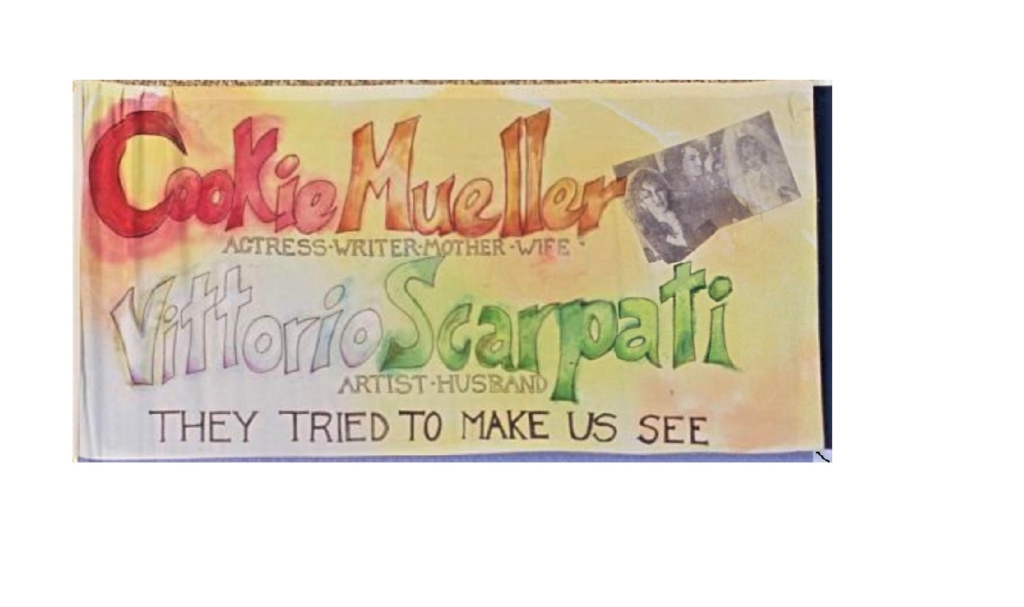
Cookie Mueller, a key member of film director John Waters’ Dreamlanders ensemble, dies from AIDS-related causes in New York City at age 40.
Learn More.Mueller would meet John Waters at the premiere of his 1969 film Mondo Trasho. Cookie went on to join Waters’ Dreamlanders ensemble and would act in five movies for Waters.
Moving to New York City in 1976, she became a cocaine dealer and writer. She wrote the health column “Ask Dr. Mueller” for the East Village Eye, was an art critic for Details magazine, and wrote the novella Fan Mail, Frank Letters, and Crank Calls, the memoir Walking Through Clear Water in a Pool Painted Black, and several collections of short prose.
Mueller became a muse to many of the photographers and directors of the NYC art/music/film scene. She would have her portrait taken by Robert Mapplethorpe, and appear in Amos Poe’s Subway Riders, Edo Bertoglio’s Downtown ’81 and Michel Auder’s A Coupla White Faggots Sitting Around Talking. She also would be featured prominently in her friend Nan Goldin’s iconic The Ballad of Sexual Dependency.
Goldin would later recall that she was with Mueller on Fire Island in New York when they first learned of AIDS in 1981, referred to as a “gay cancer” at the time. “Cookie just started reading this item out loud from The New York Times about this new illness… we all kind of laughed it off.”
By 1985, many of Golden’s close friends and acquaintances would be diagnosed with the virus, including Mueller.
Goldin would write in ASX: “We were very obsessed with what caused it: There were all kinds of rumors, everything from amyl nitrate to bacon. I was in denial that people were going to die. I thought people could beat it. And then people started dying.”
In 1986, Goldin would photograph Mueller’s wedding to Vittorio Scarpati. An artist who was an HIV-positive heroin addict, Scarpati would create a heartbreaking series of whimsical deathbed drawings of himself and Mueller.
Scarpati would die in 1988, and Goldin would photograph Mueller, by that time walking with a cane, beside her husband’s casket. After Scarpati’s death, Mueller’s health would begin a steep decline.
“When I went to see Cookie in Provincetown, she had lost her voice,” recalls Goldin. “Her laughter and her verbal wit had been so much of her personality. The fact that she couldn’t talk, the fact that she couldn’t walk without a cane was so devastating that I was calling every doctor, screaming at the impotence I felt.”
Shortly before her dealth, Mueller would write in her final column for the East Village Eye:
“Fortunately I am not the first person to tell you that you will never die. You simply lose your body. You will be the same, except you won’t have to worry about rent or mortgages or fashionable clothes. You will be released from sexual obsessions. You will not have drug addictions. You will not need alcohol. You will not have to worry about cellulite or cigarettes or cancer or AIDS or venereal disease. You will be free.”
* * * * * * * *
Photo of quilt panel from the AIDS Memorial Quilt
La Cage aux Folles actor Rémi Laurent dies of AIDS-related illness in Paris at the age of 32.
Learn More.Born and raised in Suresnes, Laurent starred in a number of French films in the late 1970s and 1980s, but he is best known for his role in the film La Cage aux Folles as Laurent, the son of Renato Baldi.
Laurent also had roles in Les Plouffe (1981) and Let’s Get Those English Girls (1976).
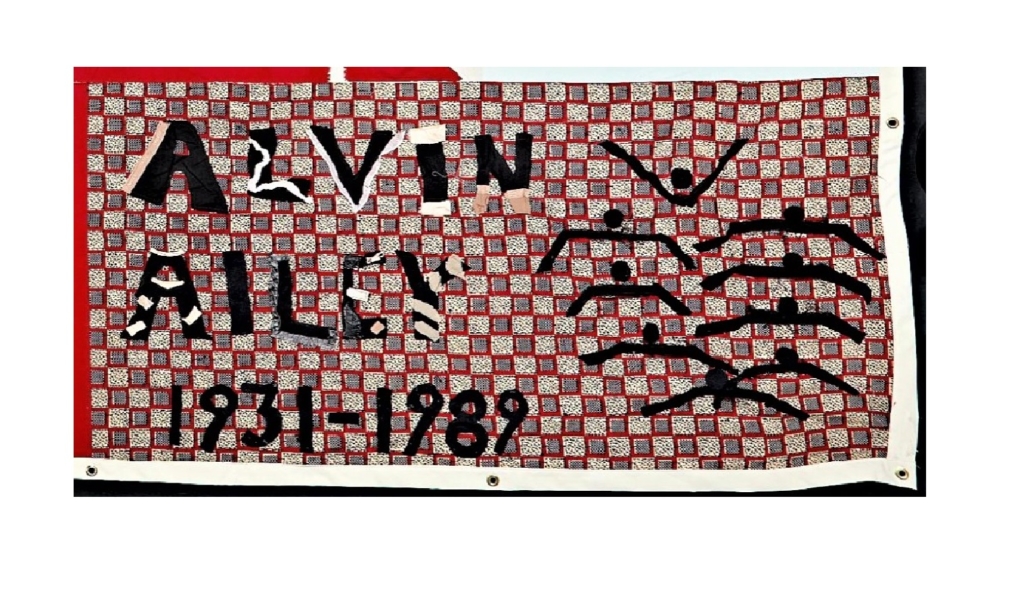
Alvin Ailey, the African American choreographer and activist who founded the Alvin Ailey American Dance Theater and the Ailey School in New York City, dies of AIDS-related illness.
Learn More.Ailey’s early childhood would be spent in Texas during the Jim Crow era, a time and place that would inspire some of his most iconic choreography. He discovered dance after moving to Los Angeles but didn’t fully commit to the art form at first.
Then, in the mid-1950s, Ailey would join the Lester Horton Dancers, later becoming a choreographer and then director of the company. In 1958, he decided to open his own dance company, establishing the Alvin Ailey American Dance Theater in New York City.
Ailey and a group of young, black modern dancers perform for the first time on March 30, 1958 at New York’s 92nd Street YM-YWHA. In its first years, the Company would travel to booked performances on what Alvin Ailey called “the station wagon tours” in a vehicle driven by a longtime friend of the Company, Mickey Board.
In 1960, he would choreograph his classic masterpiece Revelations, which brings the Company international acclaim.
Over the next 30 years, Ailey would create ballets for many notable companies, including the American Ballet Theatre, Royal Danish Ballet, London Festival Ballet, the Joffrey Ballet, and Paris Opera Ballet.
“As common practice at the time, Ailey maintained a closeted persona regarding his sexuality but would utilize his art as an outlet for it,” writes Smithsonian in the website for the National Museum of African American History & Culture.
“His choreographed ballets for AAADT exhibited imagery reminiscent with male and female homosexuality such as juxtaposing same-sex partnering with religious and hypermasculine archetypes.”
Although Ailey dated intermittently, he wouldn’t find long-term companionship while trying to conceal his sexuality from much of the world. And when he dies amid the AIDS epidemic, his doctor reports the cause of his death as a rare blood disease.
Among the many posthumous accolades for Ailey, President Barack Obama would award him the Presidential Medal of Freedom in 2014, the highest civilian honor, in recognition of his contributions and commitments to civil rights and dance in America.
“Ailey’s work was groundbreaking in its exploration of the African American experience and the enrichment of the modern dance tradition, including his beloved American masterpiece Revelations,” the award description would state.
The Ailey company continues to perform at the New York City Center and tours cities around the world. Ailey’s masterpiece, Revelations, is currently streaming on the dance company’s website.
* * * * * * * *
Photo of quilt panel from the AIDS Memorial Quilt
Gary Tucker, an influential member of Chicago’s theater community, dies of AIDS-related illness in Atlanta. He was 42.
Learn More.Tucker directed Tennessee Williams’ A House Not Meant to Stand for the Goodman Theatre’s 1980-1981 season.
Williams wrote the play — which turned out to be his last — after Tucker and Goodman artistic director Gregory Mosher worked with him on producing a one-act titled Some Problems for the Moose Lodge. Tucker and Mosher urged Williams to expand the one-act into a full-length play, and the result was A House Not Meant to Stand.
“To many of us, Gary Tucker will always be remembered for his work in less illustrious company and circumstances,” Albert Williams wrote in the Chicago Reader. “Under the name Eleven, he founded and directed the Godzilla Rainbow Troupe, with which [Tommy] Biscotto, [J Pat] Miller, [Mike] Rasfeld, and others did some of their earliest and best work.”
An unofficial offshoot of Charles Ludlam’s Ridiculous Theatrical Company in New York, Godzilla Rainbow Troupe lived up to its name, according to Williams.
“It was monstrous and beautiful; it breathed fire and gave off a glowing wet afterglow; it had a hell of an impact, and it was gone almost as soon as it had started,” write Williams. “In such productions as Whores of Babylon, Turds in Hell, and Tobacco Road, Tucker brought ‘genderfuck’ (aka ‘cosmic drag’) theater to Chicago, mixing and matching sexual identities with a whimsical disregard for propriety or credibility. It was gaudy, cheap, funny, sad, coarse, delicate. Just like Gary Tucker. May he rest in peace.”
Biscotto, Miller and Rasfeld also died of AIDS-related illness in the 1980s.

Patrick Kelly, the first American designer to be admitted to Paris’ Chambre Syndicale du Prêt-à-Porter, dies at the Hotel Dieu, a hospital near the Cathedral of Notre-Dame, at the age of 35.
Learn More.Kelly was part of a generation of Black designers who introduced a new energy and perspective into the fashion industry in the 1980s.
“Patrick’s particular contribution was a quirky, surrealist take on design accented by the subversion of racist imagery as an act of Black empowerment and reclamation,” writes Darnell-Jamal Lisby in i-D.
Celebrated for his designs that incorporated references to pop culture and Black folklore, Kelly moved to Paris after becoming frustrated by the lack of support from the fashion industry in New York. Black supermodel Pat Cleveland recalled how she and Kelly first met through a mutual friend:
“[Kelly] made this banana costume for me because he knew I liked to dance like Josephine Baker. So we went out that night, and I did this hair show in Columbus Circle, and I sang like Josephine Baker in that outfit.”
When Kelly told Cleveland about his struggles with the fashion industry, Cleveland said she told him, “You better go to Paris, because there’s no room for Black boys in New York. They’re not going to give you the break you’re going to get in Paris.”
Once in Paris, Kelly’s popularity quickly grew. With a perspective rooted in his experience as a Black man from the South, Kelly incorporated details into his work, such as mismatched buttons, which his grandmother had employed while mending clothes.
As Kelly’s reputation in Paris rose, his popularity among the Black American media grew, too. Ebony magazine published a feature on Kelly’s journey to success in Paris, and Jet magazine regularly covered him, as they did other notable Black designers in America and internationally.
Kelly also incorpated his racial perspective in many elements of his runway shows. At the start of his shows, he would walk onto the runway and spray-paint a large heart on the stage set.
In the gift bags given to the attendees, Kelly would include a “Love List” of items ranging from his favourite foods, like fried chicken, and music from hip-hop to gospel. He would also give everyone a tiny brown doll with molded black hair.
The designer was always seen in outsize overalls — even if the occasion was formal. He wore a bike messenger’s cap, its brim flipped up to reveal “Paris” embroidered on the underside. Kelly acknowledged most every stereotype attributed to Southern blacks.
“It was Patrick’s way of subtly giving his typically predominantly white audiences a brief education on his design process while simultaneously outlining aspects of various Black experiences in the hope of expanding their purview,” writes Lisby in his tribute to Kelly.
In 1985, the first “Patrick Kelly Paris” commercial collection was featured in a six-page spread in French Elle magazine.
Kelly would make history, becoming the first American admitted to the Chambre Syndicale du Prêt-à-Porter, France’s prestigious organization of fashion designers. In doing so, he was canonized among the likes of Chanel, Yves Saint Laurent and Dior.
He is buried in the Père Lachaise Cemetery in Paris, where his epitaph states “Nothing Is Impossible.”
West Hollywood couple Steven Jenkins and his partner Philip Saylor die when they carry out a mercy killing/suicide pact at Cedars-Sinai Medical Center in Los Angeles. Jenkins was 35 and dying of AIDS; Saylor was 40.
Learn More.Saylor shot Jenkins in the head with a .38-caliber revolver, killing him instantly, and then shot himself, Los Angeles Police Department detective Dan Andrews told United Press International (UPI). When the gunshots rang out, hospital staff and several patients ran to Jenkins’ room and found both dead.
Until last year, Jenkins and Saylor operated Abner’s Yellow Barn Furniture Emporium, an antique shop in Van Nuys, and otherwise lived a relatively private life together in West Hollywood, according to Andrews.
Jenkins had been suffering from AIDS-related illnesses for about two years and was admitted to the hospital in mid-December needing urgent care, Ron Wise, a spokesman for the hospital, told The New York Times, Jenkins was being treated as a terminal patient with ”end-stage AIDS,” according to Wise.
The Los Angeles Times reported that Jenkins’ condition in his final weeks was dire: “Intravenous tubes fed him painkilling doses of morphine. Pneumonia clogged his lungs. A progressive eye disorder blurred his vision, threatening to blind him. Too ill to stand, he was virtually motionless. Sometimes, he would hallucinate.”
Jenkins was cared for in Suite 5906, an intensive care room on the fifth floor of Cedars-Sinai, in a ward with others suffering from fatal diseases, though not necessarily AIDS, according to the UPI story. One month later, in February 1990, the hospital would open a $2.5 million, 24-bed AIDS treatment center designed to treat both the physical and psycho-social components of the disease.
Hospital psychiatrist Dr. Geoffrey Newstadt said coroner’s workers retrieved a note from the scene, adding that it offered no rationale for the act.
“It seems to me very clear that this couple had a suicide pact, and they were going to keep it a secret from everybody,” Dr. Newstadt told the LA Times.
In the days following Jenkins’ and Saylor’s deaths, many in the HIV/AIDS support community expressed sympathy for both men.
Andrew Weisser, a spokesman for the AIDS Project of Los Angeles, told The New York Times that his organization recently recorded as many as five suicides in one month and that the actual number was probably higher. He said suicides were becoming fairly common among AIDS patients and that their suffering was sometimes compounded by rejection by members of their families and others.
Rand Schrader, the chairman of the Los Angeles County Commission on AIDS, told The Times that he wondered if the reason Saylor killed himself as well as his friend was because he also had AIDS.
“As he watched his friend’s suffering, was he saying, ‘Can I face this?'” Schrader reflected, adding, “As one person goes, it is often viewed that the person who goes first may be the luckier one. Who will take care of the survivor if he is also HIV positive?”
David Johnson, the AIDS coordinator for the City of Los Angeles, said that, unlike other fatal diseases like cancer or heart disease, AIDS does not come as an isolated case affecting only an individual.
“It’s a holocaust that is happening to an entire generation in a community,” Johnson said. “The stresses that creates can really make people crazy. All of us in that community are dealing with terrible stress and pain and grief.”
Leland Moss, a theater director best known for The AIDS Show, dies of AIDS-related illness at his home in San Francisco at the age of 41.
Learn More.With a group of writers, Moss helped in 1984 to create The AIDS Show (The Artists Involved with Death and Survival Show), an acclaimed series of songs, monologues and short scenes. The show was originally developed to be performed in the streets during the 1984 Democratic National Convention in San Francisco, but then moved to Theatre Rhinoceros.
The next year, the production was updated with a new title, The AIDS Show: Unfinished Business, and presented in other cities as well. A documentary about the play was made for public television and shown in November 1986.
Moss was a graduate of Beverly Hills High School and a National Merit Scholar. After completing his studies at Harvard University and the London Academy of Music and the Dramatic Arts, Moss moved to New York City and became a resident director at LaMama and Playwrights Horizons.
He was also an advisor to The Public Theatre’s New York Shakespeare Festival and an assistant director to Andrei Serban. His acting credits included playing five characters in the Broadway production of Yentl, according to Playwrights Horizons.
Moss moved to San Francisco in 1981 and connected with the non-profit Theatre Rhinoceros, the first LGBTQ theater company to employ actors under a professional seasonal agreement. Moss would collaborate heavily with Alan B. Estes, the Rhino’s artistic director who was among the first people in San Francisco to be infected with HIV.
Estes provided much of the initial inspiration for The AIDS Show, but he died before the production debuted. However, the Rhino continued to realize Estes’ vision under Moss and the theater’s new artistic director, Kristine Gannon, according to The New York Times.
The 1985 production of The AIDS Show included “It’s My Party,” a popular sketch by Doug Holsclaw about four guys at a slumber party playing Trivial Pursuit and discussing the death of a friend. Moss urged Holsclaw to develop the sketch into a full-length play, which became the award-winning The Life of the Party, the most successful show in Theatre Rhinoceros history. Moss directed the production.
On October 6, 1989, The Life of the Party was performed at the Kennedy Center as part of the proceedings leading up to the three-day display of the AIDS Quilt (also known as the NAMES Project’s National AIDS Memorial) in its entirety on the Ellipse behind the White House.
Moss worked with The Rhino for the remainder of his artistic career.
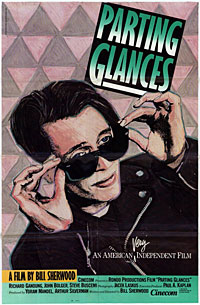
Bill Sherwood, a promising filmmaker whose career was just taking off, dies from AIDS-related illness in New York City at the age of 37.
Learn More.Sherwood is known for his 1986 film — and his only film — Parting Glances, for which he was Director, Editor and Screenwriter. Made for $310,000, the film is a bittersweet romantic comedy that spans a 24-hour period in the upwardly mobile New York gay community.
With its realistic look at urban gay life in the Ronald Reagan era and at the height of the AIDS crisis, many film critics consider it an important film in the history of gay cinema. It was also one of the first American films to address the AIDS pandemic.
In 2007, as a part of the Outfest Legacy Project, a restored print of Parting Glances received its world premiere at the Director’s Guild of America in Los Angeles. The four major stars of the film, Richard Ganoung, John Bolger, Steve Buscemi and Kathy Kinney, were in attendance and participated in a panel discussion after the viewing. Parting Glances was Buscemi’s feature film debut.
In 2014, the Advocate released its “top 175 essential films of all time for LGBT viewers,” placing Parting Glances at #10.

Pop artist Keith Haring dies of AIDS-related illness at the age of 31 at his LaGuardia Place apartment in Greenwich Village.
Learn More.Between 1980 and 1989, Haring achieved international recognition and participated in numerous group and solo exhibitions. His first solo exhibition in New York was held at the Westbeth Painters Space in 1981, according to the Keith Haring Foundation.
Throughout his career, Haring devoted much of his time to public works, which often carried social messages. He produced more than 50 public artworks between 1982 and 1989, in dozens of cities around the world, many of which were created for charities, hospitals, children’s day care centers and orphanages.
Haring was diagnosed with AIDS in 1988. In 1989, he established the Keith Haring Foundation, its mandate being to provide funding and imagery to AIDS organizations and children’s programs, and to expand the audience for Haring’s work through exhibitions, publications and the licensing of his images.
Haring enlisted his imagery during the last years of his life to speak about his own illness and generate activism and awareness about AIDS. By expressing universal concepts of birth, death, love, sex and war, and using a distinctively bold style, Haring attracted a wide audience and assured a timeless accessibility of his imagery. His work has become a universally recognized visual language.
Since his death, Haring has been the subject of several international retrospectives. His work can be seen today in the exhibitions and collections of major museums around the world.
* * * * * * * *
Photo of quilt panel from the AIDS Memorial Quilt
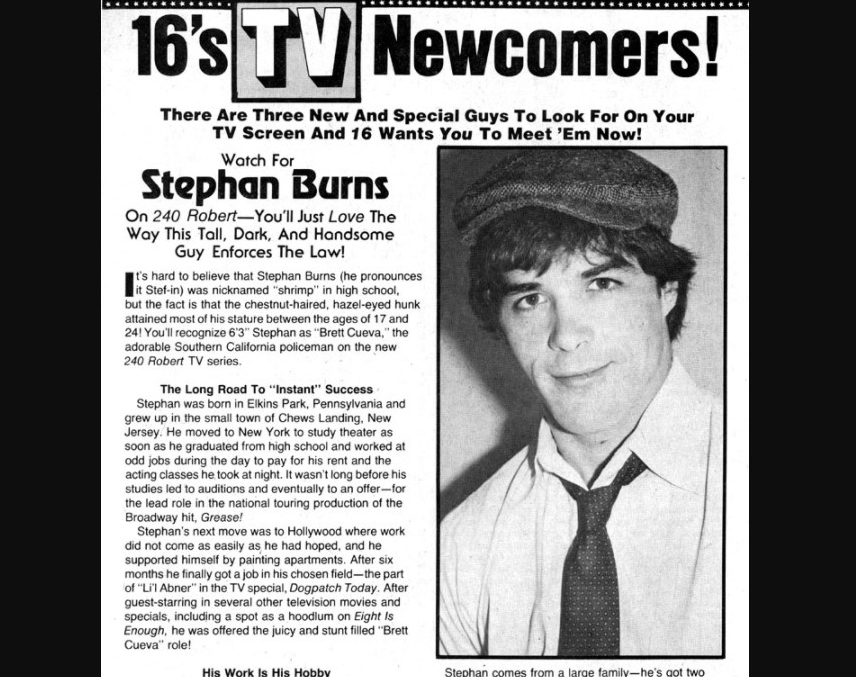
Stephan W. Burns, an actor known for playing Pete Stancheck in Herbie Goes Bananas and Jack Cleary in the TV miniseries The Thorn Birds, dies in Santa Barbara of AIDS-related illness at the age of 35.
Learn More.In 1984, Burns reportedly received an emergency blood transfusion after being seriously injured in a car accident. Various reports contend that the blood was contaminated and infected Burns with HIV.
Burns wanted to be an actor all his life. At an early age, he began staying up late to watch old musicals on television from his small-town home of Chews Landing, New Jersey. After graduating from high school, Burns moved to New York to study theater while working odd jobs during to pay for his rent and acting classes.
At 6’3″ tall, handsome and naturally athletic, Burns commanded attention at auditions and eventually was cast in the lead role in the national touring production of the Broadway musical Grease. Soon after, he moved to Los Angeles, where he faced much stiffer competition for acting roles. But in 1978, after six months in Hollywood, Burns was offered the title role in the TV special Li’l Abner in Dogpatch Today.
But his breakthrough role would come two years later, with the lead in Herbie Goes Bananas, the fourth in Walt Disney Productions’ Love Bug series. Working alongside veteran actors Vito Scotti, Harvey Korman, Charles Martin Smith, and Cloris Leachman, Burns caught the attention of ABC executives and was cast in the TV drama 240-Robert as a second-season replacement for Mark Harmon.
Pop culture magaine 16, known for introducing hunky entertainers to its young readers, published a profile on Burns as one of “three new and special guys to look out for on your TV screen.” According to the article, Burns was living in Silver Lake with a black and white cat named Svatch and enjoyed riding horses in the Hollywood hills.
Unfortunately, an actors’ strike delayed the start of the season and 240-Robert was cancelled after only three more episodes due to poor ratings. But ABC had Burns in mind for another project – The Thorn Birds, a mini-series based on the 1977 best-selling novel by Colleen McCullough featuring a forbidden love story set in the Australian outback. In the drama’s first three parts, Burns played Jack Cleary, an older brother of the lead character Meggie Cleary. The drama would go on to receive several Emmys and Golden Globe Awards.
In 1984, Burns reportedly received a blood transfusion which was contaminated with the AIDS virus while reeiving emergency medical treatment following a car accident. [It should be noted that, other than on Wikipedia and a 240-Robert fan page, information about the car accident and the source of Burns’ subsequent infection could not be verified.]
Burns would have only a handful of acting roles in 1986 and 1987, before succumbing to AIDS-related illnesses and dying in early 1990. A rock musical he was writing called Terminal Hotel would never be completed.

Halston, one of the most successful fashion entrepeneurs in history, dies of AIDS-related illness at Pacific Medical Center in San Francisco at the age of 57.
Learn More.Born Roy Frowick Halston in Des Moines, Iowa, Halston led a classic heartland childhood playing in soap box derby races, fishing, visiting farms, and the like. He took an interest in sewing from his mother, and from an early age he showed a special interest in making hats.
His family moved in 1952 to Chicago, where Halston enrolled in a night course at the Chicago Art Institute and took a day job as a window dresser. Halston continued to design hats and finally obtained his break when a small story on his fashionable creations appeared in the Chicago Daily News.
It was at this time that he would take his middle name Halston as his professional moniker. His hat sales took off, and in 1959, Halston left Chicago for New York City to work for the famed French milliner Lilly Daché.
Following that Halston accepted a position at the fashionable store Bergdorf Goodman, where he charmed his clients and made a grand name for himself. In 1962 he designed the famous pill box hat worn by Jackie Kennedy at the President’s Inaugural, making the Halston name a household word.
Later that year he was bestowed the Coty’s Fashion Critics Award. In 1966, Halston designed his first ready-to-wear collection for Bergdorf Goodman and continued creating magic with his hat creations. Women’s Wear Daily heralded him as “New York’s Top Milliner.”
He quickly became the toast of fashion society, including Liza Minnelli, Martha Graham, Lauren Bacall, and Elizabeth Taylor among his close circle of friends and clients.
Halston’s career sky-rocketed during the 1970’s and his designs set the standard for American designers. The Halston name became synonymous with classically cut, simple, spare and elegant designs, a phenomenally successful fragrance line Halston by Halston for women X12 and Z14 for men, and the fabric known as “Ultra suede.” Throughout most of the seventies he epitomized the glamour, as well as the decadence of the era, becoming a central figure in the nightlife scene of New York’s Studio 54 disco.
By 1988, the designer had effectively retired and retreated from the limelight — and it wasn’t long after until he was diagnosed with HIV, according to AP News. After learning of his diagnosis, Halston moved to San Francisco to be cared for by his family, where he reportedly spent his last days touring the California coastline in his Rolls Royce car — which Halston asked his family to auction off after his death in order to donate the proceeds to AIDS research.
Despite his tragic death, Halston’s legacy still lives on today, with his dazzling life story portrayed in films and biopics, including the Netflix miniseries, Halston.
* * * * * * * *
Photo of quilt panel from the AIDS Memorial Quilt

John “Jack” Winkler, who taught classics at Yale and Stanford, dies of AIDS-related illness at the age of 46.
Learn More.Winkler’s 1989 book Auctor and Actor — which treats the Latin novel The Golden Ass as a detective story — was named best work of classical scholarship by the American Philological Association. In addition to being a classical scholar, Winkler was also a queer theorist and political activist.
Born in St. Louis, Missouri in 1943, Winkler attended a Jesuit high school, where he first learned Greek. From 1960 to 1963, he studied at St. Louis University, also a Jesuit institution. Upon graduating, he joined the Benedictine religious order, living first at St. Lawrence’s Abbey in Ampleforth, England, and then continuing at the St. Louis priory.
In 1970, Winkler left the Benedictines and decided to pursue a career in classics and earned his Ph.D. from the University of Texas in 1974. For the next five years, Winkler taught classics at Yale, where he became an advocate for feminist, gay, and minority causes. He helped to found Yale’s women’s studies program, openly supported the university’s Gay Alliance, and co-produced an LGBT-themed radio show called Come Out Tonight.
In 1977, Winkler was the sole faculty member to help organize Yale’s first Gay Rights Week. That same year, he was the only faculty member to join a class-action lawsuit brought by women students against Yale for its tolerance of sexual harassment of students by faculty. Jack left Yale for Stanford in 1979, and continued to be a leading voice for gay students and faculty.
Upon being diagnosed with AIDS in August 1987, he announced a two-year sabbatical. He spent the last years of his life co-editing essay collections, translating fragments from Greek novels, and publishing his most influential work, Constraints of Desire: The Anthropology of Sex and Gender in Ancient Greece. He donated half of the book’s income to the San Francisco AIDS Foundation.
He was the author of three books and 19 articles, many of them reinterpreting classical works.
* * * * * * * *
Photo of quilt panel from the AIDS Memorial Quilt
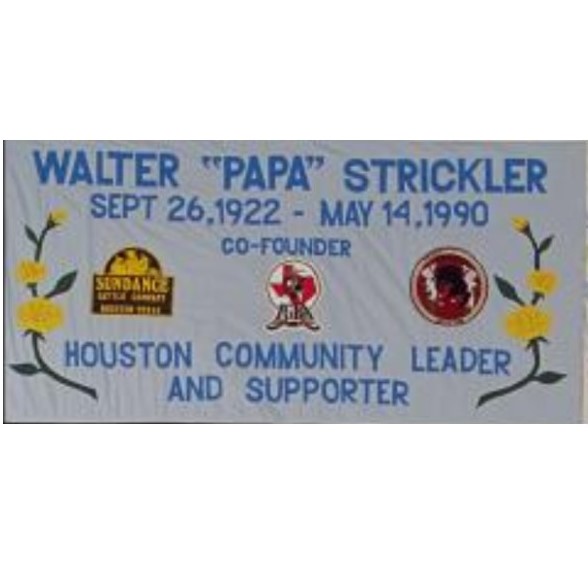
Walter Strickler — also known in the Texas gay rodeo community as “Papa” and “Uncle Bud” — dies of AIDS-related illness at Park Plaza Hospital in Houston. He was 67 years old.
Learn More.Strickler was a founder of the Texas Gay Rodeo Association, fulfilling a lifelong dream of creating a way to bring gay cowboys and rodeo fans together. He was also owner and operator of the country-western gay bar The Barn, which was located in Houston’s Montrose neighborhood.
For his contributions to the community, Strickler was named a Grand Marshal of Houston’s Pride Parade in 1983, along with Marion Pantzer, co-owner of one of Houston’s first lesbian bars.
Strickler was born in 1922 in Jennings, Louisiana, and studied at the University of Southern Louisiana, Chicago University, and Rice University, earning a Master of Arts degree from Rice. He served in the U.S. Navy during World War II, and then worked for Shell for 30 years as a mathematician, according to his obituary in the Montrose Voice.
As his career at Shell came to an end, he opened The Barn in the mid-1970s. Every day, he would take a seat at the front of the country-western bar and quietly read the newspaper, and this is where friends would often find him. But this belied how busy he was in the community.
In addition to founding the Texas Gay Rodeo Association with his partner Terry Clark, Strickler served as the organization’s Treasurer. He also was a charter member of the Houston Gay and Lesbian Political Caucus (now known as the Houston LGBTQ+ Political Caucus) and a founding Board Member of the Montrose Clinic, which became Houston’s leading medical provider during the AIDS Crisis and is now known as Legacy Community Health Services.
He was Treasurer of the Houston Tavern Guild and an active member of the Bar Owners Association of Texas. Through fundraisers held at The Barn, Strickler helped raise money for the Danny Villa Living Memorial Fund, named for a local performer and humanitarian who died of AIDS-related illness, and which provided financial assistant to people living with HIV/AIDS.
The Texas Gay Rodeo Association presented Stickler, posthumously, as Grand Marshal of the 1991 rodeo event.

Franklyn Seales, best known for playing the finicky business manager Dexter Stuffins on the sit-com Silver Spoons, dies of AIDS-related illness at the age of 37.
Learn More.Born on the Caribbean island nation of St. Vincent, Seales studied at John Houseman’s Acting Company in New York in the early 1970s. The 1978 PBS drama, ″Trial of the Moke,″ proved to be Seales’ first big break.
Between 1982 and 1986, Seales played business manager Dexter Stuffins on the NBC-TV sitcom Silver Spoons, in which Houseman played a stoic grandfather. His other television appearances included Hill Street Blues and Amen.
Among his motion picture credits are The Onion Field and Southern Comfort. A versatile performer, Seales took on stage roles in productions that ranged from Shakespeare to the theater of the absurd.
A member of L.A. Classic Theatre Works, Seales performed in unconventional productions, including Conversation at Night With a Despised Character. Following Seales’ performance in this production, Los Angeles Times critic Lawrence Christon said he was “one of America’s most compelling stage actors.”
Seales died at his family’s home in New York City.
* * * * * * * *
Photo of quilt panel from the AIDS Memorial Quilt

Dan Turner, author of several plays at Theatre Rhinoceros and other Bay Area theaters, dies in San Francisco of AIDS-related illness at the age of 42.
Learn More.Turner was one of the first two patients diagnosed with AIDS at San Francisco General Hospital in 1982. At the time, doctors told him that he had a rare cancer, Kaposi’s sarcoma.
Turner was born in 1947 in Bloomington, Illinois, where his father managed the Hotel Rogers. When he was a teenager, his family moved to Cheboygan, Wisconsin, and he began acting in high school drama productions. In college at Fairfield University in Connecticut, he spent a year abroad at Exeter College in England and traveled throughout Europe. After earning his Bachelor’s degree, he volunteered to work in Malawi with the Peace Corps and then in Alabama with the AmeriCorps VISTA program. He was in Alabama when he wrote and produced his early play Cottonmouth.
In the early 1970s, he studied playwriting with Kenneth Cameron at the University of Iowa, writing and producing the play Light Years. He moved to Texas to accept an internship with the Dallas Theater, but quickly found that the program’s leaders didn’t approve of Turner’s openly gay identity and progressive political views.
San Francisco became Turner’s next destination. He joined the productions of both regional and gay theater companies and collectives, and taught a playwriting course at the Eureka Theatre, birthplace of Angels in America. He occasionally traveled to Los Angeles for acting opportunities. A prolific artist, Turner also wrote essays and critical articles for local gay papers, as well as poetry, novels, and short stories. Some of his erotica appeared in gay magazines such as In Touch and Blueboy.
In 1976, Turner contracted hepatitis, and in the same year, he traveled with Tennessee Williams to New Orleans, New York and Cape Cod. Turner became in awe of Williams, who was in failing health and yet woke at 4:00 a.m. every day to write.
“I had been perpetuating (my hepatitis) through this negative mind trip,” Turner later told the Los Angeles Times. “From then on, when my mind said, ‘You can’t do it,’ I’d say, ‘But that’s just your mind.’”
He returned to San Francisco with renewed hope. He wrote and produced three musical plays, two of which (Cinderella II and Comeback) were in collaboration with playwright-novelist Daniel Curzon. He also directed several plays.
In February 1982, Turner was diagnosed wish Kaposi Sarcoma and was one the first patients of Dr. Paul Volberding at San Francisco General Hospital. He befriended AIDS activist Bobbi Campbell and together they laid the groundwork for the organization People with AIDS San Francisco. Both were open about their AIDS diagnosis and began to be sought-after as speakers for community events. In May 1983, Turner and Campbell represented People with AIDS at the second annual AIDS Forum.
Still, Turner continued to be involved in San Francisco theater, and his work began to incorporate his AIDS activism. In 1984, he wrote parts of The AIDS Show at the Theatre Rhinoceros. In 1987, Turner was featured in the televison documentary The Fighting Edge, which addressed how people with AIDS could continue to lead productive lives.
With an eight-year-long illness, Turner was the longest-living known person with AIDS by the time of his death. He outlived his friend Campbell by almost six years.
“He was a shining symbol,” longtime friend Maura Nolan told the Los Angeles Times. “When Dan would walk into the hospital room of some person afflicted with AIDS, it was as if hope walked though the door.”
* * * * * * * *
Photo of quilt panel from the AIDS Memorial Quilt
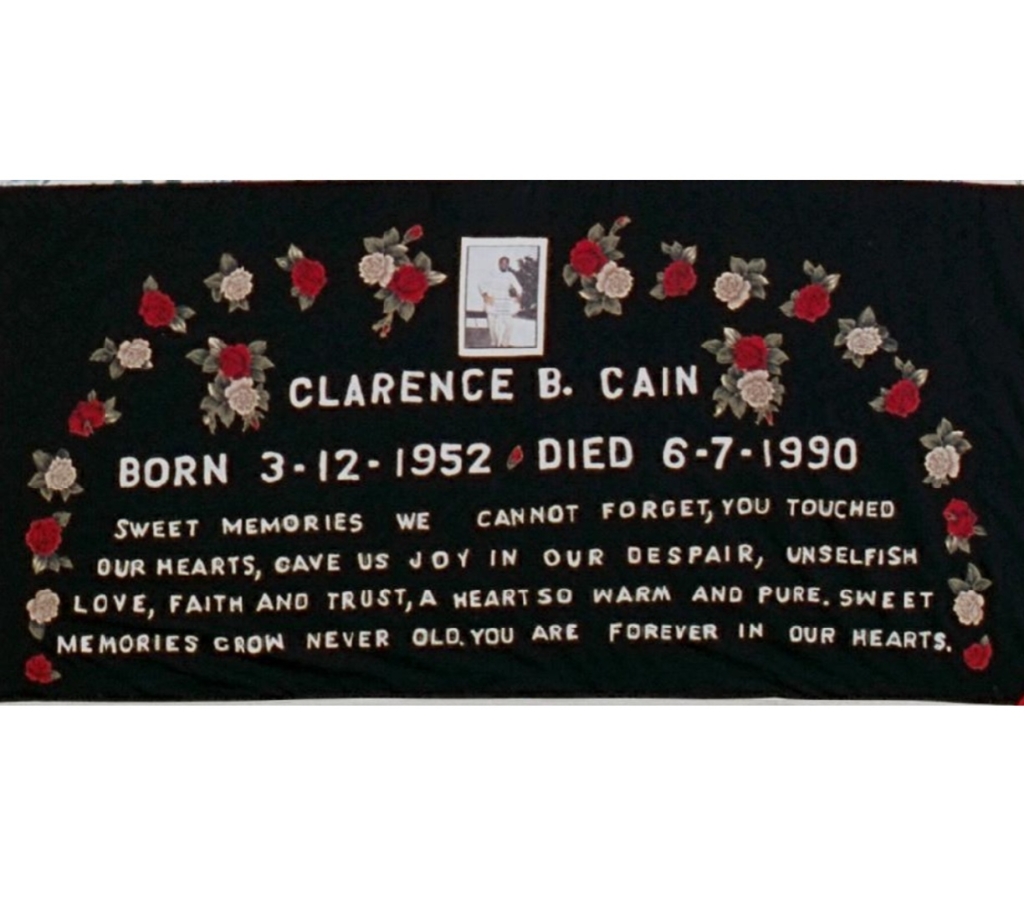
Clarence Cain, whose discrimination lawsuit was one of the inspirations for the 1994 film Philadelphia, dies of AIDS-related illness. He was 38.
Learn More.Clarence Cain was a lawyer managing a regional office for Hyatt Legal Services, a chain of low-cost legal clinics, when he was fired for disclosing his AIDS diagnosis to his supervisor.
When Cain’s employment was terminated, his coworker and friend Richard Silverberg quit in protest of the firm’s treatment of Cain. Silverberg, then 33 years old and one year out of law school, represented Cain in court.
“Clarence wanted his day in court,” Silverberg told The Washington Post in January 1994. “He would say, ‘I won’t let them get away with it.’ ”
Cain was one of 10 children born in Newport News, Virginia to Lillie Mae Cain, and the only one of her children to attend college.
“Everybody else was playing football, and Clarence had a book stuck in his face,” the Rev. Solomon Wooten told the Daily Press in Newport News in 1994. “He was always very quiet.”
Cain earned a bachelor’s degree and law degree from the University of Virginia. In 1986, Hyatt Legal Services recruited Cain for its fast-track program, according to The Washington Post. After managing Hyatt’s Falls Church office, he was promoted to regional partner and put in charge of 10 offices with 75 employees in the Philadelphia area.
Cain became one of Hyatt’s highest-paid regional partners, able to financially help other members of his family while maintaining a comfortable lifestyle. Then, in July 1987, Cain was hospitalized for more than a week with pneumonia.
He informed his supervisor that he had AIDS, and soon after, Hyatt “switched this young lawyer onto another fast track — one calculated to remove him,” according to U.S. District Judge Raymond Broderick in his court opinion.
During the 1990 trial, Hyatt supervisors portrayed Cain as inept and uncooperative, according to The Washington Post. Hyatt’s founder and owner, Joel Hyatt, testified that he approved of Cain’s dismissal — something the politically ambitious man would come to regret during his 1994 campaign for U.S. Senate in Ohio.
Cain ultimately won his case, and was awarded $107,888 in damages and an additional $50,000 in punitive damages. He died two months after hearing the court’s decision.
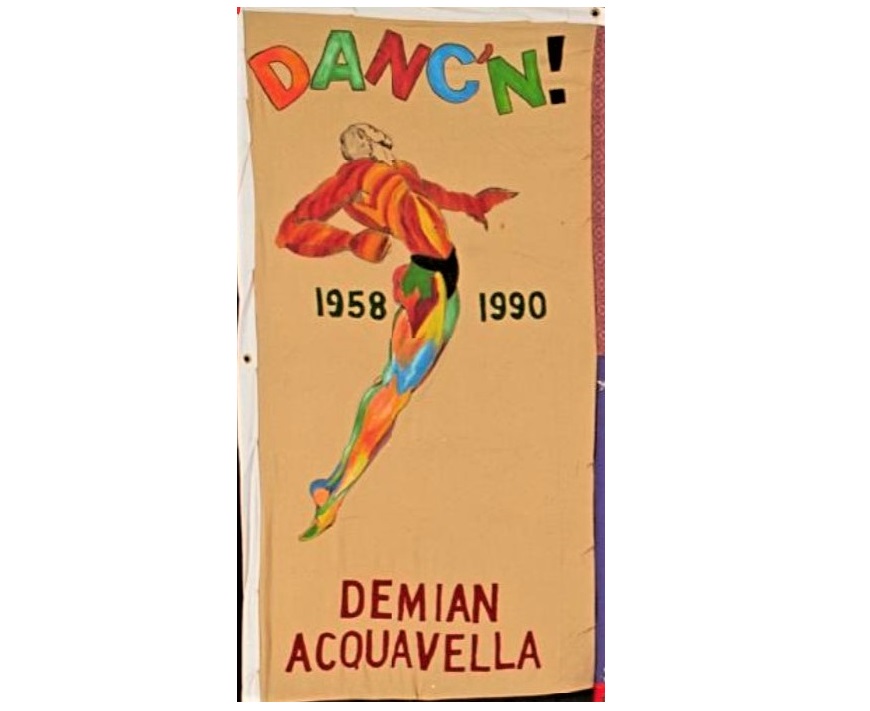
Demian Acquavella, a dancer with Bill T. Jones/Arnie Zane and Company, dies of AIDS-related illness at his home in Brooklyn. He was 32 years old.
Learn More.A popular figure in post-modernist dance in New York, Acquavella was the inspiration for the 1989 work D-Man in the Waters, a celebration of Acquavella’s determination to fight his illness.
Born in Brooklyn, Acquavella moved to California when he was twenty to major in dance at Santa Monica Community College. He trained with Marjorie Mussman, Cindi Green, Ernie Pagnano and Phil Black, and also studied at the Nat Horne Musical Theater and the Alvin Ailey American Dance Center. He danced with Lillo Way, Elisa Monte, Miss Mussmann, the Rush Dance company, and Alvin Ailey American Dance Theater before joining the Jones-Zane troupe.
He became the central figure in Bill T. Jones’ pivotal work when the St. Luke’s Chamber Orchestra commissioned Jones to choreograph a dance set to the first movement of Felix Mendelssohn’s Octet in E-Flat Major. By then Acquavella was so sick, he had stopped dancing but he continued to stay close to the dance company.
“At first, Bill was going to call it just Waters,” Acquavella recalled. “But then Bill looked over at me, and changed the title. I will never forget Bill saying I would be in it, even though I could hardly walk.”
D-Man in the Waters had its premiere at the Joyce Theatre on March 14, 1989.
“As he could no longer walk by the time of the debut, I carried Demian onstage, offering my legs as he executed the arm movements of what would have been his solo,” Jones wrote.
After he was too ill to perform, he was known to attend performances and loudly cheer the dancers from his seat.
The work finds new life in the 2020 documentary Can You Bring It: Bill T. Jones and D-Man in the Waters, directed by Rosalynde LeBlanc and Tom Hurwitz.
When codirector LeBlanc was 16, she tells us on-screen in the documentary, she saw D-Man performed. The experience inspired her to become a dancer — and to join Jones’ company.
Now on the dance faculty at Loyola Marymount University in California, LeBlanc chronicles in the film a production of D-Man that she staged with her undergraduate students.
In the documentary, Jones meditates on what the work means now. In 1989, “It was a place to grieve,” he says.
But he believes D-Man is more than “a response to the plague”; it’s an enduring statement about survival and community.
* * * * * * * *
Photo of quilt panel from the AIDS Memorial Quilt
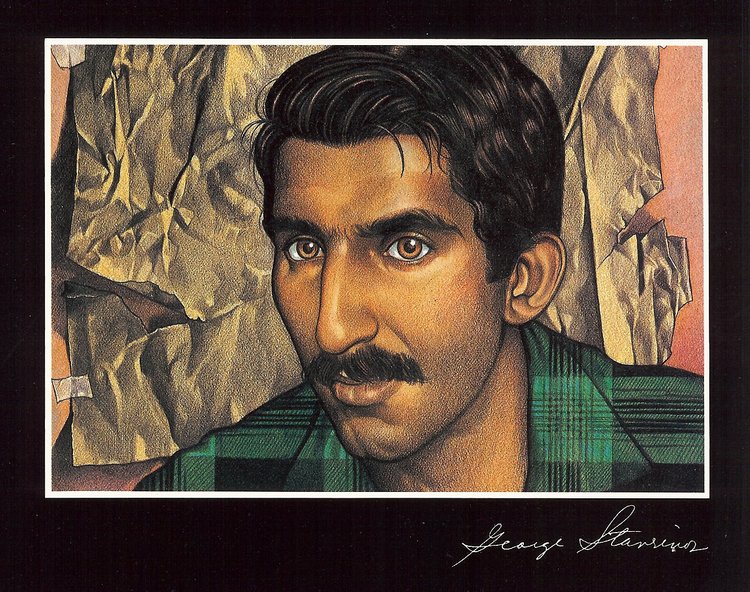
George Stavrinos, best known for his illustrations for New York fashion retailers Barney’s and Bergdorf Goodman, dies of AIDS-related illness at the age of 47.
Learn More.In the late 1970s , Stavrinos’ work became familiar to many gay men through his illustrations for numerous magazines, including GQ, Cosmopolitan, and Christopher Street, according to Visual AIDS, a project created in 1988 to preserve a visual record of the work of HIV+ artists.
Stavrinos also provided illustrations for the New York City Opera, and illustrated the cover of a novel by West Hollywood writer Felice Picano as well as an excerpt of Paul Monette’s first novel, Taking Care of Mrs. Carroll, which appeared in the August 1978 issue of Blueboy.
Stavrinos was famous for his high-contrast drawings and technical proficiency using pencil. He used the style of Superrealism, a movement of the late 1960s and early 1970s in which art approaches the realism of photography.
“He created an arresting new look that set the pace for his contemporaries and still continues to be an influence,” writes Cyril Foiret, founder of Trendland.
His process began with hundreds of photographs of his model in various poses and at various focal lengths using a Polaroid SX-70. He would then create an environment around the model that included a variety of shapes and materials, such as pottery, fans, lights and various geometric designs.
In 2007, Stavrinos was elected posthumously to the Society of Illustrators Hall of Fame.
Paul Giovanni — a playwright, actor, director, singer and musician best known for writing the music for the 1973 British horror film The Wicker Man — dies of AIDS-related illness at Cabrini Medical Center in New York. He was 57.
Learn More.Giovanni wrote the music for the The Wicker Man‘s soundtrack, and also wrote the lyrics and performed in the songs “Landlord’s Daughter” and “Gently Johnny. The music was played by a group of six musicians, using a combination of traditional and modern instruments.
The New York Times considered a highlight of Giovanni’s career to be his 1978 Broadway play, The Crucifer of Blood, a Sherlock Holmes drama. He wrote and staged the play, which received a Tony Award nomination for best director. The play would be turned into a movie for TV in 1991, shortly after Giovanni’s death.
But many fans of cult films credit Giovanni with crafting one of the most memorable and haunting musical accompaniments to a film with his soundtrack for The Wicker Man.
“Haunting and warm in both measures, Paul Giovanni’s rustic folk soundtrack for The Wicker Man is the perfect compliment to a dark fairytale,” writes reviewer Laura Thomas. “His enchanting score and its thorough integration within the film’s narrative mean that The Wicker Man oscillates between folk musical and horror.”
He also worked on several films as producer and production manager, according to Turner Classic Movies.
Jim Samuels, winner of the 1982 San Francisco Comedy Competition, dies of AIDS-related illness at the age of 41.
Learn More.Born in Oakland, Samuels was a popular comedian and sometime comedy teacher. In the mid-1970, Samuels and then-comedy-partner Marty Cohen were regulars on Merv Griffin’s television show and several other variety programs. In 1977, Samuels performed solo in a comedy skit on the TV show Don Kirshner’s Rock Concert and would embark on a solo career officially in the early 1980s.
Dubbed San Francisco’s Dean of Comedy by his friends and competitors, Samuels was also part owner of the Holy City Zoo club, a small but influential comedy club located at 408 Clement Street between 5th and 6th Avenues in San Francisco.
Samuels died at Garden Sullivan Hospital in San Francisco.
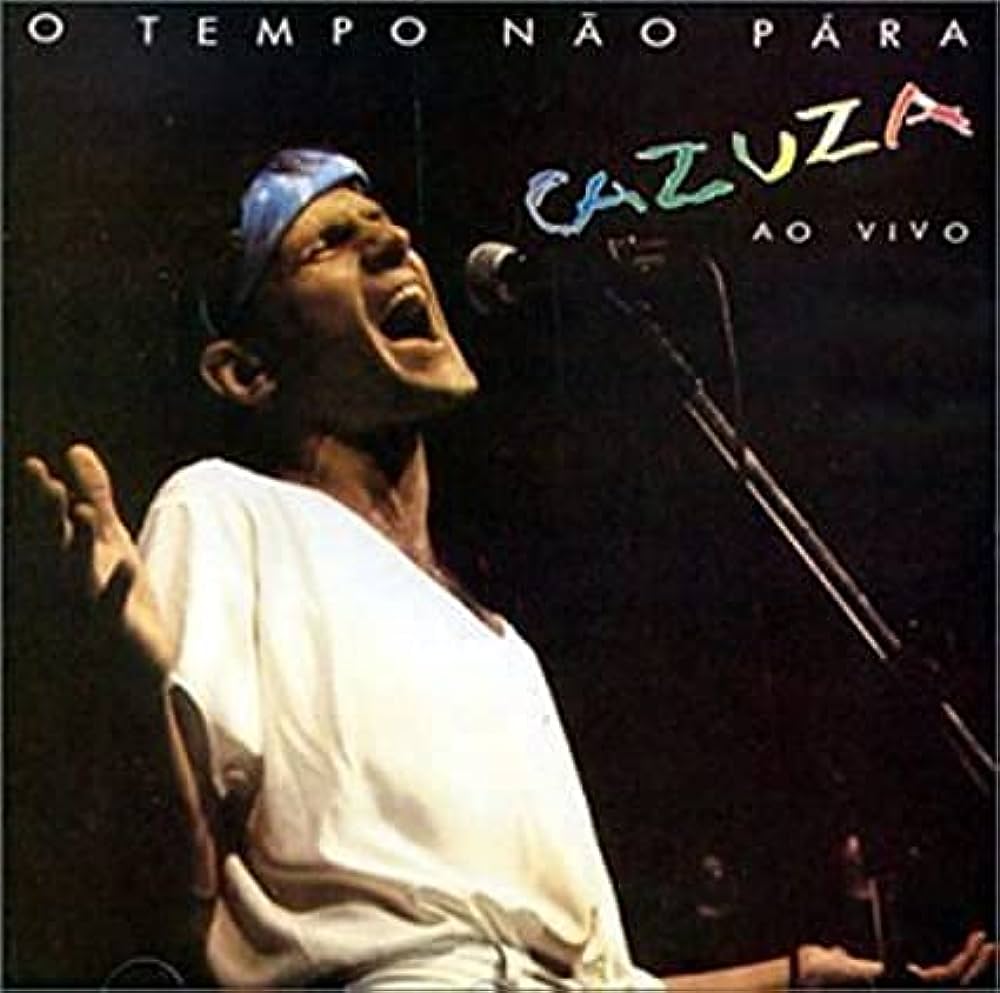
Brazilian rock legend and heartthrob Cazuza dies from AIDS-related illness at his parents’ Ipanema home at the age of 32.
Learn More.“Cazuza was forced to navigate his way through the trying social and medical realities of living with AIDS in Brazil during the 1980s,” according to Brazil: Five Centuries of Change by Thomas E. Skidmore.
Prior to the arrival of AIDS in Brazil in 1983, a sexual liberation had taken hold in the country’s major cities. Because the first reported AIDS cases were that of gay men, it would be commonly referred to by Brazilians as a “gay cancer” or “gay plague,” and would cause widespread panic and fear.
“Cazuza would come to embody much of the conversation around (homo)sexuality and AIDS that would consume Brazil in the late 1980s,” Skidmore writes. “Cazuza had relationships with both men and women. He made easy references to kissing girls and having girlfriends, but he neither ascribed to being gay per sé nor denied his interest in men… He would be able to defy the notion that AIDS was purely a gay man’s disease; though he slept with men, he was not necessarily identified, by himself or others, as gay.”
Mixing Bossa Nova music with 1960s British and American rock, he composed and recorded ″Cazuza,″ his first solo album in 1985, a record known for its biting, sarcastic tone and lyrics.
Changing the ways in which HIV/AIDS were discussed and understood in Brazil, Cazuza demonstrated that people with AIDS could continue to be productive. According to author and literary critic Marcelo Secron Bessa, Cazuza had become the “face” of AIDS in Brazil.
Cazuza dies in his sleep in his parents’ home in the beachfront neighborhood of Ipanema.
″Fortunately, he died without pain, sleeping,″ his father, Joao Araujo, director of one of the largest record companies in Brazil, would say on television.
Cazuza’s funeral at Sao Joao Batista Church in Rio’s Botofogo neighborhood would draw hundres of fans.
His mother Lucinha Araújo, would go on to create the ‘Sociedade Viva Cazuza’ [Viva Cazuza Society], to help people with AIDS. A movie about Cazuza’s life would be released in 2004.

Kaisik Wong, an avant-garde fashion designer who worked in the Bay Area from the 1960s to the 1980s, dies of AIDS-related illness in San Francisco. He was 40.
Learn More.Kaisik Wong was the creator of what would become to be known as “wearable art,” but he was relatively unknown outside of the Bay Area. One of Wong’s pieces — a 1973 patchwork vest that was photographed for the fashion book Native Funk and Flash (1974) — would be replicated by a Balenciaga designer in 2002, causing renewed interest in Wong’s work (as well as outrage in the fashion industry over the obvious plagiarism).
Born in San Francisco in 1950, Kaisik Wong grew up in Chinatown. When he was 14, he began silk screening fabrics and making his own clothes, including shoes, hats and belts, according to Wong’s brother Kailey, who spoke to the Los Angeles Times in 2002, when the Balenciaga vest scandal broke.
Kaisik dropped out of high school at 15 to study at the Pacific Fashion Institute. He began taking his design inspiration from other young people gathering in the Fillmore, the Avalon and other meccas of the hippie movement, his brother said.
Wong was just 17 when he moved to New York City in 1967, and began working with designers. He traveled to Paris and met Yves Saint Laurent, Thierry Mugler, and Pierre Cardin. When Cardin asked Wong to work for him, he declined, preferring to focus his energy and talent on creating his own designs, his brother said.
In his travels, he sought out people who celebrated art and spectacle, and found himself in the inner circle of legendary surrealist Salvador Dali. Dali, who had a keen interest in the artistic aspects of fashion, saw Wong’s work and invited him to collaborate on a series of costumes for the Spanish surrealist and his wife, Gala.
For himself, Wong created a costume inspired by the Monkey King, a trickster character in Chinese myth, and wore it when he visited Dali and also to other special events. Wong’s panel for the AIDS Memorial Quilt references the Monkey King, which to Wong was both a costume and persona.
Uninspired by the state of the fashion industry in New York and Paris, he decided to return to the creative wellspring that was 1970s San Francisco, and he launch his own fashion label, Muuntux. His garments used unusual shapes and materials to emphasize the handmade fabrication.
Well-known in the local art and theatrical community, Wong was sought out to create costumes and performance pieces. Surrealist filmmaker (and later photographer) Steven Arnold invited Wong to create the elaborate costumes that are featured in his ground-breaking film Luminous Procuress. Wong also created costumes and set designs for The Cockettes, a multiracial drag ensemble that performed monthly in the “Nocturnal Dream Show” at the Pagoda Palace Theater.
“Wong was the epitome of the outsider as designer,” states the art-fashion blog Undo and Unravel. “Amazingly, he didn’t use patterns to create collections that veered more towards costume than everyday staples that would hang in a closet. Wong often referenced ancient cultures in his work, which was the main source of the fantastical nature of his aesthetic.”
In 1973, Wong closed Muuntux and began producing one-of-a-kind pieces for the San Francisco boutique Obiko, as well as I. Magnin and Henri Bendel. He also began designing for stage performers, such as Tina Turner and Robin Williams (whose comedy career began in San Francisco).
“He helped to pave the way for a more emotional and rebellious glamour in American fashion, injecting the themes of love, funk, surrealism, psychedelic dreams, and mysticism into his dazzlingly obscure designs,” wrote Colby Mugrabi in his tribute to Wong.
In a 1978 interview with New York Magazine, Wong said his whimsical clothing for celebrities and performers had a practical purpose.
“The idea is to get people together and get them in touch with the changing of the seasons,” Wong said. “The clothes in the collection are merely functional versions of what we do in the theater.”
Following Wong’s death in July 1990 from AIDS, his mother insisted on maintaining his workroom exactly as it was and refused to sell any of the finished pieces, according to his brother Kailey.
“His scissors, sewing machine and pins were just the way they were, as if he was going to the store and coming right back,” Kailey told the LA Times.
In 1996, the de Young Museum mounted a retrospective of Wong’s work, bringing together more than 30 of his wearable art looks. And in early 2002, almost 12 years after Wong died, Wong’s brother Kailey received an email from a friend that included a photo of a vest in Balenciaga’s new collection — and he immediately recognized the design as a piece Wong created in 1973.
Having already seen designs similar to Wong’s work in the Star Wars movie franchise, Kailey said he wasn’t all that surprised to see his brother’s work replicated by a Paris-based fashion house.
“I guess nothing is original,” Kailey told the LA Times. “Except maybe Kaisik.”
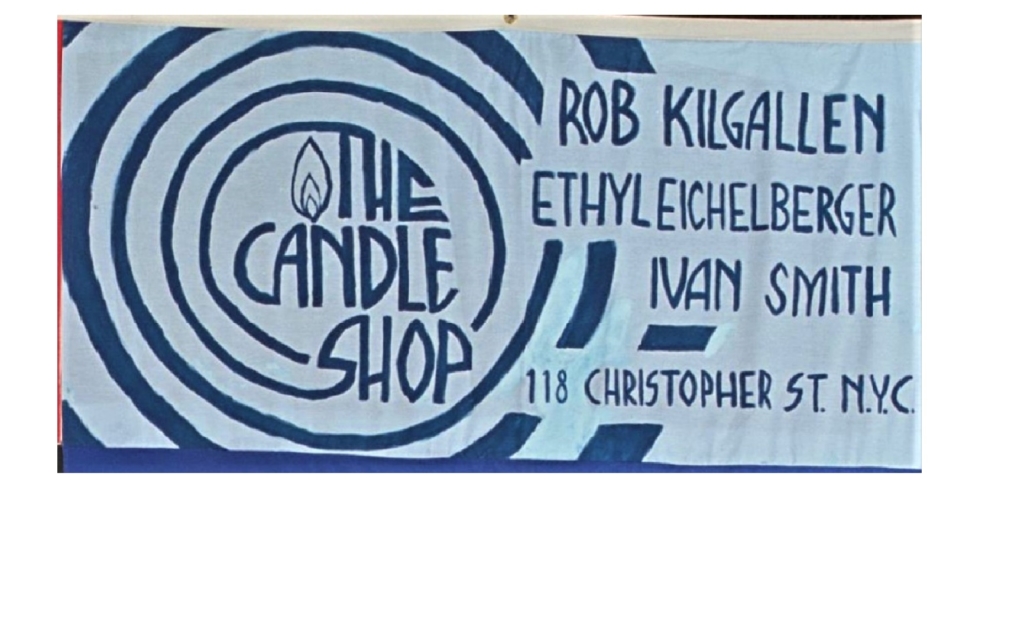
Flamboyant actor Ethyl Eichelberger, who turned theatrical conventions upside down in their career as a performance artist, playwright and director, committs suicide. Eichelberger was 45 years old.
Learn More.Eichelberger was diagnosed with AIDS and chose to end their life on their own terms. Their body was discovered in their Staten Island home by friends Lola Pashalinski and Linda Chapman.
Eichelberger was equally at ease playing characters male or female, including Abraham and Mary Todd Lincoln, King Lear, Medusa and Klytemnestra.
They wrote more than 30 plays, many of them marked by such Eichelberger trademarks as fire-eating, cartwheels and impromptu accordion concerts.
Eichelberger was born to Amish parents on July 17, 1945, and was named James Roy. After studying theater at Knox College in Galesburg, Illinois, they attended the American Academy of Dramatic Arts in New York and worked with Charles Ludlam and the Ridiculous Theatrical Company.
It was here where they perfected their flair for comedy and their craftmanship as a wig maker. In 1975, they legally changed their first name to Ethyl.
As their reputation grew, they began making forays into mainstream theater, doubling as the courtesan and the abbess in the Flying Karamazov Brothers production of ”The Comedy of Errors” at Lincoln Center.
Eichelberger played themself in Oliver Stone’s movie, ”The Doors.”
* * * * * * * *
Photo of quilt panel from the AIDS Memorial Quilt

Bobby DeBarge, a singer celebrated for his falsetto vocals and a co-producer the band DeBarge, dies of AIDS-related illness at a hospice in Grand Rapids, Michigan. He was 39.
Learn More.DeBarge was the lead singer of the Motown R&B group Switch, and later on, he served as both mentor and a co-producer of his siblings’ band, DeBarge.
Bobby DeBarge was the oldest male of eight DeBarge children born to Robert and Etterlene DeBarge over the course of their 21-year marriage. His mother was a black gospel singer who encouraged her children to hone their musical talents. His father was domineering and physically abusive to members of the family, according to Parle magazine.
Bobby DeBarge started his career as a singer as part of Barry White’s background group, and when White broke up the group, DeBarge and other members formed a group named Hot Ice. In 1977, Greg Williams formed the band Switch, featuring DeBarge and his brother Tommy. Switch managed to get the attention of Jermaine Jackson, and they were soon signed to Motown Records.
Bobby DeBarge released six albums with Greg Williams and Switch members with the last album in 1980. By 1981, DeBarge was overseeing the production of his siblings’ debut album The DeBarges; he also co-wrote with younger brother El the song, “Queen of My Heart.”
The group’s third album, In a Special Way (1983), featured the hit single “Time Will Reveal.” But the group would have their biggest hit in 1985 with “Rhythm of the Night.”
Personal problems, including substance abuse which eventually led to drug trafficking charges in Wisconsin in 1988, plagued DeBarge in later years and took focus away from his musical career. Despite having an amazing voice, Bobby DeBarge didn’t release a solo album until 1995, titled It’s Not Over. The album was released just before he died, and he didn’t get the chance to see the project promoted.
In 2019, TV One produced the biopic The Bobby DeBarge Story.

David Lewis, of the Harvey Milk AIDS Education Fund, dies of AIDS-related illness at his parents’ home in Vancouver, British Columbia. He was 38.
Learn More.From the late 1970s through the 1980s, Lewis lived in San Francisco, where he was an active member of the Harvey Milk Democratic Club and served on the board of the Harvey Milk AIDS Education Fund, according to the Bay Area Reporter.
Lewis was also a member of the leather community and a founding member of The 15 Association of San Francisco. He worked as a clinical counselor, income tax preparer, and smoking cessation program coordinator in the Bay Area until 1989, when he returned to his parents’ home in Vancouver.
Lewis’ body was cremated and his ashes were buried in Point Roberts Cemetery in Washington next to the remains of his partner, James Landsdowne, who died of AIDS-related illness in June 1989.
* * * * * * * *
Photo of quilt panel from the AIDS Memorial Quilt
James K. Heady, owner of Male Image barbershop and Image Leather shop, dies of AIDS-related illness at San Francisco’s Hospice By The Bay at the age of 45.
Learn More.With the two businesses that he co-owned with his partner, Gary Mootz, Heady worked long hours but still found time to travel and pursue hobbies, according to the Bay Area Reporter. He and Gary often spent time sailing their boat, “The Crisco Kid,” on San Francisco Bay.
Born and raised in Ohio, Heady joined the U.S. Navy in 1964 and served as the launch director for the USS Independence. After the service, he moved to London and worked as a cab driver, and then returned to the U.S. to study architecture. Heady moved from Phoenix to San Francisco in 1977.
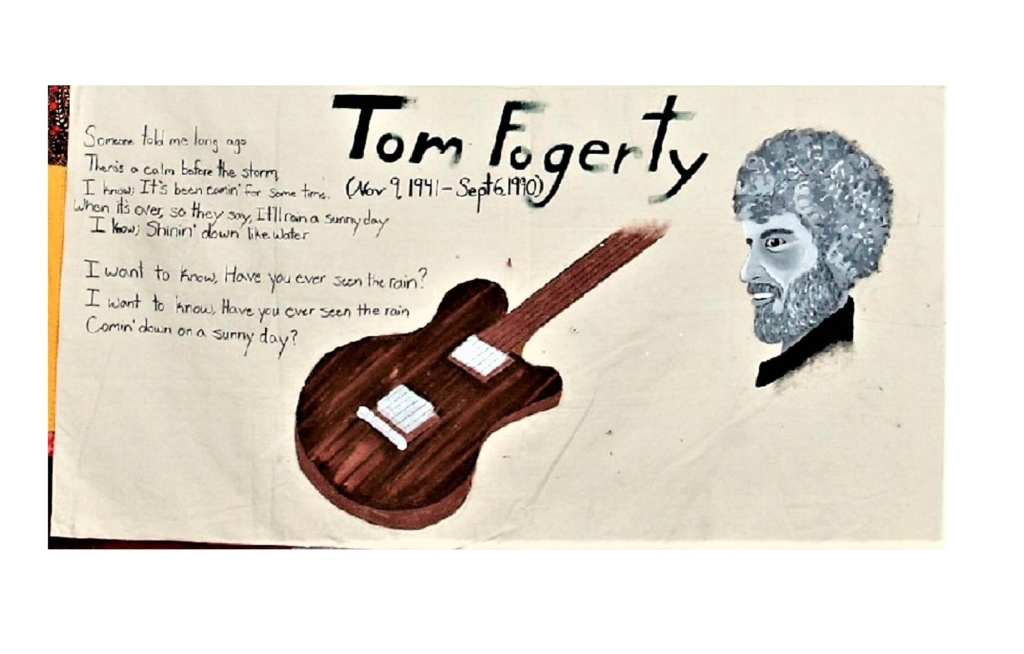
Tom Fogerty, member of Creedence Clearwater Revival and older brother of frontman John Fogerty, dies of AIDS-related illness in Scottsdale, Arizona at the age of 48.
Learn More.Born November 9, 1941 in Berkeley, California, Fogerty holds a significant place in rock history. As the rhythm guitarist for Creedence Clearwater Revival, he played on plenty of rock classics and had a solo career.
In the four years the band was together, they never had a #1 single in the U.S. However, the band holds the record for the most number of No.2 chart hits without ever having had a No.1. They also had a U.K. #1 hit with Bad Moon Rising.
At some point in the 1980s, after moving to Scottsdale, Arizona, Fogerty underwent surgery for his back and an unscreened blood transfusion caused him to be infected with AIDS virus. The cause of his death was initially reported as tuberculosis.
In the eulogy that John Fogerty made at his brother’s funeral, he said: “We wanted to grow up and be musicians. I guess we achieved half of that, becoming rock ‘n roll stars. We didn’t necessarily grow up.”
When Creedence Clearwater Revival was inducted into the Rock and Roll Hall of Fame in 1993, Tom Fogerty’s widow brought his ashes in an urn.
* * * * * * * *
Photo of quilt panel from the AIDS Memorial Quilt

Ray Stephens, best known for his starring role in the 1980s TV series The Great Space Coaster, dies of AIDS-related illness at the age of 35.
Learn More.Stephens became the lead singer of The Village People in 1985, recorded with the group for their album, Sex Over the Phone, and acted in the movie Village People: New York City.
He was an actor, known for in roles in The Runaways (1975) and Cat’s Eye (1985). He is also heard singing the tune Cat’s Eye during the closing credits of the 1985 Stephen King movie.
Stephens reportedly became infected with the HIV virus ‘ death through the intravenous use of drugs.
Jorge Bolet, regarded as the last of the great romantic concert pianists, dies of AIDS-related illness at his home in Mountain View, California at the age of 75.
Learn More.Bolet was famous for his performances and recordings of large-scale Romantic music, particularly works by Franz Liszt, César Franck, and Frederic Chopin. He also specialized in piano transcriptions and unusual repertoire, including the difficult works of Godowsky.
Bolet, who was born in Havana, had been performing in the U.S. and abroad for years before critics and audiences suddenly recognized him as a great master. In the 1970s, he started to receive rave reviews.
“There may be others who can play the notes, but Bolet, with his roots in an older tradition than most today … has a feeling for the line, the elegance, the suave sound, the tapered phrase of high romanticism that is virtually unmatched today,” Harold Schonberg said of the pianist in a 1978 review for The New York Times.
Bolet parlayed his new-found popularity into a recording contract with Decca and a world tour. At his most prolific, he was giving up to 150 concerts a season.
For London/Decca Records, he made more than two dozen recordings, including nine of piano works by Liszt, according to The Washington Post. He also recorded music by Brahms, Debussy, Grieg, Rachmaninoff, Schumann, and Tchaikovsky.
Bolet retired from the concert stage in June of 1989, about six months after learning he was HIV positive. His last Carnegie Hall appearance was on April 16, 1989, and his final performance was a solo recital at the West Berlin Philharmonie on June 8, 1989, according to The New York Times.
His last recordings, made in March 1990, were of two sonatas and selected nocturnes, by Chopin.
A website created as a tribute to Bolet includes a Spotify playlist and complete discography of his work, as well as a detailed biography of the master pianist.

John Sex, a cabaret performer and performance artist, dies of AIDS-related illness in New York City. He was 34.
Learn More.With his trademark platinum-blond hair which stood straight up, John Sex was a standout personality of the 1980s East Village art scene. His act combined parodies of schmaltzy Vegas songs with a burlesque edge, and he would typically take the stage in 10-inch platform heels, a shiny zip-up jumpsuit, or cut-out leather pants.
“The character of John Sex was not all that much off from the real John Sex, but more of a mythical version of himself as an omnisexual rockstar parody or phallocentric version of Tom Jones,” wrote Richard Metzger, host of the British talk show Dangerous Minds. “He couldn’t turn it off if he wanted to, which I can assure you, he did not.”
Born John McLoughlin in 1956, he grew up on Long Island and attended the School of Visual Arts in New York City as a member of the cohort that included Keith Haring, Kenny Scharf and Jean-Michel Basquiat. In 1981, he exhibited some of his word-based art at the New York / New Wave exhibition at P.S. 1 and at the Beyond Words show at the Mudd Club.
He switched from painting to performance art after meeting downtown performers Klaus Nomi and Joey Arias in the early 1980s, according to Metzger. He took the stage name “John Sex” after Nomi and Arias gave him that nickname to poke fun at his promiscuity.
With his back-up singers The Bodacious Ta-Tas, Sex created a nightclub act that was equal parts Las Vegas and Times Square. He played to club audiences at the Pyramid Club, Danceteria, Limelight, The Palladium and The Saint. Notable numbers were “Jet Set,” “Hustle With My Muscle,” “Sex Appeal,” “Bump and Grind It,” and “Rock Your Body.
Sex was immortalized in the 1986 book Art After Midnight: The East Village Scene by Steven Hager. In 1988, Sex released a music video of “Rock Your Body” that surprised everyone when it was picked up by MTV. After a few months of the video being played in nightclubs nationwide, Sex started getting paid well for his live performances ($3,500 per gig), Metzger said. Clubs in Palm Beach, Miami, and Atlanta offered to fly Sex in to perform, but soon his health began to deteriorate and he was unable to travel.
Metzger was 23 years old when he saw Sex perform for the last time in 1989.
“I was the doorman of the upstairs VIP room at [the Mars nightclub] — Vin Diesel worked the front door — and saw the show,” Metzger wrote. “[Sex] was still a high-energy performer, but the medication he was taking made him puffy and his hair had started to fall out, and so he was obliged to cut off his trademark hairdo, fashioning the hair that was left into a jeweled crown.”
John Sex is featured among the artist tributes on the website for Visual Aids, an organization that utilizes art to fight AIDS. In 2017, he was memorialized in Ain Gordon’s show Radicals in Miniature, which featured tributes to Sex and other “unfamous legends” of the 1970s and 1980s downtown art scene.

Internationally known drag artist Craig Russell dies of AIDS-related illness at Toronto Western Hospital at the age of 42.
Learn More.Billed during the 1970s and 1980s as a “female impersonator,” Craig Russell performed monologues and songs as Bette Davis, Carol Channing, Janis Joplin, Judy Garland, Marlene Dietrich, Peggy Lee, and Mae West. Considered “the ambassador of Canada’s gay culture,” he performed his act in Las Vegas, Hollywood, Berlin, London, and Paris.
In 1977, Russell starred in the film Outrageous, which was based on a book about his life as a hairdresser-by-day and drag-performer-by-night. The following year, Russell was awarded Best Actor for his performance by the Berlin International Film Festival. He also won awards at the Virgin Islands Film Festival in both Best Actor and Best Actress categories.
Born in Toronto, Russell was introduced to show business in 1965 by screen siren Mae West when he was 17 years old. He took a part-time job as West’s secretary, but quit several months later to study hairdressing in Toronto, according to The New York Times.
In 1970, at the age of 22, he gave his first performance at a Toronto gay club, impersonating Tallulah Bankhead, wrote The NY Times.
Culture writer Joe E. Jeffreys wrote the following about Russell for the LGBTQ Archives:
“Equally remarkable as the range of his characterizations was Russell’s three-octave vocal range that allowed him to impersonate Barbra Streisand in her own key. He could perform a duet between Ella Fitzgerald and Louis Armstrong. For his act’s finale, he frequently performed a run-down of all the ladies who had performed in Hello, Dolly!”
According to Jeffreys, fans particularly loved Russell’s impersonation of anti-gay crusader Anita Bryant singing “The Battle Hymn of the Republic.”
“As a female impersonator, Russell attempted genuine verisimilitude, but he also added a great deal of his own personality and comic sensibility,” Jeffreys wrote. “His approach lies somewhere between the sharp-witted performances of drag comedians such as Charles Pierce or Lynne Carter and the dead-on likenesses of impersonators such as Jim Bailey or Jimmy James.”
After his award-winning performance in Outrageous, Russell had a one-man off-Broadway show, A Man and His Women, in 1977. He was booked at large and prestigious venues around the world.
However, Russell’s career began to decline when substance abuse and other issues began to interfere with his ability to perform. In 1986, Russell returned to Toronto to film a sequel to Outrageous. It was released in 1987 to mixed reviews.
In 2020, thirty years after Russell’s death, Outrageous Misfits, a book about the life and legacy of Russell was published by Dundurn Press.
_ _ _ _ _
Graphic from the collection “AIDS Awareness: The Fight Against AIDS,” published in 1993 by the comic book company Eclipse Enterprises. The Craig Russell trading card is featured in the U.S. National Library of Medicine’s historical collection.

Vito Russo, author of The Celluloid Closet, dies of AIDS-related illness at the age of 44.
Learn More.A film historian whose work was the first to examine the portrayal of LGBT people in film, television, and other media, Russo wrote The Celluloid Closet, the consummate reference book on homosexuality in the U.S. film industry. Russo also was a key voice in the creation of both ACT UP-New York and the influential gay and lesbian media watchdog, Gay & Lesbian Alliance Against Defamation, or GLAAD.
Russo’s 1981 book chronicles the history of depictions of gay people in film, and it was made into an award-winning documentary (1995). The book found its origins in movie nights Russo organized in the 1970s, when he combined the things he loved — community and cinema.
At the time, with the Stonewall riots a fresh memory, such gatherings were political acts. Russo would screen a beloved movie and invite friends to watch — and soon the attendance grew to hundreds of gay people who would applaud favorite lines of dialogue and revel in queer subtext. For many, these precursors of LGBTQIA+ film festivals were a first involvement in queer community.
Russo’s book The Celluloid Closet was published just as AIDS began its devastating march into the lives of many in the community. Seeing entire circles of friends die, Russo returned to his activist roots and devoted himself to education, support and making as much noise as possible.
“Vito participated in every significant milestone in the gay liberation movement, from Stonewall to ACT UP,” said Jeffrey Schwarz, director of the documentary Vito (2011). “He was right in the middle of everything, every step of the way.”
Among the many protests he helped stage that made headlines was one in which Russo and a group of activists descended on New York City officials for a mass marriage, complete with cakes topped by figures of same-sex couples — decades before gay marriage became a national issue and, in some states, legal.
In an homage to Russo, GLAAD recently developed the “Vito Russo Test,” a set of criteria to analyze how LGBTQ characters are included within a film. To pass the Vito Russo Test, the following must be true:
* * * * * * * *
Photo of quilt panel from the AIDS Memorial Quilt
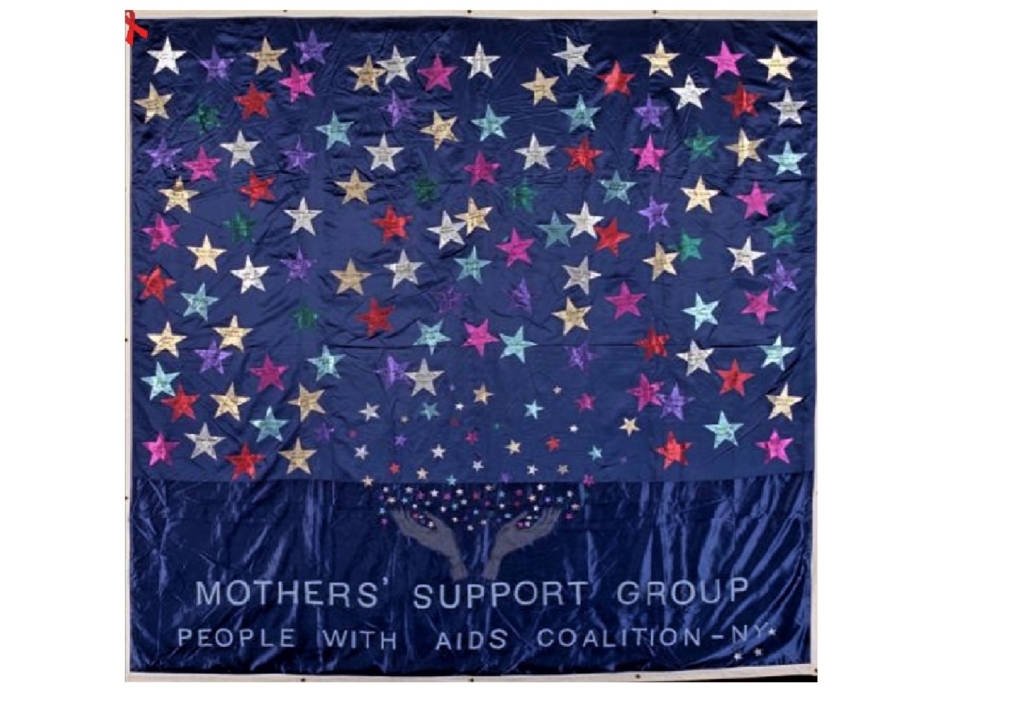
DIVA TV founder and Chicano activist Ray Navarro dies of AIDS-related illness at the age of 26.
Learn More.An active member of ACT UP, Navarro famously dressed as Jesus during a protest held on December 10, 1989 at St. Patrick’s Cathedral in New York. The demonstration called out the Roman Catholic Church’s position on abortion rights, gay rights, and safe sex education.
Already visibly sick, Navarro led protestors in chants (“We’re here to say, we want to go to heaven, too!”) and became the “camp superstar” of the documentary Like a Prayer, which covered the demonstration. Navarro’s activism was also featured in the documentary How to Survive a Plague.
In 1989, Navarro was one of several ACT UP-New York members who founded DIVA TV, a gay and lesbian video activist collective that preserved some of ACT UP’s public displays of civil disobedience. DIVA TV was an acronym for “Damned Interfering Video Activist Television.” Founding members also included Bob Beck, Gregg Bordowitz, Jean Carlomusto, Rob Kurilla, Costa Pappas, George Plagianos, Catherine Saalfield, and Ellen Spiro.
DIVA created three notable video productions:
In February 1990, Navarro presented an AIDS program at the CineFestival in San Antonio, Texas. Shortly afterward, Navarro lost his vision due to cytomegalovirus retinitis, an AIDS-related complication. Shortly before his death in November 1990, he partnered with artist Zoe Leonard to create Equipped, a series of black-and-white photographs of mobility devices paired with provocative phrases.
Posthumously, Navarro’s art was exhibited at the Institute of Contemporary Art in Boston and in Pacific Standard Time: LA/LA. Navarro’s mother, Patricia, became a member of the Ventura County Board of Supervisors HIV/AIDS Committee and speaks publicly about her son’s experiences.
In memory of Ray Navarro and Gerardo Velázquez, Harry Gamboa Jr. wrote the chapter “Light at the End of Tunnel Vision” for the 2018 book Latinx Writing Los Angeles: Nonfiction Dispatches from a Decolonial Rebellion.
* * * * * * * *
Photo of quilt panel from the AIDS Memorial Quilt

Robert Chesley, whose plays were produced by gay theater companies nationwide, dies of AIDS-related illness at San Francisco’s Mt. Zion Hospital. He was 47.
Learn More.“There is no one as articulate and passionate about the issues of gay male sexuality as Robert was as a dramatist,” said actor Michael Kearns upon learning of his friend’s death.
Chesley was known for writing the first full-length play about AIDS, Night Sweat (A Romantic Comedy in Two Acts), which was originally produced at New York’s Meridian Gay Theatre Company and received long runs in Los Angeles and San Francisco.
He also wrote Jerker, or A Helping Hand (A Pornographic Elegy with Redeeming Social Value and a Hymn to the Queer Men of San Francisco in 20 Telephone Calls, Many of Them Dirty). This play had a reading on Los Angeles’ Pacifica Radio that led to complaints from listeners and a lively censorship debate.
Jerker premiered at the Celebration Theatre in Los Angeles, and then had an eight-month run in New York.
“Chesley was driven by a fierce dedication to both gay and erotic liberation,” wrote theater historian Noreen C. Barnes.
“There is nothing that I do that is not influenced by [Chelsey’s] audacity,” said actor Michael Kearns.
* * * * * * * *
Photo of quilt panel from the AIDS Memorial Quilt
Dancer and choreographer Antonio Mendes — who performed with the Pacific Ballet, San Francisco Opera Ballet, Marin Civic Ballet and the National Ballet of Portugal — dies of AIDS-related illness at the age of 41.
Learn More.Mendez was also Director of the Redwood Empire Ballet in Santa Rosa, where he also taught. Mendes was fired from the Redwood Empire Ballet when the organization’s board members learned he had AIDS.
Mendez is memorialized in the project Dancers We Lost: Honoring Performers Lost to HIV/AIDS.
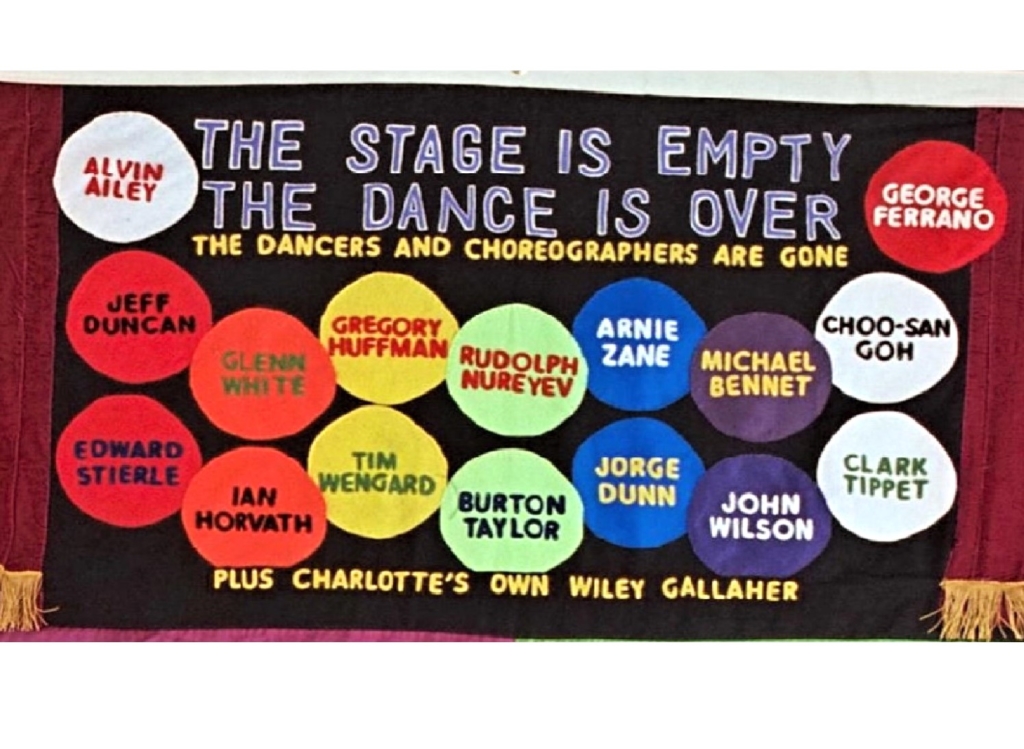
Former leading dancer with the Joffrey Ballet, known for his speed, lightness and strong acting ability, Burton Taylor dies of AIDS-related illness in White Plains, New York at the age of 47.
Learn More.Taylor danced such roles as Captain Belaye in John Cranko’s Pineapple Poll and Arthur Saint-Leon in Robert Joffrey’s Pas des Deesses. Taylor made his professional debut with the Eglevsky Ballet in 1959. He joined the American Ballet Theater in 1962 and the Joffrey in 1969, dancing with the company through 1978.
Taylor also wwas a contributing editor of Dance magazine from 1979 to 1983, and wrote several dance articles for The New York Times.
* * * * * * * *
Photo of quilt panel from the AIDS Memorial Quilt

Lou Graydon Sullivan dies at the age of 39, the first transgender man to die of AIDS-related illness.
Learn More.Sullivan was an activist and author known for his work on behalf of trans men. A pioneer of the grassroots female-to-male (FTM) movement, he is largely responsible for the modern understanding of sexual orientation and gender identity as distinct, unrelated concepts.
He founded FTM International, and his activism and community work was a significant contributor to the rapid growth of the FTM community during the late 1980s.
Born in 1951 in Milwaukee, Wisconsin, Sullivan was raised in a very religious Catholic family. At age 10, he started keeping a journal, describing his early childhood thoughts of being a boy, confusing adolescence, sexual fantasies of being a gay man, and his involvement in the Milwaukee music scene.
He continued to express confusion about his identity throughout his adolescence, writing at age 15, “I want to look like what I am, but don’t know what someone like me looks like. I mean, when people look at me I want them to think — there’s one of those people … that has their own interpretation of happiness. That’s what I am.”
By 1975, Sullivan identified himself as a “female-to-male transsexual,” and two years later, he moved from Milwaukee to San Francisco in the hopes he could find “more understanding” and access hormones for his transition. He got a job with the Wilson Sporting Good Company, where he was employed as a woman but presented as a man much of the time. In his personal life, Sullivan lived as an out gay man, but he was repeatedly denied gender affirmation surgery because of his sexual orientation. At that time, transgender people were expected to adopt stereotypical heterosexual opposite-sex gender roles. This rejection led Sullivan to start a campaign to remove homosexuality from the list of contraindications for gender affirmation surgery.
In 1979, at the age of 28, Sullivan was finally able to find doctors and therapists who would accept his sexuality. He began taking testosterone and underwent a double mastectomy surgery the following year. He started a new job as an engineering technician so that he could fully embrace his new identity as a man with new co-workers.
Shortly after undergoing genital reconstruction surgery in 1986, Sullivan was diagnosed as HIV positive and told he only had 10 months to live. He wrote, “I took a certain pleasure in informing the gender clinic that even though their program told me I could not live as a Gay man, it looks like I’m going to die like one.”
In June 2019, Sullivan was one of the inaugural 50 American “pioneers, trailblazers, and heroes” inducted on the National LGBTQ Wall of Honor within the Stonewall National Monument in New York City. In August 2019, Sullivan was one of the honorees inducted in the Rainbow Honor Walk in San Francisco’s Castro neighborhood.
* * * * * * * *
Photo of quilt panel from the AIDS Memorial Quilt

Edward Stierle, a leading dancer with the Joffrey Ballet who recently created two ballets for the company, dies of AIDS-related illness at St. Vincent’s Hospital in New York City. He was 23 years old.
Learn More.Known to his friends as “Eddie,” Stierle had a reputation for speed, virtuosity, and authentic characterization. New York Times dance critic Anna Kisselgoff described him as “a stunning talent, delving unabashedly into images of emotional turbulence” and pronounced his Empyrean Dances, which premiered just days before his death, as “a rarity, a visionary ballet.”
Born in Hollywood, Florida, Stierle began to study dance at age 4, and enrolled in the North Carolina School of the Arts at age 15. The following year, he won a gold medal at the International Prix de Lausanne Competition, and joined the Basel Ballet, where he danced for a year.
In 1989, he won top honors at the International Ballet Competition in Jackson, Mississippi, where he caught the attention of judge Robert Joffrey. Shortly after, Stierle joined the Joffrey Ballet, according to The New York Times. He was 18 years old.
With a height of 5’6″, Stierle was short for a dancer, but he impressed everyone with his strength and grace.
“Dancing with Tina LeBlanc, one of his favorite partners, in La Vivandiere Pas de Six, his ebullient flights through the air resolved themselves in precise landings. As Puck in Frederick Ashton’s The Dream, Stierle wove a shimmering, magical skein of leaps and spins. In The Green Table, Stierle’s Profiteer was intrinsic to Kurt Jooss’ classic picture of war’s corruption,” Los Angeles Times art critic Janice Berman wrote in March 1991. “In a company filled with fine performers, Stierle made himself a standout.”
Stierle learned that he was HIV-positive in 1987, and then was diagnosed as having AIDS in late 1990.
Then 22 years old, Stierle told the LA Times: “It changed my life dramatically, but it didn’t ruin it. I didn’t just crumble. In actuality, I started living more.”
His illness caused him to put dancing aside, but he turned his energies to choreography, creating works that were presented during the company’s three-week 1991 season at Lincoln Center.
Stierle said that when he disclosed his illness to the Joffrey company, everyone responded with support and empathy.
The impact of HIV/AIDS had already been felt by the Joffrey Ballet community. The founder of the company, Robert Joffrey, died of AIDS-related illness on March 25, 1988, at the age of 57. At the 1990 premiere of Lacrymosa, Stierle dedicated his work to the memory of Joffrey.
Stierle is memorialized in the project Dancers We Lost: Honoring Performers Lost to HIV/AIDS.
* * * * * * * *
Photo of quilt panel from the AIDS Memorial Quilt
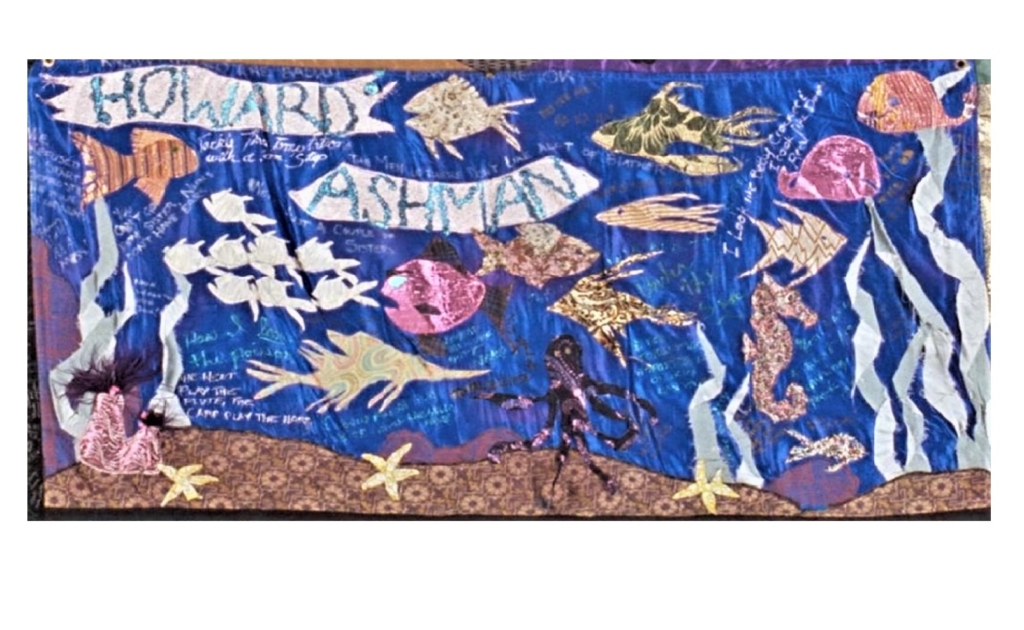
Howard Ashman, the award-winning lyricist “who gave a mermaid her voice and a beast his soul,” dies at St. Vincent’s Hospital in New York City at the age of 40.
Learn More.Born in Baltimore in 1950, Ashman would rise to prominence in the musical theater world in 1977, when he became the artistic director of New York City’s WPA Theatre, an off-off-Broadway theater with 99 seats. This is where Ashman’s collaboration with composer Alan Menken began.
Their first musical was Kurt Vonnegut’s God Bless You, Mr. Rosewater in 1979 (which Vonnegut himself approved of). Then in 1982, Ashman went on to conceive, write and direct Little Shop of Horrors, again with music by Alan Menken. The musical, based upon Roger Corman’s 1960s-era horror flick, was immediately successful.
In 1986, Howard wrote and directed the Broadway musical, Smile, which featured music by Marvin Hamlisch. Little appreciated at the time, Smile is now considered a lost gem of musical theater and is performed by high schools and amateur groups around the U.S.
Smile closed after just 48 performances, and Ashman decided to accept an offer from Disney Pictures and moved to Los Angeles.
“Here’s what you need to know about Disney in 1986: it was a total mess,” writes Peter Knegt in his column Queeries. “The 1970s and 1980s are what many refer to the company’s ‘dark period,’ peaking with 1985’s massive financial disaster The Black Cauldron.
Ashman showed up just in time to rescue Disney’s animation department. Of the prospective projects presented to Ashman, one grabbed hold of him right away — an adaptation of Hans Christian Andersen’s The Little Mermaid. He took charge of the project and brought in Alan Menken to help him.
“The animation studio was basically shutting down,” Jodi Benson, the voice of Ariel in The Little Mermaid, recalled in 2016. “When we did our film, we didn’t even have an animation division over at the lot; they’d been kicked off and in these little cubicles in this run-down place…. It was just unbelievable to think that Walt’s vision was dying.”
It was during production of The Little Mermaid that Howard discovered he was infected with HIV. Despite his illness, he continued to work, giving the story his particular point of view.
In early meetings with Little Mermaid directors Ron Clements and Jon Musker, Ashman made a suggestion that would change cinematic history: What if Sebastian the crab, Ariel’s guardian, was Jamaican?
“Now we can’t imagine hearing ‘Under the Sea’ any other way,” writes Maureen Lee Lenker for Entertainment.
Ashman also steered the animators toward his favorite design option for the sea witch Ursula, one based on drag star Divine.
“And really, to think that an openly gay man inserted a queer icon into the essence of a lead character in a Disney film in the late 1980s is incredibly radical,” writes Peter Knegt. “It would be even today.”
Ashman continued to keep his diagnosis secret, enduring eight-hour days at Disney World doing press. To receive his daily treatments via IV infusion, he had a catheter in his chest. He was expected to go on rides, and was too afraid to tell people that it would be too painful.
Over the next few years, Ashman was pivotal in the renaissance of Disney animated musicals and in the development of The Little Mermaid (Producer and Lyrics), Beauty and the Beast (Executive Producer and Lyrics) and Aladdin (Lyrics), all with music by Alan Menken.
Beauty and the Beast premiered as an unfinished film at the 1991 New York Film Festival, but Ashman wasn’t there to see it and hear the rapturous applause during the closing credits. He had died eight months before its release.
Ashman’s contributions to the revival of classic Disney animated musicals have been acknowledged by many but were perhaps best expressed by his Disney colleagues, who dedicated the film Beauty and the Beast to his memory: “To our friend Howard, who gave a mermaid her voice and a beast his soul. He will be forever missed.”
Ashman’s numerous awards include two Oscars, two Golden Globes, four Grammys, a Drama Desk and a London Evening Standard. Ashman won his second Oscar posthumously in 1991, for his work on the title song for Beauty and the Beast, and this became the first Oscar given to someone who had died of AIDS.
In 2001, Disney inducted Ashman into its Legends program, an honor reserved for animators, Imagineers, songwriters, actors, and business leaders who made a significant impact on the Disney legacy.
In 2020, Disney+ released Howard, a documentary about Ashman and his work as an award-winning lyricist. Directed and written by Don Hahn, the film tracks Ashman’s rise from a theater-obsessed kid in Baltimore, to his musical highs and lows, and to his untimely death. His story is told through archival photos, song demos, new interviews with family and friends, and a filmed recording session from Beauty and the Beast.
* * * * * * * *
Photo of quilt panel from the AIDS Memorial Quilt

Marc Connors, a member of the Canadian a cappella group The Nylons, dies of AIDS-related illness at the age of 41.
Learn More.Known for their covers of pop songs such as The Turtles’ “Happy Together” and The Tokens’ “The Lion Sleeps Tonight,” The Nylons began performing in 1978. Marc Connors (pictured lower right) was one of the four original members of the group.
“The singers merged elements of doo-wop with R&B; and pop and delivered the package tightly bound in articulate arrangements that favored simple tempos and straightforward tonalities,” wrote Los Angeles Times music critic John D’Agostino in 1991.
After releasing their fourth album, Seamless, in 1984, the group was invited to perform on the Canadian children’s television show Sharon, Lois & Bram’s Elephant Show to sing one of the songs on the album, “The Lion Sleeps Tonight.” They also attracted new fans in the U.S. from their performance of the theme song to the mid-1980s sitcom Throb, starring comic actor Diana Canova.
Angela F.M. Pancella, author of Voice and Style: Marc Connors of The Nylons, included in the biography the following passage that Connors wrote in his journal:
“I am dying. It’s now clear I will not recover. I am sad for my parents and especially for Ian. And my sisters, friends and fans. My death will affect a wide circle of people. And yet I’m not really that important or significant. Altho [sic] who is? I guess I most wanted to be someone who contributed to people’s lives, the way I cherish Chaplin or Tchaikovsky or so many book and filmmakers and actors. I’ve had some effect in that area-I’ve moved and excited people. I’m sorry I haven’t left more of an intellectual legacy….
“As I write all this I wonder what it is that I regret, what I could want to live for? I’ve traveled, but not everywhere I wanted. I wanted to go to Africa, to Bali, to know France and speak French for real, to speak Italian. To live in Greece. To be a hit in Paris. To write. I don’t know what. To win an Academy Award. To build a home. To work in wood. To have a theatre company and do good work. To write a symphony. To make a lot of money. To live in Kyoto. To make a wonderful movie, like Miss 1000 Spring Blossoms. To build wonderful low-cost apartment buildings that work to create beauty, nature, friendship and community. To market great healthy food. To help Mom to have that restaurant. To do anything to make them both happy. Build them a house. To really deal with issues and important thoughts of life today in works of art. To add to the world’s faith by disseminating my credo. To beat AIDS. To be a beacon for others to help them believe it can be done and that the spiritual is real. To write my life — in real honesty, all the sexual warts and all. I wish I had been more courageous, less a nervous wreck. A better actor. Less critical of myself, less depressive, unstable. But just as searching. I don’t have many ‘achievements,’ but many satisfactions. I don’t think life is about achievements anyway…”
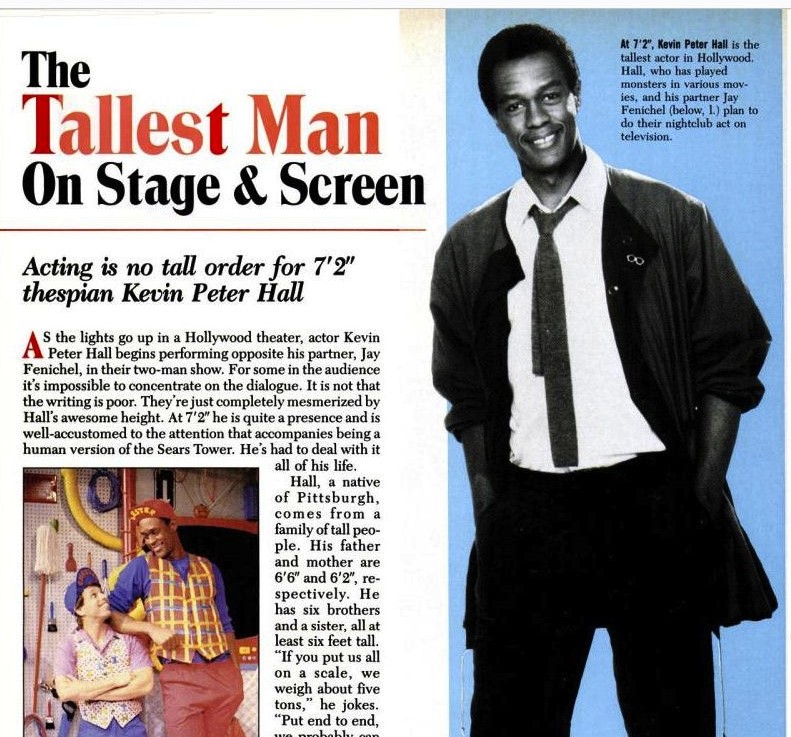
Kevin Peter Hall, a 7’3″-tall actor known for his TV and film roles as monsters, dies of AIDS-related illness a month short of his 36th birthday.
Learn More.Hall’s enormous stature landed him numerous roles in films and TV as monsters and aliens, most famously as the title role in the 1987 science fiction action film Predator and its 1990 sequel, Predator 2. He is also remembered for playing Harry the Sasquatch in the 1987 film Harry and the Hendersons and in the television series of the same name.
Hall became known in the industry for mastering the technique and art of performing in often-cumbersome masks and costumes.
“When you look at Kevin Peter Hal in that wardrobe, makeup and with that size, and you see him against Arnold [Schwarzenegger] you believe ooh-ooh, Arnie’s in trouble,” Predator co-star Carl Weathers said in The Man Behind the Predator featurette. “He made it work. Kevin Peter Hall really made the thing work.”
When Rick Baker won the 1988 Academy Award for Makeup for his work on Harry and the Hendersons, he thanked Hall for his “brilliant performance.”
In 1990, Hall was reprising his role as Harry for TV when he announced that he had contracted HIV from a contaminated blood transfusion following a car accident. He portrayed Harry for the first sixteen episodes of Harry and the Hendersons before his illness forced him to give up the role.
A monster on the screen, in real life Hall was known as big-hearted and “a sweetheart of a guy.”

Phil Zwickler, who directed documentaries and wrote articles about the AIDS crisis, dies of AIDS-related illness at his home in Manhattan. He was 36 years old.
Learn More.Zwickler’s films included Rights and Reactions: Lesbian and Gay Rights on Trial, an account of the 1986 New York City Council hearings on the gay rights bill.
The documentary, which Zwickler produced and directed with Jane Lippman, won the Gold Plaque at the 1987 Chicago International Film Festival and a special jury prize at the 1988 San Francisco Film Festival, according to The New York Times.
Zwickler also collaborated with the experimental German film maker Rosa von Praunheim on the documentaries Silence Equals Death and Positive. Exploring the the rage and frustration of people with AIDS, the films were screened at the Berlin International Film Festival and then at the New York Public Theater as part of the 1990 Documentary Festival of New York.

Nicholas Dante, who won a Pulitzer Prize and a Tony Award as a co-author of A Chorus Line, died of AIDS in New York City at the age of 49.
Learn More.Dante started his career as a dancer, appearing in the choruses of shows, including Applause, on television shows and in nightclubs. His experiences became one of the prominent stories in A Chorus Line,” which ranks among the top ten longest-running shows in Broadway history.
His own story — about growing up poor in New York City and feeling scorned and lonely because of his homosexuality — was told by Sammy Williams, who won a Tony Award as best supporting actor for his portrayal of the character, Paul.
Dante described his lonely childhood and his illness in a 1991 Jimmy Breslin column.
“I grew up in the Forties, a Puerto Rican kid on 125th and Broadway, and obviously gay,” he told Breslin. “Nobody would hang out with me … I was terrified to go out where anybody could see me.”
Directed and choreographed by Michael Bennett and with music by Marvin Hamlisch, A Chorus Lie was produced by Joseph Papp for the New York Shakespeare Festival in 1975 and then moved to the Shubert Theater, where it had 6,137 performances before closing in April 1990.
By then, three of the show’s five creators had died: Bennett in 1987, lyricist Edward Kleban in 1987, and co-writer James Kirkwood in 1989.
* * * * * * * *
Photo of quilt panel from the AIDS Memorial Quilt
Thomas Lasorda Jr., the only son of the Los Angeles Dodgers iconic manager, dies of AIDS-related illness at his Santa Monica home. He was 33 years old.
Learn More.The cause of Lasorda Jr.’s death was reported to be “pneumonia and severe dehydration,” although it was widely known that he was gay and had AIDS. Lasorda Jr.’s death certificate read: “Immediate cause: a) Pneumonitis – 2 weeks. Due to: b) dehydration – 6 weeks. Due to c) probable Acquired Immune Deficiency Syndrome – 1 year.”
After his son’s death, Lasorda Sr. publicly denied that his son died of AIDS, claiming that his illness was cancer, and asked that all charitable donations in Tommy Jr.’s name go to the Association of Professional Ball Players of America.
“My son wasn’t gay,” Lasorda Sr. told Peter Richmond, who wrote about the complicated father-son relationship for GQ magazine in 1992.
“I was FURIOUS!” West Hollywood journalist Karen Ocamb wrote on The AIDS Memorial Instagram page. “Tommy Jr. was a fashionista around WeHo … I was so furious at this deliberate homophobic erasure especially at a time when the announcement could have done so much good.”
Lasorda Jr., who was known as “Spunky” to friends and family, was born in Greenville, S.C. in 1958 while his father was still playing for the Montreal Royals in the Triple-A minors. A few years later, Lasorda Sr. ended his pitching career and took a job as a scout for the Dodgers organization, which by then had moved its major league team from Brooklyn to Los Angeles. The Lasorda family moved from Greenville, where family matriarch Jo was born and raised, to the Los Angeles-area city of Fullerton.
As a teenager, Lasorda Jr. attended Fullerton’s public high school, Sunny Hills, where friends remembered him as having “a style and a self-assurance uncommon in a man so young.” His friends were all girls and his interests were fashion and beauty.
After graduating, he enrolled in the Fashion Institute of Design and Merchandising and took a lackadaisical approach to his studies, according to his classmate Cindy Stevens. He moved to West Hollywood, described by writer Peter Richmond in GQ magazine as “a pocket of gay America unlike any other, a community bound by the shared knowledge that those within it had been drawn by its double distinction: to be among gays, and to be in Hollywood.”
Lasorda Jr. immersed himself in the unparalleled nightlife of WeHo, becoming known in the community as someone to be seen, adorned in a royal blue waistcoat or a tailored Edwardian gabardine jacket, his face meticulously enhanced with make up, and his bleached hair styled according to his whims.
Described by Richmond as “a man of striking looks, with long blond hair, startlingly and wincingly thin,” Lasorda Jr. would visit Rage, the Duck Club, Club Zero and especially Rose Tattoo, a club with male strippers.
He also spent considerable time at his father’s ballclub and on the road with the team, sharing Lasorda Sr.’s love of the game. There, Lasorda Jr. befriended Glenn Burke, who played for the Dodgers. Burke’s teammates knew Burke was gay and were seemingly accepting of it.
But Lasorda Sr. “didn’t like him because of his sexuality,” according to John Casey of The Advocate. “So Burke started the friendship with the junior Lasorda, and it raised eyebrows and ire at that time, as it most certainly would have in the mid-1970s in professional sports.”
In the mid-1980s, Lasorda Jr. decided to adopt a markedly different routine, one “of health clubs and abstinence and sobriety and religion,” Richmond wrote for GQ. “But by then, of course, the excesses of the earlier years had taken their inexorable toll.”
He moved to Santa Monica, just far enough away from the temptations of West Hollywood. As his illness progressed, his celebrated beauty began to fade. Still, he continued to dress with elegance and distinction, and he would occasionally visit some of his old haunts.
When Lasorda Jr. died in early June of 1991, he was surrounded at his bedside by his parents and his sisters, the LA Times reported. By all accounts, he was well-loved by his family. His memorial service was attended by Frank Sinatra and Don Rickles, and Pia Zadora sang one of Lasorda Jr.’s favorite songs, “The Way We Were.”

Thomas Hannan, co-founder of the first PWA buyers’ club, dies at his Manhattan home of AIDS-related illness. He was 40 years old.
Learn More.In the early 1980s, Hannan was in Europe pursuing a career as an opera singer, but returned to New York City when the AIDS crisis hit. In 1986, he founded the Public Works Administration Health Group with Joseph Sonnabend and Michael Callen.
As the first and largest formally recognized buyers’ club, the PWA Health Group widened access to people with AIDS seeking AIDS therapies not yet approved by the Food and Drug Administration, according to Prabook.com.
Hannan also helped to establish the nonprofit Community Research Initiative (CRI, later renamed CRIA, then ACRIA) in New York in 1987, becoming the organization’s administrative director. Frustrated and outraged by the slow pace of government-sponsored and academic HIV/AIDS research, members of CRI created the first-ever activist-led, community-based approach to the study of new treatments for the disease.
One of CRI’s early achievements was a trial that contributed to the approval of inhaled pentamidine for preventing Pneumocystis pneumonia, a common AIDS-related infection. Since then, the organization has contributed to the development of a remarkable 20 medicines that have gone on to receive FDA approval.
* * * * * * * *
Photo of quilt panel from the AIDS Memorial Quilt
Performer-writer Philip Mills, who performed in drag in San Francisco under the name Doris Fish, dies of AIDS-related illness at the age of 38.
Learn More.Co-founder with Miss X and Tippi of the long-lived Sluts-a-Go-Go drag trio, Doris would perform songs and skits based on such cult favorites as The Valley of the Dolls.
Mills would co-write and (as Doris Fish) star in the cult film classic Vegas in Space (1991).
Steven Grossman, the first openly gay music artist to address the concerns and sensibilities of gay life in his work, dies of AIDS-related illness at his San Francisco home at the age of 39.
Learn More.Grossman’s only album, Caravan Tonight (1974), was hailed by Stephen Holden in Rolling Stone as “one of the most auspicious singer/songwriter debuts of the ’70s.”
According to Joseph Dalton of Queer Music Heritage, Caravan Tonight is regarded as a landmark, because it was the first recording for a major label by an openly gay artist whose work addressed gay life. Caravan Tonight was recorded in late 1973 and early 1974, at a time when Alice Cooper, David Bowie, and Lou Reed were using androgyny and gender-bending as flamboyant symbols to subvert popular culture.
“Grossman wasn’t interested in pandering to clichés. Instead he offered a painfully honest portrait of a sensitive gay man’s real life,” writes biographer and New York Times writer James Gavin. “Wild promiscuity was the accepted defiant lifestyle, but Grossman’s songs ached with sadness and some disapproval over the frivolity of the new so-called ‘liberation,’ which had made commitment unfashionable.”
“His voice is great and his songs personal and beautiful,” wrote Vito Russo in Gay Magazine. “He is going to be the one to bridge the gap between straight and gay audiences.”
“Grossman’s simple and heartfelt message and persona stood out in sharp contrast to the hypersexual posturings of bigger rock stars of the era,” William Lang said of Caravan Tonight. “Steve isn’t cute about his sexuality like David Bowie; nor does he see sexuality as a spice for an innocent’s view of decadence, as does Alice Cooper; nor does he invent a never-never land to exploit as do the New York Dolls. Steve sings of a gay world that is familiar to most of us.”
Caravan Tonight sold around 15,000 copies — not enough, apparently, for Mercury Records to renew Grossman’s contract.
“If this record appeared today, it would still be relevant, but probably no more successful,” wrote Robert Cochrane in Culture Catch. “Consider this a parable of the poverty attached to the sin of innovation.”
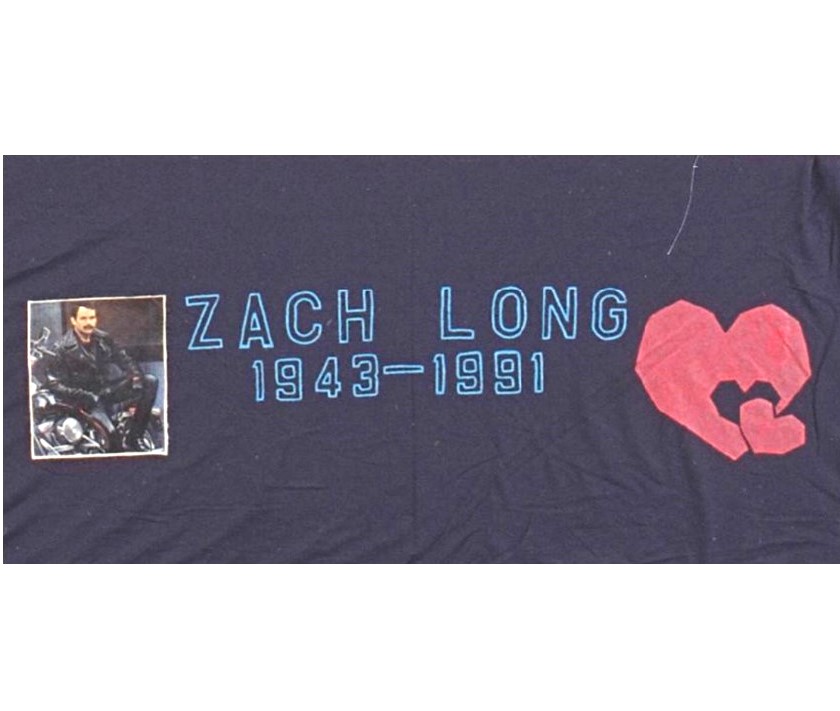
Zachary Long, a Bay Area activist celebrated for his ability to raise thousands of dollars for the HIV/AIDS cause, dies of AIDS-related illness at Davies Hospital at the age of 48.
Learn More.“In the galaxy of activists in the San Francisco community, the name of Zach Long consistently glowed brilliantly and with a strong sense of caring, loving and perseverance,” wrote the Bay Area Reporter. “And while that glow is no longer visible, it will remain in the minds and hearts of all of us who were priviledged to know that handsomest of gentlemen.”
Long served on the board of directors for the Larkin Street Youth Center and the AIDS Emergency Fund. He was also a ruling elder at the Old First Presbyterian Church and a volunteer for the San Francisco Symphony and the San Francisco Opera. He was voted “Man of the Year” at the 1991 Cable Car Awards in San Francisco.
In the leather community, Long was known as Zach Daddy Leather V, and was a semi-finalist in the 1988 International Mr. Leather competition. Just a month before his death, he led the San Francisco Freedom Day Parade as the Grand Marshall. In April, at the Mr. San Francisco Leather competition, San Francisco Mayor Art Agnos honored Long’s many accomplishments by proclaiming April 20 to be “Zach Long Day.”
Born in Charlotte, North Carolina, Long graduated from Davidson College with a Bachelor’s in Economics and then the University of North Carolina with a Master’s in Business Administration. He served in the U.S. Army as a first lieutenant in the Signal Corps, and was posted in Seoul, Korea.
* * * * * * * *
Photo of quilt panel from the AIDS Memorial Quilt
Erik Mead, who performed in San Francisco venues under the drag name Tippi, dies of AIDS-related illness at the age of 39.
Learn More.With drag queens Miss X and Doris Fish, Tippi created the performance group Sluts-a-Go-Go in San Francisco. They would create and perform drag shows for 10 years in Bay Area venues like Club 181.
Tippi would also perform in a featured role in the camp cult film Vegas in Space (1991), written by Philip Mills (who performed in drag as Doris Fish). Favorites of the Castro district drag scene, Doris and Tippi produced a weekly cable news show in 1986 about the gay community.
Mead and Mills were roommates, and Mills would precede Mead in death by two months.
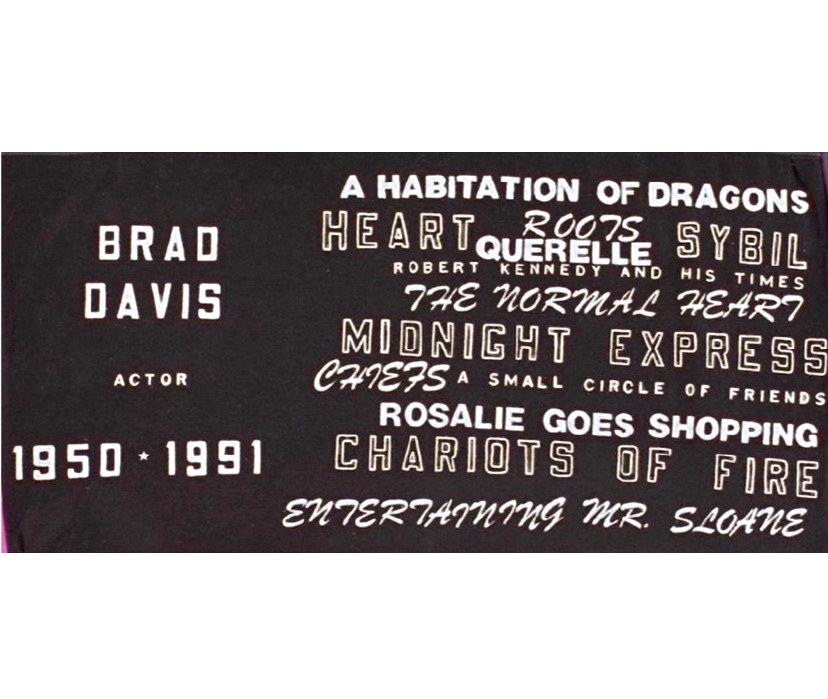
Brad Davis, a film actor known for his powerful performances in Midnight Express (1978) and Chariots of Fire (1981), dies of AIDS-related illness in Los Angeles at the age of 41.
Learn More.Davis also played lead roles in the film Querelle (1982) and in Larry Kramer’s The Normal Heart (1985).
In early December 1985, Cedars-Sinai Medical Center notified Davis that he was HIV-positive, probably the result of intravenous drug use, according to Davis’ wife of 15 years, Susan Bluestein Davis. In an interview with South Coast Today, Bluestein said that her husband’s diagnosis needed to be kept secret in order for him to continue working in the film industry.
“I make my money in an industry that professes to care very much about the fight against AIDS,” Davis wrote in a book proposal developed in the final weeks of his life. “But in actual fact, if an actor is even rumored to have HIV, he gets no support on an individual basis. He does not work.”
Davis’ book, which his wife would complete, would be titled After Midnight: The Life and Death of Brad Davis (1997). According to Bluestein, Davis wanted the world to know that he had been HIV-positive, had developed full-blown AIDS, and had worked in the industry without ever holding up the production of his projects.
In 1978, after landing the lead in Alan Parker’s hit movie Midnight Express, Davis had become an overnight sensation. His quick exposure to wealth and fame led to a series of bad lifestyle choices, and he became addicted to alcohol and drugs.
With his career destroyed and his marriage badly damaged, Davis joined Alcoholics Anonymous in 1981 and became sober. However, the bills from his old lifestyle kept coming due in the form of health problems and then a diagnosis of HIV in late 1985.
Davis kept his condition a secret until shortly before his death in early September 1991. Later, his wife revealed that he committed assisted suicide by a drug overdose.
* * * * * * * *
Photo of quilt panel from the AIDS Memorial Quilt
Robert L. Douty, a Navy veteran who specialized in electronics, dies of AIDS-related illness at Laguna Honda Hospice at the age of 37.
Learn More.Douty served in the U.S. Navy in 1972-1978 as an electronic standards specialist on the USS Dixie and the USS Oriskany. After his military service, he continued to work in electronics at Ford Aerospace until his illness forced him to retire in 1987.
A respected member of the leather community, Douty was an early member of The 15 Association, according to the Bay Area Reporter.

Tony Richardson, an English theater and film director whose career spanned five decades, dies of AIDS-related illness at St. Vincent’s Medical Center in Los Angeles. He was 63 years old.
Learn More.Richardson won the Academy Award for Best Director in 1964 for the film Tom Jones. Richardson’s early films, such as A Taste of Honey and The Loneliness of the Long Distance Runner, were an important part of England’s kitchen sink realism movement.
Born in Shipley, West Riding of Yorkshire in 1928, he attended Wadham College, Oxford, where his contemporaries included Rupert Murdoch, Margaret Thatcher, Kenneth Tynan, Lindsay Anderson and Gavin Lambert.
Richardson’s career began in 1953, when he directed productions of Othello and Dostoyevsky’s Gambler for the BBC. He left television in 1955 to become associate artistic director of the new English Stage Company, eventually becoming joint artistic director.
He directed John Osborne’s play Look Back in Anger at the Royal Court Theatre, while also directing Shakespearean productions in Stratford-upon-Avon. In 1957, he directed Laurence Olivier in Osborne’s next play The Entertainer, again for the Royal Court Theatre. By then, he was well on his way to establishing himself as part of the British “New Wave” of directors.
In 1959, Richardson moved onto film projects, co-founding Woodfall Film Productions with John Osborne and producer Harry Saltzman. Their first production was the film version of Look Back in Anger, which Richardson directed.
He made his first Hollywood film, Sanctuary, in 1960 for 20th Century Fox, according to The New York Times.
At the time, Richardson was critical of big Hollywood studios for being afraid to take risks.
“It’s impossible to make films that appeal to everyone, and the only solution is to make them at a non-prohibitive cost, and to try to adhere to a strong, independent point of view that will appeal to at least one body of customers: the ones who want to be stimulated by provocative ideas,” he said in 1960.
In 1962, Richardson and actress Vanessa Redgrave were secretly married, but Redgrave sought and received a divorce five years later. He would father two daughters with Redgrave, and another daughter with Grizelda Grimond.
Richardson was bisexual, but never acknowledged it publicly until after he contracted HIV.
In 1974, Richardson moved to Los Angeles to work with Sam Shepard on a script, which was never realized. His next notable film was the 1984 comedy-drama The Hotel New Hampshire with Rob Lowe and Jodie Foster, which he wrote and directed. Four more major films followed, his last being Blue Sky starring Jessica Lange and Tommy Lee Jones. In all, he directed 23 films, according to the Los Angeles Times.

Jacques Morali, French music producer and creator of the Village People, dies of AIDS-related illness in Paris at the age of 44.
Learn More.The musical group The Village People was originally formed in 1977 by Morali with his business partner Henri Belolo and lead singer Victor Willis.
Morali hired Willis as a background singer for an album he was producing for the Ritchie Family, and saw in him the potential to be the star of his new project.
“I had a dream that you sang lead vocals on an album I produced, and it went very, very big,” Morali reportedly told Willis, according to The Village People website. “I have four tracks. I can’t pay you much right now but if you agree, I’ll make you a star.” Willis agreed and the rest is history.
Those initial four tracks were San Francisco (You’ve Got Me), In Hollywood (Everyone’s a Star), Fire Island, and Village People. Willis performed the songs with professional background singers and they were released as the album Village People. When the album became a fast hit, Morali and Belolo moved fast to find more members for the group.
The Village People’s iconic characters were developed to appeal to disco’s large gay audience. With its members portraying various gay-fantasy personas from American culture, the group became so popular, their music broke through the confines of the club scene to enjoy mainstream success worldwide.
With Willis, Morali wrote their biggest hit, “Y.M.C.A.,” which was added to the National Recording Registry of the Library of Congress in March 2020. Morali (with Belolo and Willis) wrote another big hit with “Go West.”
During the late ’70s and early ’80s, Morali produced nearly 70 disco albums. But when the disco craze faded in the early ’80s, Morali and Belolo would follow up Village People’s success by developing the pop-rap act Break Machine and bringing breakdancing to Europe.
After Morali’s death, Belolo turned to licensing European pop dance acts, such as 2 Unlimited, Eiffel 65, Gala and Haddaway, for the French market.
* * * * * * * *
Photo of quilt panel from the AIDS Memorial Quilt
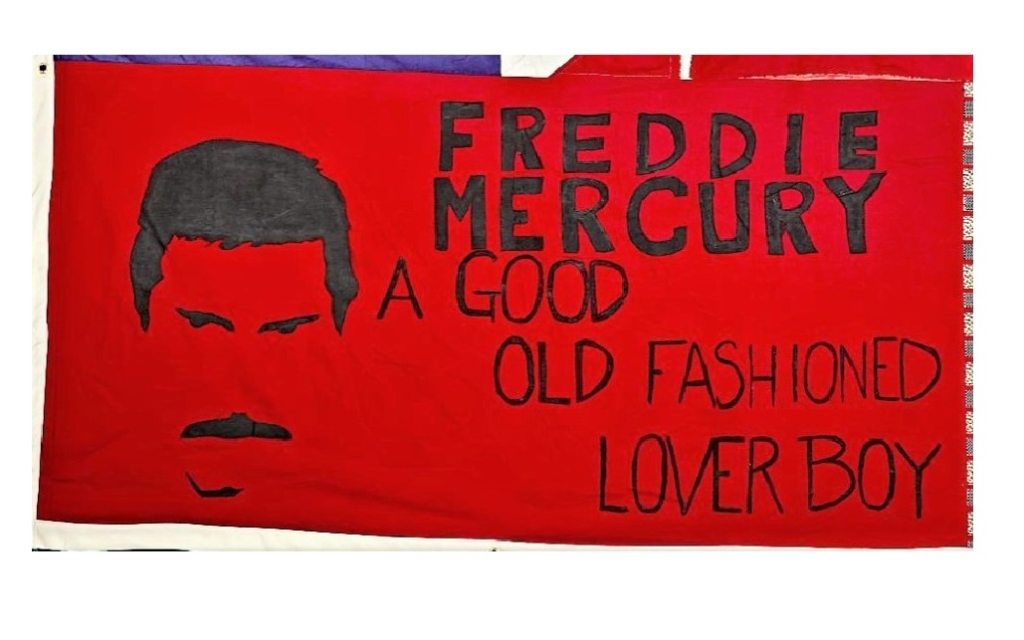
Freddie Mercury, the lead singer-songwriter for the rock band Queen, dies at the age of 45 of AIDS-related illness at his home in west London one day after he publicly announces he is HIV positive.
Learn More.Regarded by fans and critics alike as a consummate showman, Mercury was openly bisexual and enjoyed a colourful rock-star lifestyle.
Born Frederick Bulsara on the East African island of Zanzibar on September 5, 1946, Mercury studied piano in boarding school in India, then befriended numerous musicians at London’s Ealing College of Art.
Mercury would become famous for being one of the rock world’s most versatile and engaging performers and for his mock operatic masterpiece, ‘Bohemian Rhapsody.’ Released in 1975, the six-minute song was nearly never released due to its length and unusual style.
But Mercury insisted to his bandmates and music executives that it be included in their album “A Night at the Opera” and the song would go on to be a worldwide hit and timeless rock anthem.
When members of the music community began to become sick and die from AIDS, Mercury would express fear about becoming infected with HIV, recalls friend Peter Freestone, who believes the singer first suspected he was ill as early as 1987.
For the final two years of his life, Mercury would keep his illness secret from everyone, except those he was closest to, according to his bandmates, and he would live in almost total seclusion.
Only Freddie’s close family and friends were invited to his funeral.
Ten years later, Mercury and Queen would be recognized for their contributions to American music history when they are inducted into the Rock and Roll Hall of Fame in 2001.
* * * * * * * *
Photo of quilt panel from the AIDS Memorial Quilt
Paul Martin Heltsley, a writer for Drummer and other leather-related magazines, dies of AIDS-related illness at his home in San Francisco. He was 29 years old.
Learn More.Heltsley, who wrote under the name Paul Martin, was an assistant editor at Drummer magazine and often led workshops at QSM and San Francisco State Unviversity. He was one of the founders of San Francisco Leather Bears and a member of the National Leather Association and the Phoenix Uniform Club.
Heltsley also composed music in a variety of genres, including jazz, punk and electronica. Prior to moving to San Francisco in 1988, he performed in a punk band in Seattle.
“He cared passionately about the physical , psychological and spiritual implications of Leather and SM,” Heltsley’s partner, Roy Cameron, told the Bay Area Reporter.
“As an expression of his deep personal love of the people in his life, and his desire not to have his friends worry about him, Paul remained silent, even to the end, as to the seriousness of his illness,” Camerson said.
A tree was planted in the AIDS Memorial Grove at San Francisco’s Golden Gate Park as a permanent tribute to Heltsley.

Stan Hadden, a senior administrative aide to California Senate President Pro Tempore David A. Roberti and one of the most influential voices on AIDS policy in Sacramento, dies of AIDS-related illness at the age of 35.
Learn More.As fierce fighter for HIV/AIDS policy for 10 years, Haddon is credited with shepharding the creation of the California AIDS Advisory Committee in 1983 and writing legislation supporting a coordinated approach to local HIV/AIDS programs and services in 1985.
According to Stephen Colbrook’s paper “Clandestine Networks and Closeted Bureaucrats: AIDS and the Forming of a Gay Policy Network in California,” Haddon was a key player among policymakers who jumped into action when the AIDS crisis unfolded. When Hadden learned that a new deadly disease was spreading through San Francisco’s gay community, he brought the epidemic to the attention of his boss, David Roberti, who was the president of the California senate.
Colbrook wrote:
“Hadden quickly emerged as a pivotal figure in California’s response to the AIDS crisis. He was affable, forthright, and pragmatic, burnishing a well-deserved reputation as the AIDS Tsar of California. By 1987, his monthly AIDS newsletter had 25,000 subscribers, and his correspondence reached beyond California to activists in Texas, Illinois, and New York.”
Sen. Roberti provided Hadden with a significant degree of autonomy, with which Hadden used to craft a large portion of California’s early AIDS legislation, including Senate Bill 1215, which expanded the state budget for prevention education by $11 million. Passed in 1985 by an overwhelming bipartisan majority in both the Assembly and Senate at a time when budget funds were thin, SB 1215 cemented California’s leading role in addressing the HIV/AIDS crisis. In 1985, nearly half of the total state spending on the AIDS epidemic was attributed to California, according to Colbrook.
Hadden’s leadership also throughout the 1980s also helped steer California’s action on the epidemic toward a focus on patient confidentiality and individual rights. This focus was not always adopted by other states in their approach to the AIDS crisis. On the other end of the spectrum was Texas, whose political leaders created policy centered on the disease’s perceived threat to the heterosexual population.
Hadden was one of only a few in the 1980s Sacramento political scene who were open about their LGBT identity, journalist Karen Ocamb would later write in The Pride. Scores of administrative and political aides to California legislators remained in the closet, fearful that open knowledge of their sexual identity would end their professional careers. Elected officials and potential candidates who identified as LGBT also remained silenced by the very real fear of ruination.
In the final two weeks of his life, Hadden received round-the-clock nursing care as part of a hospice program. Sacramento AIDS Foundation spokeswoman Patty Blomberg noted that the AIDS care Hadden received might not have existed if it were not for his influence and persistence.
Blomberg told the Sacramento Bee that Hadden had slipped into a coma early that morning and then died at about noon at his farmhouse along the Sacramento River, surrounded by friends and family who had flown in from as far away as Michigan.
Hadden’s funeral would bring in friends and colleagues from around the state, including Ocamb and John Duran, then President of the Board of LIFE AIDS Lobby who would become Mayor of the City of West Hollywood.
“In a gesture unheard of for the suits of Sacramento, a huge rainbow flag was unfurled and solemnly marched down the street to the Capitol,” Ocamb recalled.
“Stan’s memory will go on, because he made a contribution to this state that many of us can only dream of making,” Senate President Pro Tem Roberti said during Hadden’s memorial service at St. Francis Church in midtown Sacramento.
* * * * * * * *
Photo of quilt panel from the AIDS Memorial Quilt

Robert Wiley Kirk — known as “Cirby” in the Bay Area leather community — dies of AIDS-related illness at a hospice in San Francisco. He was 48.
Learn More.Cirby had a notable talent for erotic and leather-themed art, and his work was featured in gay publications and displayed in bars coast-to-coast. His artwork was also included in the leather-bound publication The Hun Coloring Book. He was also a proud Leatherman who competed in various competitions.
Cirby was born in Texas in 1943, and after working in Denver as a model and club dancer, he moved in the late 1960s to San Francisco, where he took on a number of jobs, including acting, modeling and bartending. He moved to Los Angeles around 1973 and became a bartender at Griff’s. It was in LA where a friend took notice of his artistic talent and helped him set up his first art show.
Cirby became sober in 1984, and worked as the accountant for the St. James Club. In 1990, he returned to San Francisco, where he made a positive and prolific impact on many in the recovery community.
* * * * * * * *
Photo of quilt panel from the AIDS Memorial Quilt

Richard Hunt, a puppeteer known for his work on The Muppet Show, dies of AIDS-related illness at Cabrini Hospice in Manhattan at the age of 40.
Learn More.Hunt, a native of the Bronx, was a member of Jim Henson Productions for more than 20 years, as the performer behind Scooter, Janice, Junior Gorg and many other characters from the popular television programs The Muppet Show, Sesame Street and Fraggle Rock.
He directed several episodes of these shows, and was a puppeteer in the Henson films The Muppet Movie, The Great Muppet Caper, The Muppets Take Manhattan and Jim Henson’s Muppet Vision 3-D, a Disney/MGM Studios Theme Park attraction.
Hunt was known by his co-workers on Sesame Street and other projects for his accomplished singing voice and his warm backstage personality. He served as a mentor to newer puppeteers, taking new hires to lunch. He was often observed reading a newspaper as he was performing a character and doing that character’s lines.
“When he is not working on camera, he is apt to have Scooter or Beaker or Janice — anyone — on his arm for the purpose of entertaining visitors to the studio. If there are no visitors around, he will attempt to entertain his co-workers,” wrote Christopher Finch in his book Of Muppets and Men.
Among his last productions were The Muppets Celebrate Jim Henson, Sesame Street’s Sing, Hoot & Howl, and Muppet Sing Alongs: Billy Bunny’s Animal Songs (the last of which was released in 1993, one year after his death). Several episodes of Sesame Street’s 23rd season featuring new Hunt performances aired posthumously as well.
In the period immediately following his death, few of Hunt’s characters (with the notable exceptions of Beaker, Statler, and Sweetums) were recast with new performers. Scooter was retired and absent as a character in all Muppet productions until 1999 with Muppets from Space. On Sesame Street, characters originated by Hunt usually appear only in background cameos.
The Richard Hunt Spirit Award is presented annually at the Sesame Street wrap party to the cast member who best honors the generosity in spirit and dedicated work of Richard Hunt in their actions on set.
* * * * * * * *
Photo of quilt panel from the AIDS Memorial Quilt

Jerry Nolan, drummer for the band The New York Dolls and a punk rock pioneer, dies of AIDS-related illnesses at St. Vincent’s Hospital in New York. He was 45.
Learn More.The New York Dolls was an early 1970s glam-rock band that had a profound influence on bands as diverse as the Sex Pistols to Motley Crue. Nolan joined the band in 1972 after the original drummer, Billy Murcia, died of a drug overdose while on tour in the U.K. he played on the Dolls’ first two albums (New York Dolls and Too Much Too Soon).
Nolan and bandmate Johnny Thunders left the Dolls of 1975 to form a new band, The Heartbreakers, with Richard Hell. By this time, both were addicted to heroin.
Malcolm McLaren, the manager of The Sex Pistols, booked The Heartbreakers in 1976 for the doomed Anarchy in the UK tour, where they only played seven of the 19 booked gigs. As chaotic as the tour was, The Heartbreakers managed to get a record deal from the exposure and released their first and only album, L.A.M.F.” in 1977.
L.A.M.F. initially received poor reviews, largely due to its poor production quality, but appreciation for the work has grown over time. New Musical Express magazine named L.A.M.F. one of the greatest albums of all time.
The band became so iconic of the punk scene that it appears on the cover of what is arguably the definitive book on the punk rock era, Please Kill Me: The Uncensored Oral History of Punk.
What also accompanied The Heartbreakers’ reputation as a punk rock super-band was the band members’ problem with heroin addiction. In fact, their drug habit was immortalized in the song “Chinese Rocks,” co-written by Johnny Thunders and Dee Dee Ramone of The Ramones.
Unable to produce a second album, the band broke up and Nolan began a series of music projects and his creative output began to dwindle. In late 1991, after years of intravenous drug use, Nolan was hospitalized at St. Vincent’s Hospital for bacterial meningitis and bacterial pneumonia. During treatment, he suffered a stroke and went into a coma, from which he never recovered. He spent his final weeks on a life support system.
In 2017, Nolan’s story was featured in Stranded in the Jungle: Jerry Nolan’s Wild Ride – A tale of drugs, fashion, the New York Dolls, and Punk Rock, by Curt Weiss. In the book, many who knew Nolan described him as a top musician and charismatic performer. He was also known as “a racist, a junky and a ruthless exploiter of the many women who fell for him,” according to a book review by Only Rock and Roll.
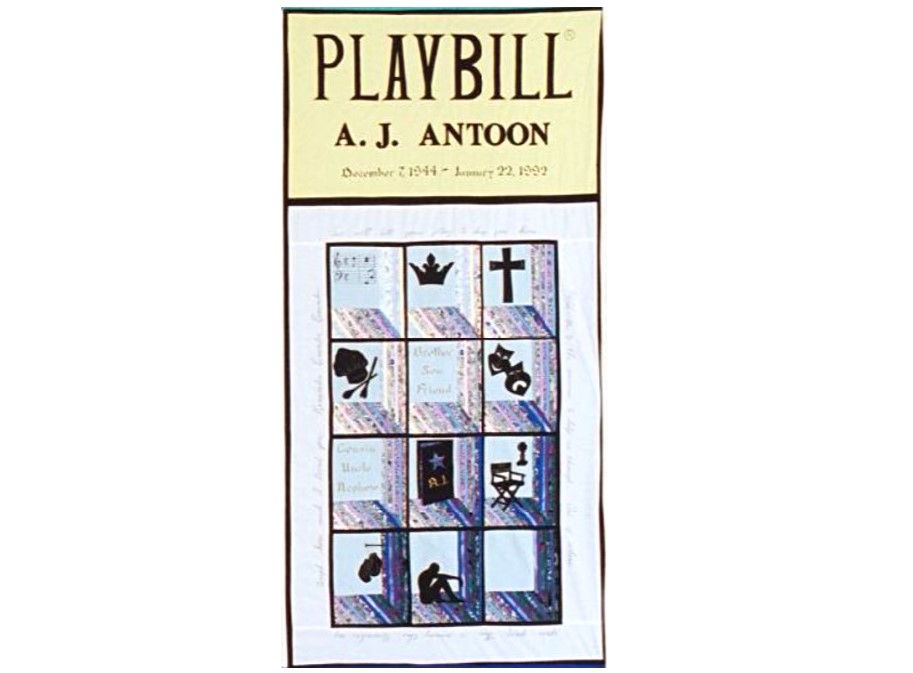
A.J. Antoon, a Tony Award-winning director, dies of AIDS-related illness New York University Medical Center. He was 47.
Learn More.Antoon directed both classics and new plays for Joseph Papp at the New York Shakespeare Festival for a 20-year period.
He began working for Papp at the Public Theater in 1971 with Subject to Fits. The next year, at the age of 27, he rose to fame with the production of That Championship Season (which won him a Tony Award).
The same year, he directed the Shakespeare Festival’s production of Much Ado About Nothing, which was so successful, it moved from Central Park’s Delacorte Theater to Broadway. His Much Ado was acclaimed for his fanciful, imaginative touch to the production, according to the New York Times.
His last New York Shakespeare Festival production was a Wild West version of The Taming of Shrew, starring Morgan Freeman and Tracey Ullman, in 1990. At the time of his death, Antoon’s Off-Broadway musical Song of Singapore was being performed and would go on to win a 1992 Drama Desk Award.
* * * * * * * *
Photo of quilt panel from the AIDS Memorial Quilt

Clark Tippet, a choreographer and principal dancer with American Ballet Theater, dies of AIDS-related illness at the Labette County Medical Center in Parsons, Kansas. He was 37 years old.
Learn More.Tippet was considered one of the most promising ballet choreographers of his generation, according to New York Times art critic Jennifer Dunning.
“Tippet stood out onstage for his strong dramatic presence and a witty sense of style and theatricality that made him believable in a wide range of ballets, from the demanding pyrotechnics of Prince Siegfried in Swan Lake to the second male lead’s slippery fast-moving part in Twyla Tharp’s Push Comes to Shove to the brooding High Brahman in La Bayadere to Carabosse, the evil fairy, in The Sleeping Beauty,” wrote Dunning. “He was also a performer who could unobtrusively bring nuance and color to insignificant roles.”
Tippet began studying ballet when he was 5 years old, and by the time he was 11, he had moved from his birthplace of Parsons, Kansas to New York City. At age 18, he became a soloist for American Ballet Theater and was promoted to Principal Dancer three years later.
Tippet began choreographing in 1986, with Enough Said for ABT and followed by four more works. His work Bruch Violin Concerto No. 1, was “thunderously received at its world premiere,” according to The New York Times.
Tippet’s works for ABT also included S.P.E.B.S.Q.S.A (The Society for the Preservation and Encouragement of Barbershop Quartet Singing in America), Rigaudon, Some Assembly Required, and Enough Said.
In 1988, he received an American Choreographer Award and an Excellence of Achievement award from the General Electric Foundation. He also received an award from the National Endowment for the Arts in 1990-91.
Tippet is memorialized in the project Dancers We Lost: Honoring Performers Lost to HIV/AIDS.
* * * * * * * *
Photo of quilt panel from the AIDS Memorial Quilt
Martin “Marty” Robinson, a long-time organizer for gay-rights causes who was known for his provocative protests, died of AIDS-related illness at his Brooklyn home at the age of 49.
Learn More.Robinson was present at the 1969 police raid of the Stonewall, a Greenwich Village bar patronized by members of the LGBTQ community.
Such raids were common, but for the first time, the customers resisted and fought back. Shortly afterward, 2,000 attended a rally in Sheridan Square, where Robinson was a keynote speaker.
An early member of the Gay Activists Alliance, many activists considered Robinson a visionary during the early years of AIDS activism.
One of his mantras was, if it’s not medicine, it’s murder,” activist Bill Bahlman would tell the Act Up Oral History Project in 2010. “He taught me things like it doesn’t matter whether you’re Rock Hudson or a person living on the street, homeless. If you don’t have effective treatments for HIV, you’re going to die.”
In the early 1980s, Robinson headed GLAAD’s Swift and Terrible Retribution Committee, planning demonstrations and developing political “zaps,” chaotic and theatrical interventions intended to attract the attention of the press.
When the Centers for Disease Control planned its 1987 conference in Atlanta with a focus on mandatory testing for HIV, Robinson led activists from his group, the Lavender Hill Mob, into the ballroom of the Marriott Marquis, where a pre-conference cocktail party was being held for attendees.
Activists passed out fliers to the startled participants with the message, “What does CDC stand for? Center for Detention Camps!”
During the three days of the conference, Robinson and the Lavender Hill Mob appeared in various meeting locations with leaflets and noisy chants: “Test drugs, not people!” and “Drugs into bodies now!”
Robinson was also a founder of ACT UP, which was started in New York in the wake of the Lavender Hill Mob’s success. Modeled on the tactics of the Lavender Hill Mob, ACT UP’s approach was bold and headline-grabbing — and effective.
Perhaps one of Robinson’s most important “zaps” was the one at the National Institutes of Health in May 1990, around the time that North Carolina Senator Jesse Helms was trying to block a $600 million AIDS relief bill.
ACT UP members from all over the country descended on the NIH campus in Bethesda, Maryland, setting off smoke bombs and yelling that NIH policies were killing them. Dr. Anthony Fauci, the head of the NIH’s drive to end AIDS, invited several ACT UP leaders inside and listened to them. What he learned brought about the Accelerated Approval process that helped get “drugs into bodies now,” as the ACT UP slogan demanded.
The Marty Robinson Collection of papers and records are currently stored at the Lesbian, Gay, Bisexual & Transgender Community Center in New York.

Considered one of the “Big Three” science fiction writers in America, Isaac Asimov died in Manhattan of AIDS-related illness at the age of 72.
Learn More.The cause of death was initially reported as heart and kidney failure. In 2002, the Asimov family would correct the record to reflect that Asimov died from AIDS-related illness.
A prolific writer, Asinov was best known for writing science fiction attentive to scientific accuracy and logic. He also wrote mysteries, fantasy, and nonfiction.
His most famous work is the Foundation series, the first three books of which won the one-time Hugo Award for “Best All-Time Series” in 1966. His other major works include the Galactic Empire series and the Robot series. In addition, he also wrote over 380 short stories, including the social science fiction novelette “Nightfall,” which in 1964 was voted the best short science fiction story of all time by the Science Fiction Writers of America.
Asimov’s wife, Janet, would make public the details around Asimov’s HIV-positive status in the last 10 years of his life with the posthumous release of his autobiography It’s Been a Good Life.
Asimov suffered a heart attack in 1977, and six years later, he underwent triple bypass surgery at NYU Medical Center, during which he contracted HIV from a blood transfusion. His HIV status was kept secret out of concern that the anti-AIDS prejudice prevelant in the 1980s might extend to his family members.
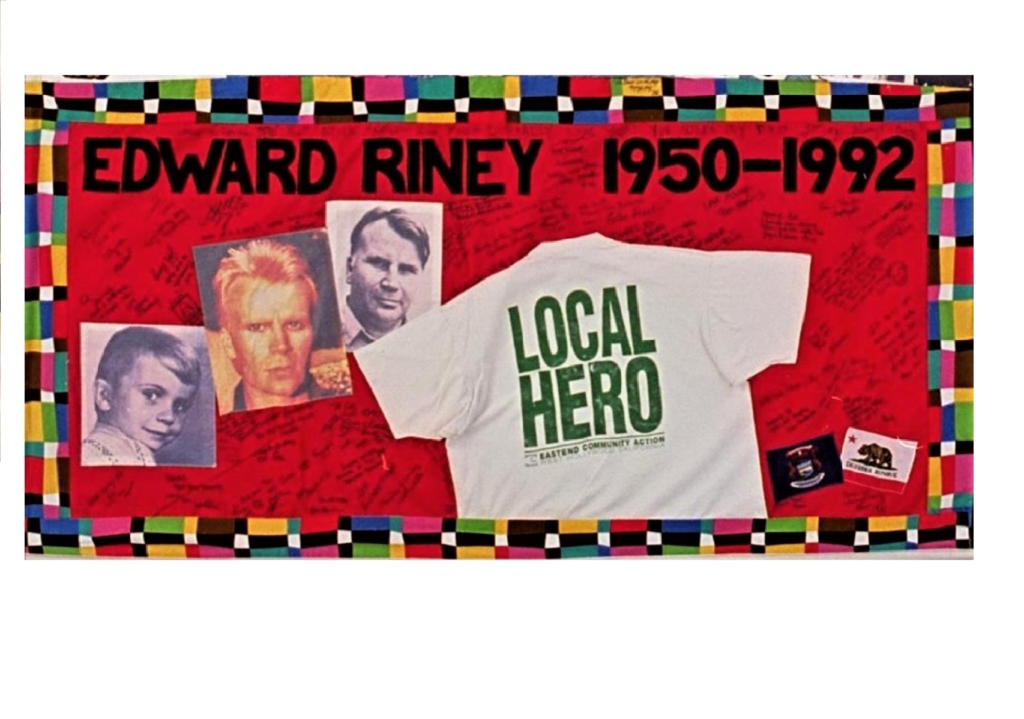
Edward Riney, member of the East End Community Action group in West Hollywood, dies of AIDS-related illness.
Learn More.Riney was well-known in the West Hollywood community as a civically engaged resident who worked tirelessly to improve public safety in the early days of West Hollywood’s cityhood.
He served on the neighborhood watch group on the city’s east side and established himself as a commentator for the Los Angeles Times for local public safety initiatives, such as the passage of a “no camping” law for city parks and removing from Plummer Park a meal program for people experiencing homelessness.
At the April meeting of the City Council, then-Mayor Paul Koretz announced that he would adjourn the meeting in memory of Riney. A moment of silence was also held in Riney’s honor.
At the meeting, longtime resident Jeanne Dobrin spoke of Riney’s dedication to crime prevention and said she appreciated his sense of humor. In addition, resident Gloria Vassy talked about how Riney organized an annual food basket drive during the holidays.
On April 25, the West Hollywood community held a memorial service for Riney in Plummer Park. The following December, the holiday food basket drive was organized in memory of Riney; 150 food baskets were assembled and given out to those in need.
* * * * * * * *
Photo of quilt panel from the AIDS Memorial Quilt
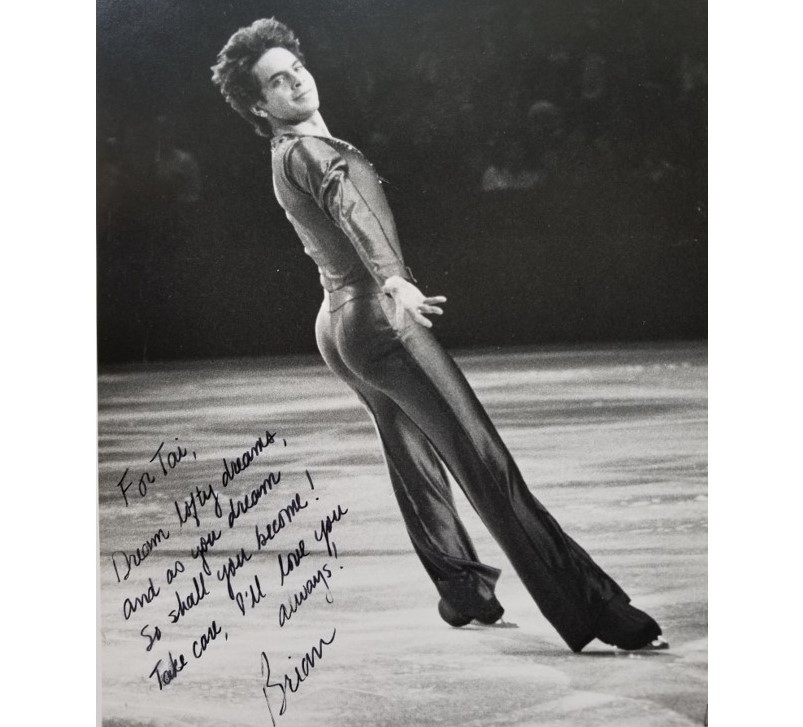
Three-time Canadian men’s champion Brian Pockar dies of AIDS-related illness in Calgary at the age of 32.
Learn More.Pockar was the 1982 World bronze medalist, a Canadian national champion from 1978 to 1980, and competed at the 1980 Winter Olympics. After turning pro, Pockar toured with “Stars on Ice” and worked as a choreographer.
Pockar was the first figure skater to successfully complete a triple one-foot
salchow/double flip combination jump at the World Championships. He was recognized as one of Canada’s best athletes when he was presented with five
Alberta Achievement Awards, and in 1982, was presented with the Government of Canada Sport Excellence Award.
Pockar was very quiet about his struggle with AIDS, according to columnist Filip Bondy of The New York Times.
“Even after his death, Pockar’s family members have tried to avoid sensational revelations,” Bondy wrote in a November 1992 column about AIDS deaths among figure skaters. “Through a spokesman, the family released a simple statement: ‘Brian wanted to be remembered for his accomplishments in life, and not for the cause of his death.'”
Pockar was posthumously inducted into the Skate Canada Hall of Fame. Annually, Skate Canada’s Alberta-Northwest Territories/Nunavut Section hosts the Brian Pockar Male Seminar, which provides training to male figure skaters. The Pockar Foundation helps fund this seminar every year.
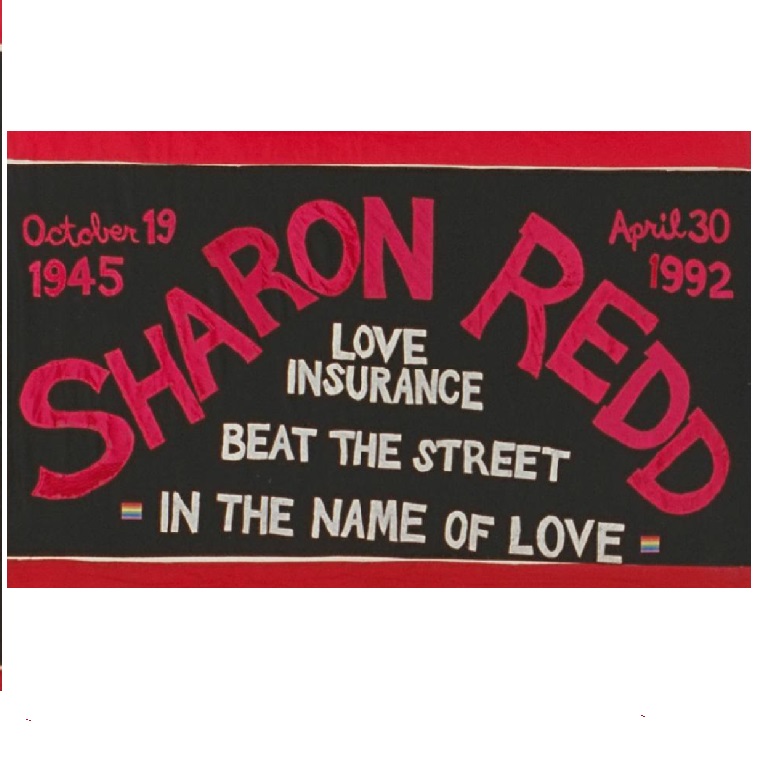
Sharon Redd, a singer and actress whose voice energized nightclubs in the 1970s and 1980s, dies of AIDS-related illness. She was 46.
Learn More.Redd signed with United Artists in 1968 and immediately recorded four singles, which included the Hank Williams song “Half as Much.” She also landed a lead role in the Australian production of the rock musical Hair, and recorded the song “Easy to be Hard” (1969) for the Australian soundtrack of the musical.
“All these records helped her to establish a reputation as a very fine R&B singer with an expressive voice,” writes music critic Stian M. Eriksen. “They reveal a much more soulful Sharon than what you find on most of her club hits of the ’80s.”
After Redd returned from Australia, she won the first “Schaefer Beer Talent Hunt” and became known nationwide as the “Schaefer Beer Girl. This exposure helped her secure a spot as one of Bette Midler’s backup singers (called “The Harlettes”) from 1973 to 1978.
Redd, Charlotte Crossley and Ula Hedwig were thought of as the consummate Harlettes trio, according to the Bette Midler fan site Bootleg Betty.
“Sharon Redd and Charlotte Crossley are two beautiful brown ladies with some of the best pipes in the music business. Add the sleek willowy frame of Ula Hedwig and a voice that ranges from the purest high tones to the gutsiest blue notes, and what you get is some of the freshest and most dynamic music being created in the New York nightclub circuit,” wrote Don Bradshaw (also known as “Mister D”), editor of Bootleg Betty.
To perform with “Miss M,” the Harlettes had to master a wide range of musical styles, ranging from ’30s and ’40s ballads to modern rock, country, blues, and gospel. Their act grew so strong, club owners sought to book The Harlettes as a separate act during the months Midler retreated to write new shows, and they even recorded an album under the name Formerly of The Harlettes.
“With Bette, we learned the importance of theatre, that is, creating a character that enhances the music we were singing,” Redd told an interviewer in 1978. “In addition, this helped to sustain a high-performance level under widely varying conditions and locations. Bette emphasized the importance of the group to her show and we learned to work together.”
Redd also performed vocals with Bonnie Raitt, Gwen McCrae (“Love Insurance”), and Norman Connors (“You Are My Starship”), and by the end of the decade, she had a solo deal with Prelude Records, which was known for disco hits.
During the heyday of disco, Redd released three albums for Prelude. After releasing her first LP, she was steered toward Prelude’s production powerhouses Eric Matthew and Darryl Payne, according to music site Ransom Note.
Matthew and Payne employed the recent technology of drum machines and synthesizers to create an “electronic undercurrent” to Redd’s dynamic vocals, and created a fresh sound that influenced the future of music.
“For me, with Sharon, Eric and Darryl forming their post-disco Prelude triptych, they recorded the definitive proto-House rhythm – building the foundations for what we know as House,” writes the author of House Hunting.
While Redd’s singles didn’t register on radio playlists, they were in constant circulation in the dance clubs. Her “boogie bomb” recordings of “Can You Handle It,” “Never Give You Up,” “Beat the Street,” and “Love How You Feel” became nightclub standards. Many DJs, recognizing the malleability of the work, issued creative re-mixes to extend their popularity.
After her third and final Prelude album, Redd slowed down and occasionally did more session work. She released a new single in 1991, but that would prove to be her final work.
She was diagnosed with HIV and, after stepping on broken glass during a 1992 performance, Redd’s immune system became overwhelmed. Her health steadily declined and she died in May 1992 in upstate New York.
“I made a decision,” Redd told an interviewer in 1978. “This is my life, and I thank God there’s been enough success to make it all seem worthwhile.”
Robert Gladstein, choreographer, dancer and former assistant director of the San Francisco Ballet, dies at his home of AIDS-related illness at age 49. The New York Times and Los Angeles Times report the cause of death as “cancer.”
Learn More.Gladstein was a principal dancer of the San Francisco Ballet in 1970, the company’s ballet master in 1975, and, in 1980, its assistant director and artistic coordinator. In his time with the company, he choreographed more than 30 ballets, including Symphony in Three Movements and Psalms. Some of these works were televised on San Francisco’s PBS station, KQED.
Born in Berkeley in 1943, Gladstein made his debut at age 10 when he danced in a production of The Nutcracker by the San Francisco Ballet School, according to The New York Times. He graduated from the school in 1960.
In 1967, he joined the company of New York’s American Ballet Theatre. After three years, he returned to the San Francisco Ballet as a principal dancer. After assisting in multiple efforts to rescue San Francisco Ballet from near bankruptcy in 1974, Gladstein served as the company’s Ballet Master from 1975 until 1980, when he became the Ballet’s Assistant Director and Artistic Coordinator.
He left California again in 1986 to become ballet master for the Dallas Ballet, a position he held until 1988.
Gladstein also was a member of the dance advisory panel of the National Endowment for the Arts from 1981 to 1986, a time when then-President Ronald Reagan attempted to abolish the federal arts grant program. When Reagan’s efforts to kill the NEA failed, he then began a campaign to defund the program and initially cut its budget in 1981 from $158.8 million to $143.5 million.
The Robert Gladstein Papers, which include performance materials, photography, souvenir books, correspondence, and sheet music from his time at the San Francisco Ballet, are preserved in the Museum of Performance and Design’s Performing Arts Library. Gladstein’s biography is included in the project Dancers We Lost: Honoring Performers Lost to HIV/AIDS.
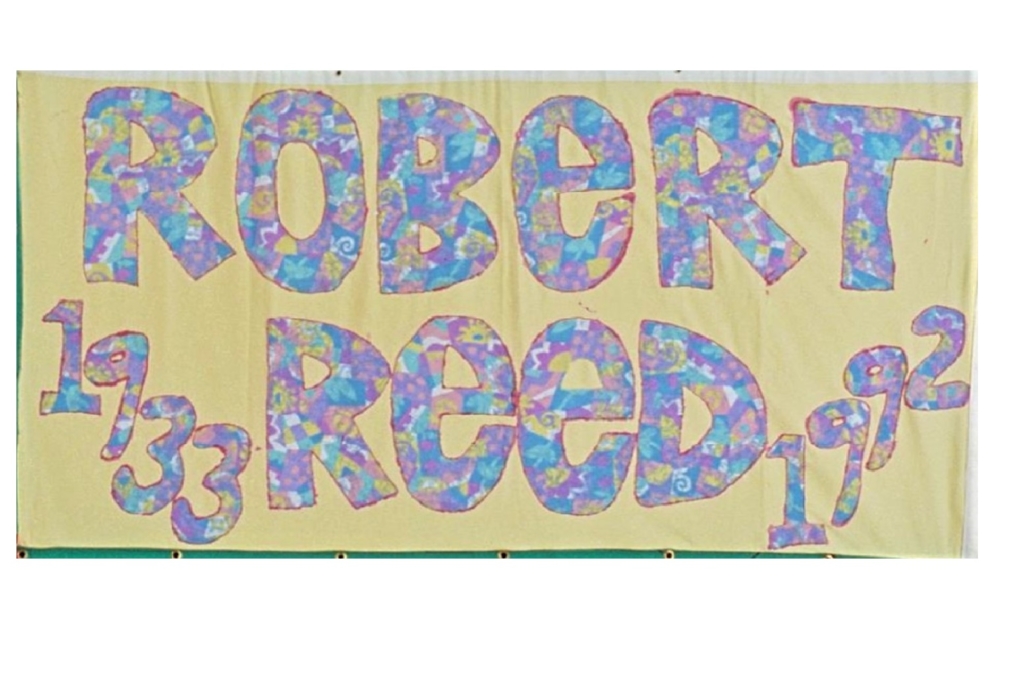
Robert Reed, who played quintessential family man Mike Brady in the popular sitcom The Brady Bunch from 1969 to 1974, dies of AIDS-related illness in Pasadena, California at the age of 59.
Learn More.In 1969, Reed was cast as quintessential family man Mike Brady on the enduring sitcom The Brady Bunch. With a superficial and somewhat charming view of suburban family life, the TV show became a cultural icon of the 1970s, against all Reed’s expectations.
Reed kept it a secret that he was gay until he died in 1992. Co-star Florence Henderson said she knew about Reed’s sexual identity, as did others on the set, but it was never discussed.
“He was an unhappy person,” Henderson said. “Had Bob not been forced to live this double life, I think it would have dissipated a lot of that anger and frustration.”
Behind the scenes of the TV show, Reed battled with its creator, Sherwood Schwartz, over its content. In a 1983 interview with The Associated Press, Reed said that he and Schwartz “fought over the scripts,” and that he thought Schwartz filled the show with “just gag lines. That would have been what The Brady Bunch would have been if I hadn’t protested.”
Despite his frustration with the sitcom, Reed developed close connections with his fellow cast members: He established a lifelong friendship with Henderson, and served as a surrogate father figure to his TV children, Barry Williams, Maureen McCormick, Christopher Knight, Eve Plumb, Mike Lookinland and Susan Olsen.
Reed first gained a TV following in The Defenders, a 1960s dramatic series on which he played a progressive-minded young lawyer whose father was portrayed by E.G. Marshall. He also had roles in the television series The Lawman and Mannix. Earlier in 1992, he filmed an episode of Jake and the Fatman.
Born John Robert Rietz Jr. in Highland Park, Illinois, Reed spent his childhood in Muskogee, Oklahoma and then studied drama at Northwestern University, playing the leading man in eight campus productions. He married fellow student Marilyn Rosenberger in 1954, and they had a daughter named Karen; the marriage ended in divorce in 1959.
After more acting study in England, where he studied Shakespearean drama, Reed returned to the U.S. in the late 1950s and joined a young group of Shakespearian players, with whom he performed in Off-Broadway productions of A Midsummer Night’s Dream and Romeo and Juliet. He made his Broadway debut in 1964, succeeding Robert Redford as the star of the Neil Simon hit play Barefoot in the Park.
After The Brady Bunch and Mannix, Reed continued to find success with TV projects, most notably the miniseries Rich Man, Poor Man (1976), Roots (1977) and Scruples (1980). He received Emmy Award nominations for his work on Roots and Rich Man, Poor Man. He was also nominated for an Emmy for his portrayal of Dr. Pat Caddison, a transgender person, in a 1975 two-part episode of Medical Center, a groundbreaking role for the time.
He also appeared in Brady Buch reunion specials and the popular Brady Bunch Variety Hour, even though he truly loathed the show’s often inane scripts. He did it, because he knew that the other performers would suffer financially if he declined to participate.
At the end of his career, Reed taught Shakespearean-style acting at the University of California, Los Angeles, work which brought Reed great joy. It was short lived however, because of his battle with cancer that was complicated by HIV.
In the last year of his life, Reed called Florence Henderson and asked her to “tell the kids.” She agreed, and said making those phone calls was “the hardest thing I ever had to do.”
His death told America something important: If AIDS could take America’s favorite Dad from The Brady Bunch, the disease was everywhere — and could take anyone.
* * * * * * * *
Photo of quilt panel from the AIDS Memorial Quilt
Robert Pruzan, longtime photographer for the Bay Area Reporter who also created photographic art, dies of AIDS-related illness at Davies Medical Center in San Francisco. He was 45 years old.
Learn More.Pruzman documented the queer history of San Francisco throughout the 1970s and 1980s, according to Gary Aylesworth of the Bay Area Reporter. His work was published in Drummer, Manifest, Sports Illustrated, and the San Francisco Examiner’s Image magazine, as well as in Geoff Mains’ book Urban Aboriginals.
“Although he worked in photojournalism for years, his fine art photography is brilliant and important,” wrote Aylesworth. “There are, perhaps, a quarter of a million slides in his collection.”
Born in 1946 in Seattle, Pruzman studied mime in Paris with Etienne Decroux in the 1960s. As Decroux’s first assistant, he taught mime to many who would become notable performers, like Bill Irwin , Geoff Hoyle, and Leonard Pitt. He returned to the U.S. and taught mime in New York City.
Pruzman took an interest in floral arranging after taking a class in Japanese ikebana, and in 1973, he moved to San Francisco, where he began working as a horticulturist and photographer. Advancing his parallel interests, he became a member of the California Horticultural Society and photographed the first Haight Street Fair in May 1978. He also photographed the Castro Street Fair, early Pride Parades, and the Folsom and Up Your Alley Fairs through 1991.
In addition to documenting San Francisco’s gay and leather communities, Pruzman regularly photographed opera stars like Pavorotti and drag artists like Divine. Harvey Milk, Wavy Gravy, Nancy Pelosi, Jane Dornacker, Robert Mapplethorpe — all were captured by Purzman’s camera.
Friends told the Bay Area Reporter that Pruzman’s apartment was filled with exotic plants. He curated many gardens throughout the Bay Area, and longtime friend Nancy McNally said Pruzman inspired her to create the AIDS Memorial Grove in Golden Gate Park, which would open about a month after Pruzman’s death with a memorial service and planting in his honor.
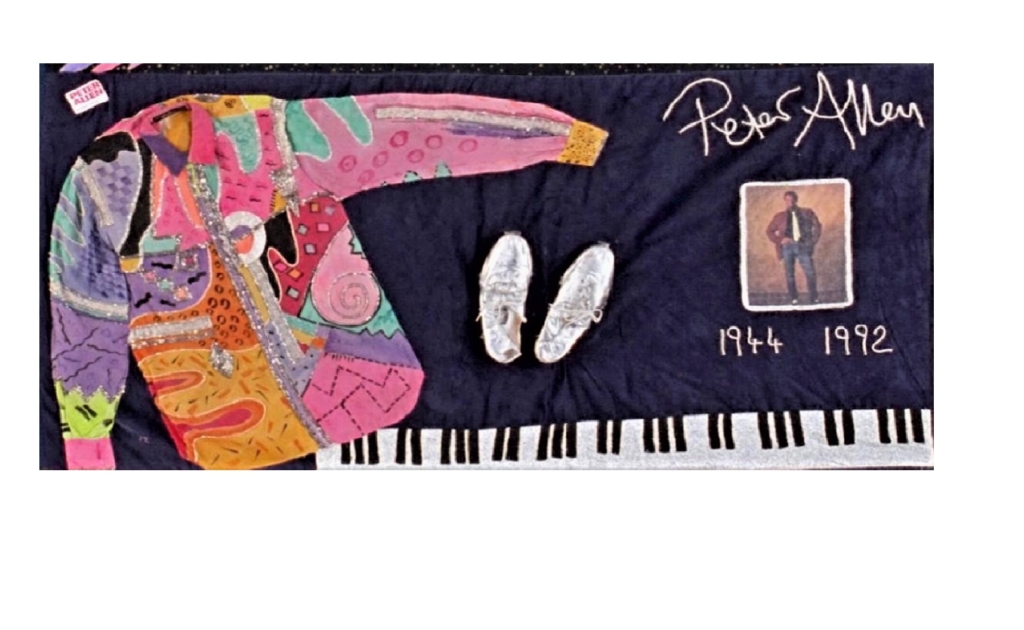
Concert entertainer and songwriter Peter Allen dies of AIDS-related illness in San Diego at the age of 48.
Learn More.Allen drew audiences in the thousands to his shows at Radio City Music Hall, Carnegie Hall, Avery Fisher Hall and Central Park. Energetic, charismatic and often flamboyant, he once rode onstage on a camel, another time on an elephant.
Starting his career in show business as a child, Allen sang in school shows and neighborhood pubs in his native Tenterfield, Australia, with the encouragement of his mother. After his father committed suicide, he dropped out of school at the age of 14 to help to support his family. To increase his pay as a teenage entertainer, he learned to dance and play piano, and wrote original songs.
He got his break in 1964 when Garland saw him perform in Hong Kong and hired him to be her opening act. He met and then married Garland’s daughter, Liza Minnelli in 1967. Over the next few years, Minnelli’s movie career took off like a rocket while Allen remained a relatively unknown performer, except on the New York cabaret circuit. After Garland died in 1970, Allen’s marriage to Minnelli deteriorated and they divorced in 1974.
Over the years, he recorded 11 albums and performed live in venues ranging from cabarets and bath houses to Broadway theaters and concert halls. He once gave a special performance for Queen Elizabeth II, and he won an Oscar for writing the theme music to the 1981 film Arthur.
This song, which included a line about being “caught between the moon and New York City,” became a No. 1 hit. He also wrote for other films, including All That Jazz.
His signature songs (which he wrote) were “I Go to Rio” and “Quiet Please, There’s a Lady Onstage,” the latter which was dedicated to Judy Garland.
Allen never made a public announcement that he had HIV, fearing audiences wouldn’t want to see a performer who was sick. He may also have feared alienating conservative, heterosexual fans: Allen didn’t pretend to be straight after divorcing Minnelli, but he never publicly came out as gay either.
Even many of his friends didn’t know he was sick until January 1992, when he began chemotherapy and radiation treatment for AIDS-related throat cancer.
Allen’s last performance was on January 26, 1992 in Sydney, Australia, where he performed to packed houses. He died less than five month later.
In 1995, music journalist and film writer Stephen MacLean directed The Boy from Oz, an Australian TV documentary on Peter Allen. MacLean’s similarly titled book was published the following year and became the inspiration for a stage musical written by Nick Enright.
With Enright’s book adapted by Martin Sherman, and a revision of the musical content, The Boy from Oz premiered at the Imperial Theatre on Broadway with Hugh Jackman giving a Tony-winning performance as Allen. The show opened in October 2003 and played for a year. A Japanese version followed in June 2005. The Boy from Oz was revamped yet again for an enormously successful Australian arena production with Hugh Jackman in 2006.
* * * * * * * *
Photo of quilt panel from the AIDS Memorial Quilt

Roger James Thompson, who was among the first in San Francisco to be diagnosed with AIDS, dies of AIDS-related illness at Kaiser French Hospital. He was 44 years old.
Learn More.Thompson was diagnosed with Kaposi’s sarcoma in 1982, and battled AIDS for 10 years. He owned a carpentry business which was known for “exquisite craftmanship,” according to the Bay Area Reporter.
Born in 1948 in Santa Monica, Thompson grew up in Los Angeles’ West Side and attended college at the University of Southern California. He continued his education at Cambridge University as a Fulbright Scholar.
After returning to the U.S., the City of Los Angeles hired him to work in the Department of City Planning. He relocated to New York City and then again to San Francisco, where he remained for the rest of his life.
Thompson became active in civic affairs, bringing to the public forum his background in architecture and city planning. He also worked as a dresser for the San Francisco Opera House, which helped satisfy his appetite for opera. He also was a proud member of the City Bears Club.
* * * * * * * *
Photo of quilt panel from the AIDS Memorial Quilt
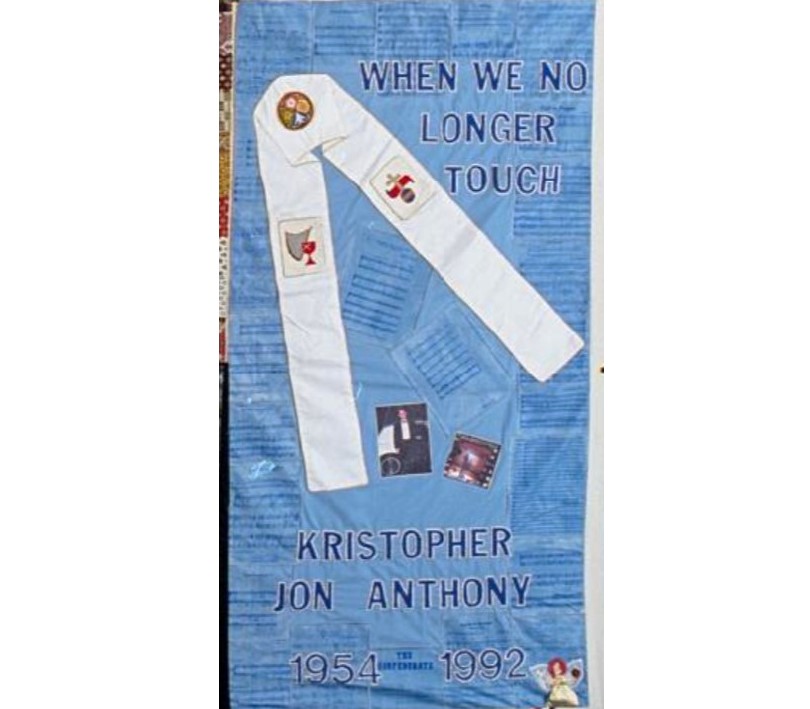
Kristopher “Kris” Anthony, composer-in-residence for the Turtle Creek Chorale, dies of AIDS-related illness at his Dallas home. He was 38.
Learn More.Anthony first composed for the Turtle Creek Chorale in July 1982 and he continued to compose for and sing with the Chorale until the end of his life. His work for the Chorale culminated in his composition for When We No Longer Touch: A Cycle of Songs for Survival, a choral rendition of the stages of grief that was composed by composer-in-residence Kristopher Anthony.
During that time with the Turtle Creek Chorale, he composed and created arrangements and revoicing for the following productions:
Anthony was also director of music for the Central Christian Church and a member of the Dallas Handbell Ensemble. Originally from Onalaska, Wisconsin, Anthony received his Bachelor degree from the University of Wisconsin-La Crosse and his Masters in Music Theory and Composition from the University of Miami, according to the Dallas Voice. He moved to Texas to pursue his doctorate degree at the University of North Texas.
Anthony found a home for his talents at the Turtle Creek Chorale, which was founded in early 1980, according to Michael Sullivan in The Dallas Way. The group was named after the small stream that passed through the queer-friendly Dallas neighborhood of Oak Lawn.
“In some cities, the newly-formed choruses boldly chose to use the word ‘gay’ in their name, but in the buckle of the Bible Belt, the founders of just such a chorus in Dallas decided against it for what seemed obvious reasons,” Sullivan wrote in 2017.
Chief among those reasons was the fact that many of the singers were public school teachers, and the local superintendent was a a notoriously homophobic man who threatened to fire openly gay teachers.
The group first rehearsed in February 1980 with 39 singers. On June 24, 1980, 70 members of the Chorale gave its first formal concert at the campus of Southern Methodist University in Dallas. By the end of its first season, the group had grown to 83 members.
In 1985, HIV/AIDS began to impact the Chorale. As members began to get sick and die, the group transformed to become a space for its members to grieve and heal through performance and community, according to the University of North Texas’ 2017 exhibit Threads of Remembrance.
In its 1987 holiday performance, the Turtle Creek Chorale placed a poinsettia on the piano to honor the memory of those who had died of HIV/AIDS. When the number of fatalities reached 20, the tradition evolved into having a poinsettia placed at the front of the stage for each individual.
In April 1994, PBS would televise the documentary After Goodbye: An AIDS Story, which looked at the impact of epidemic on the Turtle Creek Chorale. The film follows the Chorale through rehearsals and performances of When We No Longer Touch: A Cycle of Songs for Survival, a choral rendition of the stages of grief that was composed by Kristopher Anthony.
At the time the documentary was filmed in 1993, the Chorale had already lost more than 90 members to AIDS, including Anthony.
By 2013, the AIDS death toll at the Chorale would reach 197. Still to this day, during its holiday performances, the group places on the stage a field of poinsettia plants, one for each Chorale member who has passed.
* * * * * * * *
Photo of quilt panel from the AIDS Memorial Quilt
Robert Nemchik, who was known to channel his rage about the AIDS crisis in ACT UP demonstrations, dies of AIDS-related illness at Cedars-Sinai Hospital in West Hollywood. He was 28 years old.
Learn More.Nemchik was an active member of the Los Angeles chapter of ACT UP (AIDS Coalition to Unleash Power) and also volunteered for AIDS Project Los Angeles (APLA), an organization providing care and services to people with HIV/AIDS, according to the Bay Area Reporter.
Less than a year ago, in October 1991, Nemchik joined 4,000 activists in Sacramento to protest California Governor Pete Wilson’s veto of a bill supporting gay and lesbian rights. He arrived at the state capital in a bus from Los Angeles bearing the banner “Gay and Lesbian Freedom Ride.”
“This is what keeps me alive now. This is what it’s all about,” Nemchik told the Los Angeles Times. “I would like to think before I die, that everyone gets the rights they deserve. I want to go thinking I made a difference.”
Randall Klose, longtime gay-rights activist and fund-raiser, dies of AIDS-related illness at his home in Washington, DC. He was 37.
Learn More.Klose said he had been inspired to become an activist by Larry Kramer’s essay “1,112 and Counting” in The New York Native in 1983. In that essay, Kramer demanded to know why wealthy homosexuals were not responding to the AIDS crisis.
“I read the article, and said to myself, ‘Here I am,'” Klose said.
At the time, Klose was a Beverly Hills developer with strong connections to the LGBTQ community. He started raising money for the Gay and Lesbian Community Services Center of Los Angeles (now the Los Angeles LGBT Center) and the Triangle Institute.
On June 1, 1987, Klose was among those arrested at a White House demonstration protesting the lack of an AIDS response from President Reagan.
He then helped organize and finance lobbying efforts for the 1988 AIDS research and education law, a cornerstone of the comprehensive federal AIDS effort. He later became co-chairman of the Human Rights Campaign Fund’s board of directors, and helped the fund’s budget grow from $1 million to $5 million in a few years.
In 1991, Klose helped lead a U.S. contingent to the meeting of the International Lesbian and Gay Human Rights Commission in Moscow, one of the first publicized gatherings of LGBTQ people in Russia.
Klose contributed much of his own wealth to organizations conducting HIV/AIDS research and providing social services. In addition to his earnings as a developer, his wealth included an inheritance from his father, who owned Dairy Queen franchise in Texas, with 800 outlets.

Alison Gertz, who said she contracted the AIDS virus during her first sexual encounter at age 16 – and who publicized her misfortune to show that anyone can be at risk – dies at her parents’ home on Long Island at the age of 26.
Learn More.Gertz drew international attention by telling her story as a warning to heterosexuals and women. A television movie based on her diaries and starring Molly Ringwald, Something To Live For, raised awareness about HIV/AIDS with millions of TV viewers. An HIV/AIDS information hotline that ran after the film generated a record 189,251 calls within 24 hours, mostly from women
When Gertz first publicly told her story, in an interview with The New York Times in 1989, the AIDS epidemic was widely perceived as confined to homosexual men, intravenous drug abusers and blood-transfusion recipients.
She fit none of those categories. Her story was all the more dramatic because of the privilege she was born into, with artistic talent, affluence, private schools and social prominence.
Following her diagnosis, Gertz became a crusader, speaking at schools, colleges and public events. Esquire named her Woman of the Year, and she appeared on the cover of People magazine.
The People article describes Gertz as “pretty, poised and privileged,” but with a forever-changed future due to her AIDS diagnosis. Gertz shares with the reporter her goal of warning young people about the risk of unprotected sex and stopping what happened to her from happing to others.
“They might not listen to their parents or pay attention to the news,” she told People, “but they might understand it coming from me because I’m one of them.”
When she was well enough, Gertz lectured at high schools and colleges.
An only child, Gertz was born in Manhattan and grew up on Park Avenue. Her father, the grandson of a founder of Gertz department stores, is a real-estate investor. Her mother cofounded a national chain of fashion stores, Tennis Lady.
Educated at Horace Mann School, Ms. Gertz studied art at Parsons School of Design. At 22, she was beginning a career as an illustrator.
“I was just, as they say, starting out in life,” she said, with hopes of marriage and children.
Gertz’s mother Carol also became an advocate for HIV treatment and research. In 1989, two close friends helped Carol Gertz start the nonprofit organization Concerned Parents for AIDS Research (CPFA), with the hope of developing a cure.
Initially supported by a circle of longtime friends, the network of fund-raisers soon expanded to include others whose lives had been upended by the virus — and those who realized that their children were also at risk.
Following the death of her daughter, Carol Gertz would go onto launch Love Heals in 1992 as a way to empower youth in the fight against HIV/AIDS through prevention education and leadership development training. The project is meant to address stigma and help young adults have conversations about sexuality.
* * * * * * * *
Photo of quilt panel from the AIDS Memorial Quilt

Alexis Sorel, a respected leatherman who migrated to the U.S. from Columbia in the early 1970s, dies of AIDS-related illness in the mountain city of Manizales, Columbia. He was 55.
Learn More.Sorel identified with the radical faerie movement, particularly with faeries with “black leather wings,” according to the Bay Area Reporter. His spiritual beliefs were rooted in the sense of sacredness and ritual that he brought to his leather play.
Born in 1937 in Manizales, Columbia, Sorel migrated to New York City in the mid ’50s. A job with Bank of America brought him to San Francisco in the early 1970s and he remained in the city for almost 20 years.
In 1980, he helped to found The 15 Association in San Francisco, and two years later, he became a U.S. citizen, an achievement he was particularly proud of. He returned to his family home in Manizales, Columbia when his health began to deteriorate, saying he would die where he was born, “within the shadow of a volcano.”
* * * * * * * *
Photo of quilt panel from the AIDS Memorial Quilt
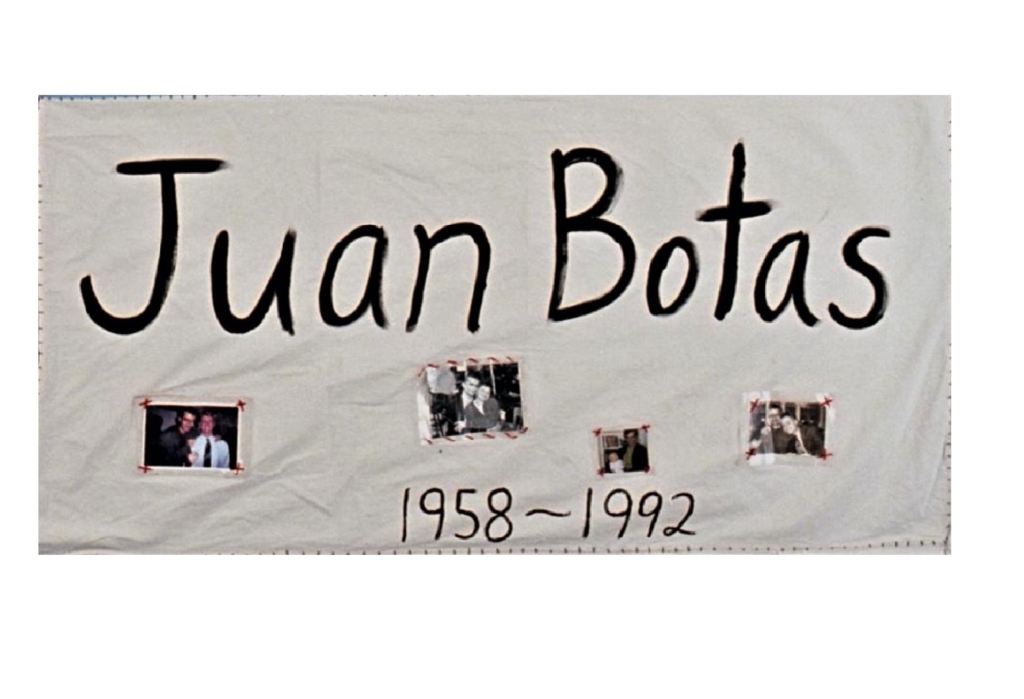
Juan Suárez Botas, illustrator, graphic designer and film maker, dies of AIDS-related illness at St. Vincent’s Hospital in New York City at the age of 34.
Learn More.Botas’ illustrations appeared on the covers of Time, Fortune, U.S. News & World Report and other magazines. His drawings appeared in The New York Times, Vogue and other publications.
Botas moved to the U.S. from Spain in 1977. At the time of his death, he was directing a documentary about his AIDS treatment group at the time of his death, which was released as One Foot on a Banana Peel, the Other Foot in the Grave: Secrets from the Dolly Madison Room.
A friend of film director Jonathan Demme, Botas was a major influence on Demme’s decision to make the film Philadelphia.
* * * * * * * *
Photo of quilt panel from the AIDS Memorial Quilt

Glynis Johnson, who played bass in the Chicago punk bands Friends of Betty and Red Red Meat, dies of AIDS-related illness in her hometown of Valparaiso, Indiana. She was 32.
Learn More.Glynis Johnson formed the band Friends of Betty in 1984 with Tim Rutili and Ben Massarella. Rutili, who was six years younger than Johnson, was a film school student when they became a couple.
“She was an amazing, funny, smart, beautiful person,” Rutili told reporter Jeff Johnson of The Awl in 2013. “And I loved her. I can’t even tell you how much I loved her. And I still really miss her. Even last night, we played in Athens and I was talking to a girl and she did this gesture that reminded me of Glynis and it sort of killed me for a second. I do miss her.”
As a noisy punk band, Friends of Betty attracted a following at local bars and released a 1988 album Blind Faith II. When the album failed to sell, the band changed its name to Red Red Meat and changed their sound to a “hazed-but-focused blues-touched rock,” Chicago Reader music. critic Peter Margasak wrote in 1994.
Johnson grew up in Valparaiso, Indiana, and worked for a while in Portland, Oregon as a painter and carpenter, according to a 1992 article in the Chicago Reader. She moved to Chicago to become part of the music scene.
“She was a Rolling Stones freak,” wrote Bill Wyman of The Reader. “Every summer, she and some friends would hold a Steaks and Stones barbecue.”
Bandmate, flatmate and boyfriend Tim Rutili said he and Johnson had been going out for five or six years when he noticed that she was spending more and more time with drug addicts at a local bar. Shortly after, he broke up with her and moved out of their apartment.
In the years that followed, Johnson’s began to experience chronic infections, and doctors told her she had bronchitis, according to Wyman.
“She started getting thin, and her hair began to fall out,” Wyman wrote. “In August [1992], she went to visit her mom back in Valparaiso …. There she learned what some of her friends suspected she already knew, that she’d been suffering the effects of AIDS for at least two years.”
When Rutili learned that Johnson was living with AIDS, he sought out an HIV test for himself and he was relieved when the test came back negative, he told The Awl. .
“I don’t know if she got it from using needles,” he said. “A bunch of people who were hanging out [with her] at this bar died, and Glynis was the first to go.”
Rutili said he struggled with feelings of guilt for a long time.
“I had this thing where I wished I could have done something to stop it. Now I know that I couldn’t do anything to stop it, but for years I thought there was something I could have done to make her choose between me and death,” he said. “It’s tough when the first person you fall in love with dies, when the person who teaches you how to fall in love dies. I know that’s set into everything I’ve ever done.”
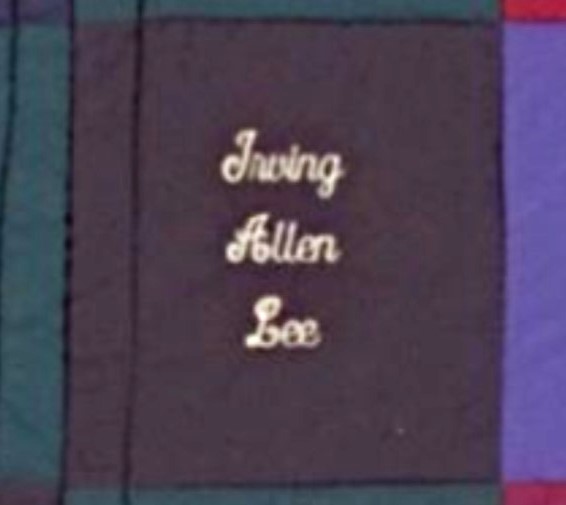
Daytime television actor Irving Allen Lee dies of AIDS-related illness at his Manhattan home. He was 43.
Learn More.Lee was a Broadway and television actor most known for his roles on daytime soap operas. From 1977 to 1984, he played Detective Calvin Stoner on The Edge of Night, notable for writing and performances on an artistic level more elevated than any other soap of its time. From 1986 to 1988, Lee played Dr. Evan Cooper on Ryan’s Hope.
Lee appeared in several musicals, including Ride the Winds (1974), Rock-a-Bye Hamlet (1976) and A Broadway Musical (1978), all of which had short runs on Broadway. In 1974, he replaced Ben Vereen in Pippin at the Minskoff Theatre, was the original understudy for the two male roles in Ain’t Misbehavin’ (1978) and recreated the role of Big Daddy in the revival of Bob Fosse’s Sweet Charity (1986).
According to The New York Times, Lee was a theater director as well, staging productions at the Manhattan Theater Club, the Henry Street Settlement and the Boston Summer Arts Theater Festival. He was also an adjunct professor in the theater arts division of Marymount Manhattan College.
He was born in New York City the son of a minister, Allan Ezekiel Lee, and his wife, Ruth, according to Film Reference. He received a theater degree from Boston University, and then joined the Olatunji African Dance Company as the associate artistic director of its theater company.
* * * * * * * *
Photo of quilt panel from the AIDS Memorial Quilt
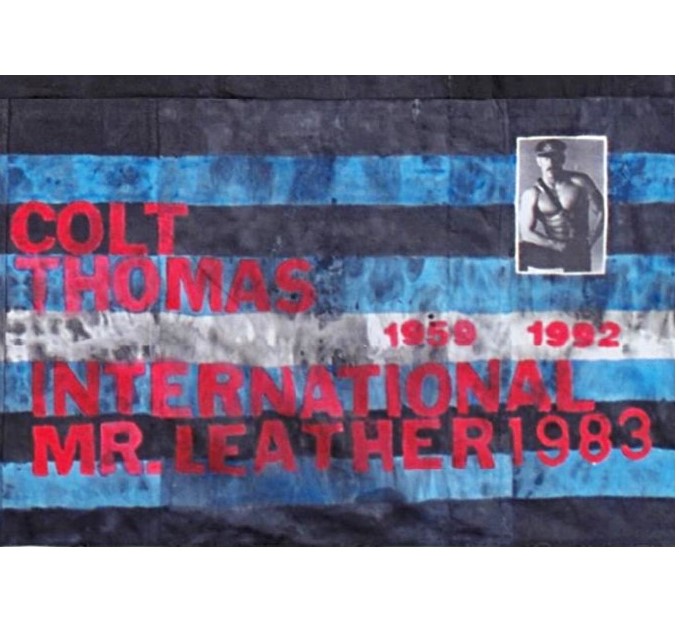
Coulter “Colt” Thomas, winner of numerous leather comptetions, dies of AIDS-related illness at his home in San Francisco at the age of 33.
Learn More.After winning the title of Mr. International Leather at the age of 23, Thomas spent the following year travelling extensively to cities across the U.S., Canada and Europe for promotional appearances, and managed to still maintain above-average grades at the University of Texas, where he was attending medical school.
Upon graduation, Thomas and his partner, Charley Smith, moved to Detroit for his residency in radiology, according to the Bay Area Reporter.
In 1986, Smith was diagnosed with AIDS and broke off his relationship with Thomas, which devastated him. He remained in his residency for another year and then, upon being diagnosed as HIV+, relocated from Detroit to the Bay Area.
In San Francisco, Thomas worked for a video producer for gay events as a contractor’s assistant and occasionally made appearances as Mr. Leather at fundraising events.
* * * * * * * *
Photo of quilt panel from the AIDS Memorial Quilt

Anthony Perkins — an Oscar-nominated stage and film actor best known for his role as Norman Bates in Alfred Hitchcock’s Psycho — dies at his Hollywood Hills home of AIDS-related illness with his wife and two sons at his side. He was 60.
Learn More.“Hitchcock and I got along very well and he let me make several changes and suggestions,” Perkins said. “He used to find me at the end of the working day and thank me, even though it sometimes meant he had to take a car journey to do so. I haven’t had that sort of treatment from many people.”
“When [Psycho] debuted in 1960, mainstream horror consisted mostly of immortal figures like Dracula and scientific freaks of nature in films like Godzilla, King of the Monsters! and Creature from the Black Lagoon. Psycho, on the other hand, emerged with a grounded villain,” wrote Peyton Robinson for Film School Rejects.
Perkins portrayed Norman Bates as a courteous young man with a timid smile — and a capacity for violence just lurking under the surface of his boyish demeanor. This character struck such a nerve with film audiences in 1960 (and still to this day), that the Bates role would follow Perkins for years in American film circles.
After Psycho, film fans forgot that Perkins had been a notable Broadway actor and a bit of a teen idol throughout the 1950s. In 1957, he starred in Fear Strikes Out, a biopic about Red Sox player Jimmy Piersall, and film critics raved about Perkins’ performance. A review in Variety stated, “Every recent young star has been compared to James Dean. From now on the standard is Tony Perkins.”
But his time with Paramount Pictures was fraught with pressure from studio executives who thought Perkins should hide his homosexuality and take pains to appear more masculine. In his biography of Perkins, author Charles Winecoff wrote about how a studio executive told Perkins to end his relationship with actor Tab Hunter and to “get a girl.” Perkins response was “But I love him!”
Hunter told Attitude that while Paramount felt entitled to tell Perkins how to live his life, Hunter had a better experience with his studio, Warner Brothers.
“Warner Brothers never said a word about my sexuality, and that’s just the way I wanted it,” said Hunter. “However, Paramount did have something to say about my relationship with Tony… Despite the opposition, we did continue seeing each other.”
In 1961, after receiving recognition at Cannes for his part in the Ingrid Bergman film Goodbye Again, Perkins relocated to Europe and starred in several films there throughout the 1960s, including Orson Welles’s The Trial (1963).
He returned to the U.S. and worked on Murder on the Orient Express (1974), Mahogany (1975) and the Disney sci-fi adventure The Black Hole (1979). He also co-wrote the 1973 film The Last of Sheila with Stephen Sondheim.
Perkins was living with Sondheim as they worked on The Last of Sheila, and it was around this time that Perkins began subjecting himself to a series of psychiatric attempts to “cure” his homosexuality, coordinated by psychologist Mildred Newman, who had written the pop-psychology best-seller How to be Your Own Best Friend. In 1972, he submitted to “electroshock aversion therapy” under Newman’s direction.
“The electroshock treatments took a terrible toll on Perkins,” said Doug Ireland in Gay City News. “The talent that made him sought after by such distinguished film directors as Claude Chabrol, Jules Dassin, and Orson Welles faded away, as did his looks.”
He and his wife volunteered with Project Angel Food, an organization that provides meals for individuals who are homebound due to HIV. Shortly before he died, he told his sons that he learned “more about love, selflessness and human understanding from the people I have met in this great adventure in the world of AIDS than I ever did in the cutthroat, competitive world in which I spent my life.”
* * * * * * * *
Photo of quilt panel from the AIDS Memorial Quilt

Ron Woodroof, who founded the Dallas Buyers Club in 1988 after testing positive for AIDS, dies in Dallas of AIDS-related illness. He was 42.
Learn More.Woodroof’s Dallas Buyers Club was among the most successful of several AIDS buyers clubs that sprang up in the U.S. at a time when effective HIV treatment was not available, according to Biography / A&E Television network.
Diagnosed with AIDS in 1986 and given just weeks to live, Woodroof decided to take his healthcare into his own hands. He researched various medicines to counteract AIDS’ effects being used in different parts of the world, spending hours in libraries researching experimental treatments.
“I am my own physician,” he was known to say.
Woodroof determined that he would have the best chance of survival if he treated himself with a combination of antiviral medications that were available in other countries but not in the U.S. He then set about to acquire these medications and use them.
Woodroof, who was an electrician, found that he could legally purchase many of the medications he wanted just over the Texas border in Mexico. When other AIDS patients came looking for these same medications, the Dallas Buyers Club was born.
He began buying large quantities of the AIDS medications and distributed them out of his apartment in Oak Lawn, Texas. Within months, his club became a huge network of buyers and sellers. Woodroof’s club served not only local people with AIDS but people around the world who learned about the medications the Texan was making available.
In spite of crackdowns by the FDA and other federal regulators, the Dallas Buyers Club would flourish. Woodroof would charge club participants a fee for membership and sell the medications to them at cost. Unable to continue work as an electrician, he embraced the Buyers Club as his full-time job.
Woodroof’s story would become the basis for the 2013 film The Dallas Buyers Club, and actor Matthew McConaughey would play Woodroof and win Best Actor honors at both the 2014 Academy Awards and Golden Globes.
To prepare for his role, McConaughy listened to audio tapes of interviews with Woodroof and read Woodroof’s diaries provided by the family.
“At the beginning of this journey he’s a two-bit cowboy, and by the end of it, he’s a damn scientist,” said McConaughy upon the release of the film. “He did have an engineering mind, which he’d put to good use to make something of a living as an electrician … Once he grasped that he had HIV, he gains purpose, he had this one clear thing to do — stay alive. Everything else followed from that.”

Keith Prentice, an actor who played the part of Larry in both the original stage and film versions of The Boys in the Band, dies of AIDS-related illness in Kettering, Ohio. He was 52.
Learn More.Prentice worked on TV, film and the New York stage. He appeared on the TV soap Dark Shadows during the series’ final months in 1971, and for a number of years, his picture was displayed on the label of Tasters Choice coffee.
Prentice studied at the American Academy of Dramatic Arts in New York City. His stage musical credits include Sail Away, The Sound of Music, Paint Your Wagon, and The King and I, according to the Internet Broadway Database.
In 1968, he appeared off-Broadway in the production of The Boys in the Band, which was groundbreaking for its portrayal of gay life. The play is set at a birthday party the summer before the Stonewall riots. He also appeared in the film version of the play, which was directed by William Friedkin. As the first major film studio production to deal frankly with homosexuality, every member of the show’s original Off-Broadway cast appears in the iconic film.
Prentice had the striking good looks to be cast — twice — in the part of Larry, described in the play notes as an “extremely handsome” commercial artist who prefers multiple sex partners.
Prentice’s final film role was in Cruising (1980), which was also directed by Friedkin.
In 1982, Prentice moved to Kettering, Ohio and co-founded Kettering Theatre Under the Stars. He directed summer shows there until 1992, the year of his death.

Paul Jabara, songwriter of some of the top dance hits of the 1970s, dies of AIDS-related illness in Los Angeles at the age of 44.
Learn More.He was known for spontaneously entertaining friends and strangers alike with highlights from his latest production, according to his memorial website. He was a one-man show who delighted in performing for an audience.
Jabara was credited with conceiving and distributing the first AIDS red ribbons, and he co-founded the Red Ribbon Project in 1991.
At Jabara’s memorial service, his friends and collaborators paid tribute to him by performing a song he wrote entitled “We’re Gonna Win.” The song was performed just once; it has been locked in a vault and has never been performed again.
* * * * * * * *
Photo of quilt panel from the AIDS Memorial Quilt

Denholm Elliott, a British actor known to steal scenes in Hollywood movies, dies of AIDS-related illness at his home on Ibiza, Spain. He was 70.
Learn More.With more than 125 film and television credits, Elliott was honored with the Most Excellent Order of the British Empire for his contribution to the arts, according to the Los Angeles Times.
Among his most notable film roles were the abortionist in Alfie (1966), Marcus Brody in Raiders of the Lost Ark (1981) and Indiana Jones and the Last Crusade (1989), and Coleman the sarcastic butler in Trading Places (1983). For his performance in A Room with a View (1985), Elliott was nominated for the Academy Award for Best Supporting Actor. He won the BAFTA Award for Best Actor in a Supporting Role in three consecutive years in the 1980s, becoming the only actor to have achieved this distinction.
Active to the end of his life, Elliott performed in early 1992 as the burglar in a film based on the raucous British play Noises Off. He also portrayed George Smiley, author John le Carre’s British super-spy, for the 1991 PBS season opener of Masterpiece Theater, titled “Murder of Quality.”
The American film critic Roger Ebert described him as “the most dependable of all British character actors.”
* * * * * * * *
Photo of quilt panel from the AIDS Memorial Quilt
Terry E. Clark, who co-founded the Texas Gay Rodeo Association with his partner Walter “Papa” Strickland, dies of AIDS-related illness in Houston at the age of 47.
Learn More.Clark was an original member of the Mustangs Leather/Levi Club and an associate member of the Texas Riders, Knights D’Orleans, and Triangle Club of Denver , according to the Texas Obituary Project. He was named Grand Marshal of the 1991 Gay Pride Parade in Houston.
His partner, Walter Stickler, preceded him in death in 1990.
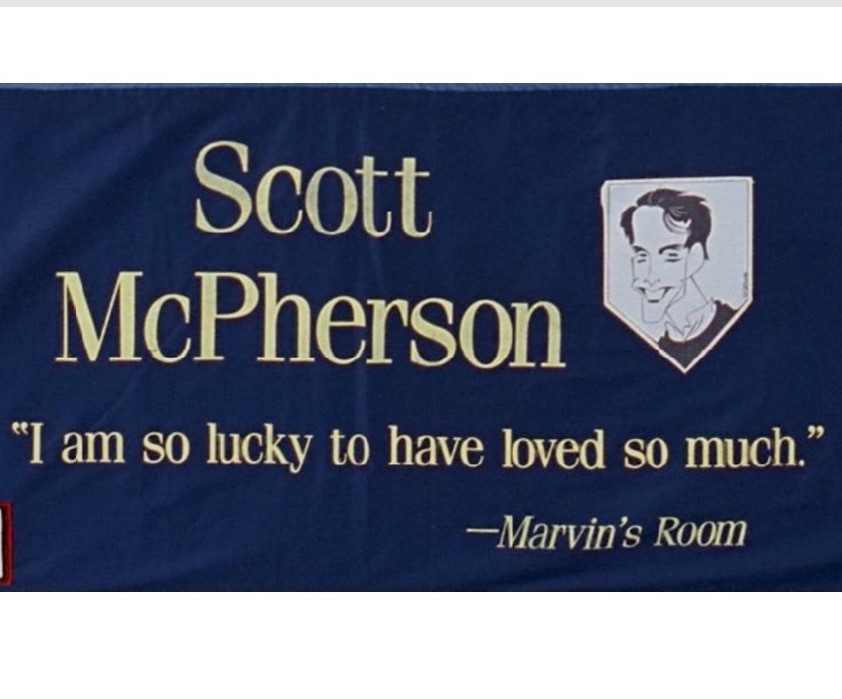
Scott McPherson, creator of the Drama Desk Award-winning Marvin’s Room, dies of AIDS-related illness in Chicago at the age of 33.
Learn More.McPherson, who also wrote the stage plays ‘Til the Fat Lady Sings and Scraped, was one of the first openly gay, HIV-positive American artists. His play Marvin’s Room was first produced in 1990 at Chicago’s Goodman Theatre, telling the story of two sisters who reunite after many years when one is diagnosed with leukemia.
“Amidst the homophobia and AIDS hysteria that gripped the nation, [McPherson] has spoken eloquently, both in his writing and in interviews, of the personal and familial ravages of chronic illness and the need for loving support and connection with lovers, family and friends,” reads the tribute to McPherson by the Chicago LGBT Hall of Fame.
Known as one of Chicago’s most vital creative forces, McPherson moved to the city from Ohio in 1981 and began performing in theatrical productions, commercials and industrial films. His first full-length play, ‘Til the Fat Lady Sings, was directed by Eric Simonson at Lifeline Theatre in Chicago in 1987 and received a Joseph Jefferson Citation for Best New Work, according to Broadway World. His one-act play, Scraped, premiered in a Chicago New Plays production at the Organic Theatre.
Marvin’s Room, McPherson’s second and last full-length play, has been performed throughout the U.S. and around the world. Following its 1990 premiere at the Goodman Theatre Studio, the production went on to the Hartford Stage, Playwrights Horizons and Minetta Lane in New York, London’s West End and the Tiffany Theatre in Los Angeles.
In spite of variable and increasingly failing health, and the illness and recent death of
On February 5, 1992, McPherson’s lover, ACT UP activist and cartoonist Daniel Sotomayor, died of AIDS-related illness. As his own health deteriorated, McPherson continued to write for the stage.
He even managed to attend Chicago Mayor Richard Daley’s annual Commission on Human Relations luncheon at the Palmer House hotel in late February. McPherson attended the event in a wheelchair to protest the award that Mayor Daley was giving posthumously to Sotomayor, a political action thought by activists to be highly hypocritical in light of the mayor’s refusal to spend city funds on HIV/AIDS care.
“If you want to honor Danny,” he yelled at the mayor during the event, according to the Chicago Reader, “increase the AIDS budget! Pass Helen Shiller’s resolution!”
Witnesses to the incident said that McPherson and the activist pushing his wheelchair, Mark Schoofs, were surrounded by guards as they continued to interrupt the mayor’s speech, chanting “Fewer awards! More money!”
Afterward, McPherson told the Reader, “You know, I went to a lot of demonstrations with Danny but I always felt a little hesitant. These things are really not my style; I’m too polite. But I think this is the closest I’ve ever felt to Danny. This was really in his spirit.”
McPherson was working on a new play when he succumbed to his illness about eight months later, in early November.
In 1996, four years after McPherson died, Marvin’s Room was adapted into a major motion picture starring Robert DeNiro, Meryl Streep, Diane Keaton, Leonardo DiCaprio, Gwen Verdon and Hume Cronyn.
* * * * * * * *
Photo of quilt panel from the AIDS Memorial Quilt
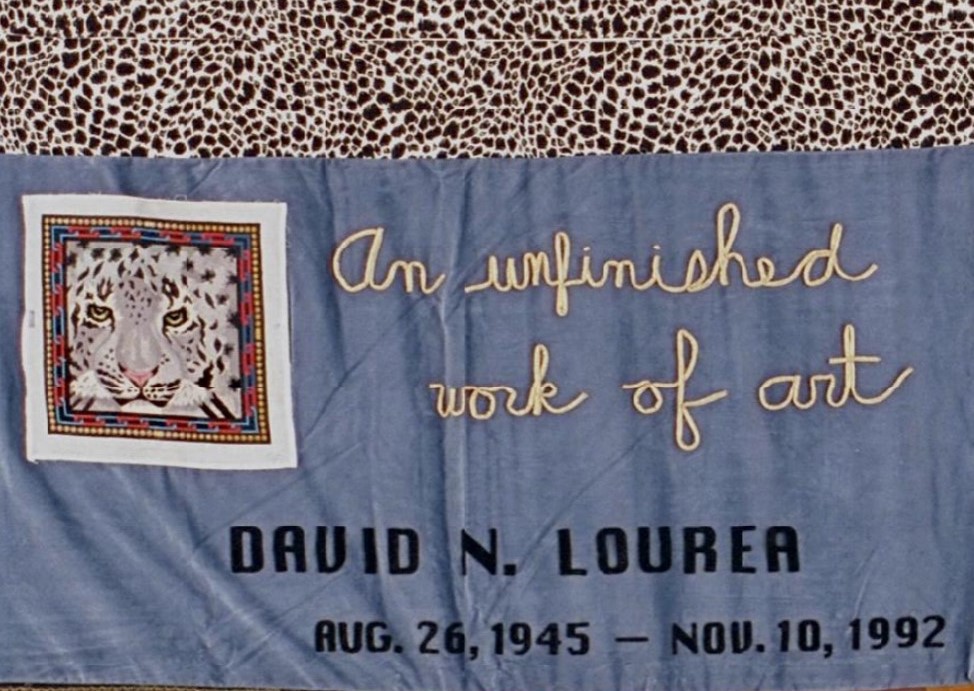
David Lourea, an activist who appeared on local and national TV advocating for bisexual rights, dies of AIDS-related illness in San Francisco at the age of 37.
Learn More.As an early co-director of the Bisexual Center in San Francisco, Lourea helped to raise awareness nationwide of bisexuality as an identity. This increased awareness among the public led many media outlets to promote the idea that bisexuality was a “trend.”
Lourea’s response to this was: “Well, you know, it’s real nice that my sexual orientation is in fashion right now, but when it’s not in fashion, it’s still going to be my sexual orientation.”
Lourea was raised in Philadelphia as Orthodox Jewish, and he continued to explore religion and faith throughout this life. He earned a BFA from Temple University in 1967, and later earned a PhD from the Institute for Advanced Study of Human Sexuality in San Francisco.
After moving to the Bay Area in 1973, he became involved in San Francisco Sex Information, an organization founded that year by bisexual activist Maggi Rubenstein, along with Margo Rila and Tony Ayers. Lourea was also one of the early members of the Bisexual Center, which was also founded by Rubenstein to “serve as a positive support base to facilitate communication, to teach each other by sharing … learning, and to explore the essence and potential of loving” for bisexuals.
At the Bisexual Center’s first meeting, 22 attendees established a steering committee and within six months, the Bi Center’s membership grew to about 140. In early 1977, the organization sponsored about 15 events each month, including discussion groups, gender workshops and social outings.
According to trans bisexual activist Verity Ritchie, “The Bi Center team was made up of quite politically radical bisexuals and had a policy of inclusion. All human rights were important to them. They were feminist, anti-racist, anti-classist.”
In June 1977, Lourea and Rubenstein held a press conference at the Bi Center to speak out against Anita Bryant and Proposition 6 (aka the Briggs Initiative, a ballot initiative that sought to ban gays and lesbians from working in California’s public schools). As a result of the media exposure, the center’s membership rose to 435 and at its peak, the center would have almost 700 members.
In the early 1980s, the AIDS crisis began to sap resources and attention from the Bi Center and its mission, and membership began to decrease. The center closed in 1985, but in its eight years of operation, the Bi Center had a profound impact.
“It created a sense of a bisexual community, educated the general public and professionals about bisexuality, confronted the gay and lesbian communities about the tendency to render the bisexual invisible, spawned several organizations (including political action groups), and changed the lives of many women and men who had felt marginalized by both the heterosexual and homosexual communities,” according to the Bisexual+ & Pansexual Network.
Photo of quilt panel from the AIDS Memorial Quilt
David Oliver, star of the Emmy Award-winning television series A Year in the Life, dies of AIDS-related illness at his Los Angeles home. He was 30.
Learn More.Oliver also appeared for two years on the NBC soap Another World, according to Variety. Additional TV credits include the TNT television movie Miracle in the Wilderness, and the NBC movie of the week If It’s Tuesday, It Still Must Be Belgium.
In A Year in the Life, Oliver played Sam Gardner, a business-school student who falls into an unexpected romance. The show, which premiered on NBC in 1986, followed the lives of Sam and other members of his family for a year.
He also played the lead in the 1988 action movie Defense Play.
On stage, he appeared in several San Diego Civic Light Opera productions, including L’il Abner and The Unsinkable Molly Brown. He also performed regularly at the Edinburgh Theater Festival, according to The New York Times.
He also appeared Elegies, a play about AIDS, at the Canon Theater in Beverly Hills and Club 20-20 in Century City.
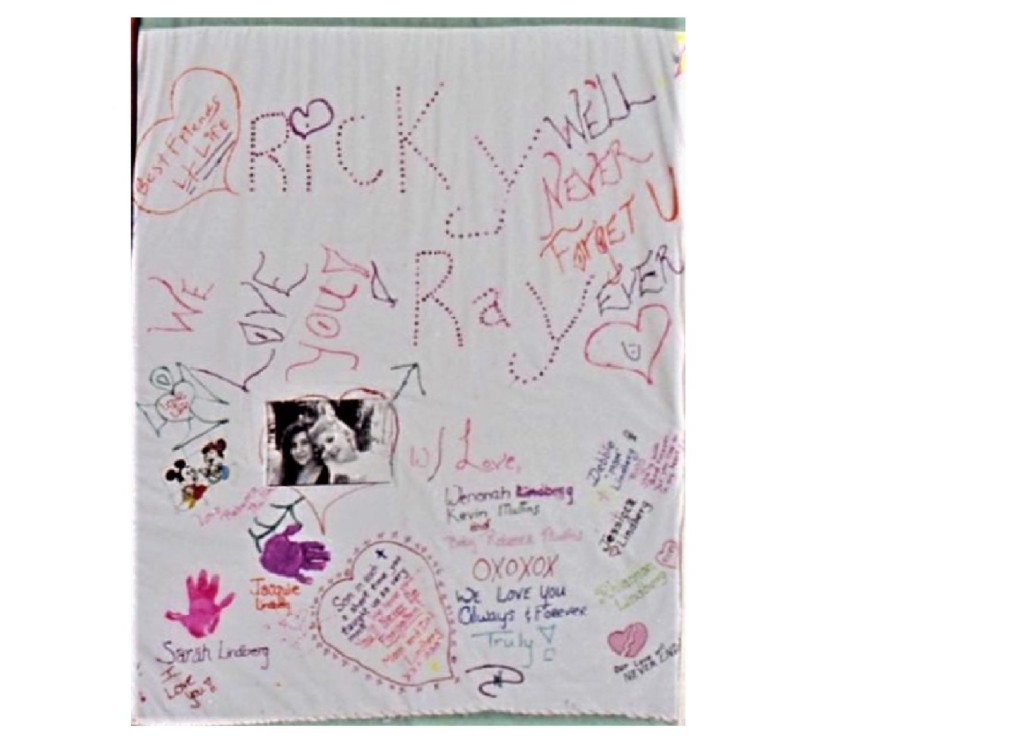
Ricky Ray, the eldest of three hemophiliac brothers barred from school in Florida because they carried the AIDS virus, dies at the age of 15 at his home in Orlando.
Learn More.Ricky and and his two younger brothers, Robert and Randy, sparked a national conversation on AIDS in 1987, after their court battle to attend school led to boycotts by local residents and the torching of their home in Arcadia, Florida.
Last month, President-elect Clinton had telephoned the boy to offer his support. Bedridden with AIDS, Rick let it be known that he wanted to talk to then-President-elect Bill Clinton about the deadly disease.
When Ricky was handed the telephone in his room at All Children’s Hospital, Clinton was on the other end.
“Ricky told him, ‘I hope you do everything you said you would to make a difference,'” said Ricky’s mother, Louise. “He said that Clinton told him that he was going to do everything in his power to make things better.”
* * * * * * * *
Photo of quilt panel from the AIDS Memorial Quilt
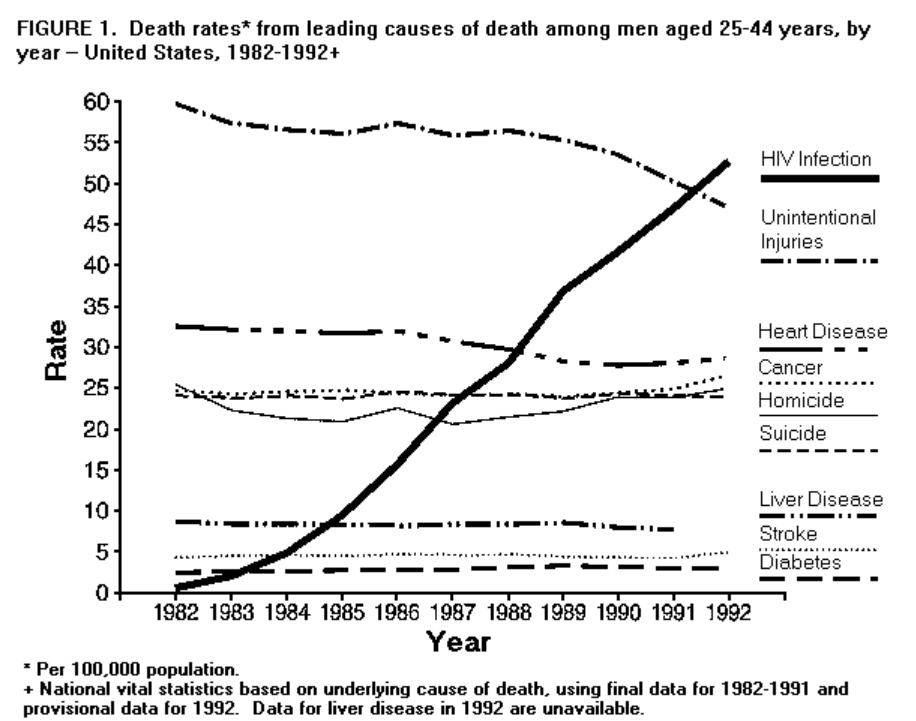
With the death rate from HIV infection steadily and dramatically increasing over the past 10 years, AIDS becomes the leading cause of death in the U.S. for men aged 25-44.
Learn More.A report from the Centers for Disease Control announces that HIV infection emerged in the 1980s as a leading cause of death in the U.S., and now HIV infection is the number one cause of death among men aged 25-44 years.
The CDC bases this assessment on data obtained from death certificates filed in all 50 states and the District of Columbia. Statisticians suspect the magnitude is greater than indicated in the report.
The report also notes that HIV infection is more severely advancing to death for blacks and hispanics than other racial/ethnic groups.
“These differences probably reflect social, economic, behavioral, or other factors rather than race/ethnicity directly,” the report states. “The social and cultural context of HIV infection must be addressed through prevention efforts designed to meet the needs of specific communities.”
.
Alan Ward Ritchie, the 11-year-old son of Glendale community leader Judith Ritchie, dies of AIDS-related illness at Children’s Hospital Los Angeles.
Learn More.Alan was infected with HIV from a blood transfusion administered when he was 2 days old; he was diagnosed with HIV in 1988 at the age of 8.
Upon being informed of her son’s HIV diagnosis, Judy Ritchie became an expert in pediatric HIV/AIDS so she could tend to and, in some cases, fight for Alan’s healthcare needs. A lifelong resident of Glendale, Ritchie used her knowledge to educate other parents in the community, according to the Glendale News-Press.
“Parents’ attitude [was] this won’t happen to our family,” Ritchie told the News-Press. “We found out it does happen to your family … People were very surprised to find out you could get it that easily … They were very grateful to know what I was telling them and surprised to know how widespread it was.”
Following the death of her son, Ritchie would become PTA President at Herbert Hoover High School in Glendale. She also continued her relationships with doctors at Children’s Hospital Los Angeles, so she could receive and relay information about pediatric HIV/AIDS.
At Ritchie’s urging, Glendale community activist Marilyn Gunnell would found Glendale Leaders for AIDS Awareness during the height of the AIDS epidemic, according to the News-Press.
According to Gunnell, she told Ritchie: “Judy, I will give you my promise that something good will come out of this.”
Glendale Leaders for AIDS Awareness would go onto have a meaningful impact on the city and community.
In 1997, Ritchie would be diagnosed with multiple sclerosis, a chronic disease of the brain and spinal cord. Still, she remained active in the Glendale community until her death on July 26, 2021.
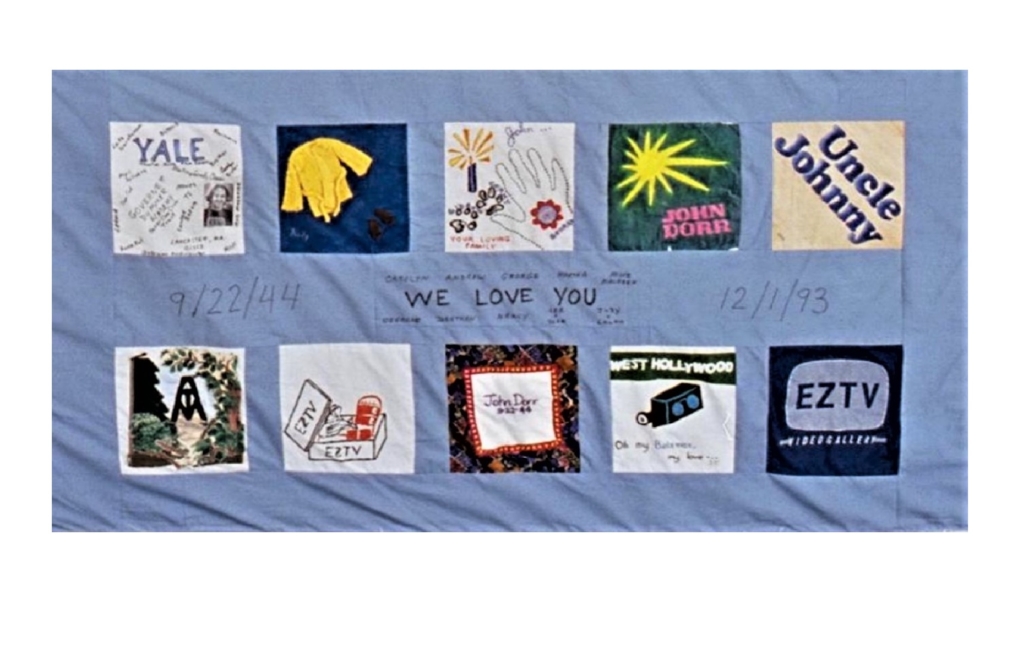
John Dorr, video artist and founder of EZTV, one of the nation’s first centers devoted to the production and exhibition of video, dies in Los Angeles of AIDS-related illness at the age of 48.
Learn More.From his two-story loft in West Hollywood, Dorr fashioned a self-contained studio with room for filming, editing and exhibiting. He was known to boast that feature films could be created with just enough money for videotape and groceries for their casts.
Dorr became a pioneer in the production of full-length dramatic videos, providing a new opportunity for independent filmmakers to produce inexpensive feature-length movies on video. He had a hand in the production of more than 100 video films, among them the Lannen Literary Series, hourlong programs on major poets and writers, and Dorothy and Alan at Norma Place, a film recounting the Hollywood career of the writer Dorothy Parker. In 1986, he produced funHouse, a documentary of Eric Bogosian’s 1983 solo show.
Dorr was a graduate of Yale University and president of the school’s film society. While at Yale, he provided exhibits of the films of Howard Hawks, John Ford and Alfred Hitchcock. After becoming a teaching assistant at UCLA, he hit upon the idea for EZTV when he found many young documentary makers using video to make inexpensive films but there was no place to show their work.
EZTV Founder John Dorr’s openly gay status in the late ’70s and early ’80s was rare, because such a disclosure could quickly end a Hollywood career. According to the EZTV Online Museum, Dorr’s gallery space served the West Hollywood community during the height of the AIDS pandemic as a place where the friends of those who had died of AIDS could hold memorial services and gatherings in their honor. For several years, it was common for a Saturday afternoon at EZTV to be dedicated to the remembrance of someone who could not afford a service any other way.
In addition to producing pictures, Dorr was a critic for Film Comment, the Los Angeles Times, and The Hollywood Reporter, among other publications.
“[John Dorr] was far more dedicated to the aesthetics and true independent spirit of the mediums of film, TV and video than anyone else I’ve ever heard or read about, encountered or met, worked for or against,” said editor/sound mixer John Hays. “In the nine years I knew Dorr, he never failed me, although some people failed him.”
At the time of Dorr’s death, he was working on a behind-the-scenes documentary about Robert Altman’s award-winning Short Cuts (1993). The resulting documentary, Luck, Trust and Ketchup: Robert Altman in Carver Country, featured missing scenes from the Altman film as well as interviews with the director, cast members and technicians.
After Dorr’s death, EZTV somehow persevered amid seemingly impossible odds. As actor Michael Kearns stated, EZTV became an “AIDS survivor.” Now housed at the 18th Street Arts Center in Santa Monica, EZTV continues to be a pioneer in the media arts.
* * * * * * * *
Photo of quilt panel from the AIDS Memorial Quilt
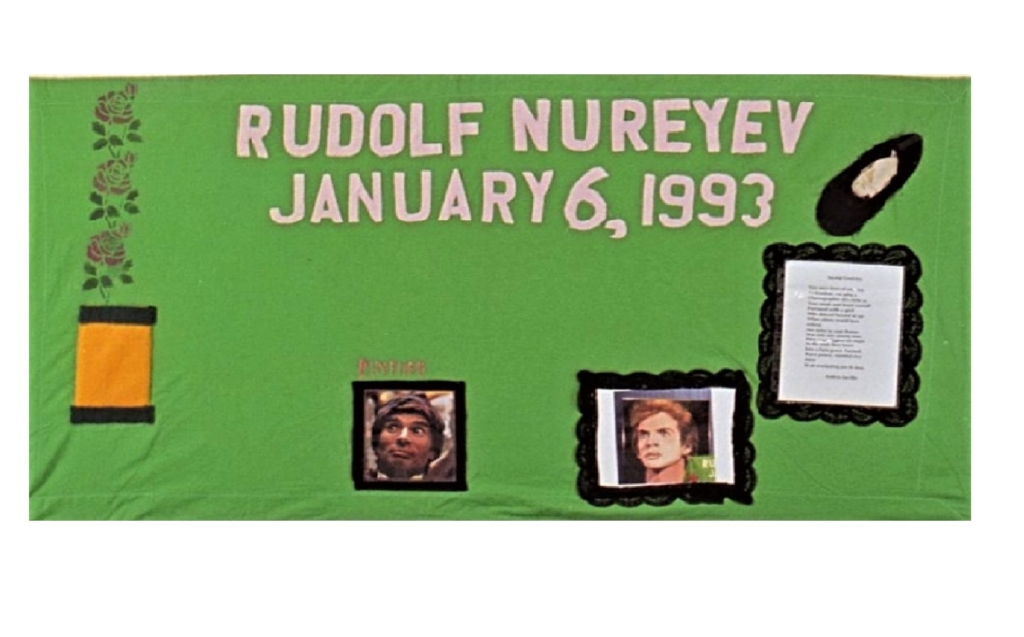
World-renowned ballet dancer Rudolf Nureyev dies of AIDS-related illness at the age of 54.
Learn More.Nureyev is born in 1938 aboard the Trans-Siberian express, near Lake Baikal. He spends his childhood and youth in Ufa, capital of the Soviet Republic of Bashkir. His parents are Tartar Muslims.
In 1961, Rudolf Nureyev dances with the Kirov Ballet, which is on tour in Paris. His first appearance on stage is at the Palais Garnier, in Act III from La Bayadère. Days later, he demands political asylum at Le Bourget airport and refuses to board an airplane to the USSR. He joins the Ballets du Marquis de Cuevas the next day.
He becomes internationally famous as a flamboyant performer and a charismatic celebrity who revived the prominence of male ballet roles and significantly widened the audience for ballet.
In 1973 he codirects (with Robert Helpmann) and stars in a filmed version of Don Quixote, and he has acting roles in the films Valentino (1977) and Exposed (1983).
From 1983 to 1989, Nureyev would be artistic director of the Paris Opéra Ballet, the oldest ballet company in the world. He would be diagnosed with HIV in 1984, his second year at the POB.
He continues to choreograph for the American Ballet Theatre and the Paris Opéra Ballet even as his health declines from AIDS-related complications.
Nureyev enters the hospital Notre Dame du Perpétuel Secours in Levallois-Perret on November 20, 1992 and remained there until his death. His funeral was held in the marble foyer of the Paris Garnier Opera House.
* * * * * * * *
Photo of quilt panel from the AIDS Memorial Quilt

Jerry Mills, one of the most important queer underground comic artists of his time, dies of AIDS-related illness. He was 41 years old.
Learn More.Mills was the creator of the gay comic strip Poppers, about Billy, a West Hollywood hottie, and his sidekick Yves, a nebbish who tries to steer his friend toward better choices. The comic first appeared in the adult magazine In Touch for Men in April 1982, and then was published in Advocate Men later on.
“Though the relationship between Billy and Yves is your typical odd-couple dynamic, you still learn a lot about the dangers of extremes through their interactions,” writes Sara Century for SYFY Media. “Billy could absolutely stand to be a little more prudent, while Yves would be better off adopting some of Billy’s go-with-the-flow attitude.”
Poppers was also published in France (Gai Pied Hebdo) and Japan (Barazoko), and in the comic book Gay Comix, according to reviewer Elisa Rolle. In addition to Poppers, Mills also made cartoons and contributed a story to the first Meatmen anthology.
As the AIDS crisis emerged, Mills’ work addressed the complexity of modern-day sexual relations, and he began to promote safer sex in his storylines, according to the editors of The Other 1980s: Reframing Comics’ Crucial Decade, Brannon Costello and Brian Cremins.
Mills was also a member of the AIDS Coalition To Unleash Power/Los Angeles (ACT UP LA), and was involved in many of the group’s protests and “zaps” in the late 1980s.
Shortly after Mills’ death, ACT UP/LA members decided to memorialize him with a political protest against Amgen, a pharmaceutical company based in Thousand Oaks, California. Amgen became ACT UP’s target due to the exorbitant price the company set for its HIV-treatment medications Epogen and Neupogen.
At ACT UP’s protest on March 3, 1993, activists carried signs with Mills’ name, along with the name of Richard Iosty, another local ACT UP member who died of AIDS shortly before Mills.
Gerald “Jerry” Vallaire, vice president of the South of Market Individuals Lifestyles Events, dies of AIDS-related illness in San Francisco at the age of 41.
Learn More.When Vallaire was diagnosed in 1989 with AIDS, he closed his successful florist business, and dedicated his time to raising funds for AIDS service programs, according to the Bay Area Reporter.
As part of Up Your Alley Productions, Vallaire helped to produce benefits such as the Ringold Alley Fair, Let’s Go Navy, The Charity Bowl, The Military Ball and Art for AIDS. His involvement in the benefits led to thousands of dollars for AIDS causes.
Born in 1951 in New Orleans, Vallaire was born to a family trade of operating wholesale and retail floral businesses. But he was interested in the performance arts, and moved to New York City to pursue dance and theater. There, he performed in productions with Richard Chamberlain, George Maharis, Margaret Hamilton, Ann Miller and George Chakaris.
But when his stage career failed to take off, he moved to San Francisco and opened a florist business, , Styles and Stamens. But when Vallaire began getting involved in fundraising events, his performance background came in handy and he acted as choreographer of many dance productions created for the events.
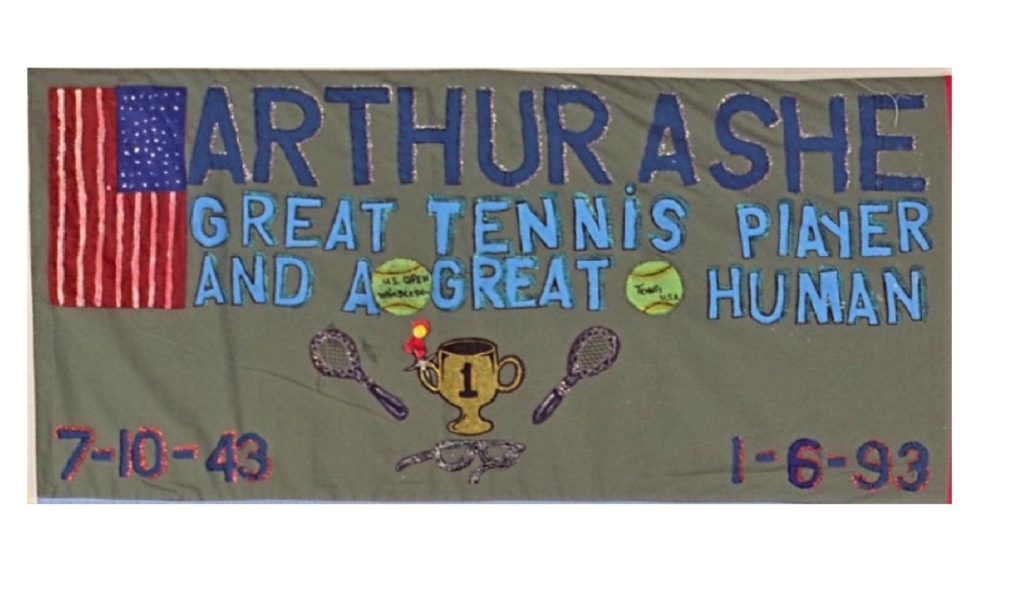
Tennis star Arthur Ashe dies of complications from AIDS at the age of 49. Ashe’s body is laid in state at the governor’s mansion in Richmond, Virginia, where thousands of people line up to pay their respects to the ground-breaking athlete and social activist.
Learn More.Ashe is celebrated for being the first (and only) African American male tennis player to win the U.S. Open and Wimbledon singles titles.
Attending UCLA on a full scholarship in 1965, Ashe wins the individual NCAA tennis championship and helps UCLA win the team championship. He then serves in the U.S. Army for two years.
Ashe begins his career in earnest in 1968, winning the U.S. Open while still an amateur player. He becomes the first black man to win a Grand Slam event.
He becomes a trailblazer in the world of tennis, winning multiple Grand Slam titles in his career. He also becomes known for his commitment to charitable causes and humanitarian work. He establishes tennis programs for inner-city children and campaigns against apartheid in South Africa. He retires from tennis in 1980 after suffering a heart attack.
In 1988, Ashe begins experiencing paralysis in his right arm. After undergoing exploratory brain surgery and a battery of tests, doctors determine he has toxoplasmosis, a parasitic disease that is commonly found in people infected with HIV. Another set of tests reveals he is HIV positive.
Doctors believe Arthur Ashe contracted HIV from blood transfusions during his second heart surgery. Despite that, Ashe and his wife try to keep his HIV diagnosis private. After a friend that worked at USA Today calls Ashe about his condition, he decides to go public.
Two months before his death, he founds the Arthur Ashe Institute for Urban Health, to help address issues of inadequate health care delivery to urban minority populations. He also dedicates time in his last few months to writing “Days of Grace,” his memoir that he finishes only days before his death.
Arthur Ashe dies of AIDS-related pneumonia in New York at the age of 49. His body was laid in state at the Governor’s Mansion in his hometown of Richmond, VA. More than 5,000 people line up to walk past the casket.
His funeral is attended by nearly 6,000 people including NYC Mayor David Dinkins, Virginia Gov. L. Douglas Wilder, Secretary of Commerce Ron Brown, and Rainbow Coalition chairman Jesse Jackson. Andrew Young, the former U.N. ambassador and Atlanta mayor who had performed Arthur’s marriage ceremony, delivers the eulogy.
On what would have been Arthur’s 53rd birthday, July 10, 1996, a statue of him was dedicated on Richmond’s Monument Avenue. Before this, Monument Avenue had commemorated Confederate war heroes; in fact, as a child Arthur would not even have been able to visit Monument Avenue because of the color of his skin.
Arthur is depicted carrying books in one hand and a tennis racket in the other, symbolizing his love of knowledge and tennis.
In 1997, the USTA announced that the new center stadium at the USTA National Tennis Center would be named Arthur Ashe Stadium, commemorating the life of the first U.S. Open men’s champion in the place where all future U.S. Open champions will be determined.
* * * * * * * *
Photo of quilt panel from the AIDS Memorial Quilt
Loyd Tittle, owner of Capitol Drugs in West Hollywood, dies of AIDS-related illness at the age of 42.
Learn More.Tittle was diagnosed with AIDS in 1988. For four years, his sister Ruth Tittle traveled from Lexington, Kentucky to Los Angeles to help care for Loyd. In 1992, Ruth moved to West Hollywood to care for her brother full-time and to help him with running his West Hollywood businesses.
Loyd suffered from cytomegalovirus (CMV) colitis, and as a result he couldn’t absorb nutrition. As with many people with AIDS, this condition led to loss of body mass, commonly known as “wasting.” Loyd was in the hospital 11 times in the last year of his life.
A plaque remembering Loyd Tittle is on the sidewalk in front of Capitol Drugs, part of the AIDS Memorial Walk. His sister went on to become one of the founding members of the Foundation for The AIDS Monument. She also served on the City of West Hollywood’s Lesbian and Gay Advisory Board and worked on the Gay and Lesbian Elder Housing project.

Karen Dalton — a folk guitarist, banjo player, and singer who released two albums on the cusp of 1970 — dies of AIDS-related illness at her home near Woodstock, New York. She was 55.
Learn More.“Karen Dalton sang in a room-hushing confessional style, with a tone that earned her constant comparison with Billie Holiday,” wrote Tom Moon, author of 1000 Recordings To Hear Before You Die. “She was a singer of transfixing nuance and uncommon emotional control.”
Dalton accompanied herself with a 12-string guitar, just like Lead Belly (Huddie William Ledbetter), one of her favorite folk-blues performers.
Dalton was part of the 1960s Greenwich Village folk scene, and she performed with folk luminary Bob Dylan, Moon wrote in a profile of Dalton for NPR. Her debut album, It’s So Hard to Tell Who’s Going to Love You the Best (1969(, was produced by Nik Venet, who also helped launch Linda Ronstadt’s career.
Born in Texas in 1937 and raised in Oklahoma by Southern Baptist parents, Dalton was twice married and divorced by the time she was 21. She arrived in New York City in the early 1960s with her guitar, banjo, “and at least one of her two children,” according to music writer Laura Barton in The Guardian.
“Although Dalton was in the right place at the right time, hanging with the right people and boasted a rare talent, she was also self-destructive.” Barton wrote. “She drank heavily, used drugs and had a tendency to disappear on a whim. She played only cover versions, and her decision to not play her own material in an era that belonged to singer-songwriters perhaps also hindered her success.”
Still, her covers of standards were distinctive enough to garner a dedicated following among music fans and musicians alike. Bob Dylan said she was his favorite singer in Cafe Wha? in the Village.
Throughout the ’60s, Dalton travelled from New York to perform in folk venues across the country, such as the Attic, a coffee house near the University of Colorado. She enjoyed the rural life that touring sometimes provided, and even set up house in Colorado for a few years.
In the late 1960s, Capitol Records signed Dalton to make an album. The process of recording was so daunting to her that singer-songwriter Fred Neil had to tell her that the tape wasn’t rolling (when it was) in order to get her to perform, according to Barton.
It’s So Hard to Tell You Who’s Going to Love You the Best was released in 1969 by Capitol Records, and is still appreciated by fans of authentic folk music. Pitchfork magazine lists the album at #52 on its 200 Best Albums of the 1960s.
Listening to “It Hurts Me Too,” a song on the album, is like opening a window to the 1930s. Barton’s singing gives the listener a direct link from the 1960s folk revival back to the original folk songs of Woody Guthrie.
Unfortunately, It’s So Hard didn’t sell well, and Capitol dropped Dalton. But then her friend Michael Lang was given a label to run at Paramount (Just Sunshine Records), and he signed her to produce her second album, In My Own Time (1971). To promote the album, Lang booked Dalton as the opening act for a tour headlined by Santana, and this experience proved to be disastrous for Dalton.
“It obviously didn’t work,” Robert Yapkowitz, co-director of the 2021 documentary Karen Dalton: In My Own Time, told The Guardian. “In part because of the audience, and in part because Karen wasn’t able to perform at that arena level.”
Following the tour, Dalton returned home depressed and increasingly drawn to drug use, according to Jim Farber of The Guardian.
She fell away from the music industry, and reportedly spent time unhoused in New York City. After a failed attempt at a Texas rehab, she returned to New York and settled in a friend’s cabin in Woodstock. Dalton was diagnosed as HIV positive some time in the late 1980s.
After her death, a book of her writings was released in 2012. Her music has been re-issued every so often, causing a surge of new fans, including artists Nick Cave and Devendra Banhart.
Richard “Rick” Redewill, owner of the Lone Star Saloon, Cocktails Bar and the PIT, dies of AIDS-related illness at Kaiser French Campus in San Francisco. He was 40 years old.
Learn More.In the summer of 1989, Redewill opened the Lone Star Saloon on the corner of Howard and 7th, serving just beer and wine at first because he didn’t have a liquor license. Redewill sought to foster an atmosphere in the bar that appealed to the neighborhood’s working class men who felt more at home in the city’s South of Market area, than in the Castro.
In October of that year, the bar was rendered structurally unsafe after the Loma Prieta earthquake struck. Only six months old, the Lone Star had to be demolished. Redewill relocated the bar to 1354 Harrison Street, where it remains today. The new space appealed to the biker crowd that previously made The Ambush — a leather bar across the street that closed in 1987 — their headquarters. And members of the Bear community also were attracted to the bar, making the Lone Star famous as a “Bear Bar.”
“Bar owners such as Rick Redewill were seen as community leaders,” wrote Ron Suresha in his post “Rainbow MC and the old Lone Star.” “During that time – following the closure of all gay SF baths – the Lone Star functioned as a kind of Bear community center that attracted a wealth of creative gay men’s culture: visual arts, writing, music, sex, even sports. The fact that it served as a nexus for such a plethora of culture at perhaps the height of the onslaught of AIDS deaths is a matter of wonder.”
“Bonsai Pete” Vafiades, who Redewill hired to bartend at the Lone Star, told Suresha:
“Bar life in the City (and elsewhere) was important in the way that gay men form community – which is not so much the case in gay life today – and the earthquake was the adversity out of which this first Bear community was forged.”

Anthony Sabatino, an Emmy-award-winning art director who regularly produced the Soul Train Music Awards, dies of AIDS-related illness at his Los Angeles home at the age of 48.
Learn More.Anthony Sabatino became art director of the televised dance show Soul Train in 1971 and produced its awards show for seven years. He also designed other awards shows, including the Golden Globes and the People’s Choice Awards.
Born in Galveston and educated at the University of Houston and Brandeis University, Sabatino also worked on films (Richard Pryor’s Here and Now and Walk on the Wild Side), game shows (Truth or Consequences), television specials (for Bing Crosby, Liberace and George Burns), and talk shows (for Pat Sajak and Joan Rivers).
Nominated eight times for an Emmy, Sabatino won in 1988-89 for Fun House, a children’s game show that aired from 1988 to 1991.

Héctor Lavoe, considered to be among the most important singers in the history of salsa music, dies of AIDS-related illness. He was 46.
Learn More.From the 1960s through the 1980s, Lavoe helped to establish the popularity of salsa music in the U.S. and across the world. A charismatic soloist, Lavoe also performed with Tito Puente, the Fania All Stars and, early in his career, the Willie Colon Orchestra.
“Puerto Rican vocalist Héctor Lavoe was a real-life superhero of salsa, a diamond in the rough who could channel the full range of human emotions in a single fleeting note,” Suzy Exposito wrote in Rolling Stone for the magazine’s tribute to the top 50 Latin Pop Songs. Lavoe’s 1976 Hit “El Periódico de Ayer” was listed as #5.
Born Hector Perez in 1946 and raised in the Machuelo Abajo barrio of Ponce, Puerto Rico, Lavoe studied music in school and was inspired by the folk musician Jesús Sánchez Erazo (1900-1979). At the age of 16, he left home for New York City, moved into his sister’s Bronx apartment, and began performing with various Latin musical groups, including Kako All-Stars, Johnny Pacheco’s pachanga band, and ultimately Willie Colón’s salsa band.
Pacheco, co-owner of the salsa label Fania Records, suggested that Colón record Lavoe on a track of Colón’s first album El Malo (1967). Pleased with Lavoe’s performance, Colón kept him in the studio to record the rest of the album’s vocal tracks. Several of the songs became hits, including “El Malo” and “Canto a Borinquen.”
At Colón’s invitation, Lavoe joined the band and began performing Saturday nights at the Tropicoro Club. Soon after, he met Carmen Castro, who became pregnant but refused to marry Lavoe, according to Antonio Mejias, author of The Singer, Hector Lavoe. Lavoe’s first son, José Alberto Pérez was born in October 1968. Lavoe was also involved with Nilda “Puchi” Román, who in September 1969 gave birth to Lavoe’s second son, Héctor Jr. Lavoe married Román, and at his new wife’s request, agreed to keep to a minimum any contact with Castro and José Alberto.
Lavoe found his sudden success and his complicated personal life to be overwhelming, and soon he was addicted to heroin and prescription drugs, according to veteran salsa musician Pete Nader, who performed with Lavoe.
“[Lavoe’s] addiction resulted in him showing up late for gigs, and he eventually did not show up to some scheduled performances at all,” writes Nader on his website Pete Nader’s Salsa Legends and Masters Academy.
After trying in vain to get Lavoe to quit his drug habit, Colón fired him, according to Nader. But by then, Lavoe had developed his own fan following, and he was able to leverage this with Fania Records to launch a solo career with his own band.
In 1975, he released an album with an audacious title, La Voz (“The Voice), with the salsa hit “Mi Gente” (“My People”). Lavoe followed this up in 1976 with the album De Ti Depende and continued to build fans with the hit “Periódico de Ayer.”
The cover of his 1978 album Comedia featured Lavoe impersonating silent film star Charlie Chaplin. It was apparent that Lavoe’s playful personality and singing style was gaining force, and Comedia would feature several hits, including “El Cantante” and “Bandolera.”
During this period, he was frequently featured as a guest singer with the Fania All Stars, recording numerous tracks with the band.
In 1979, Lavoe sought help from a Santeria priest for his drug addiction and depression. At her advice, he managed to break his dependence on narcotics by isolating himself for two months and cutting all communication with family and friends, according to Nader.
But the years that followed would challenge Lavoe’s attempts to remain off drugs. In 1985, he was diagnosed with HIV. Then, two years later, his son Hector Jr. was killed in a shooting accident, according to The New York Times. Lavoe tried to commit suicide in 1988, the same year he was nominated for a Grammy Award in 1988 for his recording Lavoe Strikes Back.
“Of all the recordings of Hector Juan Pérez Martínez, Strikes Back is not the one that showcases his best vocal performance,” writes Jaime Torre Torres for Fania Records. “However, in each track, he surrendered his soul. And because of this, it is an album that we will never get tired of listening to over and over again.”
Two weeks prior to Lavoe’s death, Fania released a two-CD set of Lavoe’s best recordings.
Upon news of Lavoe’s passing, New York City musician Peter Watrous wrote in The New York Times: “Mr. Lavoe was an incandescent singer, an improviser who used a boyish sound to impart passion. His voice, high and pure, turned the most banal lyrics into pleas, and when he improvised, he moved from clipped, abrupt rhythms to a graceful float that made his singing extraordinarily beautiful.”
Lavoe’s death would initially be reported in the media as a heart attack.
Lavoe’s life story would be featured in the film El Cantante” (2007), with salsa artist Marc Anthony starring in the role of Lavoe and Jennifer Lopez as Lavoe’s wife Puchi. Anthony told Lewis Beale of The New York Times that he grew up in New York listening to Lavoe’s music.
“He was our Bob Dylan,” Anthony said. “He spoke the language of the people. He wasn’t refined, was from the streets. He understood what it was like to be Puerto Rican in this country, to be lucky yet destructive at the same time.”

Roy London, a Hollywood acting coach who guided many to stardom, dies of AIDs-related illness in Los Angeles at the age of 50.
Learn More.London was the premier acting teacher in Hollywood. With his profound influence over those who would become famous for their skill in the dramatic arts, he is credited with having a great impact on contemporary acting in films. Many who needed to prepare for demanding roles sought him out, and he was also known for helping develop and shape film projects.
London was an original member and a resident playwright of Circle Repertory Company in Greenwich Village, according to Variety. In the late 1980s, London debuted as a television director with episodes of Showtime’s It’s Garry Shandling’s Show. He also directed episodes of Shandling’s HBO series, The Larry Sanders Show, for which he received a Cable Ace Award nomination.
In 1992, London’s first feature film as a director, Diary of a Hitman, was released, starring Forest Whitaker, Sherilyn Fenn, Sharon Stone and Lois Chiles.
His knowledge of writing, combined with his experience of having acted in over 150 roles on Broadway, Off-Broadway, The Royal Shakespeare Company, feature films and television, led him to discover how to help actors reveal material in dynamic ways that led to exciting performances. London’s classes began in his living room, and spread by word of mouth.
In 1984 he moved to his own studio, but he never put a sign on the door, listed the phone number, advertised the classes nor publicized his teaching. His students have thanked him on the Academy Awards, the Golden Globe Awards, the MTV Movie Awards and more.
A documentary about his work, Special Thanks to Roy London, premiered at the Tribeca Film Festival in 2005. It features interviews with over 50 of his students and friends, including Sharon Stone, Sherilyn Fenn, Jeff Goldblum, Patrick Swayze, Patricia Arquette, Hank Azaria, Geena Davis, Famke Janssen, Garry Shandling, Lanford Wilson, Lois Chiles, Elizabeth Berkley, Drew Carey, and Janel Moloney.
Garry Shandling, Sharon Stone’s long-time friend and fellow student of Roy London’s, presented her with the inaugural Roy London Award in 2007 for her tireless efforts and steadfast commitment to the fight against AIDS.
* * * * * * * *
Photo of quilt panel from the AIDS Memorial Quilt
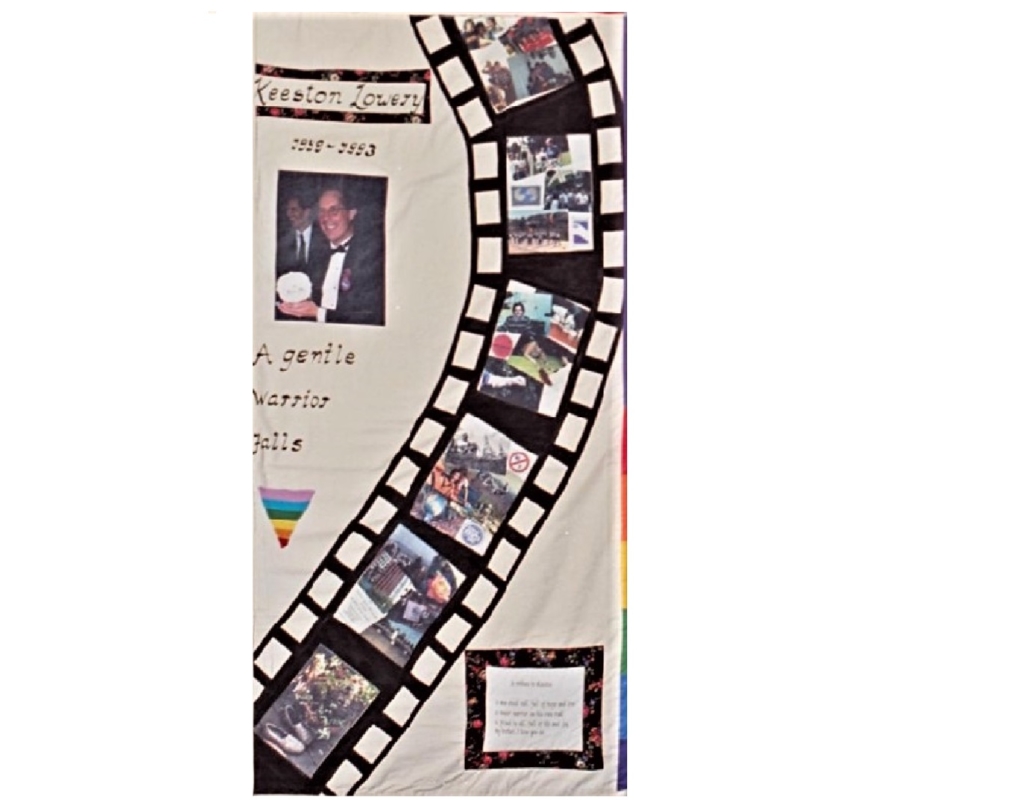
Keeston Lowery, an aide to Portland Commissioner Michael Lindberg, dies of AIDS-related illness at the age of 43.
Learn More.Lowery was a tireless and supremely effective advocate for LGBTQIA+ rights from inside the Portland government. He also worked as a physical therapist for Emanuel Hospital and served on the Board for the Right to Privacy PAC (predecessor to Basic Rights Oregon).
In 1967-68, Lowery worked on Sen. Robert Kennedy’s campaign for President, and shortly afterward, graduated from Mississippi State University’s five-year occupational therapy program. He continued his higher education and earned another degree from the University of Arkansas. He then worked in Pine Bluff and Little Rock, Arkansas, and in the mid-1970s, he took a job with then-Arkansas Attorney General Bill Clinton.
Lowery moved to Portand, Oregon in 1977 to take a job as a physical therapist for Emanuel Hospital, and quickly became a leader in the local queer community. He became an aide to Portland City Commissioner Mike Lindberg, and immediately used his role in inter-governmental relations and film policy to cultivate advocates for equal rights in all levels of local and state government.
Lowery crafted Portland’s first civil rights ordinance, which banned discrimination based on race, religion, gender, sexual orientation, and several other categories.
“His beaming smile, southern drawl and good will were infectious,” writes the Gay & Lesbian Archives of the Pacific Northwest in its tribute to Lowery. “He was an astute political observer who could intuitively plot winning strategies. His manifold contributions continue to this day, not only in the policies he crafted on behalf of marginalized people, but in memories of all the powerful and empowered people whose lives he touched.”
Lowery’s work on the city’s film production policies and the good will he established with film crews led to his receiving a “thank you” credit on the 1991 film My Own Private Idaho, written and directed by Gus Van Sant.
When Lowery in late August of 1993, Oregon Governor Barbara Roberts and Portland Mayor Vera attended his funeral, held on Sept. 2 in the Rose Gardens at Washington Park, along with numerous members and leaders in the LGBTQIA+ community. Lowery’s ashes were scattered on Mount Hood, a potentially active volcano in the Cascade Volcanic Arc, located about 50 miles east-southeast of Portland.
The City of Portand’s archives store Lowery’s papers and artifacts.
* * * * * * * *
Photo of quilt panel from the AIDS Memorial Quilt

Celebrity hairdresser Robin Weir, who visited the White House twice a week to style Nancy Reagan’s hair when she was First Lady, dies of AIDS-related illness at Sibley Memorial Hospital in Washington, D.C. He was 45.
Learn More.Weir was also the hairdresser for other women in the public eye, including Elizabeth Dole, Joan Rivers and Edie Gorme. During official state visits to Washington, Margaret Thatcher, Indira Ghandi and Queen Beatrix also received services from Weir, according to United Press International. His business surged because of his association with the First Lady.
Nancy Reagan said in a statement she was “very saddened to hear the news” of Mr. Weir’s death, according to The New York Times. “Robin was not only my hairdresser, but he was also my friend.”
During the Reagan presidency, Weir went to at least one summit conference with the president and helped the Smithsonian Institution stage an exhibit on hairstyles, according to the Los Angeles Times. People magazine called Weir “The Beauty Ambassador.”
In a 1984 interview with Iris Krasnow of UPI, Weir said that people would often pump him for personal information about his celebrity clients, but he was not willing to ruin his reputation by talking.
“People looooove to ask about the personal lives of some of my clients, you know, ‘What’s she reallllly like?'” he told Krasnow. “I say, ‘Well she has moles on her chin and lumps on her head.”
Weir also said he was aware of the jokes about Nancy Reagan’s hairstyle — “like if she falls down, she’ll break her hair.”
But Weir insisted that Mrs. Reagan’s hair was very soft.
“At any time, you can run your fingers through it,” he said. “It’s just that she has very thick, good hair.”
While serving the First Lady, Weir said he charged her $18 for a cut and $18 for a set. He would style her hair in the White House residence in a salon that Weir said was once a playroom for John John and Caroline Kennedy.
When Weir died, all the major media outlets in the U.S. reported on his death.

Joan Baker, San Francisco’s first out HIV+ lesbian, dies of AIDS-related illness at the age of 27. At the time of her passing, she is in her home surrounded by loved ones and her many pets.
Learn More.In December of 1986, two days before Christmas, Joan Baker received news that she was HIV+. According to a tribute to Baker in Lady Science, she had gotten tested for HIV as an act of solidarity with a friend, not because she thought she was at risk, and her diagnosis was a shock.
The youngest of a large family, Baker was born in 1966 in Riverside, California. Her parents were originally from the U.K. and moved Baker and her siblings several times from southern California to Washington state and then to England in the late 1970s. In 1986, she left her family in England after coming out and returned to California.
She received her HIV+ diagnosis after settling in San Francisco, a city that was fast becoming a model for AIDS care to the world. Unfortunately, the city offered very few services and resources for HIV+ women at that time.
“In 1986, many HIV care providers and activists knew women could contract HIV/AIDS, but this knowledge did not translate to widespread services or research, or compassionate coverage from the media,” according to the article on Lady Science.
HIV+ women — particularly HIV+ lesbians like Baker — were virtually invisible, but Baker fought to change this during the last seven years of her life. Through a friend, she connected with several programs, including the San Francisco AIDS Foundation, where she attended the first ever Women with AIDS support group. Baker never intended to become known for being an HIV+ activist, but to gain access to services, she had to assert a level of visibility.
Baker appeared on local talk shows, promotional materials for pharmaceutical companies and care organizations, and spoke at public events. She attended protests organized by AIDS Action Pledge and ACT UP-San Francisco and carried the “Fighting for Our Lives” banner at the 1988 Candlelight Memorial March. And that same year, during the unfolding of the AIDS Memorial Quilt at the Gay and Lesbian March on Washington, she took part in the reading of the names of people who had died of AIDS emblazoned on the quilt.
Because she was a HIV+ lesbian, Baker was subjected to invasive questions. Some asked if she was an IV-drug user, while others wanted to know whether she had sex with men. Baker’s response to these questions was to challenge people to reimagine what an HIV+ person looks like.
“It doesn’t matter how I got it,” she said. “It’s the fact that I have been diagnosed and I am coming out as a woman with AIDS, because a lot of lesbians still think that they can’t get AIDS, and I’m here to say it can happen.”
By the last year of her life, Baker had built a strong support group and was known and admired by many in the community. After her death in early September 1993, Baker was memorialized with a political funeral and rally at Dolores Park, organized by Lesbian Avengers activist Judith Cohen.
Hundreds of people gathered for the event, including members of ACT UP-Golden Gate and ACT UP-San Francisco, and WORLD, as well as members of the Public Health Department and Lyon-Martin Health HIV Services. The crowd carried signs with images of Baker on them and marched to Harvey Milk Plaza in the Castro neighborhood, escorted by Dykes on Bikes.
Jenn Maeader, Joan’s partner for the last three years of her life, spoke at Milk Plaza about the importance of Baker’ activism and her visibility in the AIDS epidemic, saying, “Imagine if a woman here today who might be at risk now gets tested, and if we can tell her she has a life, she has a future, she has a community that supports her.”
* * * * * * * *
Photo of quilt panel from the AIDS Memorial Quilt
René Klijn, a Dutch singer and model who became famous for talking on a Netherlands TV show about his HIV-positive status, dies in The Hague at the age of 30.
Learn More.Klijn was a former member of the late 1980s Dutch boyband Bam to Bam Bam and a fashion model who achieved his greatest fame in November 1992 by sharing details about his HIV-positive condition on the Dutch talk show De Schreeuw van De Leeuw.
Klijn was born in The Hague of Indonesian immigrants who put him up for adoption as an infant, according to With Pride. When he was 17 years old, he moved to Amsterdam and began working as a fashion model and background singer.
In the late 1980s, Klijn joined the boyband Bam to Bam Bam, which briefly achieved fame for its single “Like a Locomotion.” In 1990, he left the band to embark on a solo career. But his plans were derailed when he tested positive for HIV. Such was the stigma associated with HIV and AIDS, Klijn decided to isolate himself.
Still, word of Klijn’s condition got out, and The Netherland’s most notorious talk show host, Paul de Leeuw, contacted him about making an episode of De Schreeuw van de Leeuw about AIDS. After initial hesitation, Klijn agreed to be his guest on de Leeuw’s show.
“The most important thing I could do was the program,” Klijn said. “Breaking the taboo … Because as soon as people no longer fear the disease, it becomes a lot more pleasant.”
The entire show focused on Klijn and his illness, and featured appearances by Klijn’s family and healthcare providers. De Leeuw, who was known to invite D-level celebrities to his show for the express purpose of making fun of them, took the liberty of cracking jokes about HIV and AIDS. Some viewers were outraged by de Leeuw’s perceived insensitivity toward Klijn, but other viewers found de Leeuw’s approach to be destigmatizing, according to Netherlands media.
The broadcast was viewed by millions and provided a greater awareness of the disease across The Netherlands. The episode of De Schreeuw van De Leeuw won a Bronze Rose d’Or from the European Broadcasting Union.
At the end of the show, Klijn performed the song “Mr. Blue,” which he subsequently recorded the following year with Candy Dulfer on saxophone and background vocals by Loïs Lane and de Leeuw. It was released as a single in early 1993 and reached No. 1 on the Dutch Single Top 100 and Dutch Top 40 charts. It became the country’s best selling single of the year, with all proceeds donated to an AIDS research foundation.
Klijn also started making a full-length album, but was unable to finish it due to the deterioration of his health.
After his death, the René Klijn Foundation was founded to focus on the prevention of AIDS. Klijn was survived by his partner, Maarten Jansen, who scattered his ashes over the Hudson River in New York.
Emile Ardolino, who won an Oscar for the dance documentary He Makes Me Feel Like Dancin’ and directed the hit movies Dirty Dancing and Sister Act, dies at his Bel Air home of AIDS-related illness at the age of 50.
Learn More.Ardolino gained prominence in the mid-1970s as a producer and director of dance programming on television. In the late ’80s, he made a splash in Hollywood with Dirty Dancing, followed by the hits Three Men and a Little Lady and Sister Act.
Born in New York City, Ardolino performed in several theater productions at New York’s Queens College, and portrayed the character “Boy” in a touring version of The Fantasticks.
Ardolino’s awards mounted through his efforts for the Dance in America series for PBS. He won his first Emmy for directing Choreography by Balanchine IV in the 1978-79 season and a Directors Guild of America award for The Spellbound Child in the 1980-81 season.
Jacques d’Amboise, a principal dancer with New York’s City Ballet, invited him to direct He Makes Me Feel Like Dancin’, detailing the dancer’s work with children. The film won Ardolino not only the Oscar but two more Emmys and a Peabody award.
Ardolino also had a long-term relationship with producer Joseph Papp and translated to television such New York Shakespeare Festival works as A Midsummer Night’s Dream and The Dance and the Railroad.
His first feature film, 1987’s Dirty Dancing, was a huge box-office success, grossing more than $50 million in its initial U.S. release.
“I do love dance,” Ardolino said in a 1987 interview with The New York Times. “I do love music. It was a script in which the dance was used to move the plot along, to reveal character, and the story didn’t stop; in addition to which, I saw a subtext of body language throughout. So I related to all that immediately.”

Rocker Ray Gillen dies from AIDS-related illness in New York at the age of 34.
Learn More.Gillen was best known as the lead singer for Badlands, which was notable for its 1989 self-titled record and 1991’s Voodoo’s Highway. Gillen also performed with Black Sabbath in the mid-1980s and recorded most of the vocals on Phenomena’s Dream Runner album.
Born in New York and raised in New Jersey, Gillen was still a teenager when he began playing the New Jersey club circuit with various bands, including Quest (1978–80), F-66 (1980–81), Savage, and, most notably, Vendetta and Harlette.
“They were quite good, really, performing a small set of original material sandwiched in between credible renditions of numbers by bands like Deep Purple, Led Zeppelin, Van Halen, and the like,” said Gillen’s friend Marc Fevre. “But it wasn’t really until 1985, when he joined former Rainbow drummer Bobby Rondinelli’s outfit, ‘Rondinelli,’ that Ray’s career began to take real shape.”
In 1986, Black Sabbath started touring for the Seventh Star album when after only a few shows, singer Glenn Hughes got into a fist-fight and lost his voice due to the related sinus and throat injuries. Gillen stepped in and finished the tour, and then contributed to Black Sabbath’s next album The Eternal Idol. However, Gillen and drummer Eric Singer quit before the album was released.
In 1988, Gillen formed Badlands with Jake E. Lee and Eric Singer and toured until 1992. He first showed HIV symptoms around 1990, when his bandmates began to notice his weight loss.
Lee said he was unaware of Gillen’s diagnosis until a meeting with then-Badlands manager Paul O’Neill, who threatened to tell Atlantic Records about his illness if they fired him. Gillen reportedly said to Lee, “Well, it’s not true, so … fire him.”
“So we did fire him. And he did tell Atlantic Records that,” Lee recounted. “And we got kind of screwed on the second record because of it.”
In 1993, publisher of Metalhammer magazine Wilfried F. Rimensberger invited Gillen to Munich perform in a rock festival that would launch a series of concerts across Europe in 1994. But Gillen would bow out when it became clear that he was too ill to perform. He was hospitalized and died soon after.
In February of 1994, vocalist Glenn Hughes organized a memorial concert in tribute to Gillen with performances by a number of rock luminaries, including singer Sebastian Bach of Skid Row, former Mariah Carey guitarist Paul Pescoe, and Hughes’ own band, Trapeze.

John W. Rowberry, whose career as a writer, editor and critic in gay publishing spanned 20 years, dies of AIDS-related illness at his home near San Diego. He was 45 years old.
Learn More.Rowberry was committed to fighting censorship and championing LGBT rights, according to the Bay Area Reporter. He coined the term “gay porn,” to boldly distinguish erotic gay magazines from the closeted term used at the time, “all male.”
Known for his strong creative touch at gay magazines such as Drummer and The Alternate, Rowberry encouraged writers to break new ground in their prose.
On a trip to Texas in 1969, Rowberry met artist Charles R. Musgrave and the two would remain together until Musgrave’s death in 1987 from AIDS-related illness. Rowberry and Musgrave moved from Houston to West Hollywood in 1972, where Rowberry worked for The Advocate and then became editor of Entertainment West.
In 1975, they moved to San Francisco, and Rowberry became editor of Drummer and launched The Alternate. In 1985, he left Alternate Publications to publish special interest magazines targetted at the gay community. After Musgrave died in 1987, Rowberry moved to San Diego and then Las Vegas. He returned to San Diego when his health began to decline.
* * * * * * * *
Photo of quilt panel from the AIDS Memorial Quilt
Ron Sable, M.D., an AIDS activist who was Assistant Director of the Cook County HIV Primary Care Center, dies of AIDS-related illness in Chicago at the age of 48.
Learn More.Dr. Sable was a leader in Chicago in the fight against AIDS. In 1983, he co-founded with Dr. Renslow Sherer the Sable/Sherer Clinic at Cook County Hospital for the care and research of HIV disease.
In their first year together, Drs. Sable and Sherer worked with 141 patients.
“Dr. Sable was very well respected within the LGBT community,” Dr. Sherer told the Windy City Times. “I suppose I was in the right place at the right time, or rather, the wrong place at the wrong time. The death and sickness were enough but having the media, the hype and the phobia gave a sort of drama to the issue, especially when you had Reagan who would not openly talk about HIV/AIDS.”
Dr. Sherer said that because Dr. Sable was openly gay, he was able to attract to the clinic the best health professionals and volunteers.
“Gay nurses and clinicians came out to help and that just gave us such an advantage,” Dr. Sherer said. “[It] made us an even more credible resource.”
Dr. Sable was known in Chicago’s LGBT community as an influential force, both politically and in the treatment of AIDS. In the late 1960s, Sable was a Vietnam medic who brought home with him a new world view.
After studying medicine at the University of Missouri, he moved to Chicago to intern at Cook County Hospital and he would remain there for his entire medical career. He would become the hospital’s first openly gay physician.
Dr. Sable ran for Chicago City Council in 1987 as an openly gay candidate in the 44th Ward, against incumbent Alderman Bernie Hansen. He lost by just a small percentage of votes. Still, Dr. Sable’s campaign helped inspire a new generation of activists, some of whom helped organize Chicago’s participation in the 1987 March on Washington.
In 1988, Dr. Sable was selected to be an alternate delegate at the Democratic National Convention. He was also a strong believer in national healthcare and was a frequent volunteer physician at the Howard Brown Health Center and area prisons.
When Dr. Sable came out as HIV positive in 1993, a large public event was held at the South Shore Cultural Center to celebrate his lifetime of achievements. He was weak, but was able to attend. He died later that year, and soon after he was inducted into the Chicago Gay and Lesbian Hall of Fame.
“I miss him every day,” Dr. Sherer told the Windy City Times. “He was a fabulous person, and if I wanted to go out on a limb, I’d say he was one of the best advocates for LGBT rights that this city has ever seen. He spent half his time treating AIDS patients and the other half standing up for their rights.”

Randy Shilts, a U.S. journalist who covered the AIDS epidemic and who authored And the Band Played On: Politics, People and the AIDS Epidemic, dies of AIDS-related illness at age 42.
Learn More.Randy Shilts joined the newsroom of The San Francisco Chronicle in 1981 to report on gay politics, making him the first full-time openly gay journalist in the U.S. mainstream press. As one of the earliest people in the media to recognize the importance of AIDS as a national issue, Shilts dedicated his writing career to bringing the epidemic to the attention of the American public.
He authored three books, including The Mayor of Castro Street: The Life and Times of Harvey Milk and And The Band Played On: Politics, People, and the AIDS Epidemic (1980-1985).
Although Shilts had been tested for HIV earlier, Shilts postponed learning the results out of fear the knowledge would compromise his objectivity. He was informed he had tested positive for the virus the day he wrote the final page of And The Band Played On.
When Shilts pitched the book to publishers, he was rejected until St. Martin’s made a modest offer with an advance of $16,000, recalls friend Michael Denneny, who edited the book. And The Band Played On would go on to sell more than 100,000 hardcover copies, and some 600,000 paperbacks.
“He worked four years on that book,” Denneny says. “He went into debt. At one point, literally to pay his rent, he had to empty this huge water jug full of pennies, nickels and dimes.”
He died while planning a fourth book examining homosexuality in the Roman Catholic Church.
At his memorial service at Glide Memorial Church, his friend and assistant Linda Alband placed his press card on his casket.
* * * * * * * *
Photo of quilt panel from the AIDS Memorial Quilt

Derek Jarman, an LGBTQ rights activist and independent filmmaker, dies of AIDS-related illness at St. Bartholomew’s Hospital in London. He was 52.
Learn More.Best known as the director of low-budget surrealistic films such as Sebastiane (1975), Caravaggio (1986) and Edward II (1991), Jarman was credited with infusing 1970s and 1980s independent British cinema with fresh energy and a provocative point of view. He also directed music videos for the Smiths, Bryan Ferry, Pet Shop Boys, Bob Geldof, Patti Smith, and Marianne Faithful, according to The New York Times.
The imagery and energy of Jarman’s work — which included film, painting and writing — reflected the violently homophobic place that London was during the 1970s and 1980s, British director Neil Bartlett wrote in a 2014 tribute to Jarman in The Guardian.
“Jarman’s films – and later, his activism – were crucial points of reference in my generation’s struggles to endure and enjoy life,” wrote Bartlett. “Even before I had the good fortune to meet him in person, I intuited that here was a true ally, fighting in much the same way as I and my friends and colleagues were to find a way through some very dark times.”
Standing out from the backdrop of British traditionalism, Jarman was frequently regarded as the country’s most avant-garde director.
“Critics drew attention to his radical techniques, including the nonnarrative structure of his films, and his ‘painterly’ style,” arts and culture author Tim Lawrence wrote in AIDS, The Problem of Representation and Plurality in Derek Jarman’s Blue. “Ironically, it was Jarman’s anti-commercialism and the financial restrictions that resulted from this stance that pushed him into adopting these techniques.”
Jarman’s final — and perhaps most daring — film project was Blue, which was released at the Venice Biennale four months before his death. The film is both a serene soundscape (by Simon Fisher Turner) and spoken-word account of Jarman’s experience with AIDS, set against a delphinium blue screen.
Blue was inspired by the ultramarine light Jarman saw as his eyesight deteriorated from AIDS. At the end of the film, Jarman narrates his view of the future:
“Our name will be forgotten, in time, no one will remember our work. Our life will pass like the traces of a cloud … I place the delphinium, blue, upon your grave.”
Swapnil Dhruv Bose wrote in Far Out magazine about how Blue captures the experience of having AIDS like no other work of art.
“By showing us around 70 minutes of a static blue screen, Jarman makes a bold choice to make the viewer confront an unchanging reality while he talks about various issues that haunted him,” Swapnil Dhruv Bose wrote. “He explains the choice in the film itself, claiming that ‘blue transcends the solemn geography of human limits.’ It contributes to the construction of a paradoxical experience that is simultaneously clinically cold and vibrantly warm, inherent with all the ironies of the human condition.”
After testing positive for HIV in 1986, Jarman spoke publicly about his diagnosis amid the public panic in England about the virus. The same year, he bought a cottage in Dungeness, Kent for 32,000 pounds (roughly US$48,000). He and his partner, Keith Collins, moved in and Jarman soon began designing a garden there.
After Jarman’s death in 1994, Collins continued to live in the cottage until 2018, when he died of a brain tumor. Concerned that the cottage and its accompanying garden would be sold to a private owner, friends of Jarman and Collins raised the money to buy the property and arranged for an arts charity, the Art Fund, to maintain it, according to Rebecca Mead’s article in The New Yorker.
Among those fundraising friends were actor Tilda Swinton, who got her start in Jarman’s films; David Hockney, whom Jarman befriended in the 1960s; and Sandy Powell, the Academy Award-nominated costume designer (including for her work on Shakespeare in Love [1998], The Aviator [2004], and The Young Victoria [2009]). All told, $4 million was raised to save the property and preserve it as a tribute to Jarman and his work. The garden was clearly important to Jarman and his artistic process throughout his illness.
In a journal about his life at the cottage, Jarman wrote: “It isn’t a gloomy garden. Its circles and squares have humor — a fairy ring for troglodyte pixies — the stones a notation for long-forgotten music, an ancestral round to which I add a few new notes each morning.”
In this same journal, published in 1991 as Modern Nature, Jarman wrote in his characteristically unfettered and upbeat way about his illness and declining health:
“As I sweat it out in the early hours, a ‘guilty victim’ of the scourge, I want to bear witness how happy I am, and will be until the day I die, that I was part of the hated sexual revolution. And that I don’t regret a single step or encounter I made in that time; and if I write in future with regret, it will be a reflection of a temporary indisposition.”
Throughout his creative career, Jarman took big risks to make gay life and issues central to his work, according to the Associated Press.
Jarman’s breakout film Sebastiane (1975) was considered radical for its exploration of homosexuality in the life of Saint Sebastian. Also hailed as audacious was Jarman’s decision to have the film’s dialog performed in Latin.
In the 1986 film Caravaggio, Jarman interpreted a defining moment in painter Michelangelo Merisi da Caravaggio’s life — a swordfight which ended in the death of Caravaggio’s opponent — as a lovers’ quarrel turned deadly.
In Edward II (1991), Jarman addressed the king’s intimate liaison with his favorite Piers Gaveston. The film was based on Christopher Marlowe’s 1593 play, a work unusual for its time in openly portraying a gay relationship. It begins with Edward II (portrayed by Steven Waddington) and Gaveston (Andrew Tiernan), lounging on a bed, while two sailors are seen having sex nearby.
“Next, a naked man crowned in gold kisses a great big snake,” historian and screenwriter Alex von Tunzelmann wrote in The Guardian in his tongue-in-cheek exploration of the historical basis of Jarman’s film. “If you look very closely, you may detect an extremely subtle hint of homoeroticism here.”
Jarman was bold in his work and also in his advocacy for gay rights. According to The Washington Post in its obituary for Jarman, the film director voiced his disapproval of openly gay actor Ian McKellen accepting a knighthood from the queen, because the country’s conservative government had recently adopted anti-gay legislation.
“As a queer artist, I find it impossible to react with anything but dismay to his acceptance of the honor from a government which has stigmatized homosexuality,” Jarman wrote in The Guardian in January 1991.
“Maybe Ian McKellen will use this knighthood to try to influence the government. But I’m not at all certain. I think it’s a co-option and allows anyone to say: ‘The Tory Party isn’t so bad. It’s not really anti-gay. After all it gave Ian McKellen a knighthood.’ And he fell for them and accepted,” Jarman wrote.
For Jarman, it was important to raise awareness about the realities of HIV and AIDS, albeit while maintaining a degree of dark humor about it, because these political gestures were necessary to break through the homophobic stigma surrounding AIDS in society.
“Derek Jarman refused to live, work, or die quietly,” wrote the Thames and Hudson museum on its website. “A prolific artist and activist, he defined the bohemian ’60s in London, blazed into the queer punk scene of the 1970s, and went on to wield his colossal creativity and pride against the stigma and fear of the AIDS epidemic.”
At the time of his death in 1994, Jarman had produced 11 feature films, 10 books, hundreds of paintings, dozens of experimental short films, several music videos – and one fantastical garden.
* * * * * * * *
Photo of quilt panel from the AIDS Memorial Quilt
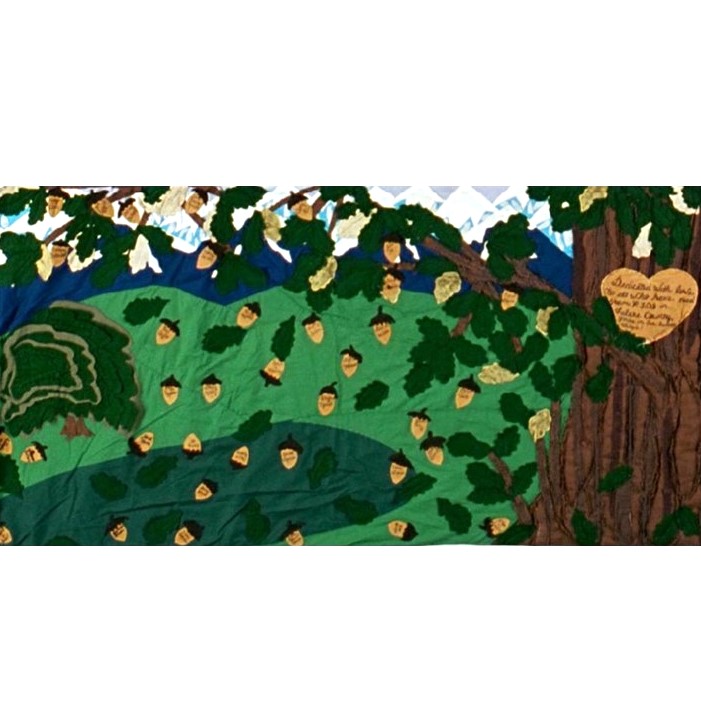
Dack Rambo, an actor best remembered for playing Jack Ewing in 51 episodes of the TV show Dallas, dies of AIDS-related illness at Delano Regional Medical Center in California at the age of 52.
Learn More.Rambo had a long list of TV credits spanning four decades and also roles in ten feature films.
Even if you couldn’t name the actor who was born Norman Jay Rambo, his face was beyond familiar to TV viewers of the 1980s, owing to appearances on everything from Charlie’s Angels to Murder, She Wrote. He held a special place in the hearts of soap fans, thanks to his roles on All My Children and Dallas.
He started his TV career with his twin brother in The Loretta Young Show. Both he and his brother played the character Peter Massey, one of seven children being raised by the widowed Christine Massey, played by Loretta Young.
He and his brother later sang as the Rambo Twins, styling themselves after the Everly Brothers, but the act ended in 1967 when his brother was killed at the age of 24 in a car accident.
During the 1970s and 1980s, Rambo made guest appearances on Marcus Welby, M.D.; House Calls; Wonder Woman; Fantasy Island; and The Love Boat. He also acted the lead role in Sword of Justice in 1978-79, and played Wesley Harper on the 1984 TV series Paper Dolls.
He earned the appellation “handsome hunk” during his days as Jack Ewing on “Dallas” and capitalized on it by launching his own line of underwear.
While working on Another World in August 1991, Rambo learned that he was infected with HIV.
He was in his dressing room that morning, preparing for his scenes, when the phone call came. After receiving his diagnosis, he put down the phone, went to the set and proceeded to tape his 40 or 50 pages of lines for the day’s work. Then he walked out of the New York studio that Friday afternoon before Labor Day and never went back.
Rambo then flew home to the San Joaquin town of Earlimart, not far from where he grew up. He broke the news to his sister, Beverly, 48, and his mother, Beatrice, 82, according to People magazine. Both took the news hard.
“At first I was totally devastated,” Beverly told People. “We lost one brother, and I didn’t think I could live with losing another.”
Retreating to his Earlimart ranch, Rambo spent the next three weeks in bed, he says, “wallowing in self-pity.”
“First of all, I was scared,” he told The Washington Post. “I felt a lot of anger and a lot of rage. And actually wanting to die. But all those things were short-lived.”
He took time to determine what he wanted to do next. He decided to go public with his HIV-positive diagnosis and released a statement announcing that he had the AIDS virus and would devote himself to working for the cause of AIDS education and research.
Rambo was among the first well-known actors to disclose his HIV status. In an interview with the Los Angles Times shortly after his announcement, he disclosed that he was bisexual and talked about feeling on the set of Dallas that he was suspected of being gay and vulnerable to AIDS.
“I knew there were whispers going on behind my back,” he said. “Either ‘he’s gay’ or ‘he’s this or ….’ People were just assuming. And people didn’t really know anything about my private life.”
A few months later, in late 1991, Rambo told The Wasington Post, “I feel fabulous, I’ve never felt better.”
He said he adopted a healthier lifestyle and even stopped dying his hair, which had been graying since he was 30 years old.
“I don’t drink anymore … I really baby myself and I’m very selfish with myself,” he said. “I don’t want anyone to interfere with me taking care of myself.”
He said he regularly sought advice on nutrition, read everything he could on AIDS and followed the conventional wisdom of treating the virus before it could become a full-blown disease. He said he had yet to suffer any symptoms of AIDS and was in ongoing discussions with doctors about what medications he should take.
Around that time, Rambo began volunteering with APLA (AIDS Project Los Angeles), one of the largest AIDS service providers in the country.
“He’s very committed to this,” said Anthony Sprauve, director of communications for APLA.
Shortly afterward, Rambo developed an AIDS-related cancer and underwent chemotherapy. He also turned to holistic treatment, according to People magazine. In the summer of 1993, he thought he’d halted the virus through prayer.
“There is no disease that cannot be healed,” he said then. “I will believe that until the day I drop.”
Rambo died at Delano Regional Medical Center in Earlimart.
* * * * * * * *
Photo of quilt panel from the AIDS Memorial Quilt
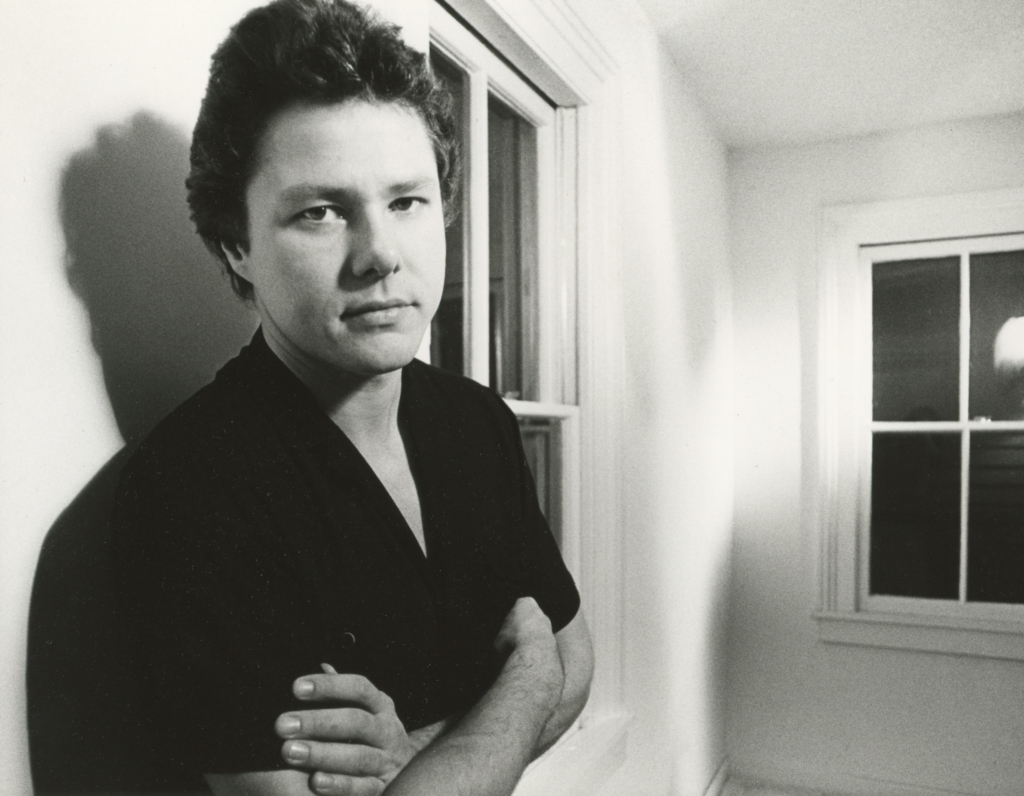
Musician and songwriter Dan Hartman dies of AIDS-related illness at his Westport, Connecticut home at the age of 43.
[photo by Jerry King Musser]
Learn More.Hartman wrote and recorded “Free Ride” (1973) with The Edgar Winter Group and collaborated with scores of the country’s top recording artists from 1976 to 1994.
His song, “I Can Dream About You,” reached No. 6 on the Billboard Hot 100 in 1984 and No. 12 on the UK Singles Chart in 1985. The James Brown song “Living in America,” which Hartman co-wrote and produced, was even more successful, reaching No. 4 in March 1986.
Hartman worked with veteran singer-songwriter Neil Sedaka, who lived near him in Westport. Hartman would invite Sedaka to his home studio to record.
“I was proud to have recorded two LP’s with him,” Sedaka said. “He was so respected, that he was able to get such luminaries as Edgar Winter, Rick Derringer, Mary Wilson, Ashford & Simpson, and Gary U.S. Bonds to join me on several duets.”
Hartman’s longtime friend Glenn Ellison told the website Memories of Dan Hartman: “Dan was the genuine article, full of passion and joy for just living. He definitely has a spiritual side, that wasn’t so religious, as it was about the soul, and how to make the most out of the time we have on earth.”
Ellison said he and Hartman met in January 1984 on a plane travelling from New York to Los Angeles. Two months later, Ellison got a job offer in New York, and Hartman invited him to live in his house until he found a place of his own.
“I was in and out of Westport for the next 10 years,” Ellison said.
One of Ellison’s favorite memories was Hartman’s European tour when “I Can Dream About You” was climbing the charts. He noticed that every time Hartman sang the song, crowds would respond by singing and dancing with him.
“When you hear the song today, there is the same response. It is an all-time pop masterpiece,” he said.
Hartman was diagnosed with HIV in the late 1980s, and kept his HIV status a secret and supposedly did not seek treatment, even after friend and intermittent collaborator Holly Johnson (formerly of the band Frankie Goes to Hollywood) announced his own HIV status in 1991.
In 1993, Hartman’s health declined and he was in and out of the hospital. Ellison had returned to California a few years before and was able to see Hartman only periodically.
“As fate would have it, in December, I was out of a job so I flew back and spent the entire month at his newly remodelled home. We had the greatest time of our ten-year friendship,” Ellison recalled. “He rallied and seemed to be making a full recovery. We turned the house into a Christmas fantasy, saw all the holiday shows in Manhattan and laughed 24/7. When I flew back to LA on New Year’s Day, I thought he would live forever.”
Hartman would die about four months later.
In his last will and testament, Hartman created the Dan Hartman Arts and Music Foundation (located in the Los Angeles area).
[photo by Jerry King Musser]

British figure skater and Olympic gold medalist John Curry dies of AIDS-related illness in Binton, Warwickshire, at the age of 44.
Learn More.As a young child, Curry became a skater because his parents wouldn’t let him study dance. But when Curry was 16 years old, his father committed suicide, and two years later, Curry began training in ballet in addition to skating.
His dedication to both arts resulted in a distinctive skating style and this eventually brought him to the Olympic Winter Games at Innsbruck in February 1976, where he won the gold medal.
“Already in the lead after the first two sections of his event, [Curry] skated a program that was superb in its cool beauty of movement,” wrote Dennis L. Bird, a culture writer for the UK publication Independent. “There were three immaculate triple jumps, and the whole performance was a perfect blend of athletic skating and musical interpretation. Leon Minkus’s ballet Don Quixote had surely never inspired such artistry.”
Following the 1976 World Championships, Curry turned professional and founded a skating company. For about 10 years, he choreographed routines for the company and toured his skaters much like a traditional dance company.
In early November 1987, Curry dazzled the audience with two performances at ”Skating for Life – A Celebration of Champions,” an AIDS benefit show in New York City. His first appearance was a solo performance that incorporated mime and dance with skating, and he skated again in a romantic duet with U.S. champion skater Judy Blumberg.
“The image of Mr. Curry as the epitome of a ballroom dancer is new,” wrote New York Times dance critic Anna Kisselgoff. “But unwinding in and out of embraces, he and Miss Blumberg, a first-rate dramatic skater, made for a picture in tenderness.”
Curry’s final public performance would be later that month in “Ice Stars’ Hollywood Revue,” a CBS special.
In December 1987, Curry was diagnosed with HIV, and in mid-1991 with AIDS. In October 1992, he gave an interview to the London Mail in which he spoke about both his disease and his sexual orientation.
“My whole circle of friends died. I don’t mean lovers, but I’m talking about people you go to the theater or to dinner with,” he told the Mail.
Following Curry’s death, Dennis L. Bird wrote in the Independent:
“The word ‘genius’ should be used sparingly, but it is entirely justified in relation to John Curry. To the prescribed disciplines of ice-skating he brought a free-ranging artistry, an innovative imagination and musical sensitivity, which in effect created a new art-form: the re-interpretation of some of the great composers in terms of movement on ice.
Curry is still remembered as one of the greatest stylists and artists in figure-skating history.
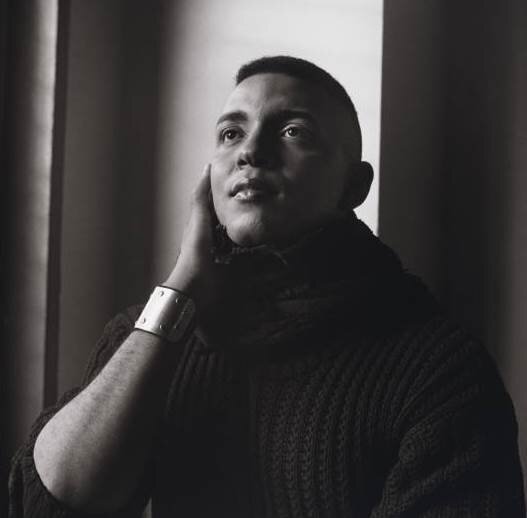
Assotto Saint, a Haitian-born poet and performance artist, dies of AIDS-related illness in New York City at the age of 36.
Learn More.Among the first Black activists to disclose his HIV positive status, Saint was one of the first poets to include the subject of AIDS in his work. He was also a performance artist, musician, editor, human rights and AIDS activist, theatrical founder, and dancer.
After immigrating from Haiti to New York in 1970 when he was 13 years old, Saint graduated from Jamaica High School and was briefly enrolled as a pre-med student at Queens College. Soon, however, he turned his attention to theater and dance, and adopted the name Assotto Saint —“Assotto” for a ceremonial drum used in Haitian vodoo rituals and “Saint” for Haitian revolutionary leader Toussaint L’Ouverture. Through the 1970s, Saint’s passions grew to include poetry, music, and fiction.
In 1980, Saint fell in love with Jaan Urban Holmgren, a Swedish-born composer, and they began to collaborate on a number of theatrical and musical projects. Their relationship would last 14 years, during which time Holmgren would write songs for Saint’s many theater pieces on gay Black life, including including Risin’ to the Love We Need and New Love Song. Saint was the founder and artistic director of Metamorphosis Theater, where many of their collaborative pieces were performed.
Saint founded the publishing house Galiens Press, which published his book of poems Stations and the anthologies Here to Dare and The Road Before Us. With Holmgren, Saint also performed as lead singer in the “techno pop duo” band Xotika, and released the dance song “Forever Gay” on the album Feeding the Flame: Songs by Men to End AIDS.
Saint was dancer with the Martha Graham company, and appeared in Marlon Riggs’ Non Je Ne Regrette Rien (No Regret).
“Assotto was always prepared to die,” writes author Victoria Brownworth for Lambda Literary. “If that makes him sound like a fatalist or a Zen master, he was neither. He was just clear about what was going to happen. And he knew the work had to be done and quickly, urgently, before time ran out.”
Here is the beginning of Saint’s final poem for his life-partner, Jan Holmgren, who was dying of AIDS:
A Lover’s Diary
monday, march 29, 1993
-01-
vigil on two chairs
iwhisper “hey, good morning”
he doesn’t respond
iwatch his labored breathings
the head nurse suctions him up
-02-
“he’s turned for the worse”
dr mcmeeking mumbles
weeks, days, just can’t tell
“hours” insists my mother
furious iescort her out
-03-
the oscars come on
the crying game stars don’t win
hoping he can hear
iremind him he’s my light
death rattles my scream for help
-04-
the nurse rushes in
mother returns with prayers
icradle him close
pleading “stay, one more day, stay”
eleven twenty, he’s gone
-05-
bathe him with my tears
parched lips thirst for a wet
kiss
istick my tongue deep
bitter taste of bloody phlegm
moans spat out ishut his eyes

Barry Cundiff, a member of the leather-faerie community in San Francisco, dies of AIDS-related illness at the age of 44.
Learn More.Known in the leather-faerie community as “Daddy Bear Rings,” Cundiff helped fuse the local Radical Faerie and leather movements with the group Black Leather Wings. Gay men, lesbians and other leather enthusiasts created the group as a place where they could combine radical sexuality with spiritual growth.
Cundiff attended his first Radical Faeries meeting in 1982 and also joined the Kathar Sissies, a faerie-inspired group devoted to spiritual healing through erotic ritual.
Born in Kansas, Cundiff relocated to San Francisco in the late 1970s after living for a few years in Los Angeles.
* * * * * * * *
Photo of quilt panel from the AIDS Memorial Quilt
Joel Harrison, an Alvin Ailey protégé who founded the Hudson Repertory Dance Theater, dies of AIDS-related illness at the age of 47.
Learn More.After spending much of the 1970s and early 1980s dancing with Alvin Ailey’s company in New York, the New York City and San Francisco Opera Ballets, the National Ballet of Venezuela. and the Carlos Carvajal’s Dance Spectrum in the Bay Area, Harrison returned to his hometown of Jersey City, New Jersey and founded the Hudson Repertory Dance Theater in 1983.
Harrison said he was inspired to create his own dance company by Arthur Mitchell, the New York City ballet dancer who created the Dance Theater of Harlem, according an interview with The New York Times.
“The whole premise of the company is to create a facility for minority artists from all cultural backgrounds,” Harrison told Barbara Gilford of The Times, ”and to mount and show their work – whether dancers, choreographers, musicians or composers.”
In the forming of his dance company, Harrison strove to create a microcosm of the racial and ethnic diversity of Hudson County. The result was a company that included Japanese, Chinese, Black, Hispanic and white dancers.
Located in the Barrow Mansion, a large, white Greek Revival-style building on Wayne Street in Jersey City, the Hudson Repertory Dance Theater held classes for its 75 students as well as rehearsals and performances.
The company’s most popular show occurred in December, with Harrison’s annual production of Ebenezer’s Dream, a ballet based on A Christmas Carol by Charles Dickens. In 1988, Harrison began holding performances at the Park Theater in Union City, New Jersey.
“We have to educate, especially in Hudson County, and create an impact on the population here,” Mr. Harrison said.
Harrison’s aunt, N. Beatrice Worthy, recalled the day she realized her nephew had a talent for dance.
“One Saturday morning, I was cleaning my room and had gone into another room to get something. When I got back, Odessa’s son Joel, who was about five or six years old, was dancing to one of the records I had on my record player — Brahms or something. He didn’t know I was watching him, but I was so amazed at how he could dance,” she told Karen Leahy of The New Sun. “I didn’t say anything to him, but I went to his mother and said, ‘You have got to put that child in dance school!'”
Harrison became a dedicated student of classical ballet at the American Ballet Theater School and at Juilliard. He undertook additional studies in modern dance at the Merce Cunningham Studio and with Alwin Nikolais, according to The Times.
Harrison’s Aunt Beatrice said that she was also there to help her nephew create the Hudson Repertory Dance Theater, and she was pleased to see that he had grown up to be a man with a generosity of spirit.
“When he was running the dance school, there was a little fellow whose mother couldn’t afford to pay the 25 cents for dance classes, but he would go along with a friend of his and stand in the corner to watch,” Worthy recalled. “Joel turned around and saw the boy trying to do what the others were doing, so he brought him in and let him take classes without charge.”
Following Harrison’s death, Worthy became head of the Hudson Repertory Dance School.
“Of all the things I’ve done in my lifetime, I think I’m proudest of the dance school,” she said.
Joel Harrison is memorialized with a biography on Dancers We Lost: Honoring Performers Lost to HIV/AIDS.
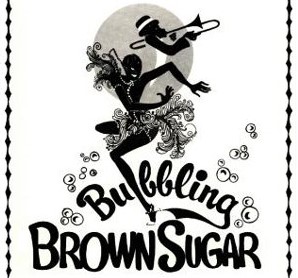
Billy Wilson, the director and choreographer of Bubbling Brown Sugar and other Broadway musicals, dies of AIDS-related illness at St. Vincent’s Hospital in Manhattan. He was 59.
Learn More.“Wilson was known as an experienced and dependable director who injected extra life and energy into his productions, adding small, telling details and encouraging performers to be more expressive than they believed they were,” according to New York Times art critic Jennifer Dunning.
In a 1976 interview in The Times, he described the process of turning Guys and Dolls into a Black musical as something “like taking chicken soup and making it a little more gumbo.”
Born William Adolphus Wilson, he was raised in Philadelphia and received a scholarship at 15 to study classical ballet with Anthony Tudor. He made his New York debut at age 19 in the City Center production of Carmen Jones and went on to dance on Broadway in Bells are Ringing and Jamaica.
He went to London to perform in a production of West Side Story, and remained in Europe for 10 years. From 1961 to 1965, he was a soloist with the Dutch National Ballet, where he starred in Othello, a ballet created for him by Serge Lifar.
He returned to the U.S. an international ballet star.
On Broadway, Wilson choreographed and staged shows that included Eubie, for which he shared credit with Henry Le Tang; Merlin; a production of Stop the World, I Want to Get Off with Sammy Davis Jr.; and Alan J. Lerner’s last Broadway show, Dance a Little Closer, along with the 1976 hit Bubbling Brown Sugar.
He was nominated for three Tony Awards, and he directed and choreographed the all-black production of Guys and Dolls in 1976 and choreographed the Emmy Award-winning television show Zoom.
He married Sonia van Beers, a fellow dancer, and became father to a daughter, Alexis, and son, Parker.
In the late 1970s, Wilson became life partners with Chip Garnett, and they remained together for 18 years, until Garnett died. Wilson would die just six months later.
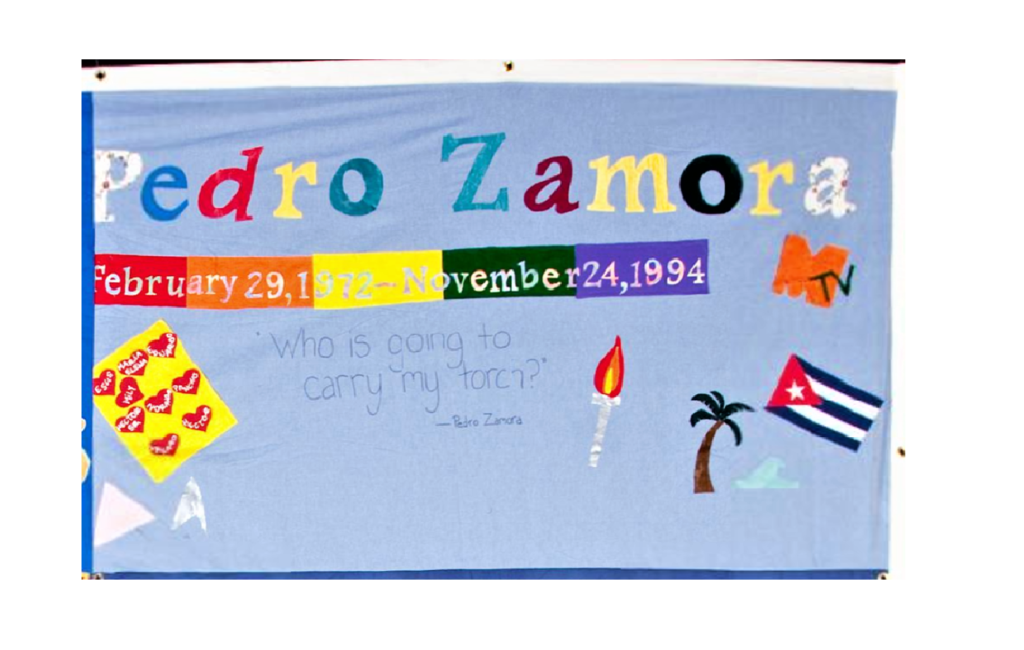
Pedro Zamora, an HIV-positive man appearing in MTV’s popular show The Real World, dies of AIDS-related illness at age 22.
Learn More.As one of the first openly gay men with AIDS in media, Zamora brings international attention to HIV/AIDS and LGBT issues and prejudices through his appearance on MTV’s reality television series, The Real World: San Francisco.
Zamora’s commitment ceremony to his partner Sean Sasser, which is filmed for the show, is also the first same-sex ceremony in television history. Zamora dies just hours after the finale of The Real World: San Francisco aired on MTV.
* * * * * * * *
Photo of quilt panel from the AIDS Memorial Quilt
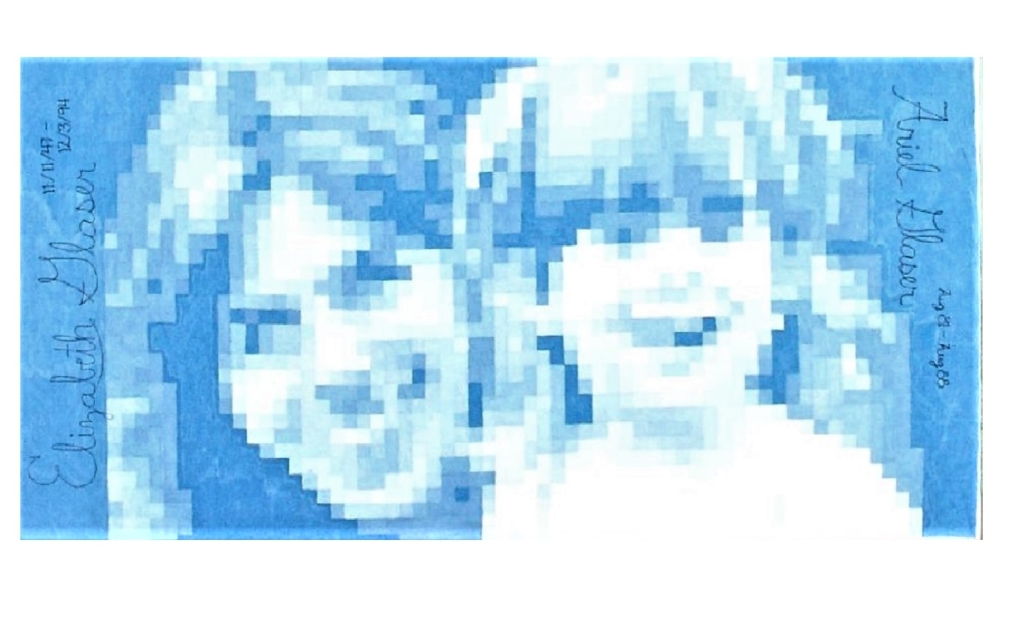
Elizabeth Glaser, founder of the Pediatric AIDS Foundation, dies of AIDS-related illness at the age of 47.
Learn More.Glaser contracted HIV in a blood transfusion in 1981 while giving birth to her daughter, Ariel. She and her husband, Paul, would learn four years later that she was HIV+ and she had unknowingly passed the virus on to Ariel through breast milk and that their son, Jake, had contracted the virus in utero.
The Glasers pulled their daughter out of school, fearful of media exposure and ostracism imposed by parents of other students. Newspapers in 1985 were filled with stories about the plight of Ryan White in Kokomo, Indiana, and the three Ray brothers in Arcadia, Florida — all hemophiliacs who, having been infected with the AIDS virus by blood transfusions, had been ostracized and barred from their schools.
Ariel Glaser had developed AIDS at a time when the medical community knew very little about the disease, and there were no available treatment options for children. The U.S. Food and Drug Administration finally approved AZT in early 1987 as an effective drug to extend the lives of AIDS patients, but the approval only extended to adults. With their daughter’s condition rapidly deteriorating, the Glasers fought to have her treated with AZT intravenously. However, the treatment came too late, and Ariel died in the summer of 1988, shortly after her seventh birthday.
Elizabeth Glaser went to Washington to do research on AIDS at the National Institutes of Health and found that people in power were willing to listen to her story. She was able to mobilize legislators like Senators Orrin Hatch and Howard Metzenbaum to co-sponsor a fund-raising benefit in Washington for her new organization, the Pediatric AIDS Foundation.
With the help of her friends Susie Zeegen and Susan De Laurentis, Glaser created the foundation to raise money for basic pediatric research. The foundation also supported additional clinical tests for the medication AZT, which was prescribed for adults years before it was given to children.
In 1994, to honor Glaser’s legacy, the Pediatric AIDS Foundation was renamed the Elizabeth Glaser Pediatric AIDS Foundation. EGPAF has become the leading global nonprofit organization dedicated to preventing pediatric HIV infection and eliminating pediatric AIDS through research, advocacy, and prevention and treatment programs. Another important legacy of Glaser’s is her son, Jake, who is now a healthy adult who advocates for pediatric research.
* * * * * * * *
Photo of quilt panel from the AIDS Memorial Quilt
AIDS becomes the leading cause of death among all Americans aged 25 to 44, new Federal data shows.
Learn More.By the end of 1994, more than 440,000 cases of AIDS, including more than 6,000 among children, are reported since the epidemic was first recognized in 1981.
More than 250,000 people are already dead from AIDS or AIDS-related causes.
About 75% of all cases have been reported in the 25-to-44 age group.
Keith McDaniel, who was a principal artist with the Alvin Ailey American Dance Theater and on Broadway, dies of AIDS-related illness at his Los Angeles home at the age of 38.
Learn More.Film and stage superstar Shirley MacLaine said of McDaniel: “He was dynamic, strong, and possessed a muscled body that inspired awe on the stage.”
A Chicago native, McDaniel was known around the world as a master of modern dance technique and for his ability to stand out onstage “for the quiet radiance he brought to all his roles,” according to art critic Jennifer Dunning of The New York Times.
He began his career in 1975 with the Alvin Ailey American Dance Theater, where he performed as a naïve youngster in Donald McKayle’s District Storyville and Talley Beatty’s Stack-Up. McDaniel transitioned seamlessly to more mature roles, like the sensual lover in Elisa Monte’s Treading and the ecstatic baptismal celebrant in Ailey’s Revelations.
After he leaving the Ailey Company in 1983, he appeared on Broadway in Leader of the Pack, and then Kiss of the Spider Woman as a lead dancer and dance captain, partnering with Chita Rivera.
McDaniel moved to Los Angeles to work in film, television and music videos, appearing in Beaches, Great Balls of Fire, The Lady Killers, and Basic Instinct. On television, he was seen on the Tracey Ullman Show, Moonlighting, and several Academy Awards broadcasts.
“He was,” remembered Matt Tapscott, his partner, “a very kind, caring, loving and spiritual person who was totally committed to his career and his family.”
McDaniel is memorialized in the project Dancers We Lost: Honoring Performers Lost to HIV/AIDS.
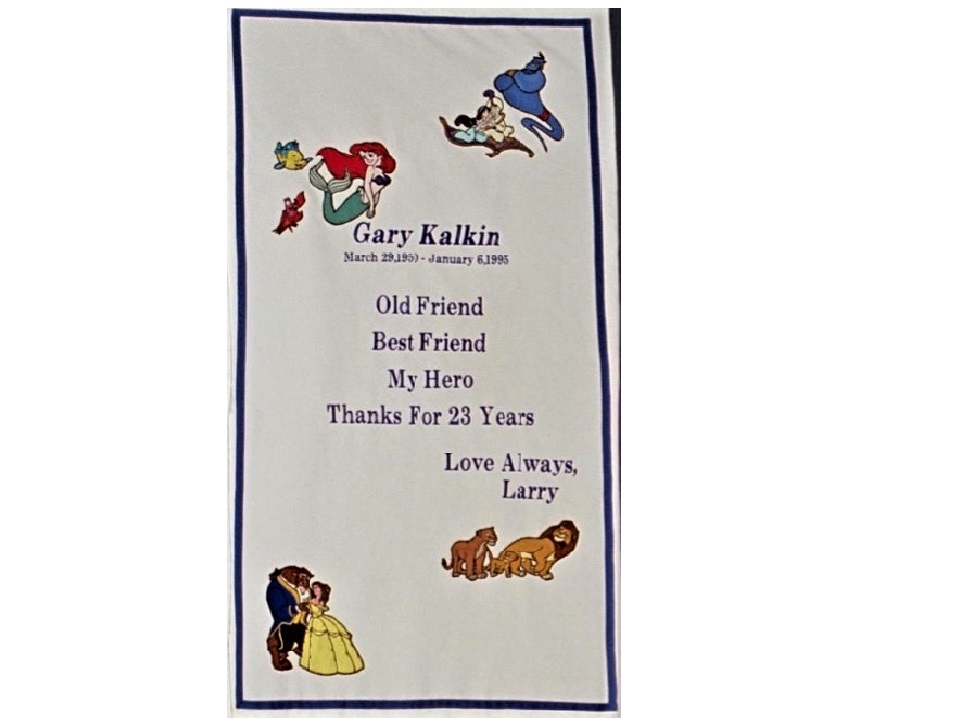
Gary Kalkin, a top executive at Walt Disney Studios who guided the marketing campaigns for Beauty and the Beast, Aladdin and The Lion King, dies of AIDS-related illness at his home in Los Angeles. He was 44.
Learn More.As senior vice president of domestic marketing for Buena Vista Pictures Marketing, Kalkin supervised promotion, advertising and publicity campaigns for Touchstone and Hollywood Pictures as well as Disney. Kalkin also played a creative role in promoting Disney’s Broadway stage version of Beauty and the Beast.
Jeffrey Katzenberg, former chairman of Walt Disney studios, said that Mr. Kalkin also guided the campaigns for the hits Who Framed Roger Rabbit, Down and Out in Beverly Hills, Good Morning, Vietnam and Pretty Woman. Despite his illness, Kalkin helped supervise the marketing of the Tim Allen comedy The Santa Clause, which emerged as one of the most successful films of 1994.
* * * * * * * *
Photo of quilt panel from the AIDS Memorial Quilt
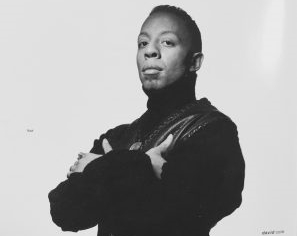
Record producer and songwriter David Cole dies of AIDS-related illness at the age of 32.
Learn More.Half of the dance-music duo C+C Music Factory, Cole and his musical partner Robert Clivillés produced numerous high-energy dance tracks, such as “Make You Sweat (Everybody Dance Now),” “Here We Go Let’s Rock & Roll” and “Things That Make You Go Hmmm.”
The New York-based act solidified their white-hot status when they won the 1991 Billboard Award for Best New Pop Artist, beating out Boyz II Men, Color Me Badd, EMF and others. After performing an elaborately choreographed medley of their hits, Cole and Clivillés along with vocalists Zelma Davis and Freedom Williams assembled at the podium to accept their award. It was one of the last appearances C&C Music Factory would ever make together.
Cole and Clivillés met in the mid 80s, when both were DJing at New York City clubs. Before they had their big break with “Make You Sweat,” they worked behind-the-scenes, co-writing and producing songs for artists like Chaka Khan and Grace Jones, co-producing remixes, and acting as managers for various groups. Together, they wrote and produced four songs on Mariah Carey’s 1991 album Emotions, including the smash hit title track.
Cole’s success continued to climb as he continued to produce mega-hits with Aretha Franklin, James Brown, Lisa Lisa and Cult Jam, and many top musical acts of the late ’80s and early ’90s. Cole won a Grammy for the soundtrack for the hit movie The Bodyguard (1992) starring Kevin Costner and Whitney Houston.
Cole died on January 24, 1995 from spinal meningitis brought on by HIV at the age of 32.
Mariah Carey wrote the song “One Sweet Day” in memory of Cole.
In a 2018 interview with pitchfork, Carey spoke about Cole:
“He was one of the only people I used to have in the studio when I would sing, because I respected him as a singer. He would push me in different areas where he could actually sing it to me and I would be like, ‘Oh, this is cool. I like that’ … Half the time, I would lose my voice afterwards, because he would just push me.”
The tribute to Cole on thegranvarones reads:
“I remember watching MTV when the news of David’s death broke. The realization that fame and talent could not and would not protect the young and talented knocked the wind out of me. Even now as an adult, I am still saddened by the loss of such a brilliant artist. David Cole, in his all too brief time on this planet, blessed us with a catalog of music that has and will continue to inspire generations. Rest well, David. May you forever dance in peace!”
Joseph Hollinger, a lifelong Bay Area resident who organized several AIDS fundraisers and leather pride parade floats, dies of AIDS-related illness at his mother’s home. He was 32.
Learn More.Hollinger and his partner, Rodney Barnal, operated a landscaping business in Santa Cruz. When Barnal died of AIDS-related illness in 1988, Hollinger maintained the business until his own health began to decline in 1993, according to the Bay Area Reporter.
In 1990, Hollinger won the title of Mr. San Francisco Eagle Leather and placed third at the International Mr. Leather competition. He wrote a widely-read leather column for the Sentinel and was nominated for a Cable Car award for his work.

Scott Smith, a gay rights activist best known for his romantic relationship with Harvey Milk, dies of AIDS-related illness at San Francisco General Hospital at the age of 46.
Photo courtesy of the San Francisco History Center, San Francisco Public Library.
Learn More.Smith was instrumental to the political career of Harvey Milk, the first openly gay man to be elected to public office in California. Smith organized and managed Milk’s campaigns for public office from 1974 to 1977, and he continued to influence Milk after the latter was elected to the San Francisco Board of Supervisors in 1977.
In 1972, Milk and Smith were down to their last $1,000 in collective savings when they decided to open Castro Camera, a photography supplies and service shop that would soon serve as Milk’s campaign headquarters. At the time, Milk and Smith were in a romantic relationship.
According to Randy Shilts in his book The Mayor of Castro Street: The Life and Times of Harvey Milk (1982), Milk and Smith needed to find a cheap place to live and a way to make money. They chose the Castro District because they heard that apartments there were cheap and they knew of two gay bars there doing booming business. Castro Camera opened at 575 Castro Street on March 3, 1973.
Later that year, Smith orchestrated the Coors Beer boycott that elevated Milk in the Bay Area’s political scene. One of the first public displays of power by the gay community, the boycott galvanized support behind Teamsters against the Coors Company, which refused to employ union drivers. With Smith’s strategy, Milk convinced gay bars to boycott Coors beer and it worked — Coors caved in. In return, Milk convinced the Teamsters to hire openly gay truck drivers, solidifying Milk’s reputation as an astute political operator.
Milk and Smith followed the success of their boycott with campaigns to elect Milk to public office. First, Milk ran for the San Francisco Board of Supervisors in 1973 and again in 1975, losing both times. Then in 1976, Milk was appointed by Mayor George Moscone to the city’s Board of Permit Appeals, but he resigned the position just a few months later to run for the California State Assembly. He lost the Assembly race as well.
Finally, Milk was elected to the Board of Supervisors in the November 1977 election, and he was sworn into office on January 9, 1978, becoming the first openly gay man to be elected to public office in California.
When Milk was assassinated on November 27, 1978, Smith’s life was thrown into turmoil.
In the days that followed, Milk’s body was laid in state in the City Hall Rotunda. On November 29, a memorial service was held at City Hall, followed by another service at Temple Emmanue-El. Milk’s body was cremated and his ashes were wrapped in a Doonsebury comic-strip to acknowledge his love for newspaper comics, and “RIP” was spelled out in rhinestones. Smith and a few others of Milk’s closest friends scattered the ashes in San Francisco Bay, according to Bob Kelley, curator of the photo presentation Harvey Milk, Second Sight.
The violent death of the man who had guided Smith’s personal and professional life since he was 22 years old had a devastating impact, according to Randy Shilts in his biography of Milk.
“Since most media attention focused on the political heirs of Harvey Milk — who had long considered Scott to be little more than the camera store’s clerk — Smith became increasingly embittered in the month’s after the assassination, complaining that he had never gotten due credit for propping up the business that gave Milk his political base,” Shilts wrote.
Smith was executor of Milk’s last will and testament, a job that came with the tedious process of resolving Milk’s debts and other open affairs, and he also became head of the Harvey Milk Archives, spending long hours organizing Milk’s papers, speeches, photographs and other ephemera. Now located in the James C. Hormel Gay and Lesbian Center at the San Francisco Public Library, the Harvey Milk Archives/Scott Smith Collection contains hundreds of photographs of Smith taken by Milk, the latter who sometimes spent entire rolls of film on candid images of his favorite model.
Smith converted Castro Camera into an art gallery. When more than a year had passed since Milk’s death and Smith was still in the throes of a deep depression, the city’s public health director reached out to Scott with counseling resources. It was almost two years before Smith could begin reconstructing his life.
In the early 1980s, Smith left the world of politics and started afresh as a travel agent, according to SFGATE. He continued to work on the Harvey Milk Archives, earning the nickname of “The Widow Milk” from his friends.
On January 21, 1995, just weeks before his death, Smith attended the world premiere of the Houston Grand Opera’s Harvey Milk, by librettist Michael Korie and composer Stewart Wallace. Smith was well-known as an opera buff, a passion he had shared with Milk. The afternoon before the opening, Smith took part in a panel discussion and traded reminiscences with five others who personally knew Milk.
When news of Smith’s death reached the Houston Grand Opera, they dedicated the final performances of Harvey Milks’ run to Smith. The opera, in which Smith appeared as a principal character, would be reprised at the San Francisco Opera in late 1996.
Following Smith’s death, the San Francisco Board of Supervisors, acting on a resolution by Supervisor Tom Ammiano, adjourned its meeting in Smith’s memory. A potluck party was held to celebrate Smith’s life, fittingly, at the photography studio of longtime friend Danny Nicoletta. Nicoletta had worked in Smith and Milk’s camera shop in the 1970s.
In the 2008 feature film Milk, the role of Scott Smith was played by James Franco.
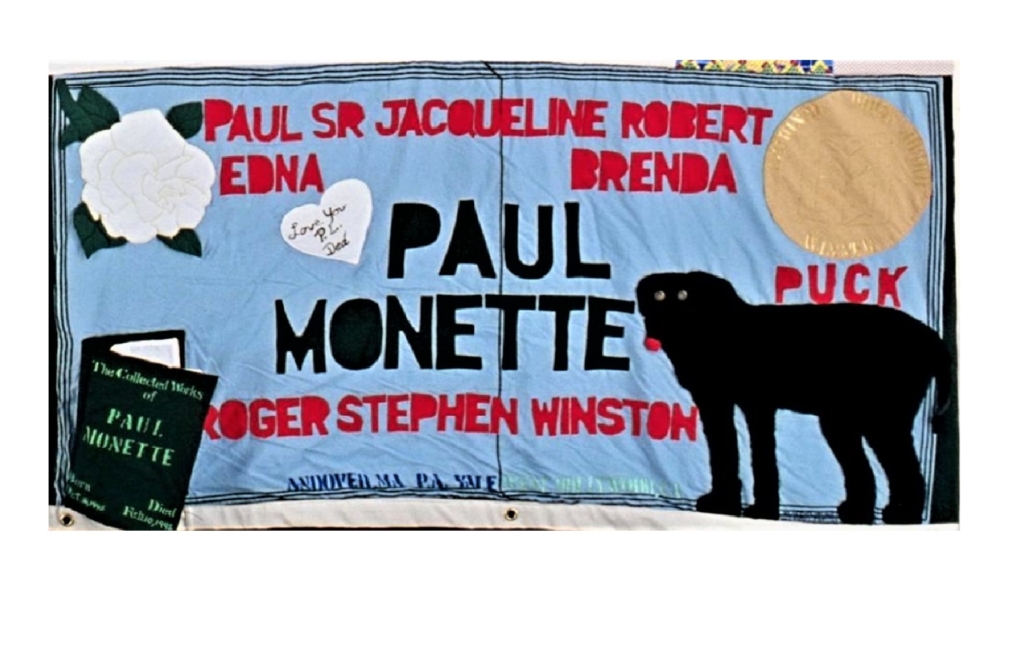
Paul Monette, author of the award-winning Borrowed Time: An AIDS Memoir, dies at his home in West Hollywood of AIDS-related illness at the age of 49.
Learn More.Borrowed Time chronicles Monette’s experience caring for his partner Roger Horwitz during his fight with AIDS and eventual death from AIDS. The memoir details the final nineteen months of Horwitz’s life, beginning with the day that he was first diagnosed with AIDS, which Monette describtes as “the day we began to live on the moon.”
Born in 1945 in Lawrence, Massachusetts, Monette was educated at prestigious schools in New England: Phillips Andover Academy and Yale University, where he received his B.A. in 1967. Soon after graduating from Yale, he began a prolific writing career, and for eight years, he wrote poetry exclusively.
After coming out in his late twenties, he met Roger Horwitz, who was to be his lover for over twenty years. At around this time, he grew disillusioned with poetry and shifted his interest to the novel, not to return to poetry until the 1980s.
In 1977, the couple moved to Los Angeles, and Monette wrote a number of screenplays that, though never produced, provided him the means to be a writer. Monette published four novels between 1978 and 1982 that were enormously successful, including Taking Care of Mrs. Carroll and The Gold Diggers, and established himself as a writer of popular fiction.
“He was a capable writer, but he had not discovered his voice. When AIDS arrived, he found it,” writes Legacy Project Chicago in its tribute to Monette. “On the front lines of the epidemic he picked up his pen and began to capture the horror as it happened.
In the year following Horwitz’s death in 1986, Monette wrote Borrowed Time, and its 1988 release catapulted him into the national arena as a spokesperson for AIDS. Since very few out gay men had the opportunity to address national issues in mainstream venues at any previous time in U.S. history, Monette’s high-visibility profile was one of his most significant achievements.
For Borrowed Time, Monette won PEN Center West literary award and was a finalist for the National Book Critics Circle Award. He went on to write two important novels about AIDS, Afterlife (1990) and Halfway Home (1991).
In 1992, Monette released the memoir Becoming a Man: Half a Life Story, an uncompromising look at coming to terms with being a gay man. In the book, he wrote: “I can’t conceive the hidden life anymore, don’t think of it as life. When you finally come out, there’s a pain that stops, and you know it will never hurt like that again, no matter how much you lose or how bad you die.”
This would become the first LGBTQ studies title to win the 1992 National Book Award.
He followed Becoming a Man with a book of essays, Last Watch of the Night (1994), which he wrote while being treated for full-blown AIDS, hooked up to three intravenous tubes and taking a daily regimen of numerous oral medications. The book is a collection of essays that move through themes from the painful lives of gay priests to the unending bigotry against gay men.
Monette also wrote an episode for the popular television series Thirtysomething about an advertising executive who learns he has the AIDS virus. The show, written with Richard Kramer, a producer for the series, was one of the first prime-time network series to deal with AIDS.
* * * * * * * *
Photo of quilt panel from the AIDS Memorial Quilt

Rapper Eazy-E dies from AIDS-related illness at the age of 31, one month after being diagnosed.
Learn More.As a founding member of the rap group N.W.A. (which stands for Niggaz Wit’ Attitude), Eazy-E was the executive producer of the gangster rap album, Straight Outta Compton, released in 1988. The album’s raps about gunplay, drug dealing, raw sex, gang solidarity and police harassment in a Los Angeles suburb included one song that is a fantasy of violent revenge against racist police officers.
Born Eric Lynn Wright, Eazy-E dies at Cedars-Sinai Medical Center after being hospitalized on Feb. 24 for what he thought was asthma. Tests reveal he has AIDS, and on March 16 he would release a statement that he had contracted the disease.
An album that Eazy had been working on would be released posthumously in 1995, and an EP of unreleased tracks would be issued on the seven-year anniversary of his death.
One of his children, singer E.B. Wright, would go on to produce A Ruthless Scandal, a documentary about the final days of her father’s life. His story is also depicted in the 2015 biopic Straight Outta Compton, directed by F. Gary Gray.
* * * * * * * *
Photo of quilt panel from the AIDS Memorial Quilt

Irish pop star Jimmy McShane, who was a “one-hit wonder” in the U.S. with the song “Tarzan Boy,” dies of AIDS-related illness in his hometown of Derry. He was 37.
Learn More.“Tarzan Boy” was the 1985 debut single by the Italian-based act Baltimora, which consisted of Jimmy McShane and Maurizio Bassi. The song went top five across Europe, reached number three in the U.K, top five in Japan and reached No 13 in the U.S.
Born in Derry in 1957, McShane was drawn to performing at a young age, and he enjoyed dying his hair and wearing unconventional clothes.
“He had a tough time growing up,” his brother Damien McShane told the Derry Journal in 2018. “He had a larger-than-life personality and naturally people gravitated towards him, but his years at St. Peter’s were difficult for him. Jim was bullied the entire time for being different, and at the time, I never even considered that he was gay, it just wasn’t talked about.”
At the first chance he got, he moved to London to attend stage school and subsequently tried – and failed – to break into the West End musical scene. A few years later, he returned to Derry and took a job as an emergency medical technician with the Red Cross, according to the Belfast Telegraph.
But then a friend from London reached out and things brightened for McShane. Disco singer Dee D. Jackson needed back-up dancers for her European tour, and McShane embraced the opportunity.
When the act toured Italy, McShane fell in love with the country and particularly enjoyed its underground dance scene, according to The Living Room by Matt and Andrej Koymasky. In 1985, he made Milan his new home and learned to speak Italian.
Italian producer Maurizio Bassi approached McShane about being the lead singer for his new project, Baltimora, and in 1985 they released their first single, “Tarzan Boy.” With its distinctive jungle call, the song became a huge hit and Baltimora were suddenly international pop stars. The next year, Baltimora performed their hit song on American Bandstand (actually, McShane lip-synched), and McShane was interviewed by the legendary Dick Clark.
The media began to refer to McShane as “Baltimora,” on the misconception that it was his stage name, rather than the group’s collective title, and this caused internal strife between Bassi and McShane. When the band’s next single “Key Key Karimba” failed to chart in 1987, Bassi broke up the act.
McShane returned to Italy, and in 1994, he was diagnosed with AIDS. He called his family and arranged to move back to his childhood home in Derry to live out the last year of his life, according to the Derry Journal.
McShane’s brother said that before the pop artist died, he spent the last of his savings on a birthday party for his youngest nephew, James.
On the day of McShane’s funeral, the residents of Derry came out into the streets to watch the funeral procession make its way from Long Tower Church to Derry City Cemetery. Many wore red ribbons as a mark of respect for their hometown celebrity.
Tony Azito, a dancer and character actor celebrated for his ability to accentuate his lanky, hyperextended body, dies of AIDS-related illness at St. Vincent’s Medical Center in New York City. He was 46 years old.
Learn More.Tony Azito, the lanky, loose-limbed Broadway actor who led the Keystone Kops in the New York Shakespeare Festival’s 1981 production of “The Pirates of Penzance,” died yesterday at St. Vincent’s Hospital in Manhattan. He was 46 and lived in Manhattan.
The cause was AIDS, said Bonnie Egan, a friend.
Mr. Azito was born in Manhattan and attended public schools in Manhattan and Queens. He studied drama at the Juilliard School, where he worked with John Houseman in the experimental company that later became the nucleus of the Acting Company. He also studied with the dancer and choreographer Anna Sokolow.
He left Juilliard in 1976 to take the role of Mr. Peachum’s assistant in the Shakespeare in the Park production of “The Threepenny Opera.” A year later, he appeared as Dr. Nakamura in the Brecht-Weill musical “Happy End,” which starred Meryl Streep. Both performances were widely praised.
In 1980, he was nominated for a Tony Award and received a Drama Desk Award for his role as the Sergeant in “Pirates.” He also appeared in the film version of the operetta.
Mr. Azito spent four years with the LaMama Experimental Theater Company, appearing in a dozen shows. In the 1970’s, he often performed cabaret at Reno Sweeney and the Ballroom. With the Shakespeare Festival, he appeared as Bardolph in “Henry IV” (1985) and Feste in “Twelfth Night” (1986).
His film credits included “Union City,” “Private Resort” and “Bloodhounds of Broadway,” as well as small roles in “The Addams Family” and “Moonstruck.” In the television series “Miami Vice” he had a recurring role as the drug dealer Manolo.
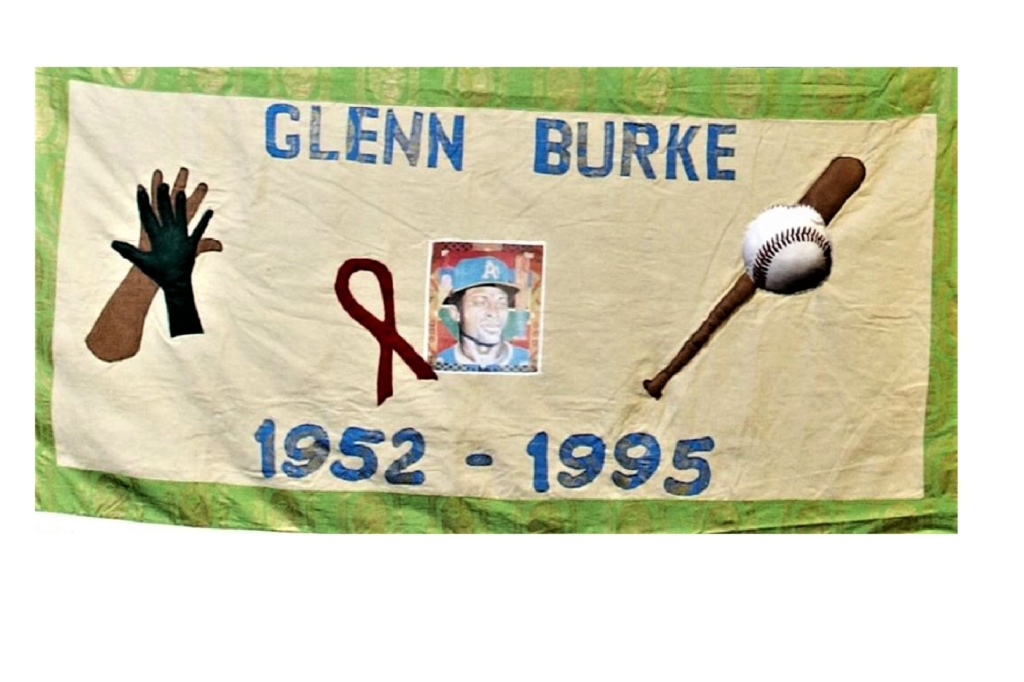
Glenn Burke, a Dodger and Oakland Athletic outfielder who later became one of the few players in the major league to acknowledge being gay, dies of AIDS-related illness at a Bay Area hospital. He was 42.
Learn More.Burke was born and raised in Oakland, California. He was a playground legend, an athlete who excelled at every sport he tried. His favorite sport in high school was basketball, but it was baseball that offered him a professional contract after graduation.
Described by many scouts as “the next Willie Mays,” Burke played major league ball with the Los Angeles Dodgers from 1976 to 1978, and with the Oakland A’s in 1978-1979. In the 225 games of his brief career, Burke batted .237, hit two home runs, had 38 RBIs and 35 stolen bases.
In 1977, after Dusty Baker hit a home run, Burke – who was the on-deck batter – gave Baker a high-five as he left the field, and has since been credited with inventing the gesture. Burke is believed to be the first major league ball player to be outed to his teammates and the owners while he was still playing.
Dodgers Manager Tommy Lasorda was angered by Burke’s friendship with his gay son, and General Manager Al Campanis offered to pay for a lavish honeymoon if Burke would get married (Burke refused), according to The Legacy Project.
The Dodgers then traded Burke to Oakland, where he saw little playing time and was forced to endure manager Billy Martin referring to him as a “faggot” in front of his teammates.
In Singled Out: The True Story of Glenn Burke, author Andrew Maraniss describes how, following a 1979 game at Oakland Coliseum where A’s fans yelled homophobic slurs at Burke in the outfield, he chased down the heckler in the concourse and grabbed him around the neck. In 1980, manager Martin demoted Burke to the A’s minor league affiliate in Utah.
At the age of 27, Burke found that his dream of a being a major league baseball player was over after four short seasons. He later wrote, “Prejudice drove me out of baseball sooner than I should have. But I wasn’t changing.”
The years following Burke’s departure from baseball was rife with drug usage, incarceration, and homelessness, marking a bitter fall from grace. However, in 1982, he won two medals for track in the first Gay Games — the same year his homosexuality was made public in an Inside Sports article.
In the article, Burke said, “It’s harder to be gay in sports than anywhere else, except maybe president. Baseball is probably the hardest sport of all.”
In his last months of his life, Burke received financial assistance from the Oakland A’s (which was under new management) and was cared for in his sister Lutha’s home.
After a few national sportswriters discovered Burke was dying of AIDS, they wrote admiringly of the man who invented the high-five and had been the first Major League baseball player to come out as gay. Soon after, letters began arriving in Lutha’s mailbox and at the Oakland Coliseum.
“There were letters from parents who praised Glenn’s kindness to their kids, letters from adults who had met Glenn as children, and letters from gay men who admired his sacrifices as a pioneer. He’d read the letters and weep,” wrote biographer Andrew Maraniss.
“They make me feel like I was sent to this earth to make certain people happier,” Burke said. “No one can say I didn’t make it. I played in the World Series. I’m in the book, and they can’t take that away from me. Not ever.”
When Burke began to weaken, Lutha arranged for him to be transferred to Fairmont Hospital in San Leandro, just south of Oakland. He died the next day.
In 2013, Burke was posthumously honored in the first class of the National Gay and Lesbian Sports Hall of Fame. Before the 2014 All-Star Game in Minnesota, Burke was honored as a gay pioneer.
In 2017, Burke was inducted into the Rainbow Honor Walk, a series of bronze panels embedded in the sidewalks of the Castro District, recognizing some of the most significant lesbian, gay, bisexual, and transgender figures in history. The occasion was celebrated on April 1, 2017 at the White Horse Inn, the oldest gay bar in the Bay Area.
In June 2021, the Oakland A’s announced that the organization would honor Burke’s legacy by renaming its annual Pride Night after him.
“Glenn Burke was a trailblazer, and we are excited and honored to recognize his legacy and impact on the game of baseball by naming our annual Pride Night after him,” said Oakland A’s President Dave Kaval. “Glenn Burke Pride Night will continue to be a time of celebration and inclusion at our ballpark as we come together with friends and allies.”
In June 2021, Burke’s biographer Andrew Maraniss wrote a Los Angeles Times column proposing that the Dodgers find a way to honor Burke.
“The first openly gay Major League player was a Dodger,” writes Maraniss. “It’s time for the Dodgers to take ownership of the homophobia that prematurely ended Glenn Burke’s days in Los Angeles so that the organization can move beyond it, stake its claim to history by centering Burke’s experience, and lead the way for LGBTQ rights in baseball.”
* * * * * * * *
Photo of quilt panel from the AIDS Memorial Quilt
Filipino singer-songwriter Rodel Belvis Naval, called “Ody” by his friends, dies of HIV-related illness in Toronto, Canada at the age of 42.
Learn More.Best known for the songs “Lumayo Ka Man Sa Akin” and “Muli,” Naval was considered one of the most versatile artists in the Philippines entertainment world. He drew thousands of fans to his concerts in Las Vegas, Los Angeles, New Mexico, Singapore, Japan, and Toronto.
Naval was 26 years old when he immigrated from the Philippines to join other family members already settled in Canada in 1979. A year later, he performed in three major concerts in Los Angeles and then a series of concerts in Las Vegas, Lake Tahoe, and Mexico.
In 1989, he returned to the Philippines and recorded his first album, Finally. After a 1990 performance in Japan, he released the album Lumayo Ka Man Sa Akin, which featured the hit song “Muli.”
The song became popular with fans both young and old, and it still remains a favored selection in Filipino karaoke bars. The second album also included Naval’s most popular song, “Lumayo Ka Man Sa Akin.”
“When the lyrics of this song was being written by Rodel in Japan, his mind was on our mom who had just passed two months earlier,” his sister Delia told Esquire Philippines. “He missed our mom so much that he wrote the lyrics within 15 minutes.”
Naval’s final album was Once Again (1992), from which the songs “Ikaw Pa Lamang” and “Kailan Kaya” enjoyed platinum success.
In 1993, Naval became ill and returned to Canada to receive medical attention, according to People Pill. While in Toronto, he auditioned for musical production Miss Saigon and won the role of assistant commissar. He continued to give performances, even while his health was in rapid decline. In April 1994, he performed in two concerts, one in Toronto and the other in Los Angeles.
In an interview before his death, Naval said, “Maybe there is a purpose to all of this, and if I can help others because of what happened to me, let it be so.”
Two years after Naval died, two of his sisters founded Rodel Naval Care Outreach (RoNaCo) to help people in the poverty-stricken areas of Manila affected by HIV.
Steve Silver, the creator and producer of the San Francisco musical revue “Beach Blanket Babylon,” dies of AIDS-related illness at his home in San Francisco. He was 51.
Learn More.A native of San Francisco who became a fixture in the city’s arts and social scene over the past two decades, Silver was notable not only for the cabaret he created in 1974, but also for his philanthropy and tireless efforts on behalf of many San Francisco charities.
Beach Blanket Babylon, believed to be the nation’s longest-running musical revue, has been seen by more than three million people, including celebrities and dignitaries like Queen Elizabeth and Bob Hope.
The San Francisco Chronicle described the show’s roots as a combination of “Vegas lounge acts, the Follies Bergere, God Rush-era extravaganzas, English music halls, a child’s birthday party gone mad, and dopey beach party movies.”
Silver, who retained creative control of Beach Blanket Babylon until his death, continually updated the show. In one of the newer numbers, actors dressed as Bill and Hillary Clinton are accosted by Newt Gingrich singing “King of the Hill, move over Bill, goodness gracious, Newt is on fire” to the tune of “Great Balls of Fire.”
A former painter, Silver came up with the idea for the show in 1974, naming it after the Annette Funicello-Frankie Avalon “Beach Blanket” movies.
Silver’s grave stone at Cypress Lawn in Colma, California includes a sketch of Silver done by legendary caricaturist Al Hirschfeld, perhaps the only Hirschfeld work executed in stone.

White Eagle, a member of the Rosebud Sioux Reservation, dies of AIDS-related illness at age 43 at his home with his family in Mission, South Dakota.
Learn More.White Eagle was the first Native American to sing lead roles in American musical theater and opera. It was the voice of the great Mario Lanza that inspired the young White Eagle to become an opera singer.
At the age of five, this minister’s son gave his first public performance in his father’s church. In 1971, he made his professional debut as a soloist at one of the nation’s largest churches, and two years later, began working with the vocal group Re-Generation.
In 1985, He graduated from the prestigious Merola Opera Program at the San Francisco Opera, and performed with the Pennsylvania Opera Theater, Florentine Opera, and Cleveland Opera, among others.
When he wasn’t involved in a production, White Eagle often performed in fundraisers for his father’s home for Native American orphans in South Dakota. On these occasions, he was known to don a Sioux chieftain’s hand-beaded white leather jacket and eagle-feather headdress, and sing “Amazing Grace” while the plate was passed.
In January 1989, White Eagle sang at the inaugural gala for newly elected President George Bush. White Eagle made his debut at New York’s prestigious Carnegie Hall in September 1993, one month after being diagnosed with AIDS. After he made his illness public, White Eagle became a tireless advocate for AIDS awareness.
“His role as advocate was equal to his role as artist, because through his voice, through his message, he brought people together,” reads a memorial to White Eagle in the U.S. Congressional Record on July 11, 1995, five days after his death.
In the course of his career, White Eagle performed more than 4,000 concerts to some five million people in the U.S. and Canada.
* * * * * * * *
Photo of quilt panel from the AIDS Memorial Quilt
Disc jockey JJ Chan, the first Chinese person living with AIDS to speak out about his disease in a government campaign, dies of AIDS-related illness at Queen Elizabeth Hospital in Hong Kong. He was 35.
Learn More.Talking openly about his disease, Chan countered misconception in his country that HIV/AIDS only afflicted foreigners.
Friends remembered Chan as a fun person.
“He had a really jolly character,” said Maureen McGinley of AIDS Concern.
In addition to an obituary, the South China Morning Post published a tribute to Chan, saying, “Society owes a big debt of sympathy and admiration to the former disc-jockey, J.J. Chan, for his courageous decision to disclose his battle with AIDS.
After Chan’s death, the Chinese government continued to broadcast Chan’s message, in which he relayed his experience as a person with AIDS and his relationship with family and friends. He gave advice on ways of preventing contracting the deadly virus.
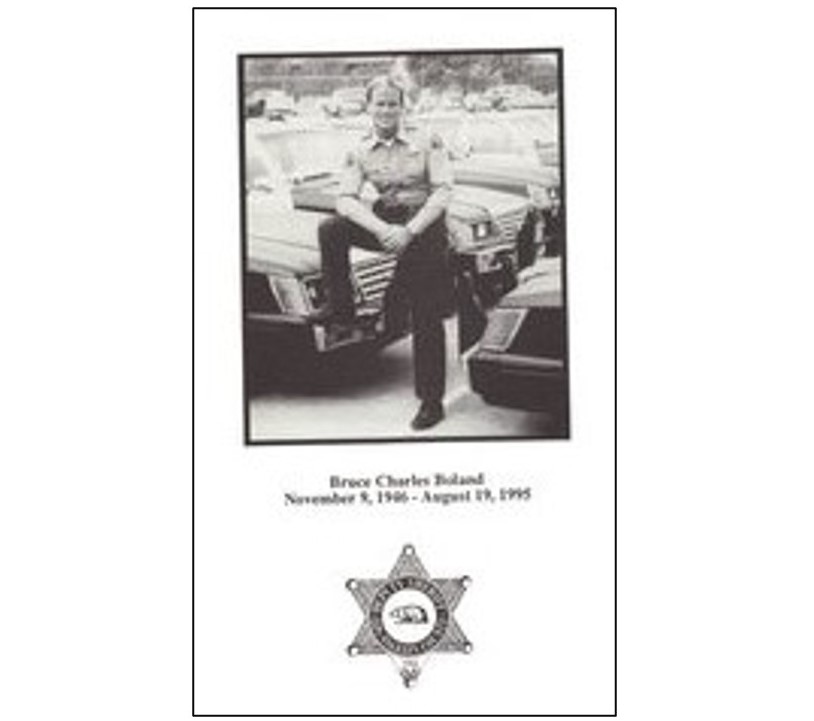
Bruce Boland, a Los Angeles County sheriff’s deputy who was the first gay officer to sue that agency for anti-gay discrimination, dies of AIDS-related illness at the age of 48.
Learn More.A native of Chicago who was educated at St. Thomas Aquinas College in Grand Rapids, Mich., Boland became an LA County deputy in 1984 and was assigned to the West Hollywood station. He was fired in 1991 for allegedly falsifying a 1989 report for a drug paraphernalia possession charge. Boland was charged with felony preparation of false evidence, but a judge dismissed the criminal case in 1992.
Boland sued the LA County Sheriff’s Department for $90 million, claiming he was harassed and fired because of his sexual orientation. Boland was represented by John Duran, a civil rights attorney who also served as a Councilmember for the City of West Hollywood.
In the wake of his firing, Boland’s cause was taken up by the West Hollywood City Council, which has urged his reinstatement, and by activists in the city’s large gay community.
The controversy stems from an April 1989 incident in West Hollywood during which Boland arrested a man for possession of drug paraphernalia. At the preliminary hearing, Boland said he discovered that he had made an error in the arrest report. He told the prosecutor that he had mistakenly written that a bag of syringes was found at the feet of the suspect seated in the front of the car, when they were actually on the floor of the back seat next to a second man whom Boland did not arrest.
The bag belonged to the man who was arrested. Nevertheless, the prosecutor concluded that Boland’s error had tainted the arrest to the point that the charges had to be dropped.
The Sheriff’s Department referred the matter to the district attorney’s special investigations division, which filed two misdemeanor charges and two felony charges against Boland. The Sheriff’s Department then suspended Boland without pay.
A Los Angeles Superior Court judge dismissed the charges in June 1990, saying that Boland’s arrest report was “at best very sloppy,” but added, “I consider (this) a training problem internal (to) the law enforcement agency and not something that we send people to prison over.”
The district attorney’s office appealed the dismissal of the charges, and Boland was reinstated and assigned to the sheriff’s station in Marina del Rey, where he was told to wash and wax sheriff’s patrol boats. In April, 1991, he was fired – for incompetence, his superiors told him.
Boland said, “To this day I cannot understand why this has happened … I was not openly gay. There were rumors circulated, but I did not ‘come out.’ … I had an excellent relationship with my superiors.”
The West Hollywood Gay & Lesbian Sheriff’s Conference Committee, an independent advisory body that includes a sheriff’s representative from the West Hollywood station, examined the case and concluded that Boland was treated “substantially different than most deputies involved in similar infractions, and more harshly than other deputies involved in considerably more egregious infractions.”
The treatment of Boland prompted outcries of discrimination against gays and fueled calls for the City of West Hollywood to replace the County Sheriff’s services with a private police force. Ultimately, the Sheriff’s Department decided to reinstate Boland and bring him back to the West Hollywood station, and the deputy responded by dropping his civil suit.
At the West Hollywood City Council meeting on April 20, 1992, Boland thanked the Council for its help and support in getting him reinstated and re-assigned to his West Hollywood post.
Visitors to the West Hollywood Sheriff’s Station can see a photo of Deputy Boland which is placed in a prominent location in the lobby, accompanied by the following poem:
“God saw that he was getting tired
and a cure was not to be.
So He put His arms around him
and whispered, ‘Come with me.’
With tearful eyes we watched him suffer
and saw him fade away.
Although we loved him dearly,
we could not make him stay.
A golden heart stopped beating,
hard working hands came to rest,
God broke our hearts to prove to us
He only takes the best.”
Richard Frank, a critically acclaimed stage actor who portrayed as Jules Bennett on the ABC sit-com Anything but Love, dies of AIDS-related illness at Midway Hospital in Los Angeles. He was 42.
Learn More.In Anything but Love (1989-1992), Frank provided comic moments to the series’ love story involving characters played by Jamie Lee Curtis and Richard Lewis. Frank also gave a notable performance as Father Vogler in the 1984 movie Amadeus.
On stage, Frank originated the role of infamous lawyer and informal powerbroker Roy Cohn in Tony Kushner’s play Angels in America. The Los Angeles Times’ Myrna Oliver described Frank as “a versatile actor equally comfortable with Shakespeare and modern works.”
He earned the 1991 Los Angeles Drama Critics Circle Award for his performance as the homosexual window dresser Molina in Kiss of the Spider Woman at South Coast Repertory in Costa Mesa. He also won a Dramalogue award for his portrayal of Herman in Five Easy Pieces at Los Angeles’ Mark Taper Forum in 1985.
By 1993, Frank had been public about his affliction with AIDS. In the wake of his public disclosure, Frank was asked to guest-star on the TV show Life Goes On. In the episode “Bedfellows,” Frank played Chester, the hospital roommate of Jesse McKenna (played by Chad Lowe), while both were admitted for illnesses related to their AIDS statuses. Frank’s character lost his battle with AIDS before the episode’s end, but not before passing on wisdom to Jesse for his own dealings with his illness.
Following his landmark appearance on Life Goes On, Frank’s health began a gradual decline, but throughout 1994, he kept up his steady guest turns on series ranging from The Larry Sanders Show to Matlock.
By the beginning of 1995, in order to preserve his health, Frank made the decision to become a television director. That year, an episode of Mad About You he directed became his final work in show business.
In 2006, actor Jamie Lee Curtis told Today that Frank inspired her to participate in the AIDS Walk sponsored by AIDS Project Los Angeles (APLA). She also became a member of the advisory board for the Children Affected by AIDS Foundation and helped to raise money for children whose lives were impacted by the AIDS crisis.
“I have tried to keep Rick’s incredible life spirit alive in my daily actions and work, both in and out of show business,” Curtis said. “I write books for children to help them understand the secrets that we adults seem to know about life, feelings, and loss. I dedicated my book Where Do Balloons Go? to Rick.”
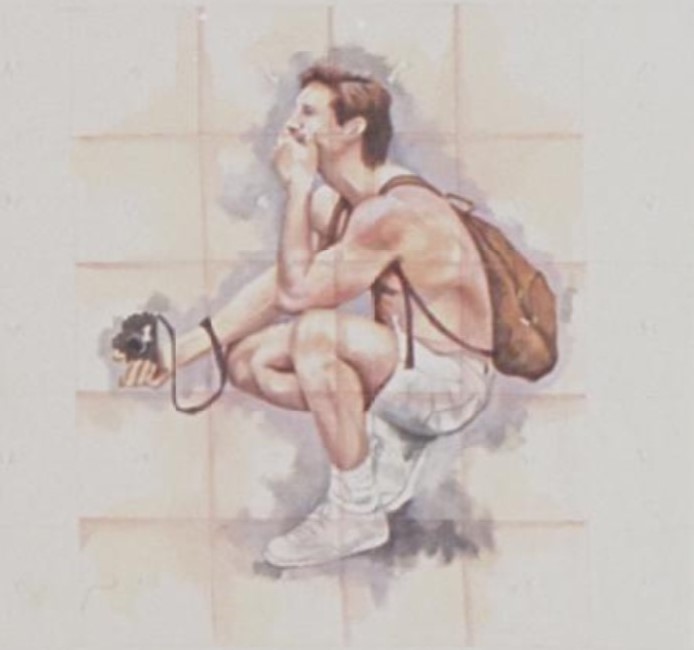
Tom McBride — an actor who appeared in two films, various commercials, soap operas, and TV movies (including a scene with Bette Davis) — dies of AIDS-related illness in New York. He was 42.
Learn More.McBride starred in the 1981 horror film Friday the 13th Part 2 as Mark, and had a role in the 1985 movie Remo Williams: The Adventure Begins. On Broadway, he appeared in the play Fifth of July in 1981-82.
McBride’s masculine good looks and muscled body made him a familiar sight in TV commercials, print ads, billboards, and films through the ’70s and ’80s. He even became that most emblematic of macho images, the Winston man.
He was also a familiar sight in the most exclusive nightclubs and parties in Hollywood and New York City. Handsome and popular, McBride found he had his choice of sexual partners, drugs, and social situations in New York’s gay scene.
In 1994-95, McBride allowed documentarian Jay Corcoran to film and interview him as his health started to decline from HIV. McBride had taken up photography, and some scenes show him opening packages of recently processed photos of nude subjects and presenting them to his mother.
After McBride’s death, Corcoran released Life & Death on the A-List, a film that featured McBride’s candid views on sex and HIV/AIDS. Corcoran’s film took an unsparing look at McBride as his good looks deteriorated and his health diminished until he was ultimately confined to a hospital bed in his mother’s home.
Peter Galvin wrote in The Advocate that Corcoran’s film portrait of McBride was one-dimensional and the film’s message was bleak.
“We never get the sense that McBride was any more than just another pretty face shilling for laundry detergent,” Galvin wrote.
And yet it is impossible to deny the emotional force of moments when McBride speaks with utter openness and authenticity to his documentarian and asks questions like “What happened to my career?”
* * * * * * * *
Photo of quilt panel from the AIDS Memorial Quilt
Kenneth Craig Innes, aka K. Craig Innes, who achieved stardom as a Broadway dancer, dance teacher and choreographer, dies of AIDS-related illness in San Francisco at the age of 35.
Learn More.Innes, a native of San Francisco, performed in more than a dozen Broadway and off-Broadway shows, including Cabaret, Carousel and Hello Dolly.
Born in San Francisco and raised in the peninsula town of Redwood City, Innes was a precocious dance student, according to his mother Shirley Gurnett. He had his first taste of theater at the age of 7 as a child extra in a touring company rendition of Carousel with John Riatt.
Innes attended Whitman College in Washington State as a theater major, and moved to Los Angeles to start his career. There, he met his partner, Jimmy Barron in 1978. Innes and Barron were together 14 years until Barron passed away from HIV/AIDS complications in 1992.
Innes performed mostly on and off Broadway in New York productions that included La Cage aux Folles, Me and My Girl, Legs Diamond and Meet Me in St. Louis, where he was also dance captain. He toured nationally with Dream Street as Charlie.
On television, he was a dancer on the TV show Fame and the made-for-TV movie The Mae West Story (1985). He was also a “Steve Merritt Dancer” and danced in several productions by choreographer Tony Stevens.
Innes’s last performance was just a few weeks before his death. Innes wrote, produced, directed and choreographed Saturation, an autobiographical music and dance show performed as an AIDS benefit at the San Francisco Jewish Community Center, according to SFGATE.
The project Dancers We Lost: Honoring Performers Lost to HIV/AIDS includes a tribute to Innes.
James “Jim” R. Thompson, a founding member of Being Alive San Diego, died of AIDS-related illness in San Diego at the age of 53.
Learn More.After testing positive to HIV in 1985, Thompson devoted the rest of his life to the battle against AIDS, according to the Bay Area Reporter. In addition to being a founding member of Being Alive San Diego, he wrote an 80-page consumer guidebook listing the resources for HIV/AIDS services.
Born in San Diego in 1942, Thompson attended the University of California Berkeley and became involved in the civil rights and anti-war movements on campus. He graduated with a bachelor’s degree in history and remained in San Francisco.
In 1984, he returned to San Diego to care for his ailing mother. When he became HIV+ a year later, Thompson left his job at Bank of America to become staff coordinator of Being Alive’s Peer Advocacy Program. Thompson was working at Being Alive in August 1995 when he suddenly collapsed and was unable to return to work.
Shortly before he died, Thompson was honored by the San Diego AIDS Coalition for his dedication and achievements in the services of people with HIV/AIDS.
The number of AIDS cases exceeds 500,000 in the U.S., with 311,381 (62%) of them representing deaths.
Learn More.In the CDC’s Morbidity and Mortality Weekly Report, the total number of persons in the U.S. reported to have AIDS climbs to 501,310.
According to the report, the rates per 100,000 population for reported AIDS cases in 1994 are:
However, during 1988-1992 and 1993-October 1995, the largest numbers of cases (65,926 and 86,462, respectively) were reported from the South, which also accounted for the largest proportionate increase of reported cases (31%).
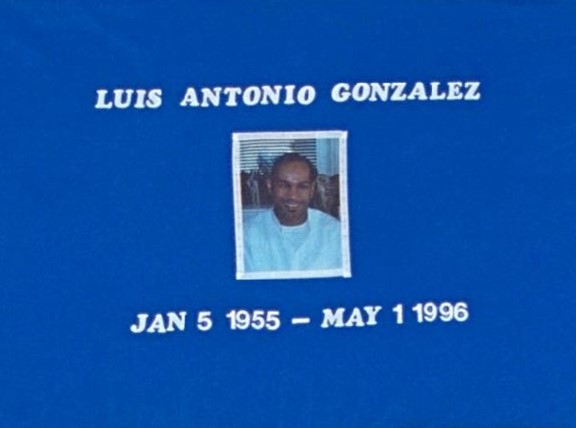
Luis Antonio Gonzalez, former dancer and manager of the San Francisco Dance Center, dies of AIDS-related illness at his home. He was 41 years old.
Learn More.Before he was 20, Gonzalez was a member of two well-known New York City dance companies — the Ailey II Company and Joyce Trisler’s Dance Company. He then performed with Kei Takei’s Moving Earth Dance Company in New York, the Honolulu City Ballet, and the Moya Ballet in Santa Barbara, California.
Gonzalez had come a long way from his humble birth in Cayey, Puerto Rico, where his mother died in childbirth and he was reared by his grandmother. And yet, in 1984, Gonzalez decided to leave his successful dance career to enter an ashram in Los Angeles. For the next 10 years, he served as a monk.
He emerged from the ashram in 1994 and moved to the Bay Area to become manager of Alonzo King’s San Francisco Dance Center. Friends told SFGATE.com that Gonzalez’s health began to decline in 1995.
In late 1995, Gonzalez’s partner, Ed Kitchen, told The San Francisco Chronicle that they had to wait for 15 days for Kaiser Permanente San Francisco Medical Center to provide Gonzalez with a bronchoscopy to confirm what they feared, Kaposi’s sarcoma.
“You have to fight for every appointment. You have to fight for every test. They’re whole goal is to get you out of there,” Kitchen told The Chronicle. “I think they hope you’ll die.”
Gonzalez is memorialized with a biography in Dancers We Lost: Honoring Performers Lost to HIV/AIDS.
* * * * * * * *
Photo of quilt panel from the AIDS Memorial Quilt

Paul Delph, former the keyboardist/vocalist for the Los Angeles-based band Zoo Drive, dies of AIDS-related illness at his parents’ home in Cincinnati at the age of 39.
Learn More.Delph was a Los Angeles-based singer, songwriter, producer, engineer, and studio musician whose catalog includes work with many well-known recording artists, including Bryan Adams, Sam Harris, The Pointer Sisters, Donna Summer, The Weather Girls, Suzi Quatro, Bernie Taupin, Toni Basil, Alice Cooper, Roberta Flack and Gary Wright.
In 1980, Delph left the Cincinnati College Conservatory of Music to jump into the LA music scene to perform with the band Zoo Drive. For the seven years that the band performed and toured, it also provided the rhythm section for many recording artists. The best known of these projects was the Word of Mouth album by Toni Basil (1982), which featured the song “Mickey” with Delph on Farfisa organ.
In 1990, Delph provided the vocals for two tracks on the re-release of the Bloodsport soundtrack, and he was nominated for a Grammy for his work.
Although Delph contracted HIV early in the epidemic, it did not impact his productive life for nearly a decade. He continued to work on his Music for AIDS projects until failing health forced a return to his family home at Cincinnati early in 1996.
In 1996, Delph released his final album, A God That Can Dance, privately to his family and friends shortly before his death. The album drew its title from a quote by Friedrich Nietzsche (“I would believe only in a God that knows how to dance”), and chronicled the Delph’s struggle with HIV/AIDS.
From 1998 to 2018, Delph’s friends teamed up to form Team Delph in Cincinnati’s annual Walk to Stop AIDS, raising tens of thousands of dollars for Caracole, the city’s largest AIDS service organization. In 1997, the Delph family established the Paul Delph Memorial Scholarship at Delph’s alma mater, Norwood High School.
* * * * * * * *
Photo of quilt panel from the AIDS Memorial Quilt
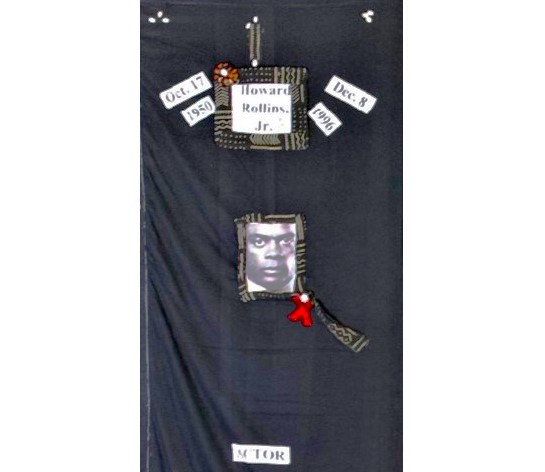
Six weeks after being diagnosed with AIDS, Oscar-nominated actor Howard Rollins dies at St. Luke’s-Roosevelt Hospital Center in New York at the age of 46, from complications from AIDS-related lymphoma.
Learn More.Rollins was an American stage, film and television actor best known for his roles as Andrew Young in 1978’s King, George Haley in the 1979 miniseries Roots: The Next Generations, Coalhouse Walker Jr. in the 1981 film Ragtime, Captain Davenport in the 1984 film A Soldier’s Story, and as Virgil Tibbs on the TV crime drama In the Heat of the Night.
Based on the award-winning 1967 movie about a white Mississippi police chief who teams with a black detective from the North, In the Heat of the Night featured Rollins as Virgil Tibbs for five seasons, opposite Carroll O’Connor as the white southern officer. The show ran from 1988 to 1994, first on NBC, then on CBS.
During the show’s run, Rollins struggled with addiction to drugs and alcohol. He was arrested four times for drug- and alcohol-related crimes and spent one month in jail for reckless driving and driving under the influence. Due to his ongoing personal and legal issues, Rollins was dismissed from the series at the end of Season 6. Rollins returned for several guest appearances in the seventh season of the show in 1993–1994.
Rollins was the youngest of four children born to Ruth and Howard Ellsworth Rollins Sr. in Baltimore, Maryland. His mother was a domestic worker, and father was a steelworker who died in 1980. After his high school graduation, Rollins studied theater at Towson University.
On October 25, 2006, a wax statue of Rollins was unveiled at the Senator Theatre in Baltimore. The statue is now at Baltimore’s Great Blacks in Wax Museum.
* * * * * * * *
Photo of quilt panel from the AIDS Memorial Quilt

Christopher Boatwright, an international star in the dance world, dies of AIDS-related illness at the Laguna Honda Hospital in San Francisco. He was 42 years old.
[photo by dancerswelost.org]
Learn More.Known for his elegant classicism, Boatwright was considered one of the finest dancers of his generation. According to New York Times dance critic Jennifer Dunning, Boatwright was one of the few Black American ballet dancers to achieve international recognition in the 1970s and 1980s.
“Across his career, Boatwright was recognized wherever he danced for his resplendent, versatile technique; the clarity, nobility, and lyricism of his dancing; and the warmth of his stage presence,” according to Dancers We Lost: Honoring Performers Lost to HIV/AIDS.
”With his long-legged, sustained line, Mr. Boatwright offers a nobility that was, on this occasion, humanized by a certain grace,” Anna Kisselgoff wrote in The New York Times in a 1979 review of his performance as Romeo in the Stuttgart production of John Cranko’s Romeo and Juliet. ”One remembers the moment in the balcony pas de deux when he arched his back deeply as an expression of feeling.”
Born and raised in Brooklyn, Boatwright trained at the schools of Merce Cunningham and American Ballet Theater and at the Alvin Ailey American Dance Center. He left the U.S. to study and perform at the Stuttgart in Germany after seeing the company’s 1973 production of Eugene Onegin at the Metropolitan Opera House in New York. While with the Stuttgart, Boatwright performed ballets traditionally off limits to Black artists in America at that time, including Swan Lake, Sleeping Beauty, and Jeu de Cartes.
“When we went to Washington, DC, the theater didn’t want me to perform the role with a white ballerina,” Boatwright said in a 1996 interview with Dance Magazine. “They said they’d only present a Black Romeo with a Black Juliet. But the company put me on anyway.”
In the mid-1980s, he returned to the U.S. and performed with the Los Angeles Ballet and Jean-Paul Comelin’s Arizona Dance Theater. Then he moved to San Francisco and danced with the Alonzo King Lines Ballet Company for a year before joining the San Francisco Ballet, where he performed works by Frederick Ashton, Paul Taylor, and the company director, Helgi Tomasson. When he injured his hip, Boatwright taught dance until he recovered, and then he rejoined Lines in 1993.
His final performance was in June 1996, when he danced with Lines in New York City.
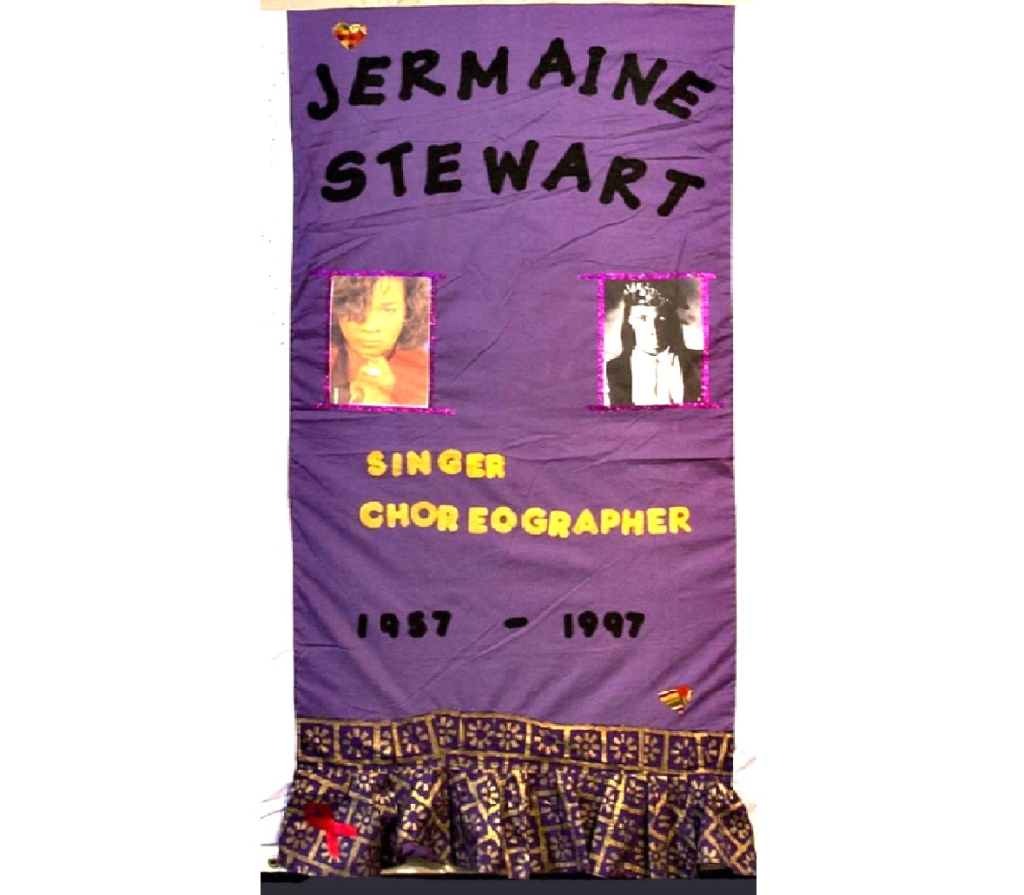
Jermaine Stewart — best known for his 1986 hit single “We Don’t Have to Take Our Clothes Off” — dies of AIDS-related illness in the Chicago suburb of Homewood at the age of 39.
Learn More.Stewart started his entertainment career as a dancer on both American Bandstand and Soul Train, the latter of which was televised from his hometown of Chicago. In the early 1980s, he and his long-time friend Jody Watley moved to London to pursue singing careers. He landed a gig as a back-up singer for the pop band Culture Club while Watley (who had left the R&B group Shalamar) began recording with multiple musicians.
After contributing vocals to Culture Club’s 1983 hit album Colour by Numbers. Stewart received help from band member Mikey Craig which led to a recording deal with Arista Records.
In 1984, Stewart released his debut album and single of the same name, The Word is Out. He released his second album, Frantic Romantic, in 1986, led by the hit single, “We Don’t Have To Take Our Clothes Off.” It went platinum quickly and was followed up by second single, “Jody,” inspired by his friend Watley (who was about to experience her own commercial breakthrough).
“Jermaine Stewart had this voice that could break you down and build you back up at the same time,” singer-songwriter Morgxn wrote in 2017 for Billboard. “He made me feel his heart, and made me feel that I was okay in being myself.”
Stewart’s follow-up singles did not rise to the success of “Clothes,” but his album Say It Again gave him a comeback in England in 1988. The album’s title track reached the R&B Top 10 in the UK. According to a tribute to Stewart on Lee Bailey’s EurWeb, this would be his last major hit before leaving the music scene in 1991.
Stewart was working on new material when he succumbed to AIDS-related liver cancer on March 17, 1997. His burial site was left unmarked for over 17 years until 2014, when a fan anonymously paid for a gravestone, according to a tribute to Stewart on Gran Varones.
“We Don’t Have To Take Our Clothes Off” saw a revival in the UK in 2011 when it was featured in a prominent commercial, causing a new generation of fans to download Stewart’s singles. The track has also been sampled for dance hits throughout the 2000s, according to the music fan site TalkAboutPopMusic.

Musician and activist Fela Kuti, a pioneer of Afrobeat music who was repeatedly arrested and beaten for writing lyrics that questioned the Nigerian government, dies of AIDS-related illness at the age of 58.
Learn More.Kuti was meant to be a doctor, an upstanding member of Nigeria’s elite like his parents, according to The Guardian. At age 20, he studied pre-med in England, where his first cousin, playwright Wole Soyinka, was already making a name for himself.
“Instead, Fela Ransome-Kuti became infamous, an outlaw musician who declared himself president of his own ‘Kalakuta Republic,’ a sprawling compound in the suburbs of Lagos that housed his recording studio and offered sanctuary to the dispossessed,” writes Neil Spencer of The Guardian.
Rebelling against oppressive regimes through his music would come with a heavy cost for Kuti. Over his lifetime, he would be arrested 200 times and endure numerous beatings from government officials.
In the 1970s and ’80s, Kuti’s subversive song lyrics established him as political dissident, resulting in Afrobeat to be associated with making political, social and cultural statements about greed and corruption. One of Kuti’s most popular songs, “Zombie,” questions Nigerian soldiers’ blind obedience to carrying out orders. Another, “V.I.P. (Vagabonds in Power),” seeks to empower the disenfranchised masses to rise up against the government.
At his club, the Shrine, his band played until dawn while dozens of singers and dancers writhed and glittered amid drifts of igbo smoke. Here, Nigeria’s corrupt dictators were denounced and ancient Yoruban deities honoured, all to a relentless backdrop of the “Afrobeat” that Fela had distilled from the musical collision of Africa and black America.
At his death from AIDS-related illiness in Lagos, Nigeria, Fela would leave behind seven children, 50-odd albums and a musical legacy that has been kept alive by his sons and former drummer, Tony Allen
Roughly 1 million people would attend his funeral procession, which began at Tafawa Balewa Square and ended at Kuti’s home, Kalakuta, in Ikeja, Nigeria, where he is laid to rest in the front yard. Belatedly, Afrobeat would become a cause célèbre among young European and American music fans.
* * * * * * * *
Photo of quilt panel from the AIDS Memorial Quilt
Douglas Hevenor, a former dancer with Joffrey Ballet, National Ballet of Washington and California Ballet of San Diego, dies of AIDS-related illness at the age of 48.
Learn More.A resident of the East Bay, Hevenor was honored the world over for his stunning technique, receiving awards at the International Ballet Competition in Varna, Bulgaria — the first American so honored — and the World Ballet Concours in Tokyo.
Hevenor was lauded for his performances in The Nutcracker (1987) and Giselle (1983) with the California Ballet. When dancing with the Washington Ballet, he was featured on Music in Motion, a half-hour documentary broadcast on Washington DC local television about Choo San Goh, the company’s resident choreographer. In the documentary, Hevenor is seen in the dances “Lament” and “Birds in Paradise.”
He also performed with the Oakland Ballet and the Leggz Dance Academy.
Hevenor is memorialized in the project Dancers We Lost: Honoring Performers Lost to HIV/AIDS.
UNAIDS estimates that 30 million adults and children worldwide have HIV, and that, each day, 16,000 people are newly infected with the virus.
The U.S. Centers for Disease Control and Prevention releases new data showing that Black people account for almost half of U.S. AIDS-related deaths.
Learn More.The CDC invited Black community leaders, including members of the Congressional Black Caucus, to a briefing to discuss the highly disproportionate impact of HIV and AIDS in Black and Hispanic communities.
In the weeks ahead, the leadership coalition would develop a call to action, requesting that President Bill Clinton and Surgeon General C. Everett Koop declare HIV/AIDS to be a “State of Emergency” in the Black community.
AIDS-related mortality for Black people was almost 10 times that of White people and three times that of Hispanic people, according to the CDC report. Only 13% of the U.S. population was Black, but they accounted for 49% of AIDS deaths. Moreover, Black Americans were experiencing less dramatic declines in AIDS deaths than whites.
“Ultimately how we succeed in affecting the course of the HIV epidemic in communities of color will be a measure of our collective ability to better target HIV prevention, research, and treatment,” says Dr. Jeffrey P. Koplan, CDC Director.
The CDC report expresses hope that partnerships with black communities are becoming stronger in recent months, when black community leaders join with the Department of Health and Human Services and the Congressional Black Caucus to create more HIV prevention programs in communities of color.
Sources:
Centers for Disease Control and Prevention, press release on August 30, 1999 about 1989 HIV/AIDS statistics.
Thomas Steel, a San Francisco lawyer who champtioned free speech, freedom of religion, LGBT rights, and the civil rights of minorities, dies at a San Francisco hospital of AIDS-related complications. He was 48 years old.
Learn More.One of the first of Steel’s cases to be followed widely was his 1978 defense of Huey P. Newton, a leader of the Black Panthers, on assault charges in Alameda County, according to The New York Times. In his cross-examination of a key witness, Steel was able to get the witness to admit that he didn’t know who was responsible for the assault. Newton was acquitted.
In perhaps Steel’s most celebrated case, he won a $920,000 settlement for a Vietnam War veteran who was nearly killed by a U.S. Navy munitions train while he sat on the tracks to nonviolently blockade a weapons shipment to El Salvador. The man, whose legs were severed in the incident, used the settlement money from the federal government to be fitted with artificial limbs.
Steel was known for taking on unpopular causes and controversial cases. He successfully sued the City of San Francisco in several police brutality cases. Even his opponents couldn’t help but admire him.
San Francisco City Attorney Louise Renne said, “He was always for the underdog. He fought very hard for his clients. He was an excellent attorney who cared very much about people and civil rights.”
Senator Barbara Boxer from California said, “He devoted much of his life to fighting for the disadvantaged, and he will be sorely missed.”
Steel grew up on a peach ranch north of Sacramento. Both his grandfather and father were County Superior Court judges. According to the San Francisco Examiner, his father would conduct mock court at the dinner table, using forks and knives to map property lines, and challenging his children to determine fair resolutions to cases.
In 1975, Steel earned his law degree from Hastings College of the Law, where he joined the National Lawyers Guild, a progressive attorneys’ group, and formed the Gay Caucus, the guild’s first LGBT committee. He later helped found the nation’s first gay and lesbian bar association, the Bay Area Lawyers for Individual Freedom.
After opening his own firm, Steel he agreed to represent the Mitchell Brothers and other adult entertainment businesses against the City of San Francisco’s efforts to curtail them, successfully arguing for the business owners’ First Amendement rights.
In 1979, Steel pushed the San Francisco district attorney to prosecute and convict a police officer for battery after he and several drunken friends invaded a local lesbian bar. He then sued the city over the incident on behalf of the injured patrons, which at the time was unusual.
In the last few years of his life, Steel continued to fight for the rights of others. In 1995, he helped the city’s Board of Supervisors craft Proposition G, which fortified the rights and purview of the Office of Citizen Complaints and its investigations of reports of police misconduct. He also brought suits over the course of 15 years under the federal Freedom of Information Act on behalf of journalists and others seeking FBI records.
In 1996, Steel won a federal appeals court ruling that the City of San Francisco’s ownership and display atop a hill of the 103-foot Mount Davidson cross violated the constitutional separation of church and state. A lower judge permitted the cross to stay, saying it was mainly historical, not religious, and it was often shrouded by fog. The appeals court reversed his decision, saying, “Constitutional guarantees should not depend on weather, especially in San Francisco.”
The Pride Law Fund has named its most prestigious fellowship award after the late civil rights icon. The Tom Steel Post-Graduate Fellowship provides a $30,000 award for a new lawyer to work in the U.S. on an innovative, public interest law project that serves the lesbian, gay, bisexual and transgender community.
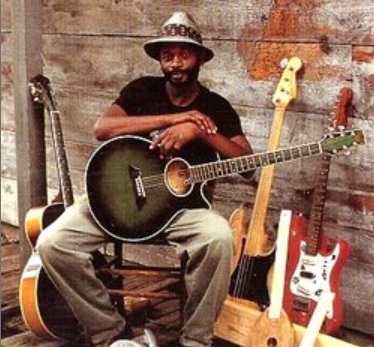
Lonnie Pitchford, a Mississippi blues musician who played guitar and the diddley bow, dies of AIDS-related illness at his Lexington home in Holmes County. He was 43.
Learn More.Pitchford was largely a self-taught musician, starting at the age of 5 with a single-stringed instrument called the diddley bow that he made himself. He progressed to other instruments, including piano and a guitar that he shared with four brothers. But he never left the diddley bow behind, and he explored ways to bring out new and complex sounds from the seemingly simple instrument.
When he was 16, Pitchford met folklorist and civil rights worker Worth Long, who taught him the importance of music and blues in Black American history. This was around the time that Long was introducing Black folklore and music to the Smithsonian American History Museum, creating a space for a history that had been long distorted and neglected.
The next year, Pitchford travelled to Washington, D.C. to play at the 1973 National Folk Festival and the Smithsonian Folk Life Festival, and he astounded audiences with his ability to play the material of the legendary bluesman Robert Johnson. And when Pitchford pulled out his diddley bow and created old-world blues sounds from one taut string and a shiny dime, audiences couldn’t believe their ears. He was 17 years old.
He sought out lessons to improve his technique, and was mentored by Eugene Powell, an old Mississippi bluesman who sometimes recorded under the name Sonny Boy Nelson. Robert Junior Lockwood, whose stepfather was Robert Johnson, also helped Pitchford learn more about replicating Johnson’s style.
For a while, Pitchford performed at major blues gatherings around the South with Lockwood and another blues legend, Johnny Shines. But then Pitchford always returned home to resume work as a carpenter. According to Richard Skelly of AllMusic, Pitchford wasn’t often booked for tours, because he didn’t have any solo recordings.
“He was able to make occasional road trips to Memphis and other cities where his music was appreciated,” writes Skelly. “He divided his time between road trips to play blues and working as a carpenter. Pitchford was voted as one of Living Blues magazine’s ‘top 40 under 40’ new blues players to watch.”
Pitchford appeared in documentaries about the blues, including ‘The Land Where the Blues Began‘ (1980), and he was recorded for five blues anthologies, according to New York Times music critic Jon Pareles. He also made an album with the New Africa String Band, which included blues greats Eugene Powell and Big Jack Johnson.
Pitchford’s wife, Minnie, said he liked to play for members of the Lexington community where he lived, often giving impromptu concerts in cafes and at the park.
In 1994, when he was almost 40 years old, he recorded his one and only solo album, All Around Man, for Rooster Blues Records. On the cover, Pitchford is pictured with various guitars (electric, acoustic, one-string).
“That CD included songs he had learned from Robert Johnson’s protégé Robert Jr. Lockwood, as well as a previously unrecorded track that Lonnie’s mother-in-law had learned from her friend, the late slide guitar master Elmore James,” Jim O’Neal wrote in 1998 in Delta Boogie.
Shortly after All Around Man was released, Grammy-winning rock musician John Mellencamp invited Pitchford to his studio in Belmont, Indiana to play the slide guitar on one of the tracks for his 14th album, Mr. Happy Go Lucky (1996).
Mellencamp later told the Associated Press of his concept for the album: “When we started making this record, I thought I’d marry the rhythm of Black music of the ’90s, which is rap, and the sounds of Black blues music of the ’30s and ’40s. We’d have Robert Johnson-type guitar licks playing with this rap rhythm underneath it. It didn’t always work out that way, but that’s the place we started from.”
In late 1997, Pitchford began working on a second album for Rooster Blues, but as his health began to decline, he was unable to continue, according to Delta Boogie writer Jim O’Neal.
O’Neal said that a few months before Pitchford died, he had the opportunity to play a slide guitar that had belonged to Elmore James (1918-1963).
Pitchford’s grave is located near the grave of Elmore James at the cemetery of the New Part Baptist Church in Homes County, Mississippi. A diddley bow is featured on the headstone, which was paid for by Southern rocker John Fogerty (whose brother Tom died of AIDS-related illness in 1990) and Rooster Blues Records.
After speaking about her HIV-positive status on Zulu-language radio and television, activist Gugu Dlamini is stoned and stabbed to death by men in her South African community.
Learn More.Dlamini, a volunteer for a local HIV/AIDS organization, disclosed her HIV-positive to raise awareness about the prevalence of the disease in her community in an attempt to curtail its spread. She lived in KwaZulu-Natal (now known as Ntuzuma B), a province just outside the city of Durham, South Africa that at the time had the highest incidence of HIV infection (30% of adult residents).
After Dlamini announced her HIV status in the media, neighbors threatened her and told her to stop disparaging their community. A week before she was murdered, Dlamini was physically attacked by a local man who ordered her to “keep quiet” about her illness.
According to a report in a local newspaper, Dlamini reported the assault to police, but they did not respond. Shortly afterward, a group of men broke into her house and beat her in front of her 12-year-old daughter. She died the next day.
News of Dlamini’s death brought worldwide attention to the level of stigma in South Africa and the world in general for people living with HIV/AIDS.
Twelve years later, Dlamini’s daughter, Mandisa Dlamini, founded the Gugu Dlamini Foundation to maintain the fight against HIV/AIDS and gender-based violence. Mandisa Dlamini also returned to KwaZulu-Natal and turned the house where her mother was murdered into an AIDS museum where “women and girls stigmatized and discriminated can find sense of belonging. “
Paddy Chew, the first Singaporean to go public with his HIV status, dies of AIDS-related illness at Singapore’s Communicable Disease Centre. He was 39 years old.
Learn More.On December 12, 1998, Chew publicly disclared his HIV-positive status during the first National AIDS Conference in Singapore.
For 13 years, Chew worked for Singapore Airlines as a flight attendant, after which he joined the Boom Boom Room, Singapore’s first drag cabaret. He said he was not aware of AIDS or HIV during the first half of his career as a flight attendant.
As a result, Chew did not start using a condom and adopting other safe sex techniques until 1986. Two years after leaving his airline job, be came ill. Inexperienced medical personnel failed to recognize Chew’s condition of oral thrush as a possible byproduct of HIV/AIDS, and he was put through a battery of standard medical tests before being administered an HIV test at his request.
After his diagnosis, Chew travelled to Brussels to begin receiving treatment unavailable in Singapore, but by 1996, he had lost 45% of his body weight and his health was failing rapidly.
He left the Boom Boom Room, and in 1998, he began performing Completely With/Out Character, an an intensely personal one-man show exploring prejudice against people with AIDS and the lack of support from the Singaporean government.
With dark humour, Chew told anyone who would listen about what it was like to shop for his own coffin and get his funeral portrait taken. He shared his regret for not taking more care of his mother, and he describes other people with AIDS who he felt were less fortunate than he was. He told the story of how he risked infection.
Chew was invited to speak at the National AIDS Conference in Singapore, and became a public figure overnight. He granted many interviews, wishing to raise awareness about the spread of HIV, and his photo was published in local and foreign publications.
When Chew was attacked in the media as a promiscuous bisexual and publicity-seeker, he responded by saying:
“Who wants to be famous for having AIDS? For goodness sake … I have seen too many AIDS patients die. Most die alone. There is no warmth, no care for them. They are not ready to die — you can see it in their eyes. I told myself I had to do something worthwhile for myself and for the cause, to clear the path for future patients, so that they will not die like that.”
The final version of Completely With/Out Character was produced by The Necessary Stage and staged at The Drama Centre in May 1999. At the end of each performance, Chew would strip to his shorts and raise his arms to better allow the audience to see his emaciated frame. This was followed by a frank question and answer session. All proceeds from the play were donated to Action for AIDS, a service organization for which he was an outspoken volunteer.
Chew planned to write a book and take a last trip to Europe, but in June 1999, his illness began to rapidly progress and he admitted himself to the Communicable Disease Centre, where he would die surrounded by family two months later.
The World Health Organization announces that HIV/AIDS has become the fourth biggest killer worldwide and the number one killer in Africa.
Learn More.WHO estimates that 33 million people are living with HIV worldwide, and that 14 million have died of AIDS.

Professional figure-skating champion and AIDS activist Robert Wagenhoffer dies of AIDS-related illness in Torrance, California at the age of 39.
Learn More.Wagenhoffer never won an Olympic medal or a world title, but he was considered one of the most entertaining skaters of his time and a brilliant technician. His performances typically included backflips, cartwheels and other unusual athletic feats.
In the 1981 U.S. Nationals, Wagenhoffer began to draw attention when he won the bronze medal. The following year, he won the silver medal and beat world champion Scott Hamilton in the short program. He became widely respected by his peers for, among other things, practicing quadruple toe loops in the 1970s, ten years before the first one was landed in competition.
“Without question, [Wagenhoffer] left an indelible footprint on the sport and left the ice better than [he] found it,” wrote Ryan Stevens, a former figure skater who created the online skating archive Skate Guard.
In 1982, Wagenhoffer turned pro to join the Ice Capades. He also skated with the Tour of World & Olympic Champions, World Cup Champions on Ice, and Gershwin on Ice. He went on to choreograph the Gershwin production and Brian Boitano’s “Skate Against Hate” network television special.
Wagenhoffer did many benefit performances for shows that raised money to combat AIDS, including “Rock on Ice” in 1993 and “Ice Fantastic” in 1998 and 1999 in Sacramento.
In January 1996, he talked about his sexuality in an interview with Monica Friedlander for Blades on Ice magazine. He spoke about the heartbreak of losing his brother to AIDS in 1992 and then his life partner of six years, Billy Lawe, in 1995.
At Wagenhoffer’s funeral, his longtime friend and former skating partner Linda Allen said:
“I know of so many people that have Robert to thank for their special moments, insights, and inspirations …. There will only be one Robert Wagenhoffer. I am so honored to have such a close friend pass through my life. He is charismatic, unique, non-conforming and completely charming. Orchestrating his programs and the programs of others, serenading us with his effortless dynamic skating. No tension, just the enjoyment of watching grace on ice. But more importantly, he is a confidant and a truly treasured friend. Robert, your charm and character will always stay with me. You’ve made your mark!”
Ofra Haza, an Israeli Yemenite Jewish singer, actress and Grammy Award-nominee recording artist, dies of AIDS-related illness at the age of 42.
Learn More.Known in the Western world as the “Israeli Madonna,” Haza was known for combining traditional and commercial music styles, fusing elements of Eastern and Western instrumentation, orchestration and dance-beat. In addition to earning many platinum and gold records, Haza was an influential cultural figure in Israel who helped to popularize Mizrahi culture.
After Haza’s death was announced, Israeli radio stations played non-stop retrospectives of her music. The decision by the Israeli newspaper Haaretz to report the cause of her death as AIDS was controversial in her homeland.
The revelation of Haza’s AIDS-related illness caused surprise among fans, and brought debate about whether the media invaded her privacy by reporting it. Many in the media speculated about how she had acquired the virus, some blaming her husband for infecting her with the disease (her husband contended that she became infected from a blood transfusion received following a miscarriage).
Haza is buried in the Artists section of Yarkon Cemetery in Petah Tikva near Tel Aviv.
Randy Krivonic, a dancer who performed with Dance Spectrum, San Francisco Opera Ballet, and Falcon Dance Theater in San Francisco, dies of AIDS-related illness at the age of 47.
Learn More.After his performing career, Krivonic became a dance writer for several local publications. He also participated in many AIDS fundraisers and contributed generously to groups struggling to bring the HIV/AIDS losses in the dance community to light.
Originally from Cleveland, Ohio, Krivonic Krivonic is memorialized in the project Dancers We Lost: Honoring Performers Lost to HIV/AIDS.
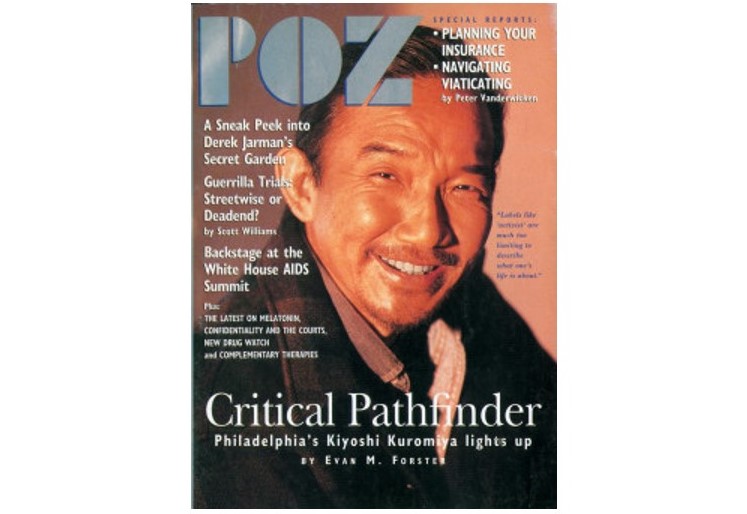
Kiyoshi Kuromiya — who dedicated his life to LGBTQ activism, AIDS healthcare expansion, civil rights, and anti-war efforts — dies of AIDS-related illness at the age of 57.
Learn More.Born in 1943 in a Japanese internment camp in Wyoming known as Heart Mountain, Kuromiya would go on to devote his life to the struggle for social justice.
During the 1960s, Kuromiya became a prominent opponent of the Vietnam War. In 1967-68, he was an assistant to the Rev. Dr. Martin Luther King, Jr., and he took care of King’s children following his assassination. He then moved to New York City, and in July 1969, following the rebellion at the Stonewall Inn, Kuromiya was among the gays and lesbians who founded the Gay Liberation Front.
“GLF tapped into the radical sentiments brewing among young, countercultural, and political gays and lesbians in New York City — and mobilized the energy and eagerness for political action that many felt in the days following Stonewall,” according to OutHistory. In the ways that the GLF organized (patterned after the the women’s movement) and conducted meetings, the organization can be seen as a direct predecessor to ACT UP.
Kuromiya was diagnosed with AIDS in 1989 and immediately researched everything he could about HIV/AIDS. He became a self-taught AIDS expert who believed that patients fared best when they understood the disease, explored treatment options, and actively participated in medical decisions.
Kuromiya became involved in all aspects of the AIDS movement, including radical direct action with ACT UP Philadelphia and the ACT UP network, People With AIDS empowerment, national and international research advocacy, and the mentorship and care for hundreds of people living with HIV.
Kuromiya was the editor of the “ACT UP Standard of Care,” the first standard of care for people living with HIV produced by PWAs. He also ran a community medicine chest to help patients get free drugs and ran a 24-hour hotline for patients needing information — even prisoners calling collect.
Kuromiya is perhaps best known as the founder of the Critical Path Project newsletter. Published by the service organization Philadelphia FIGHT and containing information gathered by Kuromiya, the newsletter was one of the earliest and most comprehensive sources of HIV treatment information. It was routinely mailed to thousands of people living with HIV all over the world, including hundreds of incarcerated individuals.
Kuromiya understood science and was involved locally, nationally and internationally in AIDS research as both a treatment activist and clinical trials participant. He fought for research that involved the community in its design – particularly people of color, drug users, and women.
In the last years of his life, Kuromiya turned his attention to the struggle to maintain freedom of speech on the Internet, participating in the successful lawsuit against the Communications Decency Act. He was also the leading plaintiff in the 1999 Supreme Court case Kuromiya vs. The United States of America, which called for the legalization of marijuana for medical uses.
Stephen Gendin, an AIDS activist and writer who founded a nationally known mail-order prescription service for people infected with HIV, died of AIDS-related illness in New York’s Roosevelt Hospital. He was 34.
Learn More.Firmly planted at the center of AIDS activism for 15 years, Gendin is credited for having promoted constructive changes in government policy that would improve the lives of HIV-positive people. His activism was pivotal in reforming the FDA drug approval process to expedite HIV and AIDS patients’ access to more effective anti-retroviral treatments.
He was involved with ACT UP (New York and Rhode Island chapters), Sex Panic!, Community Prescription Service, and the Radical Faeries. He also wrote a widely read column in POZ magazine. In this column, he shared the toll AIDS took on his body in graphic details and other personal experiences.
“Stephen was a willing guinea pig, his body a non-stop experimental laboratory for new treatment strategies. His curiosity and courage contributed to what we have all learned about anti-retroviral treatment,” wrote Sean Strub, POZ Magazine’s founder and advisory editor.
Strub said he met Gendin in 1988, shortly after Gendin graduated from Brown University. In ACT UP/New York, they worked together on the fundraising committee. In 1990, Strub hired Gendin to work for his company, and for ten years they collaborated on various projects, including fundraising for community non-profits, publishing POZ magazine and launching the Community Prescription Service.
As a co-founder and the chief executive of the Community Prescription Service, Gendin oversaw the organization’s mail-order pharmacy service that distributed medication and information for people with HIV and AIDS, according to the New York Times.
Following Gendin’s death, POZ posted this video tribute to the legendary activist.
John O. Brisbois, a former soldier who fled the Army’s HIV ward in October 1988, dies of AIDS-related illness. He was 36.
Learn More.After a blood test showed that John Brisbois was positive for HIV, officials ordered the 24-year-old Army private to be restricted to a special barracks for HIV+ soldiers in Fort Hood, Texas. The barracks became known on base as the “HIV Hotel” and “the leper colony.”
Brisbois told Newsday reporter Laurie Garrett that after being confined to the barracks for about three months and enduring daily harassment from other soldiers on base, he went Absent Without Leave.
Brisbois fled 250 miles south to ask for advice from Robert Edwards, director of the San Antonio AIDS Foundation. Edwards, known in his community as “Papa Bear,” brought in Louis Font, an attorney who specialized in military law, to help. They advised Brisbois to surrender at Lackland Air Force Base, where they heard that treatment of HIV+ soldiers was better.
“We advised the Army and the Air Force that he was in a delicate frame of mind,” Edwards told Garrett.
But two days after arriving at Lackland, Brisbois was turned over to military police who put him in handcuffs and leg irons, transported him back to Fort Hood, and put in the stockade.
“There, he was handed a bottle of delousing shampoo labeled poison in bold print,” Garrett wrote in her story, which was published in Newsday and reprinted throughout the U.S. “Brisbois walked back to the showers and drank the shampoo. The guards had Brisbois’ stomach pumped and returned him to the stockade.”
The Army discharged Brisbois in April 1988, about six months later.
Brisbois told Garrett that an Army career was all he ever wanted, but after being demoted and harassed for his HIV status, he felt forced to leave it behind.
“I feel I don’t have a future anymore,” Brisbois said. “I don’t want to die, but I get so depressed.”
On his tombstone is his Army rank of Private First Class and “Beloved Son.”
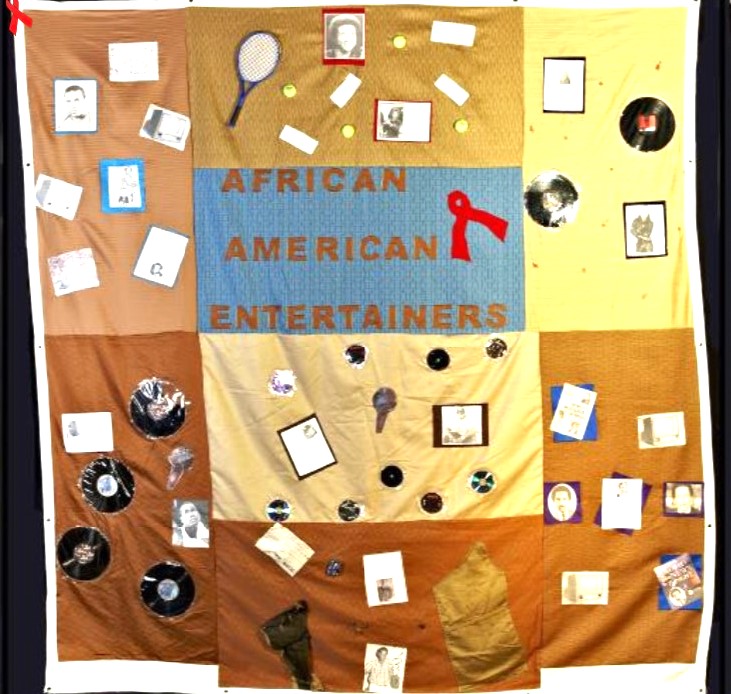
Kenny Greene of the R&B group INTRO dies of AIDS-related illness in New York City at the age of 32.
Learn More.Greene was a the lead vocalist and songwriter for INTRO, an R&B fan favorite from the 1990s. He wrote two early hits for Mary J. Blige – “Reminisce” and “Love No Limit” – which helped to make her a star. He also wrote songs for other artists, including 98 Degrees and Will Smith.
After a short stint in the U.S Army, Greene founded INTRO with friends Jeff Sanders and Clinton “Buddy” Wike, according to lifestyle writer Rah Mosley.
“Kenny managed to leave behind some great music in his short time here on earth, whether it was with his group Intro or working with other artists,” Mosley wrote.
INTRO’s self-titled debut for Atlantic Records dropped in 1993 with the lead single, “Come Inside.” The song climbed to No. 9 on the R&B charts and did well on pop charts, too, according to Edward Bowser in Soul in Stereo.
Two years later, INTRO released their sophomore album, “New Life,” but it failed to replica the success of their first one. Soon after, the group called it quits, and Greene started to make a name for himself as a producer and songwriter.
In a July 2001 interview with Sister 2 Sister magazine, Greene revealed that he was bisexual and that he was diagnosed with AIDS.
“The pressure to be a straight man in the alpha-male world of being a black man and a R&B singer was enormous,” writes music blogger tlewisisdope. “He didn’t want to allow the pressures and hate that goes on toward gay and bisexual men in the R&B world to go on in secret. It was important to him to make sure that people understood that what they see isn’t necessarily who the artist is.”
* * * * * * * *
Photo of quilt panel from the AIDS Memorial Quilt
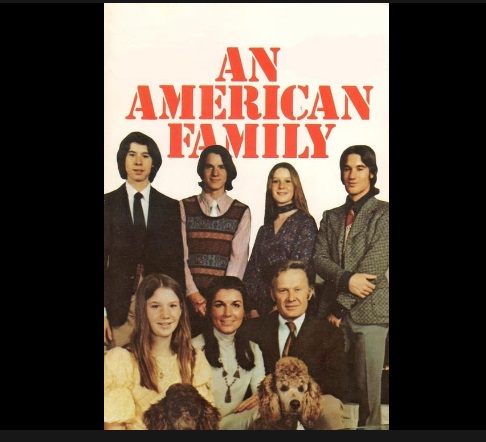
Lance Loud, the eldest son in a family made famous in the 1970s by the groundbreaking cinema vérité series An American Family, dies of hepatitis C and HIV-related illness at the Carl Bean hospice in Los Angeles at the age of 50.
Learn More.On May 30, 1971, the TV documentary An American Family began filming in Santa Barbara, where the Loud family — including then-20-year-old Lance — opened their lives to the world. Considered the first reality TV show, the ground-breaking 12-episode documentary first aired on PBS in January 1973 on Thursday nights at 9:00 p.m.
Lance Loud became a gay icon by coming out to an audience of 10 million TV viewers. His sexual orientation became a topic of national controversy, but the positive feedback from the gay community led Loud to embrace this role with passion and often self-deprecating wit.
Almost 30 years later, Loud asked Alan and Susan Raymond, the Academy Award-winning filmmakers of the original An American Family series, to film a final episode in the Loud story. He was dissatisfied with how An American Family ended, and wanted the public to see the Louds as the family he knew them to be. So the Raymonds filmed Loud and his family as he lived out his final days at the Carl Bean hospice in Los Angeles, and this would become a film, Lance Loud! A Death In An American Family.
Loud was the first reality TV star. Although he was initially vilified by the media, the American public loved him and found him to be an inspiration.
In 1973, Loud moved to New York City and performed with his high school friend Kristian Hoffman in their resurrected band, the Mumps. The Mumps flourished for five years in the New York club scene, regularly selling out clubs such as CBGB and Max’s. The band disbanded in 1980 when it became apparent that record labels weren’t interested.
After the breakup of the Mumps, Loud relocated to Los Angeles and became a magazine writer. Over the next 20 years, he wrote articles for publications including Circus, Interview, American Film, Details, and Vanity Fair. Loud also had a regular column in The Advocate, “Out Loud,” in which he wrote about his role as a gay icon.
In an article Loud wrote for The Advocate shortly before his death, he said, “Though for years I had told myself that all my unbridled drinking, drugging, and unsafe sex were going to lead exactly here, I’d never really believed it.”

Former Ratt guitarist Robbin Crosby dies at his Hollywood apartment of a heroin overdose and AIDS-related illness at the age of 41.
Learn More.Crosby was the guitarist for the glam metal band Ratt, which earned several platinum albums in the 1980s. He co-wrote many of Ratt’s hits, including “Round and Round,” “Wanted Man” and “Lay It Down.”
Crosby, who grew up in San Diego and played in various local bands, met Stephen Pearcy, whose band Mickey Ratt also played local venues. In 1981, they moved to Los Angeles and soon started playing under the band name Ratt. The LA music scene welcomed the style of rock n’ roll that Ratt performed, attacting fans of other LA-based bands like Van Halen and Quiet Riot, according to the Rock and Roll True Stories website.
After Atlantic Records signed Ratt to a major recording contract in 1984, the band released their debut album Out of the Cellar. Appearing on the front cover of the band’s first EP and LP was Crosby’s girlfriend, Tawny Kitaen. Out of the Cellar would be the biggest album of the band’s career, going triple Platinum.
As Ratt headed into the studio to record their album Detonator in 1990, Crosby left for rehab. He then joined the band on tour, but found it difficult to stay sober. He played his final gig with the band in 1991 in Osaka, Japan, according to the Rock and Roll True Stories website.
In a June 1999 interview for a Ratt episode of VH1’s Behind the Music, Crosby talked about how drug addiction and his HIV status changed his life.
“When I die, nobody cry at my funeral, in fact let’s all have a party,” he told VH1. “I’ve lived the life of ten men. I lived all my dreams and more.”
After Crosby’s death, his bandmates (who called him “King”) released various tributes on the Ratt website, calling him kind-hearted, compassionate, intelligent, and talented.
Elena Burke, considered one of the best Cuban singers of all time, dies of AIDS-related illness at the age of 74.
Learn More.Burke’s career hit its high point in the 1960s, when she introduced the world to the boleros and romantic ballads of Cuba. In 1964, she performed at the Festival of Song in Viña del Mar, Chile, and closed the Cannes Film Festival with an exuberant performance. She also performed for large audiences in Japan in 1967 and Mexico in 1969.
“She was “sentiment in full voice,” said Omara Poruondo, the female singer of the internationally acclaimed Buena Vista Social Club. “Burke virtually vibrated with the songs of César Portillo de la Luz, José Antonio Méndez, and Isolina Carrillo.”
In 1978 she performed with the Orquesta Aragón at New York’s Lincoln Center to great acclaim. Critics noted that her voice seemed to become stronger with age, and her musical style continued to develop until every song she sang came with an emotional weight, giving her the nickname “Señora Sentimiento” (“Lady Feeling”).
She made her last international tour in 1997.
UNAIDS (the Joint United Nations Programme on AIDS) reports that HIV/AIDS is now by far the leading cause of death in sub-Saharan Africa, and the fourth biggest global killer. Average life expectancy in sub-Saharan Africa falls from 62 years to 47 years as a result of AIDS.
The 14th International AIDS Conference is held in Barcelona, Spain from July 7-12. Dozens of countries report they are experiencing serious HIV/AIDS epidemics, and many more are on the brink.

Herb Ritts, one of the top photographers to emerge from the 1980s, dies in Los Angeles of AIDS-related illness at age 50.
(Photo by Richard Gere)
Learn More.A photographer whose subjects ranged from Madonna to the Dalai Lama, Ritts relied on clean, graphic compositions that often portrayed models and celebrities in the visual language of classical Greek sculpture.
”He shot exquisite, iconic photographs,” said Graydon Carter, the editor of Vanity Fair, a magazine to which Ritts contributed dozens of cover images.
Born in Los Angeles in 1952, Ritts grew up in a prosperous family and graduated in 1975 from Bard College in upstate New York with a degree in economics (he also majored in Art History). He returned to Los Angeles to work for his family’s furniture company but was sidetracked when he started taking photography classes.
In the late 1970s, while waiting for a tire to be changed, he took pictures of a young actor friend who was with him that day. The actor was Richard Gere, and the photographs were ultimately published in various national magazines and served as the catalyst for Ritts’s career as a portraitist.
”His purpose was always to make you look good,” Gere told The New York Times shortly after Ritts’ death. ”He had an extremely elegant aesthetic. Some photographers are working so hard to be elegant that they pummel you with it, but to Herb it came effortlessly.
”Some photographers embalm their subjects, but he enlivened them.”
Listen to Richard Gere tell his story about Herb Ritts.
Unlike many other contemporary commercial photographers, Ritts imposed little of his own sense of artistry onto his pictures. One of Ritts’s most memorable photographs in this vein was a Vanity Fair cover that featured fashion model Cindy Crawford pretending to shave the face of singer K.D. Lang, who was in drag.
Ritts’s work extended beyond celebrity portraiture to fashion photography, artful nudes and the direction of television commercials and music videos. He captured the 1980s era of the supermodel with Amazonian images of Crawford, Christy Turlington and Naomi Campbell.
For a year from 1996, his work was showcased in Boston at the Boston Museum of Fine Arts that was attended by around 250,000 people or more. In 2003, he was given space for a solo exhibition in Japan’s city Kyoto at the Daimaru Museum.
Ritts directed some music videos. In 1989, he directed Cherish by Madonna. Two years later, he received MTV Video Awards for making videos for Chris Isaak and Janet Jackson.
Ritts was committed to HIV/AIDS-related causes and contributed to many charitable organizations, among them amfAR, The Elizabeth Taylor AIDS Foundation , Project Angel Food, Focus on AIDS, APLA, Best Buddies, and Special Olympics. He was also a charter member on the Board of Directors for The Elton John AIDS Foundation.
In December 2002, Ritts was admitted to a Los Angeles hospital with pneumonia. According to Ritts’ publicist, “Herb was HIV-positive, but this particular pneumonia was not PCP (pneumocystis pneumonia), a common opportunistic infection of AIDS. But at the end of the day, his immune system was compromised.”
Prior to his death, Ritts communicated his desire to create a foundation that would carry on his passion for photography and his longstanding charitable support for HIV/AIDS research, advocacy, and care. In 2003, in accordance with his wishes, the Herb Ritts Foundation was established.
Ritts’ photographs continue to be displayed, enjoyed and celebrated across the world. In 2007, Ritts’ photograph, Stephanie, Cindy, Christy, Tatjana, Naomi, Hollywood, 1989, was sold at the Elton John AIDS Foundation Benefit Auction for $190,000. The sale of the photograph set a record price for a Herb Ritts limited edition Silver Gelatin photograph, and raised awareness around the Herb Ritts Foundation’s key role in raising funds for HIV/AIDS research.
In 2011, the Getty Museum acquired from the Herb Ritts Foundation a collection of 69 photographs consisting of nudes, portraits, and images made for high-fashion ad campaigns. The Getty considers this acquisition to be the most significant body of the artist’s work on the West Coast. The museum’s Ritts exhibit in 2012 drew 364,656 visitors.
In 2015, 20 years after The Museum of Fine Arts in Boston showcased the exhibit Herb Ritts: WORK, the museum presented a collection of his major works. Even more recently, Ritts’ images have been incorporated into snowboards and his artwork has been displayed in exhibitions in Berlin, Milan, Seoul, Montreal, Lisbon and London.
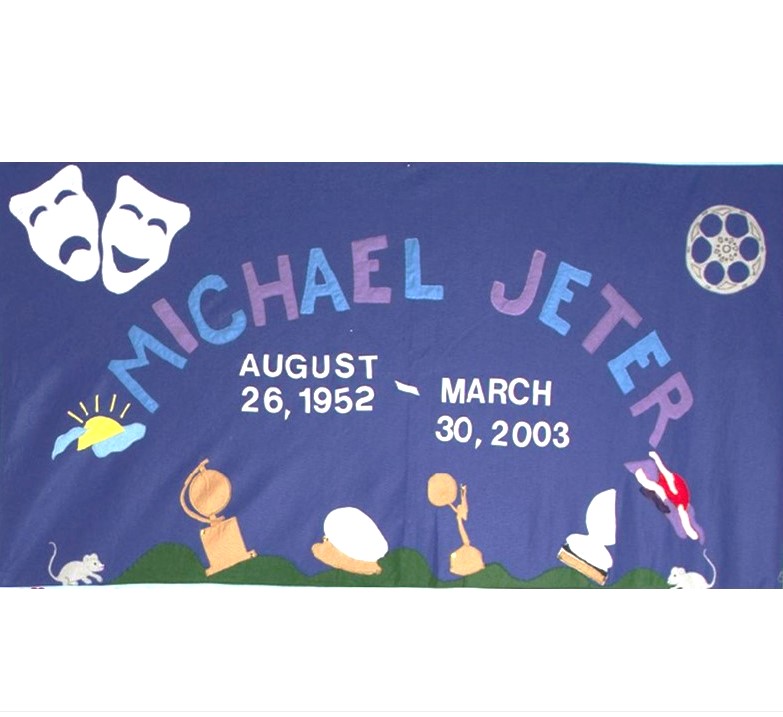
Tony award-winning charactor actor Michael Jeter dies of complications following an epileptic seizure at the age of 50.
Learn More.Michael Jeter was a character actor of film, stage, and television. Much of his work specialized in playing eccentric, pretentious, or wimpy characters, and perhaps his most famous role was that of convicted felon Eduard Delacroix in The Green Mile (1999).
Jeter fared well playing extreme characters, such as in his small but scene-stealing role as a homeless cabaret singer with AIDS in Terry Gilliam’s The Fisher King (1991). He was nominated for another Emmy for playing an eccentric frog breeder in a 1993 episode of the quirky CBS-TV drama Picket Fences — a part written specially for him.
Jeter was born in Lawrenceburg, Tennessee, and landed his first film role in Milos Forman’s Hair in 1979. He had small parts in film and television and was a frequent performer Off Broadway during the early 1980s. He appeared onstage in Alice in Concert and G.R. Point, and in 1982 was a cast replacement in Caryl Churchill’s Cloud 9 at the Lucille Lortel Theater, which was directed by Tommy Tune.
In an emotional TV interview with Jann Carl of Entertainment Tonight in July 1997, Jeter disclosed that he had tested positive for HIV. He remained active in the industry, turning in an acclaimed performance in The Green Mile and joining the cast of the sitcom Evening Shade from 1990 until 1994 and then the long-running PBS children’s series Sesame Street from 2000 until 2003.
After a turn in Jurassic Park III (2001), Jeter had a notable supporting turn as one of the loveable losers hoping for a big heist in Welcome to Colinwood (2002) and was tapped by director-star Kevin Costner to appear in the Western Open Range (2003).
In 1998, Jeter performed in a benefit reading of The Boys in the Band, bringing down the house in the role of Emory, the lonely, mischievous, heartbroken man that delights in taunting.
Around the time of that performance, Jeter told POZ magazine that he was infected with the AIDS virus in 1995, a year in which he was “so depressed” that he found himself dating a series of Hollywood parasites and stargazers.
Just before his death, Jeter had completed his work on Robert Zemeckis’ film The Polar Express, starring Tom Hanks. The filming was suspended for a day upon word of Jeter’s death.
He had been in good health for many years, according to his partner Sean Blue, who said Jeter’s death was due to complications following an epileptic seizure.
* * * * * * * *
Photo of quilt panel from the AIDS Memorial Quilt

Gene Anthony Ray, who starred as Leroy in the 1980 movie Fame and the later television series, dies of AIDS-related illness in Manhattan at the age of 41.
Learn More.Ray was cast as a character in Fame that seemed to be a natural fit. Like Leroy, Ray grew up on the streets of New York during the 1960s and 1970s. And like Leroy, Ray had never had professional dance training but he had a raw talent that choreographers found compelling.
New York’s High School of the Performing Arts was the setting for the movie and television series. Born in Harlem, Ray had actually attended the city’s performing arts school for a year before being expelled for disruptive behavior.
It was at neighborhood block parties where Ray honed his dance skills. According to the London Times, Ray later recalled, “All the blocks had parties, not just ours. And I’d go to them and scoop all the prizes.”
At his Fame audition, which he skipped school to attend, he was one of 2,800 teenagers trying out for a part. Ray’s character, who helped popularize Lycra pants and leg warmers in the early ’80s, was one of the few characters revived for the television series Fame, which ABC began airing in 1982.
Just 20 years old when the television series began to air, Ray’s personal fame was at its peak. However, the show failed to gain an audience in the U.S. and was dropped by ABC. A strong following of 11 million regular viewers in the United Kingdom essentially save the show, and and it was picked up by MGM Television for distribution abroad from 1983 to 1987.
In 1982, Ray toured Britain with other Fame cast members in a 10-concert tour of the show The Kids from Fame. The following year, a television special based on the tour was aired in the U.S.
Ray’s other film credits include Out of Sync (1995), which was directed by his Fame co-star Debbie Allen, and Eddie (1996), which starred Whoopi Goldberg.
In June 1983, the $400,000 house Ray had purchased in a white neighborhood of Rockland County, New York, was intentionally set afire. Ray, who was using the house on weekends, had planned to move into the house permanently after his younger brother finished high school in the Bronx.
The two-story home was set ablaze in four separate locations on the house’s exterior. Although the fire was thought to be racially motivated arson, no one was ever charged.
Soon after, members of Ray’s family were arrested in a drug raid. Ray missed scores of Fame rehearsals during the time family members were tried in felony court proceedings. He also (self-admittedly) was using drugs between shoots, and in 1984, he was fired from the show.
Ray spent the remainder of his life attempting to reclaim his place in the spotlight but was never successful. His use of drugs and alcohol continued unabated, and he squandered his wealth to maintain his habits.
In 1996, Ray was diagnosed HIV-positive. The high toxicity of the drugs he was then required to take made him weak, although he did appear in Dr. Pepper and Diet Coke advertisements during the late 1990s.
His mother helped care for Ray in the last years of his life. He suffered a stroke in June 2003, and died about five months later.
* * * * * * * *
Photo of quilt panel from the AIDS Memorial Quilt
Ghanaian keyboard Kiki Djan dies of AIDS-related illness and drug-related complications at the age of 47. He is found dead in a church bathroom, with the equivalent of 70 cents in his pocket.
Learn More.Djan, also known as Kiki Gyan, performed on the keyboards for the 1970s Afro-rock group Osibisa and also recorded a series of disco records as a solo artist. A prodigy who started playing the piano at the age of five, he joined the UK-based Osibisa at the age of 15. He travelled internationally with the band during the 1970s, playing to large audiences around the world.
By the age of 18, Djan had made more than a million dollars, performed for the Queen of England, and partied with Elton John and Mick Jagger, according to BBC News. He also met Marvin Gaye, Peter Tosh and Steve Wonder during the FESTAC event in Nigeria.
In 1979, he left Osibisa to pursue a solo career and recorded the popular single “24 Hours in a Disco,” which featured a 16-piece orchestra. He was briefly married to the daughter of Afrobeat pioneer Fela Kuti, but then divorced her to marry a Ghanaian woman.
In the early 1980s, Djan became addicted to narcotics and adopted a lifestyle which eventually led to a diagnosis of AIDS in the late 1990s. Djan went in and out of rehabilitation during much of the last six years of his life. Mac Tontoh, who signed him with Osibisa and kept in touch with him throughout the years, told BBC News that Djan had become homeless and begged on street corners.
“I’m sad, not because Kiki’s dead – he was suffering too much,” said Tontoh. “I’m sad because he should’ve died with dignity.”
Makgatho L. Mandela dies of AIDS-related illness at the age of 54. On the day of his son’s death, Nelson Mandela announces the cause of the death to help raise awareness about the disease and reduce the stigma associated with it.
Learn More.Nelson Mandela holds a press conference to announce that his son had died of AIDS in a Johannesburg clinic. Makgatho Mandela had been seriously ill for more than a month, but the nature of his ailment had not been made public before his death.
The elder Mandela says he was disclosing the cause of his son’s death to focus more attention on AIDS, which is still a taboo topic among many South Africans. South Africa has the largest number of people living with HIV (~6.8 million) in the world.
“That is why I have announced that my son has died of AIDS,” he says. “Let us give publicity to HIV/AIDS and not hide it, because the only way to make it appear like a normal illness like TB, like cancer, is always to come out and say somebody has died because of HIV/AIDS, and people will stop regarding it as something extraordinary.”
The World Health Organization (WHO), UNAIDS (the Joint United Nations Programme on HIV/AIDS) , the U.S. Government, and the Global Fund to Fight AIDS, Tuberculosis, and Malaria announce results of joint efforts to increase the availability of antiretroviral drugs in developing countries. An estimated 700,000 people have been reached by the end of 2004.
June 5 marks 25 years since the first AIDS cases were reported.
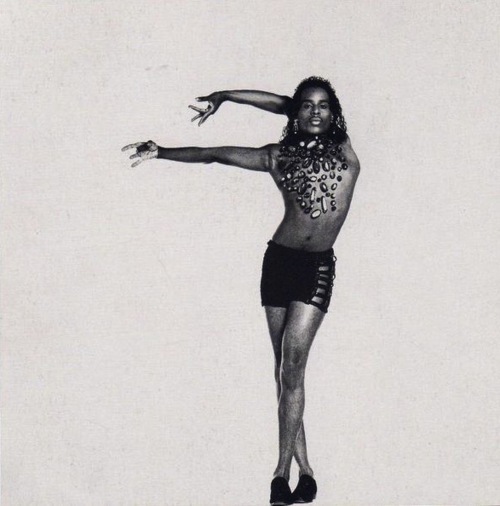
Willi Ninja, famous for his appearance in the documentary film Paris is Burning, dies at New York Hospital Medical Center of Queens of AIDS-related illness at age 45.
Learn More.Considered the Godfather of Vogue and revered for founding the House of Ninja in New York City’s ballroom scene, Ninja influenced both underground and popular culture. Ninja’s dance style emerged from the underground scene to popular culture in 1990 when superstar Madonna incorporated voguing in her hit record and video Vogue.
Ninja was a self-taught performer whose influences included Fred Astaire, Great Performances on PBS, Asian culture and Olympic gymnasts. He rose to prominence in the Harlem Drag Ball scene in the 1980s.
Ninja described himself as “a butch queen,” performing a fluid gender presentation in a scene that celebrated “woman realness,” the ability to pass as biological women. His style showcased his talents and techniques, and reflected his authentic androgynous self.
While Paris DuPree is credited with the invention of the vogue dance style, Ninja was the one who refined it and brought it to a worldwide audience.
At a ball he was judging hosted by the House of Field, Ninja met impresario Malcolm McLaren and soon found himself on McLaren’s tour of European fashion houses. Willi modeled in runway shows for Chanel, Jean Paul Gaultier, Thierry Mugler, Karl Lagerfield.
After taking voguing to Europe and Japan, be trained supermodels like Naomi Campbell and Iman in the art of voguing as well as in other artful displays of grace and poise. His skill was immortalized in the 1990 documentary film Paris Is Burning.
In its review of Paris Is Burning, the New York Times called Ninja “a lithe, articulate young man who also happens to be a master in the art of ‘voguing,’ in which dancers attempt to top each other by using gymnastics and the gestures of high-fashion models.”
Even after achieving fame, he would visit the Christopher Street pier to dazzle onlookers young and old, and teach his dance moves to the next generation of ballroom stars.
Ninja was diagnosed with HIV in 2003. Like most independent artists, he did not have health care.
Ninja outlived many of his co-stars in Paris Is Burning, including Pepper LaBeija, Dorian Corey, Angie Extravaganza, and Avis Pendavis.
Since his death, Ninja continues to inspire artists and music DJs. He is a central figure in LGBTQ studies, gender studies, and performance studies for his nonconforming and transgressive gender expression as an artist. His presence is articulated in the book Black Sexualities by Juan Battle and Sandra L. Barnes.
The House of Ninja continued to perform at drag balls to promote HIV/AIDS awareness in their mother’s name, and currently has more than 200 members worldwide.

Bob Hattoy, an activist who spoke about AIDS at the 1992 Democratic Convention, dies of AIDS-related illness at UC Davis Medical Center in Sacramento at the age of 56.
[Portrait by Greg Loudon, for an art series for the National Institutes of Health’s National Library of Medicine]
Learn More.Hattoy quit his decades-long job as regional director of the Sierra Club in Los Angeles to join Bill Clinton’s presidential campaign during the 1992 primary. Shortly thereafter, he learned that he had AIDS-related lymphoma and began chemotherapy treatments. That didn’t stop him from stumping for Clinton in front of AIDS and gay and lesbian communities all over the nation.
Political activist and author David Mixner remembered well Hattoy’s groundbreaking speech to the delegates of the 1992 Democratic Convention, made shortly after receiving his diagnosis.
“The hall was in the usual hubbub that passes for normal even when speeches are going on. But as Bob Hattoy mounted the podium, stillness fell over the entire place,” Mixner recalled. “One by one, the delegates stood up, until all 5,000 people were on their feet in respect.”
Hattoy then said the opening words of his speech: “This is difficult.”
“There was not a dry eye in the nation that night,” said Mixner. “Those of us in the hall had black armbands to honor those we knew who had died of ADIS and held onto each other as he spoke. It was as if at last we were finally being heard after a decade of horror, death and abandonment.”
Jackie McCort of the Sierra Club said of watching her former colleague at the convention: “We gathered around the TV together that night, so thrilled and touched that ‘one of our own’ was speaking so eloquently to the American people. Doggone, we were proud!”
Beginning in 1993, Hattoy worked in the Clinton administration as a deputy in the White House Office of Personnel. In the Old Executive Office Building next door to the White House was Hattoy’s office, which he shared with a colleague. On his desk was a rainbow pride flag and on the walls were photos of he and his boyfriend.
There, he spent most of his days overseeing the search and screening process for potential hires for midlevel posts in agencies like the Interior Department and Environmental Protection Agency. But Hattoy also saw his role as largely that of internal agitator, checking up almost every day on the progress of issues with more senior officials and sharing those developments with key members of his network.
“I never think of Bob as someone on the White House staff,” said activist Larry Kramer. “I think of him as our mole.”
In March 1993, when President Clinton said he was considering restrictions on the roles gays and lesbians might be allowed to take in the military, Hattoy compared that to “restricting gays and lesbians to jobs as florists and hairdressers” in civilian life. This public outburst branded Hattoy as unpredictible and potentially problematic to the Clinton administration.
In a June 1993 wine-fueled interview with The New York Times, Hattoy said, “Basically, I’m an activist first and a White House employee second. If they fire me, I’ll go to work in a lesbian bakery. But they won’t fire me. We’ve been in too many wars together.”
The next year, to decrease his visibility, the administration appointed him to the position of White House liaison on environmental matters at the Interior Department, where he remained until 1999. He also served as chairman of the research committee of the Presidential Commission on HIV/AIDS.
“Having been a lobbyist and activist for 20 years, I’d be perfect on the Hill or with community groups or other political coalitions they need to maintain relationships with and keep going — I mean with the progressive community,” Hattoy told POZ magazine in April 1994. “I originally wanted to do that. That didn’t happen, I think, because — well, I know why.”
“For 25 years, I’ve been an outspoken activist, outspoken about what I’ve believed in and cared about. And for a while that fit perfectly into helping to identify who Bill Clinton was as a human being, to show that he meant it when he talked about how there’s no such thing as Them and Us in America,” he explained. “When I continued to speak out after the election, it became off-message, I think a lot of people in the White House didn’t know what to do with me.”
A few years after the White House job ended, California Governor Gray Davis appointed him to the California Fish & Game Commisison, which Hattoy promptly joked he would work to rename the “Swish and Fish Commission.” The post was unpaid and required hundreds of hours of work, with more than a dozen public hearings each year, site inspections, lobbying and other responsibilities.
In the months before his death, he worked on the California Marine Protection Act, creating huge expanses of sea that are like protected state parkland, only underwater. For environmentalists and preservationists, the legislation was an historic victory, for which Hattoy deserved much of the credit. Soon after, he was elected Chairman of the commission.
Throughout the years, Hattoy battled recurrent pneumonia and other complications several times and suffered a bone marrow infection a few weeks before his death, but was generally healthy and extremely productive throughout his years with AIDS.
Following Hattoy’s death, former President Bill Clinton and former Secretary of State Hillary Clinton released a joint statement:
“We have lost a pioneer, a leader, and a friend. Bob Hattoy devoted his life to the fight for civil rights and social justice for the gay community and people living with AIDS. We will always be grateful for his courageous and moving speech at the 1992 Democratic National Convention and afterward, for his years of dedicated service in the administration. He gave hope to a community that feared their voice would never be heard at the highest levels of government.”
Ferd Eggan, longtime HIV/AIDS activist and leader of Los Angeles city services, dies at his home in Hollywood at age 60 after a six-month illness complicated by HIV.
Learn More.While serving as AIDS Coordinator for the City of Los Angeles between 1993 and 2001, Ferd opened doors for the funding of self-organized programs for women with AIDS, city authorization of and funding for needle exchanges, housing for People With AIDS who might still be active drug users, and a landmark study and intervention program for gay men using crystal meth.
Eggan’s activism began during his college days at the University of Chicago in the 1960s, initially in the southern Black civil rights movement and later in anti-war, anti-capitalist, anti-racist, women’s and gay liberation and HIV/AIDS struggles.
“Picture me and a Black GI on leave from Vietnam, in his car in the moonlight, windows steamy, ducking as headlights swept past,” Eggan wrote in his autobiographical essay, Fags and Dykes Want Everything: Dreaming with the Gay Liberation Front. “We could be beaten or killed for what we were doing.”
In the years that followed, Eggan traveled between New York City (where he was around the corner from Christopher Street on the first night of the Stonewall riots, but was “too afraid to join in”) and San Francisco. In 1972, while appearing as an extra in a San Francisco Opera production of Aida, Eggan and two others unfurled a banner from the stage reading, “Dykes and Fags Support the Vietnamese Peace Plan.”
Eggan returned to the Chicago area with his then-partner, documentary filmmaker Carel Rowe, where he soon joined the Chicago chapter of the Gay Liberation Front. He worked for a while with a childcare co-op run by women connected with the “Jane” group, which helped women get underground abortions, and he taught Puerto Rican high school students for 11 years.
Diagnosed with HIV in 1986, Eggan helped to found ACT UP Chicago and the national ACT UP PISD Caucus (People with Immune System Disorders), before moving to Los Angeles in 1990 to become Executive Director of Being Alive.
In 1993, Eggan became the city’s third AIDS coordinator, a position created in 1989 by then-Mayor Tom Bradley to spearhead the development of a comprehensive local approach to combating the spread of AIDS. He served in this position until 2001, when he became too ill to continue in the job.
After retiring on disability, he concentrated on his creative writing, journalism, video art, and his blog, “Communiques from a Cranky PWA.” In June 2007, less than three weeks before his death, the Los Angeles City Council honored Eggan for his service.
“We would not be where we are today if it had not been for people like Ferd,” said Dr. Michael Gottlieb, who in 1981 authored the first medical case report that heralded the advent of AIDS. “Part of the founding generation of AIDS activists, he has been involved with AIDS for the life of the epidemic. Even if there were activist leaders waiting in the wings — and regrettably there aren’t — Ferd Eggan would be irreplaceable.”
His long-term friend Walt Senterfit, national board chair of the Community HIV/AIDS Mobilization Project, said, “He was a warrior, strategist, writer, artist, activist, and friend in the political, social, and intellectual movements for liberation of our time.”
CDC reports over 565,000 people have died of AIDS in the U.S. since 1981.
Christine Maggiore, an HIV-positive activist who promoted AIDS denialism, dies of AIDS-related illness in her home in Van Nuys, California at the age of 52.
Learn More.At the time of her death, Maggiore was being treated for what was originally reported as pneumonia. The Los Angeles County coroner’s office stated that Maggiore had been treated for pneumonia in the six months prior to her death as well.
A doctor familiar with the family told the Los Angeles Times that anti-HIV drugs could have prevented her death, but Maggiore’s fellow AIDS denialists argued that her pneumonia was not AIDS-related and suggested instead that she died as a result of a toxic alternative medicine “holistic cleanse,” stress, or the cold and flu.
When Maggiore was diagnosed with HIV in 1992, she initially became the ultimate HIV/AIDS advocate — volunteering at HIV/AIDS service organizations and speaking about the risks of HIV at local schools and health fairs.
But then her views took a 180-degree turn after speaking with University of California Berkeley biology professor Peter Duesberg, who erroneously believed that HIV did not cause AIDS. She embraced Duesberg’s theories (which have been debunked), and in 2000, wrote a book called What if Everything You Thought You Knew About AIDS Was Wrong?
Maggoire gave birth at home to two children, and her youngest, Eliza Jane, died in 2005 from what the coroner ruled was AIDS-related pneumonia. Maggiore and her husband Robin Scovill, however, hired a pathologist who concluded that the girl died of an allergic reaction to the antibiotic amoxicillin.
Maggiore told ABC News that she refused to take antiviral drugs during her pregnancies despite substantial evidence that they dramatically reduced the risk of the mother transferring the virus to her child, explaining, “I did not want to expose my growing child to toxins during pregnancy.”
Jay Gordon, a Santa Monica paediatrician who treated Eliza Jane, told The Guardian he regretted not testing for HIV when he examined her for an apparent ear infection 11 days before her death.
After Eliza Jane’s death, Los Angeles police investigated whether Maggiore and Scovill were negligent in not testing their child for HIV. In 2006, the Los Angeles County district attorney’s office declined to file criminal charges against Maggiore, explaining that it was too difficult to prove criminal negligence.
Maggiore’s death certificate states that the cause of death was disseminated herpes virus infection and bilateral pneumonia, with oral candidiasis as a contributing cause, all of which can be related to HIV infection. The death certificate also states there was no autopsy performed.
Washington, DC has a higher rate of HIV (3% prevalence) than West Africa– enough to be a “severe and generalized epidemic.”
Learn More.According to a report issued by the District of Columbia, the HIV rate in the nation’s capital is the highest in the country with nearly 3% of residents living with HIV or AIDS.
“That’s a little more than 15,000 people with the disease — a total that well exceeds the 1% threshold for what makes up a ‘generalized and severe epidemic,'” stated news coverage from NBC‘s Washington station.
The study found that every form of transmission is on the rise, with minorities and women at an especially high risk. The rate among heterosexual black women was 15 times more than the rate of white women and more than three times that of Latinas.
Patricia Nalls, Founder and Executive Director of The Women’s Collective, told NPR, “Women and girls are at risk for several reasons. Prevention messages are not addressing women’s needs. And you are not seeing women in the face of the campaigns and the messages that’s out there.”
Nalls said that violence against women also needs to be considered when addressing HIV infection among the female population. She urged the local government to declare a state of emergency.
UNAIDS reports that there has been a significant decline (-17%) in new HIV infections in the past decade. East Asia, however, has seen a dramatic 25% increase.
A new United Nations report shows significant progress in improving access to HIV/AIDS services in 37 developing countries and offers realistic hope for the achievement of universal access.
Learn More.The report from the World Health Organization (WHO), UNAIDS, and UNICEF also shows an estimated 5.25 million people were receiving antiretroviral therapy in 2009 and an estimated 1.2 million people were able to start antiretroviral therapy – the largest annual increase yet recorded.
The assessment of HIV/AIDS programs in 144 low- and middle-income countries found that 15 countries were able to provide more than 80% of HIV-positive pregnant women with the services and medicines needed to prevent mother-to-child transmission, while 14 countries provided HIV treatment to more than 80% of their HIV-positive children. An additional eight countries had achieved universal access to antiretroviral treatment for adults.
“Countries in all parts of the world are demonstrating that universal access is achievable,” said Dr. Hiroki Nakatani, WHO Assistant Director-General for HIV/AIDS, Tuberculosis, Malaria and Neglected Tropical Diseases. “But globally, it remains an unfulfilled commitment. And we must join forces to make it a worldwide reality in the coming years.”
Remarkable progress in Eastern and Southern Africa, the region most severely affected by HIV, offers hope. In this region, HIV treatment coverage has increased from 32% to 41% in one year. And half of the pregnant women were able to access HIV testing and counseling in 2009.
“We’re on the right track,” said Paul De Lay, Deputy Executive Director with UNAIDS. “We’ve shown what works and now we need to do more of it. But we’re $10 billion short. At the Global Fund replenishment conference in New York next week, countries have a chance to put this right – to make a smart investment and secure the future of the AIDS response.”
Gil Scott-Heron, the poet behind “The Revolution Will Not Be Televised,” dies of HIV-related illness in New York City at the age of 62.
Learn More.Scott-Heron called himself a “bluesologist,” and was known worldwide as as a spoken-word performer whose work exemplified the strife of Black life in the 1970s and 1980s. He typically performed his work in a rapping style that came years before hip hop emerged on the music scene, causing many early rap artists to cite Scott-Heron as a key influence on the genre.
“You can go into Ginsberg and the Beat poets and Dylan, but Gil Scott-Heron is the manifestation of the modern word,” Chuck D of Public Enemy told The New Yorker in 2010. “He and the Last Poets set the stage for everyone else.”
Scott-Heron was not a member of The Last Poets, but was inspired by them. When Scott-Heron saw them perform at Lincoln University, he sought out member Abiodun Oyewole to respectfully ask him if he could start a group like theirs.
Scott-Heron’s vocal style was distinctive and included the technique of stretching a single syllable of text over several different pitches. In 1970, he delivered his most famous poem, “The Revolution Will Not Be Televised,” over a jazz-soul beat.
In 1980, Scott-Heron joined music icon Stevie Wonder on his “Hotter Than July” tour to advocate for the proposal of the U.S. Congressional Black Caucus to adopt Martin Luther King Jr. Day as a federal holiday.
In 2001, Scott-Heron was arrested for possession of cocaine and was sentenced to jail.
“For many years, he had preached against the evil of drugs, but he became an abuser himself,” said his longtime friend and music producer Abdul Malik Al Nasir. “When he got into trouble, it reminded me how much he’d helped me. So I flew to New York and visited him in jail – he’d been pumping iron, eating three square meals a day, which he rarely got when we were on the road, and looked more relaxed and fit than I’d seen him in years.”
In spite of experiencing more legal trouble over his drug use, Scott-Heron continued to be revered for his lyrical style and ability to put personal power behind his words.
In 2010, he released his final album, I’m New Here, which led several critics to call him the “godfather of rap,” according to The New York Times.
In his memoir The Last Holiday, which was published posthumously, Scott-Heron wrote:
“I hope this book will remind you that you can succeed, that help can arrive from unexpected quarters at times that are crucial. I believe in ‘the Spirits.’ …I am not and do not have a personal church to promote. I believe, however, to paraphrase Duke Ellington, that at almost every corner of my life there has been someone or something there to show me the way.”
Paris Dupree, the Grand Dame of the Harlem Ballroom scene, dies of unreported causes at the age of 61.
Learn More.Dupree was the last surviving member of the Big Five founding house mothers, which included Dupree, Angie Xtravaganza, Dorian Corey, Avis Pendavis and Pepper LaBeijia. She was also one of the stars of the legendary documentary, Paris Is Burning.
As mother of the House of Dupree, she was an iconic figure who mobilized young, urban gays to express themselves in ways that were beyond the grasp of mainstream America in the 1980s. In 1981, the House of Dupree hosted its first ball, establishing set categories which have been continued for generations. Dupree originated of many well-known categories that are still used today, and she is credited with inventing the style of dance known as voguing.
Her 1986 ball, titled — yes — Paris is Burning, was the main event featured in the 1990 documentary of the same name. Dupree is not interviewed in the film, but she is seen emceeing categories, commentating on performances, and walking the runway. Her most famous moment in the film is when she removes a hairpiece to illustrate the next category, Butch Queen.
“That’s right! I said it! Butch Queen!” she says. “Boy in the day, girl at night!”
When the film was released in 1990 with the same name as Dupree’s 1986 ball, Dupree filed a lawsuit against filmmaker Jennie Livingston and the film’s distributor, Miramax, seeking $40 million for unauthorized and fraudulent use of her services. She reportedly received a settlement amount of $5,000.
When Dupree dies, social media posts announce her passing, although the exact date and cause of her death is unclear.
“The ballroom runway ‘Grand Prize Competition’ in heaven got a bit thicker with the passing of Mother Paris Dupree,” performer Karl Xtravaganza posted. “Her death signals the end of an era.”

Robert Frascino, M.D., one of the first physicians to specialize in HIV in the early 1980s, dies of AIDS-related illness at a hospital in Mountain View, California. He was 59.
Learn More.A longtime HIV/AIDS advocate known as “Dr. Bob,” Frascino tested positive for HIV due to an occupational exposure. In January 1991, Dr. Frascino was performing a medical procedure on a patient with advanced stage AIDS when he sustained a needle stick injury.
“I subsequently seroconverted a number of weeks thereafter, in spite of the fact that I did take AZT [zidovudine, Retrovir] as a type of early PEP [post-exposure prophylaxis],” Dr. Frascino wrote in POZ magazine in 2005. “We didn’t know a lot about PEP back then.”
In 1996, when his health began to fail, he gave up his medical practice and turned his efforts to HIV education and fundraising.
As a physician expert at The Body, an HIV/AIDS website, Dr. Frascino touched the lives of millions of people through his columns, forums and blog, according to the New York Times. From the year 2000 until his death, he answered the questions of nearly 30,000 readers of The Body.
“Any other person would have burnt out years ago, but Bob was going just as strong last week as the day he started,” said Ken Stockwell, web producer of The Body. “No matter how inane or serious the question, Bob always found a way to bring humor to every response. He never sugar-coated anything, never shied away from his political inclinations and never met a pun he didn’t like. His singular wit made his forums a must read for HIV-positive and HIV-negative people alike.”
Born in Rochester, New York, Frascino trained as an immunologist at the University of California, San Francisco, and was associate clinical professor of medicine in the division of immunology at Stanford University Medical Center. He was also founder and president of the Robert J. Frascino AIDS Foundation, which raised funds and awarded grants to HIV/AIDS healthcare providers and education programs.
* * * * * * * *
Photo of quilt panel from the AIDS Memorial Quilt

Treatment Action Group founder Spencer Cox died in New York of AIDS-related illness at the age of 44 after he stopped taking his HIV medications.
Learn More.As an activist during the height of the AIDS Crisis in New York, Cox helped facilitate the production of protease inhibitors, which revolutionized AIDS care in the 1990s.
In 1992, Cox joined with other ACT UP members to form the Treatment Action Group, which worked to further treatment advances in HIV. Along with other TAG colleagues, Cox schooled himself in the science of AIDS, the workings of drug trials and the government approval process.
While still in his 20s, he represented people with AIDS in high-level meetings with the Federal Drug Administration to hasten the approval time for new HIV medications, including the new drug class of protease inhibitors.
In addition, Cox designed a clinical trial to examine the effectiveness of ritonavir, which was initially controversial because no one wanted to receive a placebo. Cox’s design, however, allowed for both speedy data gathering and a relatively accelerated approval process so that those receiving a placebo could quickly be upgraded to the medication. The quick study and approval of ritonavir, along with the rival drug indinavir, had a dramatic effect on HIV treatment.
Cox continued to be an HIV/AIDS advocate into the 2000s. Concerned with issues faced by gay men, including loneliness, depression and substance abuse, he founded the Medius Institute for Gay Men’s Health in 2006. However, Cox was forced to abandon the project when funding was not made available, and he returned to his home town of Atlanta.
In 2012, Cox returned to New York and, shortly thereafter, was featured in the documentary film How to Survive a Plague.
“One of the visceral things the film brought back for me is the rage that is still almost as fresh as the days when I first discovered it,” he wrote in a blog post for POZ magazine.
“Footage of virulently homophobic North Carolina Senator Jesse Helms reminds me even today of how much I hate (present tense) this man,” he wrote. “His colleagues, including New York’s John Cardinal O’Connor, Mayor Ed Koch, the Reverend Jerry Falwell, Patrick Buchanan, even the low-level Reagan press staffer who, in a transcript of an early White House daily briefing, is asked about AIDS, and reduces it to a smutty joke worthy of a quick chuckle. Karma be damned — I hate these men, and probably will until the day I die.”
A few months after his blog post, Cox was found severly ill in his apartment by his roommate, Mark Leydorf, upon his return home after a couple days away. Leydorf called an ambulance, which took them to the Allen Hospital, a branch of NewYork-Presbyterian Hospital, on 220th Street and Broadway. There, doctors found that Cox’s T-cells were virtually gone and that his viral load was through the roof.
Less than a week later, Cox died at the hospital. Afterward, on The Huffington Post and other Web sites, a furious debate ensued about just what Cox’s death represented.
“Was it ‘pill fatigue,’ a term applied to patients who grow exhausted taking a variety of medications daily and then become noncompliant? Why would Mr. Cox devote his life to obtaining lifesaving medications for people all over the world, only to stop taking them himself?” wrote Jacob Bernstein in The New York Times. “Was Mr. Cox trying to kill himself after several years in which the side effects had been nearly as bad as the disease? Or could crystal meth have been to blame?”
Mark Harrington, the executive director of TAG, said Cox had been struggling with an addiction to methamphetamines and had stopped taking his HIV medication some months ago.
“He saved the lives of millions, but he couldn’t save his own,” Harrington said.
However, David France, director of How to Survive a Plague, said, “There was some temptation to conclude Spencer was doing drugs at the end of his life, but there’s no evidence of that that we know of.”
According to Walt Odets, a clinical psychologist in Berkeley who knew Cox and has written extensively about the aftereffects of HIV on long-term survivors, the epidemic did not end for the veterans of Act Up when therapeutic drugs came along.
“It was an extraordinary trauma comparable to a wartime experience,” Dr. Odets said. “For many gay men, after the epidemic was over, there was a loss of energy and vitality. It’s like going from a car that runs on rocket fuel to one that runs on gasoline. And it had to be bewildering for Spencer.”
The year after Cox’s death, St. Luke’s-Roosevelt Hospital Center (now Mount Sinai Morningside) memorialized the activist by renaming their long-time HIV clinic the Spencer Cox Center for Health.
At the end of 2012, UNAIDS estimates that, worldwide, 2.3 million people were newly infected with HIV during the year, and 1.6 million people died of AIDS. Approximately 35.3 million people around the world are now living with HIV, including more than 1.2 million Americans
At the end of 2012, UNAIDS estimates that, worldwide, 2.3 million people were newly infected with HIV during the year, and 1.6 million people died of AIDS. Approximately 35.3 million people around the world are now living with HIV, including more than 1.2 million Americans.
Best known for his appearances on MTV’s The Real World: San Francisco with his partner and fellow AIDS activist Pedro Zamora, Sean Sasser dies at his home in Washington. He was 44.
Learn More.Sasser was a pastry chef who became an AIDS activist after appearing on The Real World. Although not one of the original cast members himself, Sasser’s relationship with Zamora was one of the focal points of the reality TV show.
The episode that featured Sasser and Zamora’s commitment ceremony was the first to present such ceremony for a same sex couple on television, and was considered a landmark event. Sasser, who had been HIV-positive for 25 years, was also diagnosed with mesothelioma, a rare cancer of the lungs, just one month before his death, according to CNN News.
The couple began dating during the taping of the series. Their relationship and Zamora’s battle with AIDS while living in “The Real World” house with seven strangers became must-see-TV for teens and young adults, many of whom had never been exposed to a gay couple, much less someone living with HIV.
Zamora, who had been diagnosed with AIDS at age 17, was a well-known AIDS activist. Sasser, who was also working as an activist and educator, also revealed on the show that he was HIV positive.
During the taping of the series, Zamora’s health took a turn. Zamora died on Nov. 11, 1994, with Sasser at his side just hours after the airing of the final episode of the season.
UNAIDS announces that new HIV infections have dropped more than 50% in 25 low- and middle-income countries, and the number of people getting antiretroviral treatment has increased 63% in the past two years.
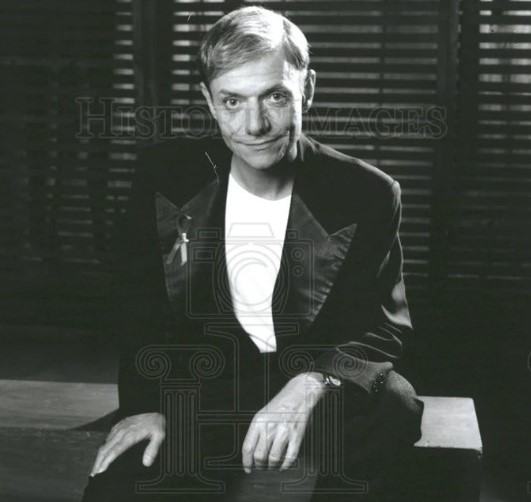
Comedian Steve Moore, best known for his 1997 HBO comedy special Drop Dead Gorgeous (A Tragi-Comedy): The Power of HIV-Positive Thinking, dies of AIDS-related illness two weeks shy of his 60th birthday.
Learn More.Moore starred in the HBO special Drop Dead Gorgeous about living with HIV. Part of his act included imitating his mother, Wilma, whose malapropisms included saying that when she was cold, she wrapped herself in a couple of “Africans.”
“I’ve been there, Mother,” he quipped.
Although gay, Moore was in a lavender marriage to Canadian comedian Lois Bromfield from 1980 to 1995. In the 1990s, Moore frequently performed as the warm-up comedian for tapings of the TV sit-com Roseanne, on which Bromfield was a writer.
“That mouth got him hired and fired five times by Roseanne Barr from the set of Roseanne,” wrote Rich Griset in his Style Weekly tribute to Moore.
But it also endeared him to Ellen DeGeneres, according to local comedian and theater critic John Porter.
“Steve was losing his health benefits, because he didn’t have enough work under his SAG card, so Ellen DeGeneres would hire him when she had her sitcom,” Porter said. “It kept him employed long enough so that his benefits couldn’t be denied.”
In a Los Angeles Times review of Moore’s HBO show, Daryl H. Miller characterized Moore as “a little Joel Grey, a lot Bette Davis.”
“What makes his story so compelling is the generosity of spirit that he finds in himself and in those around him,” Miller wrote of Moore.
In the show, which was shot before an audience at the Comedy Store in West Hollywood, Moore covers his whole life, from growing up in Danville, Virginia to living the fast life in Los Angeles, and then moving back to Danville. The show concludes with a story about returning to Los Angeles to receive free HIV medication from a Beverly Hills doctor who reallocates drugs from patients who died, and then throwing himself a life-affirming 40th birthday party.
After the release of the HBO show, Moore continued to support himself with smaller-scale comedy touring, including performing at HIV/AIDS and LGBT conferences and events, and as a speaker on AIDS and HIV issues.
Moore died at his home in Danville, Virginia. The Byrd Theatre in nearby Richmond would host a public memorial service for Moore on what would have been Moore’s 60th birthday.
The Pew Charitable Trust publishes Southern States Are Now Epicenter of HIV/AIDS in the U.S.
CDC announces that only 30% of Americans with HIV had the virus under control in 2011, and approximately two-thirds of those whose virus was out of control had been diagnosed but were no longer in care.
UNAIDS releases its 2015 World AIDS Day report which finds that 15.8 million people were accessing antiretroviral treatment as of June 2015—more than doubling the number of people who were on treatment in 2010.
CDC announces that annual HIV diagnoses in the U.S. fell by 19% from 2005 to 2014. There were steep declines among heterosexuals, people who inject drugs, and African Americans (especially black women), but trends for gay/bisexual men varied by race/ethnicity.
Learn More.Diagnoses among white gay/bisexual men decreased by 18%, but they continued to rise among Latino gay/bisexual men and were up 24%. Diagnoses among black gay/bisexual men also increased (22%), but the increase has leveled off since 2010.
The U.S. Centers for Disease Control and Prevention report that only 1 in 5 sexually active high school students has been tested for HIV. An estimated 50% of young Americans who are living with HIV do not know they are infected.

Transgender trailblazer Alexis Arquette dies at Cedars-Sinai Hospital in Los Angeles of AIDS-related illness at the age of 47.
Learn More.Arquette was born into an acting family that includes siblings David, Rosanna, and Patricia, the latter who would famously memorialize her sister in a speech at the 2019 Emmy Awards.
In the earlier years of her career, Arquette primarily performed as a female impersonator, frequently under the name “Eva Destruction.” She debuted on the big screen in 1986 in an uncredited role as Alexis, the androgynous bandmate of Max Whiteman (Evan Richards) inDown and Out in Beverly Hills. Arquette would go on to star in more than 40 movies, the majority of them low-budget or independent films.
Diagnosed with HIV in 1989, Arquette chronicled her gender affirmation surgery in a 2007 documentary, Alexis Arquette: She’s My Brother, but returned to presenting as a man in 2013 as her health failed.
In her final hours, Arquette is surrounded by her famous brothers and sisters. Alexis had left specific instructions for her death: David Bowie’s “Starman” was to play as her final moments approached.
And when the final breath passed her lips, she asked that everyone cheer “the moment that [s]he transitioned to another dimension,” reports The Hollywood Reporter.
Her family would go on to found the Alexis Arquette Family Foundation, which works with the LA County / USC Medical Center to provide medical and mental health support to LGBTQ residents in the county.
Matt Redman, one of the cofounders of AIDS Project Los Angeles, dies at the age of 66. Instrumental in spurring the LA community to action during the early days of the AIDS epidemic, Redman dedicated his life to the fight against HIV.
Learn More.Redman began his HIV/AIDS advocacy work in 1982, when he helped to create the first hotline in Los Angeles to share verified medical information about the disease. In early 1983, he would found AIDS Project Los Angeles with Nancy Cole Sawaya, Max Drew, and Ervin Munro.
In the beginning, APLA had five clients, which would grow to 100 by the end of the year, and by the middle of 1984, APLA would serve 200 clients — and the numbers kept growing. Redman served on APLA’s Board of Directors and volunteered throughout the years.
Redman also served on the Board of Directors for the Federation of AIDS-Related Organizations (later renamed AIDS United). He was honored in June 2015 by the LA City Council during LGBT Heritage Month for his work to advance equality.
Redman apparently started feeling ill in mid-December and cancelled a party planned for Dec. 18, according to journalist Karen Ocamb in The Pride. After a friend begged him to see a doctor, Redman went to the emergency room at Southern California Hospital at Culver City and was immediately rushed to Urgent Care.
An upper respiratory infection had traveled to his heart and lungs, and medical personnel determined he didn’t have enough T-cells to fight the infection. He “coded” and was placed on life support while his family and former partner were notified and flew in to be with him in his last moments.
The U.S. Centers for Disease Control and Prevention (CDC) reports significant declines in HIV/AIDS death rates for black/African Americans between 1999-2015. Among those aged 18-34, HIV-related deaths drop 80%, and among those aged 35, deaths drop by 79%.
The New York Times reports that, as a group, America’s black gay and bisexual men have a higher HIV prevalence rate than any nation in the world.
Broadway composer and lyricist Michael Friedman, known for the play Bloody, Bloody Andrew Jackson, dies of AIDS-related illness at age 41.
Learn More.An Obie Award winning composer/lyricist, Friedman was most well-known as the co-creator of the critically-acclaimed musical Bloody Bloody Andrew Jackson, which premiered in New York at the Public Theater and subsequently transferred to Broadway.
Other credits include the musical The Fortress of Solitude, based on the book of the same name by Jonathan Lethem; Unknown Soldier, which premiered at the Williamstown Theatre Festival; and Love’s Labour’s Lost, which premiered at the Delacorte Theater in Central Park.
Public Theater Artistic Director Oskar Eustis in a statement said, “Michael Friedman was one of the most brilliant, multi-talented theater artists of our time. He was also a miracle of a human being: loving, kind, generous, hilarious, thrilling. His loss leaves a hole in the theater world that cannot be filled, and a hole in the hearts of those who loved him that will last forever.”
Michael Paulson of the New York Times describted Friedman as “a versatile, cerebral and witty composer and lyricist who brought a historian’s eye and a journalistic sensibility to pathbreaking work off and on Broadway.”
Michael was a founding Associate Artist of The Civilians, the acclaimed investigative theater company. His work with company includes Gone Missing, In the Footprint, The Great Immensity, Paris Commune, (co-written with Civilians’ Artistic Director Steve Cosson) (I Am) Nobody’s Lunch, and This Beautiful City as well as the score for Anne Washburn’s critically-acclaimed Mr. Burns, a Post-Electric Play.
His final collaboration with Cosson, The Abominables, opened at Children’s Theater Company in Minneapolis in September 2017.
A cornerstone of The Civilians’ investigative method was to interview people and then turn the interviews into songs.
Sarah Larson wrote in The New Yorker that Friedman had “an incredible gift” for creating theater from interviews.
“He was an almost forensic listener, re-creating the exacting speech of all kinds of people and setting it to music as if finding its true form,” Larson wrote.
Friedman’s death was a shocking reminder to many that HIV continued to be deadly — even for well-to-do, white men with good health insurance.
“Aching with gratitude for the music & joy he gave us,” Lin-Manuel Miranda, the creator of Hamilton, wrote on Twitter. “Mourning all the music we’ll never hear.”
Shortly following Friedman’s death, the New York Times published an update, stating that Friedman had tested positive for HIV just nine weeks before his death.

Atlanta performance artist, writer, and HIV educator Antron-Reshaud Olukayode dies of AIDS-related illness at age 33.
[photo from Olukayode’s blog]
Learn More.Olukayode was an accomplished poet, author, HIV/AIDS activist, blogger, self-taught multidisciplinary artist, vocalist, music producer, creative director of BOS+AROS, and Buddhist practitioner.
Born on April 26, 1984 in Gainesville, Florida as Antron Reshaud Brown (he later changed his surname to Olukayode, which is Yoruba for “God brings happiness”), he didn’t speak until the age of four, according to the National Black Justice Coalition in its tribute to Olukayode.
He showed an early interest in the arts, and his grandmother and mother encouraged his artistic expression, supplying him with craft supplies. He learned to play the piano as a child from his grandmother, and in the second grade, he won a local writing contest based on a story about going to the grocery store with his mother. When he was 15, Olukayode started working with children at his local Boys and Girls Club, leading them in arts and crafts projects.
During his teen years, Olukayode was constantly teased, bullied and physically abused due to his effeminate appearance and mannerisms. At the age of 17, he was raped and assaulted in a field near his neighborhood by two young men. Afterward, Olukayode considered suicide, but heard a voice telling him to write. He began writing in his journal to keep himself sane.
Olukayode was infected with HIV while in an abusive relationship with a basketball player at his college. When he learned of his diagnosis, he was overwhelmed with shame and dropped out of college. He worked in a series of meaningless jobs, continuing to live with his mother until he decided to leave Gainesville to seek a better life.
In 2006, Olukayode boarded a Greyhound bus to Atlanta with with four boxes of belongings and $200 in cash, A new friend, Kelvin Barlow, read some of Olukayode’s written work and introduced him to AID Atlanta’s program manager Craig Washington, who invited Olukayode to recite poetry at a Black Gay Pride event called Phyre!
Olukayode said that it was at this event that he knew he had found his calling as a poet. He also became involved with AID Atlanta, which led to his first HIV/AIDS prevention job at National AIDS Education & Services for Minorities (NAESM), under the supervision and guidance of executive director Adolph St. Arromand.
In 2007, Olukayode released his first collection of poetry, “Bohemian Rebel: Naked and Exposed Vol. 1.” A week later, he became homeless and began spending his nights couch surfing or sleeping in Piedmont Park.
Over the next three years, Olukayode wrote while experiencing homelessness, producing The Rising Vol. 2, a collection of poems and prose about his years being homeless. He also wrote his first stage play, TRANS-ition, the story of a teenager transitioning from male to female, and his first one man show, Evicted, about enduring homelessness while HIV positive.
Olukayode’s third collection of poems and prose, Fearless Revolution, Vol. 3, drew on his experience from a relationship with a soldier. In 2012, he contributed the essay “Afraid of My Own Reflection” to the anthology For Colored Boys Who Have Considered Suicide When the Rainbow is Still Not Enough: Coming of Age, Coming Out, and Coming Home. He also produced a blog and vblog, With Love ATL, for thebody.com.
In addition to poetry and prose, Olukayode wrote songs, influenced by the music of the Baptist church of his childhood. In 2013, following the traumatic end of a relationship, he produced his first EP, Oluka Oluka.
In his work as a self-proclaimed “artivist,” Olukayode participated in the Centers for Disease Control’s initiative “Let’s Stop HIV Together” campaign. He also lobbied in Washington, D.C. for AIDS Watch, urging Congress to increase funding for HIV services. As a youth representative from the State of Georgia, Olukayode met Congressman John Lewis and shared his story.
He also worked on the project DA CRIBB for the National AIDS Education & Services for Minorities and The Evolution Project for AID Atlanta. He was a member of Lifting Our Voices for Equality (L.O.V.E) Coalition and Common Ground Ministries.
Olukayode was creative director of BOS+AROS, a vehicle for change with an avant-garde approach to empower the masses about HIV/AIDS, using art to connect with people and spread awareness. He premiered his multimedia exhibition, ANTRONICA, in 2016.
Olukayode spent the last years of his life in Atlanta, where he practiced Buddhism, and enjoyed the independent and avant-garde art scene.
According to a tribute posted by friend Mark S. King, Olukayode “had developed Kaposi sarcoma, a dangerous cancer that spread from his skin to his other organs during a month-long hospital stay before his death. AIDS caused Antron’s cancer.”
A few weeks before he died, Olukayode wrote: “Having my mother here in the hospital with me is healing. She came all this way to be by my side. I am so grateful and grateful for my friends who have been nothing but supportive. Having her witness my friends lavishing the love and meeting her and is extraordinary. A blessing and fills me with joy.”
You can view Olukayode’s work on his personal blog.
The date marks the 30th anniversary of the observance of World AIDS Day.
Learn More.The World Health Organization joins its global partners to commemorate World AIDS Day under the theme “Know Your Status.” The occasion is celebrated as the 30-year anniversary of a pioneering global health campaign first initiated by WHO in 1988.
Jim Chud, who may have been among the first people in the U.S. to exhibit symptoms of HIV/AIDS, dies of sepsis, most likely after a bacterial pneumonia, at Cedars-Sinai Hospital in Los Angeles at the age of 62.
Learn More.A longtime resident of West Hollywood, Chud had served on the city’s Disabilities Advisory Board and on the Los Angeles County Commission on HIV. He was also a prolific writer, having been published by publications like Huffington Post, among others. In 2015, he was included in the “POZ 100” for his advocacy for appropriately designed housing for disabled people.
In late 1977, while a sophomore at Yale, Chud was hospitalized with symptoms that would become familiar to medical personnel in just a few years: night sweats, a rash, swollen lymph nodes, and thrush. At the time, however, Chud’s medical team was unable to come to a diagnosis. When his symptoms subsided in about two weeks, the doctor discharged him, saying, “You probably had some sort of virus.”
The official beginning of the HIV/AIDS epidemic is often cited as June 5, 1981, the day the U.S. Centers for Disease Control and Prevention issued its first warning about a rare pneumonia called pneumocystis circulating among a small group of young gay men. However, according to Science Magazine, a 2016 study indicated that in 1981, when Dr. Michael Gottlieb presented the first five cases to the CDC, there were already 250,000 people living with the virus. Chud was one of them.
By 1985, Chud was living in Washington and had already watched many of his friends get sick and die. In 1989, his own illness had advanced to full-blown AIDS.
“I thought I was going to die,” Chud told CNN in 2010. “I didn’t think I would see 30.”
He started volunteering for drug trials. One, a National Institutes of Health study, studied the combination of drugs AZT and DDC, a new drug by Roche Pharmaceuticals.
“DDC, while effective in the test-tube against HIV, was very toxic, and put all 80 of us study participants through a whole host of side effects,” recalled Chud in 2017 article he wrote for Plus. “The mouth sores were legendary. Eating required first gargling with Lidobenelox, a thick pink emulsion of lidocaine, benadryl, and Maalox. It resembled the hand soap in public restrooms, but it provided 20 minutes of pain relief.”
Chud was pulled from the drug trial when he began experiencing partial paralysis and lockjaw. While these symptoms dissipated after a few days, Chud had unknowingly sustained long-term damage to his body’s cartilage. By 2003, he was in so much pain, he sought treatment from an orthopedic surgeon, who uncovered extensive damage to Chud’s spine.
Between 2003 and 2015, Chud underwent over 80 operations on his spine, neck, and major joints. Through all this, he lost 7 inches in height because of destroyed disks, leaving less room for his lungs, bowel and stomach.
In 2009, he began using a four-wheeled walker to be able to walk. Prior to that, he had given little thought to what it was like to live with a disability, but this new experience motivated him to become an advocate for himself and other long-term HIV survivors who live with disabilities.
“My drive to do something for other disabled people shifted into hyper-drive from that moment on,” Chud wrote.
Chud was aware of his place in AIDS history and felt a responsibility to share his experience with younger generations.
“While the trajectory of AIDS has changed immensely, I think that knowing my tendency for feeling invincible until something happens to me, there is great peril that the current generation will never know how terrible the AIDS epidemic has been in gay America, let alone the world,” he wrote in the Huffington Post.
The age-adjusted rate of HIV-related deaths in the U.S. fell by nearly half from 2010 to 2017, according to a study that suggests treatment programs are extending the lives of people living with HIV.
Learn More.The study published by the Centers for Disease Control shows that deaths among persons with diagnosed HIV decreased, primarily because of decreases in HIV-related deaths.
Life expectancy for persons with HIV infection who receive recommended treatment can approach that of the general population, yet HIV remains among the 10 leading causes of death among certain populations. Using surveillance data, CDC reseachers were able to determine that progress is being made toward reducing deaths among persons with diagnosed HIV.
During 2010–2017, HIV-related death rates decreased 48.4% (from 9.1 to 4.7 per 1,000 people), whereas non–HIV-related death rates decreased 8.6% (from 9.3 to 8.5 per 1,000 people).
The report also noted that rates of HIV-related deaths during 2017 were highest by race/ethnicity among persons of multiple races (7.0) and Black/African American persons (5.6), followed by White persons (3.9) and Hispanic/Latino persons (3.9). The HIV-related death rate was highest in the South (6.0) and lowest in the Northeast (3.2).
The researchers conclude that early diagnosis, prompt treatment, and maintaining access to high-quality care and treatment have been successful in reducing HIV-related deaths and remain necessary for continuing reductions in HIV-related deaths.
Jerry Herman — whose musical La Cage aux Folles arrived on Broadway at the height of the AIDS epidemic and helped put gay life into the cultural mainstream — dies at the age of 88.
Learn More.Herman composed the scores for the hit Broadway musicals Hello, Dolly!, Mame, and La Cage aux Folles, and was nominated for the Tony Award five times (winning twice for Hello, Dolly! and La Cage aux Folles).
Born July 10, 1931, Herman grew up in Jersey City, NJ in a family that loved theater. Seeing Irving Berlin’s Annie Get Your Gun on Broadway changed his life, he told NPR in 1994.
“I walked out of that theater singing all those wonderful Berlin songs and, from that moment on, that’s all I wanted to do with my life,” he said.
In 1983, shortly after La Cage Aux Folles opened on Broadway, Herman’s companion, Marty Finkelstein, died of complications from AIDS. Herman was diagnosed as HIV-positive at a time when that seemed like a death sentence.
Herman was one of the first people to receive the complex cocktail of drugs that has kept so many HIV patients alive, and he helped raise millions of dollars for AIDS research.
Marilyn Stasio, who co-wrote Herman’s memoir Showtune, said that his HIV status spurred him to write his memoirs — and to also set some things straight.
“One thing that really got him mad was he thought people really felt he was putting it on, the optimism and the joy and the happiness and the way he loved life,” Stasio told NPR. “And he wanted to make it clear that it was true. He did. He loved every minute of life.”
Herman’s memoir, Showtune, was published in 1996. In it, he wrote about being shaken by the death of his lover, his own illness, and a feeling that despite La Cage, his music was no longer in fashion.
In 2009, Herman received the Tony Award for Lifetime Achievement in the Theatre, and a year later, he and his work was recognized at the 2010 Kennedy Center Honors.
In December 2019, he was hospitalized for pulmonary complications and died days later.
Garry Bowie, the head of the HIV nonprofit Being Alive in West Hollywood, dies of complications from COVID-19. He was 59 years old.
Learn More.Bowie dedicated his life to compassionate advocacy for those living with HIV/AIDS and for the local homeless community. In 2004, he served as a founding board member and executive director of the Long Beach AIDS Foundation, and was named 2008 “Man of the Year” by the Long Beach Lambda Democratic Club.
In 2014, Bowie was named executive director of Being Alive Los Angeles, a non-profit dedicated to fighting HIV by ending stigma and restoring dignity while increasing access to care. He served at Being Alive Los Angeles until his death.
Bowie was born on Jan. 24, 1961, in Portland, Maine. His father was a civil engineer for the military and moved the family many times, eventually settling in Huntington Beach and Fountain Valley. He graduated from Fountain Valley High School and moved to Long Beach, where he started work in video editing and music videos.
Bowie contracted HIV at the age of 22 in 1983, in the early days of the epidemic, before there was effective treatment. He and his mother drove to Mexico to buy AZT, an early antiretroviral medication reported to treat HIV, and brought doses back for others who also needed it, according to his obituary on EverLoved.
He was inspired to become an activist in 1991 after watching Magic Johnson disclose his HIV status, telling his fans that he still had a long life to live.
“What Magic Johnson did is bring it into the public dialogue and bring a sense of normalcy to living with HIV,” Bowie said in a newspaper interview. “It just gave a new face to what HIV looks like in our communities.”
On March 19, 2020, Bowie started showing flu-like symptoms, and he was transported to Kaiser Permanente Medical Center in Downey when his condition worsened, said Jeff Wacha, Bowie’s husband of 20 years, to the Long Beach Press-Telegram.
Wacha said that when Bowie, who had HIV, arrived at the hospital, tests showed his immune system to be normal.
To the end, Bowie was thinking of and fighting for the welfare of others. On March 25, he posted the following on Facebook:
“The CDC needs to fix the way we count COVID-19 cases. For instance, my staff and I all have COVID-19, a presumptive case because our doctors know us and ask the right questions. However, our status is not counted.
“If it weren’t for Facebook, nobody would know each of us added one more to our neighborhood count. All because we haven’t had testing. Here’s my problem: CA currently has 2,853 confirmed cases, but because of testing shortages, and by order of our illustrious LA Public Health Dept., hospitals were told until the patient is seriously ill and ready to be admitted, no testing.”
On the day Bowie died, Wacha posted on Facebook:
“We had one last set of ‘I love you’ before they sedated him so they could intubate and put him on a ventilator. This was about 2:00 p.m. on Saturday, March 28. I had no idea it would be the last time I spoke to my husband; my reason for living; the man who has supported me emotionally the previous 20 years and kept me alive; the man who made me laugh every day that we were together; the man who made each day together even more beautiful than the day before; the man who always knew what to do to help me see the light at the end of the tunnel when I started spiraling into the abyss; the man who surprised me with deliveries of flowers just because he ‘knew you needed it right now and to remind you how much I love you.’”
In the days following Bowie’s death, Wacha received hundreds of messages of condolences.
“He was an incredibly kind and compassionate person who fought for wellness and health in the gay community,” Long Beach Mayor Robert Garcia said. “He was a leader in the fight against HIV/AIDS and impacted many, many people in Long Beach. Our hearts go out to his family and friends.”
Outspoken activist, changemaker and author of The Normal Heart, Larry Kramer dies of pneumonia at the age of 82.
Learn More.Witnessing the spread of the disease later known as AIDS among his friends in 1980, Kramer was among the first to call his peers to action. In 1981, Kramer gathered about 80 people in his NYC apartment and formed the Gay Men’s Health Crisis — the first organization for those infected with HIV and now the world’s largest private organization assisting people living with AIDS.
Kramer grew frustrated with bureaucratic paralysis and the apathy of gay men to the AIDS crisis. This frustration was channeled into his 1985 play The Normal Heart, which debuted at The Public Theater in New York City and ran for a year.
In 1987, Kramer was the catalyst in the founding of the AIDS Coalition to Unleash Power (ACT UP), a direct action protest organization that chose government agencies and corporations as targets to publicize lack of treatment and funding for people with AIDS. ACT UP was formed at the Lesbian, Gay, Bisexual and Transgender Community Services Center in New York City. At ACT UP’s speaker series, thousands came to hear Kramer speak about taking action to fight AIDS.
“Larry’s singular combination of political vision, fiery passion, and eloquent anger were the fuel that sparked our organization – and the start of the global AIDS activist movement — in March of 1987,” reads ACT UP NY’s statement following Kramer’s death.
“Over the next thirty-plus years, Larry was our beacon, our inspiration, and sometimes our nemesis. But through good times and bad, we moved forward in our quest to end the AIDS crisis and to identify and defeat the villains in power whose crimes or apathy allowed a disease to become a worldwide plague. His uncompromising honesty moved us to greater achievements.”
In 2011 — 26 years after its yearlong run at The Public Theatre — The Normal Heart made its Broadway debut, directed by Joel Grey and starring Joe Mantello, Ellen Barkin, Lee Pace and Jim Parsons. Then Ryan Murphy optioned the rights to the play and eventually turned it into a 2014 HBO movie with an all-star cast including Matt Bomer, Julia Roberts, Mark Ruffalo, Alfred Molina and Parsons.
Kramer’s works also include The Destiny of Me (1992), a finalist for the Pulitzer Prize.
And at the time of his death at the age of 82, he was still doing what he did best: sound the alarm on pandemics with a new play about the gay community having to live through three plagues, including COVID-19.
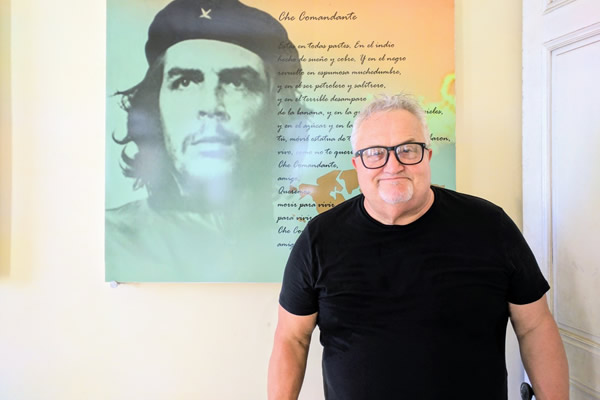
Scott Robbe, a TV-film-theater producer who created LGBTQ programs and a long-time AIDS activist who participated in ACT UP protests, dies after a year-long battle with cancer. He was 66.
Learn More.Robbe’s life was devoted to progressive activism, beginning in his teen years, when he took part in 1960s marches for the environment, for civil rights, and against the Vietnam War. Over the four decades that followed, his endeavors included both community organizing and producing dozens of works in theater, film, and television.
“Scott was a fearless activist, always on the front lines, whether he was protesting pharmaceutical company greed or homophobia at the Oscars,” ACT UP New York veteran Ann Northrop said in a statement released by Robbe’s estate. “And he was a total sweetheart.”
Robbe joined ACT UP after seeing the group protest at the White House in October 1987 during the Second National March on Washington for Lesbian and Gay Rights. He joined the group’s Media Committee and took part in numerous protests. Years later, in the early 1990s, he would become HIV positive.
According to the Facebook group ACT UP NY Alumni, Robbe helped to found two direct-action groups in New York City: ACT UP and Queer Nation NY. In September 1989, he and other ACT UP members secretly gained access to the New York Stock Exchange and were subsequently arrested. The action was a big success, bringing media attention to the exorbitant price of AZT, then the only approved treatment for HIV/AIDS, and forcing its manufacturer, Burroughs Wellcome, to lower the price by 20%.
While in New York City, Robbe produced numerous theater projects, including several with actor Harvey Fierstein. Robbe moved to the West Coast in 1990, where he worked on TV and film projects, many of which promoted LGBTQ visibility. These include the first LGBTQ comedy special for Comedy Central in 1993, called Out There, hosted by actor Lea DeLaria. Robbe was also part of the creative team behind the original Queer Eye for the Straight Guy series in 2003.
Robbe cofounded Out in Film, a Los Angeles-based group that protested representations in movies it found stereotypical and homophobic, such as Silence of the Lambs, JFK and Basic Instinct.
In 2005, Mr. Robbe was named executive director and film commissioner for Film Wisconsin Inc. During his tenure, Mr. Robbe brought 28 TV and film projects to the state, including the 2009 film Public Enemies by Michael Mann, starring Johnny Depp and Channing Tatum.
During the COVID pandemic, Robbe worked with activists in Cuba to bring pressure on the American government to distribute the COVID vaccine in the country. Robbe was also involved in grassroots activism in Puerto Vallarta, Mexico, where he had a second home.
In April 2021, Robbe underwent stem cell treatment at Dana-Farber Cancer Institute in Boston for myelodysplastic anemia, a blood cancer. Later that year, he entered hospice care at the Wisconsin home of his sister, Angela.
Bruce Monroe, former President of the Dallas Gay and Lesbian Alliance, died in Dallas of HIV-related illness. He was 65.
Learn More.During his tenure as President of the DGLA, he partnered with the Foundation for Human Understanding to create Resource Center, which remains an important resource for HIV/AIDS treatment and care.
The gay community in Dallas was hit early and hard by the AIDS crisis, and Monroe responded by organizing local resources and demanding funding for HIV/AIDS programs, according to KERA, the National Public Radio station in Dallas.
“Bruce and others in the community insisted on speaking up for our rights and making sure that people got the care that they needed, and finding a way for funding and keeping people in their homes and getting them food and getting education out to individuals,” recalled Cece Cox, CEO of Resource Center. “He was also an incredibly clever and kind person who uplifted many of us, and I will miss him a lot.”
Friend and fellow activist William Waybourn told KERA how Monroe was also an accomplished artist who used his creativity in his activism.
“When we would have demonstrations he would help do the graphics and make it appealing. That will not only entice volunteers but get the media’s attention as well as get across the message that we were trying to deliver,” said Waybourn.
At the height of the AIDS epidemic, Monroe brought national attention to Texas by taking part in chalking outlines in front of Dallas City Hall and displaying crosses on a potter’s field in a vacant lot in Oak Lawn to symbolize the number of AIDS cases in Dallas.
Monroe said in his oral history that he and others from the Dallas Gay and Lesbian Alliance formed an activist branch called the Gay Urban Truth Squad (GUTS) to organize these demonstrations and others.
He was particularly proud of the potters field demonstration, because it did such a great job of illustrating how low a priority HIV/AIDS funding was for the Dallas City Council. The city had recently spent $500,000 to fill a hole in the vacant lot, he said, while in the same year, the council members approved only $55,000 in funding for HIV education.
“So once the hole was filled and started growing grass again, we constructed and erected, in that newly created field, over 500 white crosses to represent the number of HIV cases in Dallas at the time,” Monroe said. “It was very effective symbolism and drew a great deal of attention from all sectors.”
In 2020, Monroe was honored with the Dallas Black Tie Dinner Kuchling Award for his service to the Dallas community. While he was unable to attend or speak, some of his close friends delivered an acceptance speech that he had typed out one letter at a time with his thumb on his cell phone, according to The Dallas Way.
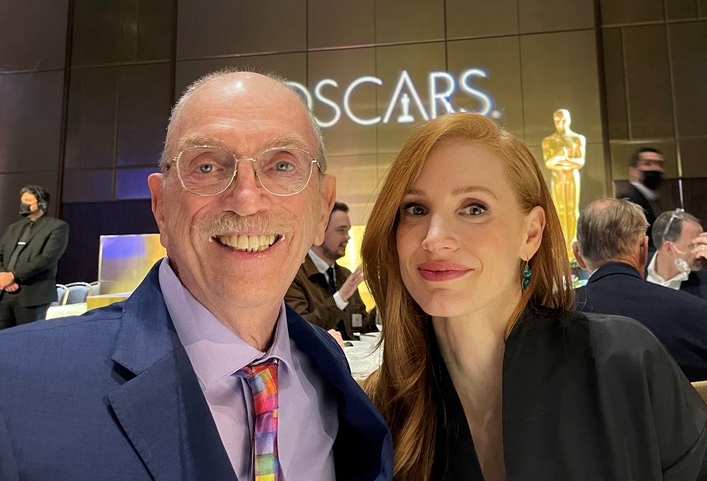
Rev. Stephen Pieters, who emerged as a national spokesman for those facing AIDS in a 1985 interview with televangelist Tammy Faye Bakker, dies in Los Angles from complications of gastrointestinal cancer. He was 71.
Learn More.A long-time activist in the HIV/AIDS and recovery communities, Rev. Pieters was a pastor and later a field director for the AIDS Ministry for the Metropolitan Community Church (MCC) denomination, according to the Los Angeles Blade.
In October 1985, Rev. Pieters agreed to be interviewed by Pentecostal televangelist Tammy Faye Bakker, of the Charlotte-based PTL Television Network, about what it was like to live with AIDS. Bakker was then at her peak popularity, with more than 13 million viewers.
Rev. Pieters said his friends tried to dissuade him from doing the interview. Bakker and her then-husband, Jim, were influential leaders of a conservative Christian movement which promoted ideas sharply at odds with the LGBTQ community. But he saw the show, Tammy’s House Party, as a chance to discuss AIDS and spirituality before an audience he would normally never encounter.
His instincts proved to be right. From the start of the interview and throughout, Bakker showed empathy and asked him thoughtful questions about his life.
“The 25-minute segment became a watershed in public perceptions about AIDS,” wrote Brian Murphy in The Washington Post. “Rev. Pieters also emerged as an eloquent and nationally renowned spokesman for those facing AIDS, which at the time was considered not only a likely death sentence but also put patients at high risk for experiencing shame and humiliation.”
Prior to his diagnosis with AIDS, Rev. Pieters was a leading gay rights activist and served as the pastor of the Metropolitan Community Church of Hartford, Connecticut. According to his biography in the LGBTQ Religious Archives Network, he resigned his position in Hartford in 1982 and moved to Los Angeles, where he began to experience a series of illnesses that were diagnosed as AIDS-Related Complex (“ARC”).
In April, 1984, after being diagnosed with AIDS/Kaposi’s Sarcoma and stage-four lymphoma, he was told by one health professional that he could expect to die within the year.
But he lived to see 1985, and became “patient number 1” on the first anti-viral drug trial, taking Suramin for a total of 39 weeks. While on Suramin, both cancers went into remission, but the drug was highly toxic and was soon discontinued as a treatment for AIDS-related illnesses.
For the next 11 years, Rev. Pieters served as Field Director of AIDS Ministry for the MCC denomination. He traveled the world, teaching and preaching about hope, grief, and surviving AIDS. He also volunteered as a chaplain at an AIDS hospice in Los Angeles.
In 1993, Pieters was one of twelve invited guests at a Prayer Breakfast at the White House with U.S. President Bill Clinton, Vice President Al Gore, and National AIDS Policy Coordinator Kristine Gebbie prior to World AIDS Day. The President talked about Rev. Pieters in his World AIDS Day speech.
He served on the Los Angeles AIDS Task Force, as well as the Boards of Directors of AIDS Project Los Angeles (APLA) and the AIDS National Interfaith Network. He was featured in Life, Time, and Omni magazines, as well as the Los Angeles Times. He regularly appeared on CNN, and was profiled by Jane Pauley to mark the 10th anniversary of the first diagnosis of AIDS.
In 2007, and over the next six years Rev. Pieters battled a number of illnesses, including pancreatitis, which nearly killed him in 2012. At the time of his death, he was writing his memoirs for a book titled My Journey Through AIDS (I Keep on Dancing).
Dr. Pieters’s interview with Tammy Faye Bakker was recreated in the 2021 film The Eyes of Tammy Faye. Click here to hear an audio recording of actor Jessica Chastain, who portrayed Tammy Faye Bakker in the film, talking about Dr. Pieters and his impact.